Finding Alexx
| Bucket list adventures around the globe
Europe , Bucket list travel , Homepage popular · January 12, 2023

The ultimate 2 month Europe itinerary
This 2 month Europe itinerary is the perfect route to spend two months in Europe by train. For each destination I’ve included train details on how to get there, train costs, seat reservation fees for rail pass holders, things to do, places to eat and where to stay.
Planning a two month Europe itinerary? I’ve taken my actual Europe rail itinerary from my recent Europe adventure, made it much cleaner and easier, and typed it up into a super detailed, easy-to-read 2 month Europe itinerary that you can easily replicate for your own trip.
From iconic European cities like Paris, London and Rome to the stunning Italian coast, fairytale cities like Bruges, some of the most scenic train journeys in the world and some world-class culinary gems thrown in for good measure, this 2 month Europe train itinerary will show you a diverse selection of the continent’s highlights.
You could copy and paste this entire itinerary and save yourself weeks of planning, or just use it as a starting point to see where some of the easiest train routes go and then tailor it to fit your timeframe, budget and travel preferences.
So without further ado, let’s dive into this epic Europe train itinerary and get started on planning your European adventure!

How to use this 2 month Europe itinerary
This two month Europe itinerary is based on my own exact two month Eurail trip, but it’s been fixed up to make much more sense and save time and money.
You can see my exact Eurail itinerary here , but I had to fit my plans around a conference in London, various hotel collaborations on set dates, Christmas markets and some train strikes, so I wouldn’t recommend copying my actual route. Instead you can use this two month itinerary to get ideas for places to visit and how to get between them.
If you’re lucky enough to have even longer in Europe, I also have a super comprehensive three month Europe itinerary that is pretty much all you need to plan your Europe route! It has a core itinerary with the major highlights and then a bunch of add on itineraries that you can easily slot in depending on your preferred travel pace, budget and interests,
Do I need a Eurail pass for this trip?
You should consider purchasing a Eurail Pass (or Interrail Pass if you’re an EU citizen) for this Europe train itinerary, because it could save you a tonne of money (and stress!).
If you know your exact travel dates you can check the train prices for each route (you can do this on a website like RailEurope.com or with the specific train company directly) to calculate if a Eurail Pass is worth it . If you’ve got your route fully confirmed 2-3 months before your trip then it might be better to buy all your tickets outright.
If you’re not sure of dates yet/want to keep things flexible then for this particularly itinerary a Eurail Pass is definitely recommended.

What’s the best Eurail Pass for this two month Europe itinerary?
I travelled Europe for two months with a ’15 travel days in 2 months’ Eurail Global Pass . If you go with this pass you’ll need to look at your route and try to figure out what 15 travel days will be most expensive, and use your Eurail travel days for these. There’s no point in using one of 15 travel days for a short €15 train journey between Tirano and Milan.
If you want to visit even more places, travel for another month, or just want the maximum flexibility then you could consider a consecutive Eurail Global Pass for two months or three months. These passes are much more expensive than the limited travel day passes, but they give you total freedom to wake up and catch a train wherever you want without worrying about calculating if a travel day is worth it.
Note: The Interrail Global Pass and Eurail Global Pass are basically the same, except for some specific requirements for leaving/entering your home country. When I say ‘Eurail Global Pass’ this can be interchanged with ‘Interrail Global Pass’ if you’re an EU citizen.
What are seat reservations?
When you travel with a Eurail or Interrail Pass, the pass covers your train ticket but for some trains you still need to pay for seat reservations. Many trains in Europe don’t require reservations, but for high speed trains, particularly busy routes, long-haul international trains and overnight trains you probably will need to pay for a reservation.
Seat reservation costs can vary drastically, ranging from €5 to €12 for the vast majority of reservation-required trains, but can be from €25 to €48 for high speed international trains like the Eurostar.
Seat reservations for most trains can be made on the Eurail website, they charge an fee of €2 per reservation which I have built into the price (e.g. when I say €12 reservation this is actually a €10 reservation with a €2 fee). If you can’t book them on the Eurail website (the Eurostar is an example), the Eurail website will send you through to the correct link or will tell you that you need to call the train company or visit a ticket office in person.
You can sometimes book reservations directly through local rail companies like DB (Germany) or OBB (Austria) and avoid the Eurail fee, but for ease of research I’ve taken the prices from the Eurail reservation search tool and therefore included that €2 fee in all the prices in this post.
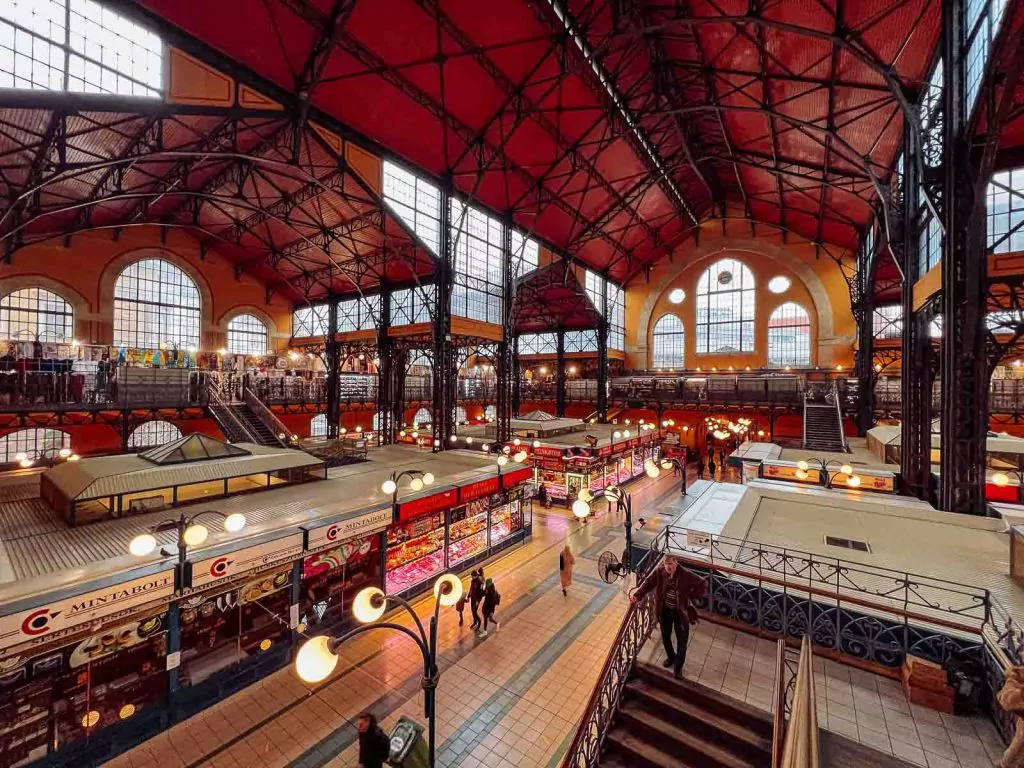
What does this two month Europe itinerary include?
This Europe train itinerary includes many of Europe’s iconic must-do cities, as well as some lesser-visited regions and towns, plus some options for easy day trips or stopovers.
There are many, many more places to see in Europe of course, but for this itinerary I’ve focused on creating a simple train route that’s easy to follow without too many complicated train journeys or drawn out travel days.
There are also a bunch of simple alternative routes at the bottom of the blog, including places you could skip and places you could add on depending on your interests and priorities.
Please note that my ‘how long to stay’ recommendation is an absolute minimum length of stay to see the top sights, but every city has much, much more to explore if you have the time.
Where should I start this Europe train itinerary?
You could start this trip anywhere, it’s pretty much a loop so it’d be possible to start in London, Paris, Barcelona, Rome or any other major airline hub city.

What if I have more time?
You’re in luck! I’ve just published an extremely comprehensive three month Europe itinerary that gives you a core itinerary, and then has a bunch of optional add ons and detours to tailor it for your preferences.
Two month Europe itinerary summary
Europe train itinerary map.
I’ve tried to colour code the destinations in rainbow colours so you can get an idea of the order you’d be travelling in.
Europe train itinerary summary
Again, the days listed here are recommended minimum length of stay. This itinerary is currently 49-61 days long based on the recommended minimum stays so you’ve got a bit of leeway to add on a day in a few extra spots, or to add a new stop altogether.
- London (4 days)
- Paris (4 days)
- Barcelona (3 days)
- Lyon (2 days)
- Zermatt (2-3 days)
- St Moritz (1-2 days)
- Tirano (1 day)
- Milan (2-3 days)
- Cinque Terre (1-2 days)
- Florence via Pisa (2-3 days)
- Rome (4 days)
- Bologna (1 day)
- Venice (3-4 days)
- The Dolomites (3-4 days)
- Salzburg/Innsbruck (2 days)
- Vienna (2-3 days)
- Bratislava (1 day)
- Budapest (2-3 days)
- Prague (2-3 days)
- Berlin (3 days)
- Amsterdam (3-4 days)
- Bruges (1-2 days)
The ultimate 2 month Europe itinerary by train
How to get to London
If you’re starting your two month Europe trip in London, you can fly into one of a number of airports.
Heathrow is the main long-haul airport for most full service major airlines, and to get from Heathrow to Central London it’s an easy Tube trip on the Piccadilly Line or the Elizabeth Line.
Gatwick is the second-busiest airport and is a common arrival point for budget airlines and also some short-haul Europe flights of full service airlines, and is connected to London city by train that runs consistently throughout the day.
There’s also London City Airport (used mostly for short-haul Europe flights from full service airlines), London Stansted (budget airlines like RyanAir and Easyjet) and London (also budget airlines).
How long to stay: As long as you can. Stay for four days at a minimum, but you could stay for weeks and still only see a fraction of what the city has to offer.
About London
London is one of those iconic cities that you probably already know loads about from TV shows and movies, but once you’re there in person you’ll see that there’s much more to the city than Big Ben, Platform 9 3/4 and William’s house from Notting Hill.
I lived in London for two years on a working holiday visa a few years ago and I count it as my second home, so believe me when I say that London is truly whatever you want it to be.
If you want to do the classic tourist route you can visit palaces, museums and skyscrapers by day, and finish the evening with a West End show.
If you prefer seeing a city by exploring their cuisine, London’s full of foodie experiences to keep you satisfied, from world-class markets (Borough is my fave) to Michelin-starred restaurants to budget-friendly cheap eats if you don’t mind getting off the beaten track.
And if you’re up for something a bit different, there are loads of unique things to do in London to surprise and delight you and your travel buddies. Spend a night hopping between funky cocktail bars and speakeasys, roam around some of the city’s expansive parks, get amongst some of the city’s incredible events or see the skyline from a jetboat tour along the Thames.

Things to do in London
- See the obvious attractions, like Big Ben, Buckingham Palace, the Natural History Museum, Trafalgar Square, the Tower of London, the London Eye and St Paul’s Cathedral. All attractions are easily reached by public transport but if you’d prefer a simple door-to-door bus then consider the hop-on hop-off bus , or look at the Go City London Pass which gives you discounted entry to major attractions as well as the hop-on hop-off bus.
- Eat your way around Borough Market, don’t miss divine apple crumble from Humble Crumble
- Shop for vintage goodies at Portobello Market, Old Spitalfields Market or Brick Lane Market
- See a show on the West End (I love & Juliet , Hamilton, the Book of Mormon, Wicked, and the Lion King )
- See a darker side of London with this highly-rated Jack the Ripper walking tour
- Taste the best food around London with a food tour! Try this cheese walking tour , this Secret London Food Tour or this East End food tour
- Take a day trip from London. You could spend a day at Warner Bros. Studios (a.k.a. Harry Potter world!), see a bunch of Downton Abbey filming locations , or tick off Stonehenge, Bath and Windsor in a single tour
- See the best view of the city from up the Shard, without having to pay for a ticket. You can simply book a table at Aqua or Hutong’s if you want a meal, or try popping up for just a drink or two in the middle of the day. Don’t miss the bathrooms, now that’s a true loo with a view!
- Another great view is up the Skygarden, it’s free entry but you need to book in advance. You can book tickets her e.
- Treat yourself to a fancy afternoon tea. Head to the Savoy for a quintessential London high tea experience, go to Sketch for the most Instagrammable high tea in town, or tick off a city tour and afternoon tea in one with Brigit’s Bakery Afternoon Tea bus tour .
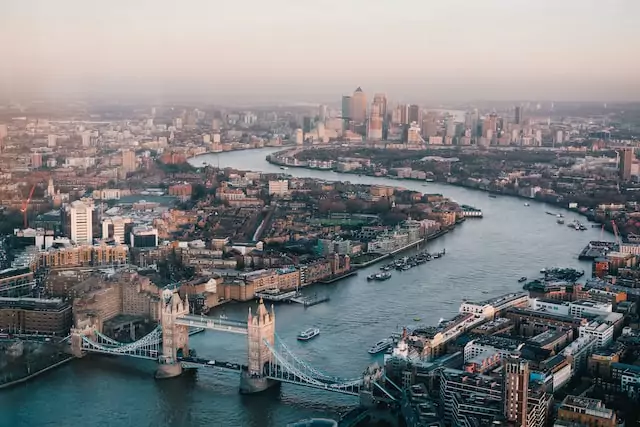
Where to stay in London
Budget | London’s not known for being an affordable city but there are some hostels that can keep your accommodation prices down. Check out Urbany Hostel , Wombat’s Hostel , Selina Camden or Hostel One are all good options, or Kip Hotel is great if all you want a private room but don’t need much space.
Mid-range | To get the best bang for your buck in London you’ll need to stay slightly out of the city, but public transport is super well connected so with these options you’ll find it easy to get to the major tourist sights. The Fox & Goose Hotel in Ealing, Spread Eagle in Wandsworth, Rose & Crown Hotel in Wimbledon and Half Moon in Southwark are all brilliantly-rated mid-range options, or the Z Hotels in Holborn , Trafalgar and The Strand are all well-rated too.
Luxury | There are loads of luxury hotels in London for a fancy stay, but some of the best-rated ones are Hotel 41 , Pan Pacific London , Claridge’s , Ham Yard and the Ritz .
Self-contained | My go-to for a self-contained stay in London is Room2 Chiswick Hometel , a gorgeous boutique aparthotel that offers funky studios with kitchenettes as well as access to a gym, laundry facilities and a café/cocktail bar with plenty of work-friendly spaces. They’re also the world’s first fully net zero hotel which is super cool!
A quick note about airport hotels
If you’ve left planning your Europe trip a bit late and aren’t able to find a seat on the Eurostar to Paris, you might need to fly instead. In London you’ll find that many of the cheaper flights depart before 9am, meaning you might need to leave your hotel at a horrendous hour to reach whichever airport you’re flying out of. To save the early morning stress I often opt for an airport hotel, choosing a cheap early morning fare with an airport hotel booking often ends up cheaper than flying out on an expensive midday flight anyway!
I love BLOC Gatwick if you’re flying from LGW, they have good value cosy rooms with comfy beds literally right next to the departure gate. And if you’re flying from Heathrow, my top pick is the newly-refurbished Hilton Heathrow Terminal 4 , which has super spacious rooms, a brilliant buffet breakfast and a short six-minute walk down a covered walkway to get to Terminal 4.
How to get from London to Paris: Take the Eurostar from London St Pancras to Paris Gare de Lyon, super quick and easy.
Train prices: If you book a few months in advance or during a sale you can find tickets from €45 one way, but there are only a select number of tickets available at that price before it rises. Last minute tickets or tickets for peak times can be as expensive as €150-€175.
Seat reservations with rail passes: A Eurail Pass is great for the Eurostar because you only pay for the seat reservation which is €32 for a Standard seat (with a 2nd class Eurail Pass) or €40 for a Standard Premier seat (with a 1st class Eurail Pass).
How long to stay: 4 days
Paris is one of Europe’s most hotly-debated tourist destinations, it seems as though you either absolutely love it or totally hate it! I’m in the ‘love’ camp, and I’ll always tack a quick Paris visit onto any European adventure.
I think the issue with Paris is that people have these dreamy, romantic expectations of the city after seeing it in movies and TV shows, and then the reality of hectic crowds, abrupt locals, smelly metro corridors and scammy tourist traps ruin these expectations leaving a bit of a sour taste in the their mouths. But, just like any main city, the best Paris has to offer is beyond the iconic tourist sights.
Paris boasts one of the world’s best café cultures, where pastries are freshly-baked, coffee is piping hot and people-watching is a daily event. And if sitting at a sidewalk table isn’t your thing, there are plenty of inner city parks to take your fresh croissant or baguette and cheese to for a DIY picnic.
Throw in a bunch of renowned museums and galleries, Instagrammable photo spots all over the city, easy day trips to palaces, castles and gardens, an alluring cabaret scene and stunning architecture everywhere you look, and you might just join me in the Paris fan club!

Things to do in Paris
- Practice your French! It’s true that the locals aren’t super friendly when you speak English to them and expect them to respond, but can you blame them? A little ‘bonjour’, ‘s’il vous plaît’, ‘parlez vous anglais?’ and ‘merci’ will go a long way. (That’s ‘hello’, ‘please’, ‘do you speak English?’ and ‘thank you’, by the way!)
- See a cabaret show, Paris is home to loads of incredible cabaret performances, ranging from risqué and raunchy through to quirky and even family-friendly. I recently saw Paradis Latin which blew me away, the dialogue and songs were part-French, part-English, the costumes were stunning and the atmosphere was so vibrant and fun.
- Grab a baguette and some cheese and have a picnic under the Eiffel Tower, in the Jardin des Tuileries or at Places des Vosges
- Visit the Galeries Lafayette department store to see the famous stained-glass dome
- Learn about some of the most famous artworks in the world at the city’s museums. There’s the Louvre , Musée Picasso , Musée d’Orsay , Musée Rodin and many, many more.
- Indulge in some sugary treats, like macarons from Pierre Hermé, the famous hot chocolate (more like chocolate soup!) from Angelina’s or a pain au chocolat from Du Pain et des Idées
- Try your hand at making your own French dessert with a macaron cooking class, there’s a good value 1.5 hour option at Galeries Lafayette , or a more intensive 2.5 hour option at a cooking school
- See a side to the city many don’t even know exists with a tour through the Catacombs , an underground network of tunnels that hold the remains of six million people after being moved from overflowing cemeteries in the 18th century
- Enjoy the panoramic view of the city from the steps of the Sacré-Cœur
- Wander through the narrow cobbled streets of the Latin Quarter, and stick around in the evening if you’re keen to experience the neighbourhood’s buzzing nightlife
- Explore the charming Marais district, my favourite part of Paris. Incredible design stores, trendy clothing shops and the city’s best Middle Eastern eatery, l’as du fallafel
- Take a day trip out of the city to the opulent Palace of Versailles , the castles of the Loire Valley , the gardens of Giverny or the rollercoasters of Disneyland Paris
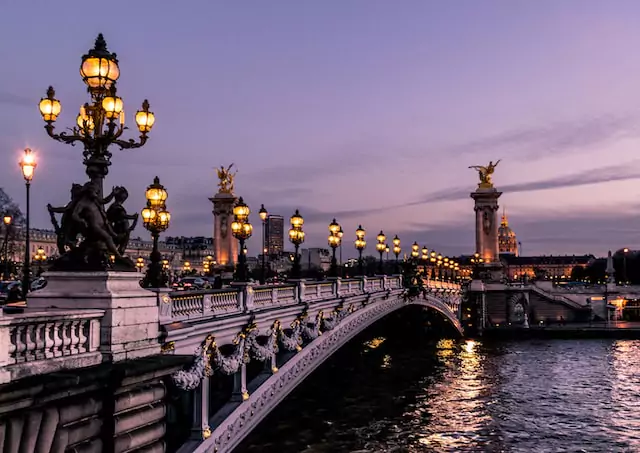
Where to stay in Paris
Budget | On my most recent trip I stayed at JO&JOE Paris Nation , which has a fridge and microwave as well as pod-style dorm rooms and private rooms, from my research it’s the best hostel in Paris that offers cooking facilities. I’ve also stayed at People Nation which has brilliant pod-style rooms right next to a metro station, but unfortunately doesn’t have a kitchen or even a fridge (not ideal for travellers on a budget as eating out in Paris isn’t exactly cheap). Generator Paris is another well-rated hostel but also doesn’t allow any outside food to be brought in, and budget-friendly Enjoy Hostel does have a kitchen but is lacking in other areas like comfort and space.
Mid-range | Hotel Paradis is my go-to for a mid-range boutique stay, they have simple but beautiful interiors, comfy beds and some top floor rooms can see the top half of the Eiffel Tower for cheeeeap. I also love Laz’ Hotel Spa for something a bit fancier without being crazy expensive, and some other decent options are Hôtel de Roubaix , B Montmartre and Babel Belleville .
Luxury | Treat yourself to a luxury stay in Paris at Manolita Paris , Maison Villeroy , La Réserve Paris Hotel & Spa , Bulgari Hotel Paris or Cheval Blanc Paris .
Self-contained | If you want somewhere with kitchen facilities then I adored my time at Edgar Suites Montmartre , they are an aparthotel just around the corner from the stairs to the Sacre Coeur. Spacious, stylish and ideally located! Other top-rated self-contained options are Goralska Résidences Hôtel , Les Jardins Du Luxembourg Hotel , CADET Residence or PEPPER & PAPER Apartments .
Bonus: Where to stay at Paris Disneyland
Budget | Eklo Hotels is an awesome option for Disneyland visitors on a budget, with rooms ranging from single to double to family to group dorm rooms. There’s also a fridge and microwave for guests to use, as well as a restaurant and bar serving up diner-style food and drinks.
Luxury | Hotel L’Elysée Val D’Europe is my top pick for a luxurious, comfortable stay near Disney. They’ve got huge rooms complete with giant beds, desks and bath tubs, and the hotel provides a free shuttle to and from Disney throughout the day.

How to get to Barcelona from Paris: There’s a direct train that runs twice a day (three times in summer) and takes 6h 31m.
Seat reservations for rail pass holders: The seat reservation for this high speed train is expensive, I paid €48 for a 1st class seat and the 2nd class reservation was €36.
Train prices: But the train ticket would’ve cost me €228 without a Eurail Pass when I booked a week before the trip (€188 for 2nd class) so the pass saved me loads of money. Looking at prices now for 2.5 months ahead of time the prices are between €119 and €144 for 2nd class, so this is an expensive route to buy outright.
How long to stay: 3 days
Barcelona is a fabulously vibrant city that offers beaches, nightlife, gastronomy, culture and history all within easy access to each other, which is ideal if you’re only here for a short visit.
By day you could catch some sun rays from a deckchair in the sand, marvel at Gaudi’s masterpieces or try some local delicacies from Mercado de La Boqueria. By night you could sip sangria while taste testing tapas (or trying some of the city’s best paella), enjoy some late night shopping down Las Ramblas or hit the cocktail bars or nightclubs.

Things to do in Barcelona
- Visit the still-incomplete jewel in Barcelona’s tourism crown, La Sagrada Familia, which is one of the city’s Gaudí masterpieces, currently in its 141st year since construction began in 1882. The basilica is certainly a showstopper even from afar, unlike any other church in the world, but you’ve got to go inside and see the stained-glass windows and unique ceiling design. Avoid long queues by booking your ticket and visit time in advance , or skip the line entirely with this guided tour and entry ticket combo .
- Another iconic Gaudí stamp on the city is Park Güell , an enchanting park sitting above Barcelona with incredible views, fairytale-esque gardens and a house where Gaudí himself lived with his family, which is now a museum dedicated to him
- And a third Gaudí tourist hot spot is Casa Batlló, a.k.a. the ‘House of Bones’ thanks to its skeletal look. You can enjoy the unique façade from the street for free, or you can buy an entry ticket to learn more about Gaudí and his creative process.
- Shop til you drop down La Rambla, a tree-lined pedestrian boulevard boasting flagship stores, quirky street performers and vibey cafes and restaurants
- While you’re wandering down La Rambla, don’t miss the entrance to the famous La Boqueria market, where you’ll find a wide range of food from fresh juices to sweet pastries to cured meats and ocean-to-market seafood
- Catch some sun, hit the surf and feel the sand between your toes along the city’s 4.5km coastline
- Experience Spanish culture through cuisine by having a daily tapas session. I loved Ciutat Comtal and some other top-rated eateries are Tapeo, Sensi Bistro and Cerveseria Catalana
- Walk through the beautiful Ciutadella Park

Where to stay in Barcelona
Budget | Yeah Barcelona , Hostel One Ramblas , Born Barcelona and Fabrizzios Terrace Hostel are all top-rated budget-friendly options
Mid-range | For something mid-range check out Forget Me Not , Musik Boutique Hotel , Occidental Barcelona 1929 and Hotel Jazz (which has a rooftop pool!)
Luxury | ME Barcelona , Hotel El Palace , Hotel Boutique Mirlo , Monument Hotel and The One Barcelona GL are some of the best-rated luxury hotels in Barcelona
Self-contained | If you want self-catering facilities, some good options are Deco Apartments , El Alma de las Ramblas , Eco Boutique Hotel and Suites Avenue
How to get to Lyon from Barcelona: A 5h 17m train journey with one change in Montpellier with mandatory reservations on both trains, €36/€50 for the first train (2nd class/1st class) and €12 for the second train (both classes the same price).
Train prices: This route typically costs between €70-€120 for a ticket so check the price for your travel dates to see if a Eurail Pass would be worth it. There’s also a direct coach from Barcelona to Lyon with FlixBus for €28.99 but this takes nine hours.
How long to stay: 2 days
A lesser-known city compared to many on this two month Europe itinerary, Lyon takes the culinary crown as France’s best foodie city. With 19 Michelin-starred restaurants, gastronomic events throughout the year, flagship restaurants from world-famous chefs and easy access to some of France’s best produce and meat, it’s an absolute must-visit for any food-minded traveller.

Things to do in Lyon
- My absolute top recommendation for Lyon (and for any foodie city) is to do a food tour, it’s hands down the best way to learn about the city’s culinary history and taste a bunch of local specialties while you’re at it. Some highly-rated ones are this 4 hour Vieux Lyon food tour , this Secret Food Tour and this Vegan Croix-Rousse food tour if you’re plant-based.
- Snag a table at a Michelin-starred restaurant. Restaurant Paul Bocuse is perhaps the most famous, named after Lyon-based gastronomic legend Paul Bocuse and boasting two Michelin stars. You can see all the Michelin-starred Lyon restaurants here , book in advance if you’re visiting on a weekend or during summer.
- Wander through the cobbled alleyways and ‘traboules’ (secret passageways) of Vieux Lyon, the city’s old quarters
- See the city efficiently (time-wise and energy-wise!) with a Pedicab tour , a Segway tour or an electric bike tour
- Take a walk through the indoor and outdoor gardens at Parc de la Tête d’Or
- Catch the funicular (or walk if you don’t mind breaking a sweat) up to Fourvière Hill to see the Basilica of Notre-Dame de Fourvière, the Théatre Gallo-Romain and incredible views of the city

Where to stay in Lyon
Budget | Centre Jean Bosco , Félix Dort , MEININGER Lyon and Hotel Elysée offer brilliant value for money
Mid-range | Hôtel de l’Abbaye , Hotel De Verdun 1882 , Hôtel Edmond W and Le Phénix Hôtel
Luxury | InterContinental Lyon , Villa Maïa , Boscolo Lyon Hotel & Spa or Hotel & Spa Le Pavillon if you’d like somewhere luxurious slightly out of the city
Self-contained | Le Cocon on Dine , Urban Cocoon Gite and MOHOM all offer kitchen facilities
Don’t stay at | I stayed at ResidHotel in a tiny studio apartment, but I wouldn’t recommend it. It was far too expensive for the size and quality of the place, and it was disgustingly dirty, with food remains stuck on ‘clean’ dishes, dust everywhere, sticky stuff on the kitchen bench and desk. Avoid!
How to get to Zermatt from Lyon: A few different options, but the easiest/cheapest is a three train journey that takes between 5h 36m and 6h 36m depending on the connections, with no seat reservations needed (which means it’s totally free if you use a Eurail pass). Most journeys will have a regional train from Lyon to Geneva (1h 57m), a switch in Geneva, then a train to either Visp (2h 13m) or to Brig (2h 1m), then a switch to your final train to Zermatt (1h 10m from Visp, 1h 22m from Brig).
Train prices: Prices seem to sit at around €80-100 for outright tickets even when booking a couple of months in advance
How long to stay: 2-3 days
Have you ever wondered what mountain you see on the Toberlone packet? It’s the Matterhorn, an iconic peak in the Swiss canton of Valais, and the charming ski town of Zermatt provides a front row ticket to it.
Zermatt is best-known as a winter hub for active adventurers who want to hit the slopes of world-class ski resorts, but it’s still well worth a visit in the warmer months too, with hikes, alpine train rides, paragliding, scenic flights and more on offer.

Things to do in Zermatt
- Ski or snowboard if you’re visiting during winter, then get amongst the epic apres-ski scene afterwards
- Take the Gornergrat Bahn mountain railway to the top of Gornergrat for the best view of the Matterhorn
- Do a walk when you’re up at Gornergrat. I got off at the top station and walked the 2km to Riffelsee Lake, a lake with an incredible reflection of the Matterhorn, before heading slightly up hill (short but very steep 5 min walk) to Rotenboden station to catch the train down.
- You could also continue 2.3km to the next station, Riffelberg, or skip the first walk, get off at Rotenboden and just do the second. During winter these trails are snowy so the first walk (Gornergrat to Rotenboden) is accessible to snow-shoers only, but the second walk (Rotenboden to Riffelberg) is accessible to both snow-shoers and normal winter hikers.
- Float amongst the peaks with a paragliding flight
- Take the world’s highest cable car, the Matterhorn Glacier Paradise to Europe’s highest mountain station at 3,883m above sea level, where you’ll be able to spot 38 mountain peaks in Switzerland, France and Italy
- Try some fondue, a quintessential Swiss alpine culinary experience. My hotel (the stunning Hotel ZERMAMA ) had in-room fondue sets where guests could order the ingredients from the restaurant and then DIY their own fondue dinner in the comfort of their room or from their balcony, So dreamy!

Where to stay in Zermatt
Budget | Zermatt Youth Hostel is the cheapest place in town and has great reviews, or ALPINA Budget Rooms , Hotel Alphubel and Le Petit Charme-Inn are also rated over 8/10 on booking.com
Mid-range | Chesa Valese , SchlossHotel Zermatt , Unique Hotel Post and Schallers Tannenhof offer great value for the mid-range budget
Luxury | I am obsessed with where I stayed and cannot recommend it highly enough, it’s called Hotel ZERMAMA and it’s one of the best places I’ve ever stayed for sure. It’s a 4* luxury design and lifestyle hotel with stunning interiors, lots of thoughtful extras (yoga mat, resistance bands, big faux-fur winter coat for cold nights on the balcony) and little details that take your stay to the next level. I stayed in a suite which was absolutely divine but they also offer single rooms for solo travellers which I love (no need to pay for extra space you don’t need), as well as a range of other rooms to suit different budgets.
Self-contained | Studio MIA , Alpenblick Superior and Piccolo Fiamma all have options with a kitchen/kitchenette
How to get to St Moritz from Zermatt: By catching one of the most scenic train journeys in Europe (and the world!), the Glacier Express, which is an 8 hour direct train with panoramic windows and some of the best views I’ve ever seen in my life. You can save 152CHF (2nd class) or 268CHF (1st class) on your Glacier Express journey using a Eurail, Interrail or Swiss Travel Pass, you can find out how in my Glacier Express travel guide .
Seat reservations: 39CHF during low season (mid-Dec to mid-May), 49CHF during high season (mid-May to mid-Oct)
You can also replicate the same journey by using regional trains which don’t require seat reservations, so they’re free with a rail pass or still relatively cheap compared to the Glacier Express if you’re buying outright. You’ll need to take five trains in total but all the changes are simple and at small stations: Zermatt to Visp, Visp to Andermatt, Andermatt to Disentis/Muster, Disentis/Muster to Reichenau-Tamins, and Reichenau-Tamins to St Moritz.
How long to stay: 1-2 days
St Moritz is the birthplace of winter tourism in Europe, with luxury hotels, fancy ski resorts and gourmet restaurants playing host to the rich and famous since 1864. It also serves as the stopover between the Glacier Express train and another Switzerland panoramic train, the Bernina Express.
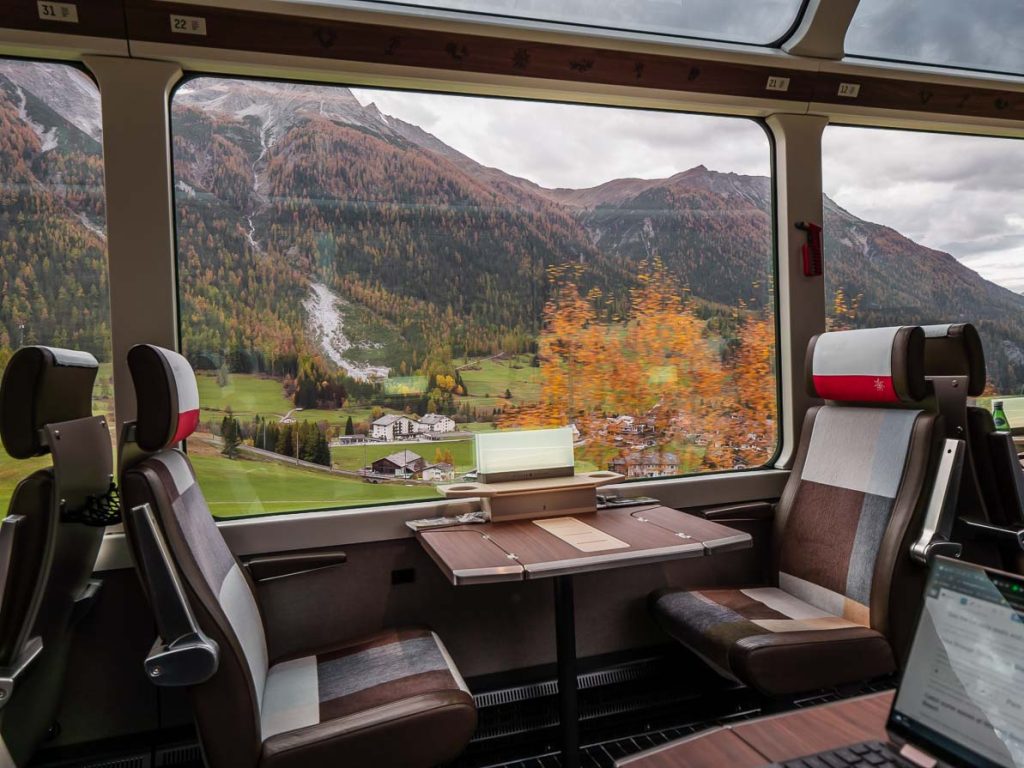
Things to do in St Moritz
- Walk around Lake St Moritz, an easy 4.4km walk past lakefront hotels and restaurants, through some short forest sections and with stunning views the whole way round
- Catch the funicular up to Corviglia (2486m) for hiking in summer and skiing in winter, or go slightly higher with the cable car up to Piz Nair at 3,057m
- There are plenty of other hikes on offer in and around the area, from easy family-friendly trails to more challenging alpine treks and even seasonal wildflower tracks
- Channel Cool Runnings and get your heart racing with a bobsled run down the Olympia Bob Run , the oldest run in the world. It’s not cheap, at 269CHF per person, but you’ll never forget the thrill of speeding down a natural ice track at up to 135km/h, feeling forces of 4G and coming to a halt after 75 seconds of adrenaline.

Where to stay in St Moritz
Unique | I spent two nights at one of the most unique accommodation spots in the world, a historic observatory with mountain views, a turning mechanism and a cog-wheel window for stargazing. The observatory is located at Randolin’s Berghotel and also gives you access to the hotel’s beautiful spa and wellness area. One for the bucket list for sure, a true once-in-a-lifetime experience!
Budget | St Moritz Youth Hostel or Hostel by Randolin’s are the cheapest accommodation options with decent reviews
Mid-range | Aside from the epic observatory, Randolin’s Berghotel also has mid-budget hotel rooms that offer a comfortable stay, great facilities and incredible views for an affordable price. You could also look at Hotel Piz , Chesa Languard or Boutique Hotel Cervus .
Luxury | Suvretta House is an iconic St Moritz luxury hotel, Kulm Hotel has incredible reviews, and Carlton Hotel is one of the Leading Hotels of the World
Optional stop: Tirano
How to get to Tirano from St Moritz: By catching the Bernina Express, another panoramic train with huge windows and insane views. A Eurail pass makes this one much more affordable too!
Seat reservations: From 20CHF to 26CHF depending on time of year
Train prices: 32CHF 2nd class or 56CHF 1st class, not including the seat reservation fee
How long to stay: Overnight
Tirano is a sleepy alpine village located in Northern Italy just across the Swiss border, and it’s the end point of the Bernina Express train.
I’ve noted it an an optional stop in this two month Europe itinerary because there isn’t a huge amount to do there as a tourist, however it’s a charming Italian town that’s much more calm and low key than the next few stops on this trip, so if you want a bit of a break then it’s a great spot to spend a night or two.
If you have extra time and you enjoy skiing in winter or cycling in summer then you might want to stay longer, it’s a great area for outdoor adventures!
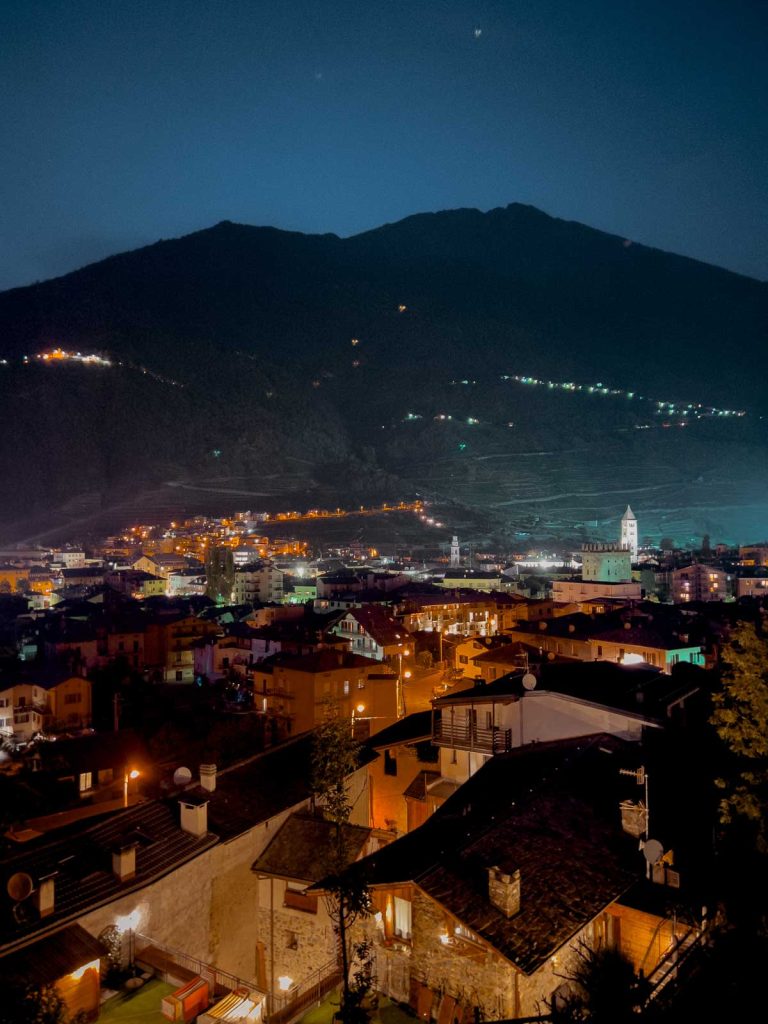
Things to do in Tirano
- See the Basilica of the Madonna di Tirano, a 16th century Renaissance-inspired church dedicated to Mary after she appeared to a local man asking for a shrine in 1504 (as local legend goes)
- Enjoy some Valtellinese cuisine, I loved Parravicini Restaurant but some other top-rated ones are Posteria Del Rosso and Merizzi
- For a classic pizza dinner, head to L’Hostaria Ristorante
- Try some local wines at the wineries on the hills surrounding Tirano
- Ski in winter or explore by e-bike in summer

Where to stay in Tirano
Budget | Hotel La Rotonda , Albergo Gusmeroli and B&B Antica Residenza Centro Storico are all cheap and well-rated
Mid-range | I stayed at Ostello del Castello , a great value guesthouse just a short walk from town and one of my favourite places I stayed in Europe. Basic but spacious and comfortable rooms, superb hospitality, and a rooftop terrace ideal for catching some rays while overlooking the town on a sunny day.
Self-contained | Casa Dolce Casa , Old Town Apartments and Holiday House Viola all have kitchen facilities
How to get to Milan from Tirano: An easy 2h 28m direct train
Train price: Tickets are just €12 so not worth using a travel day on a rail pass (but if you have an unlimited travel pass this train is included and doesn’t require seat reservations)
Milan isn’t as popular on the Italy tourist route as Florence, Rome and Venice, but if you can fit a couple of days in Milan into your Europe itinerary you will find plenty to see, do and eat. It also serves as an easy hub for rail travel, with connections to cities in Switzerland, Germany, France, Austria and more.

Things to do in Milan
- See the Duomo di Milano , one of the largest cathedrals in the world and the most iconic landmark of the city. Book a skip-the-line ticket to save time, you can choose a cathedral and rooftop ticket (optional audio guide add on) or you can get a cheaper ticket to the rooftop terraces only (no church) .
- Right next to the Duomo you’ll find Galleria Vittorio Emanuele II, a glass-covered arcade packed with luxury clothing stores. Go for sunrise to see it quiet, it fills up by around 9am and will be busy the entire day.
- Take a guided tour of the Teatro alla Scala and learn all about the theatre’s history and past performers
- Visit Santa Maria delle Grazie, a church that hosts da Vinci’s Last Supper. Tickets book up well in advance through the official website, so if you miss out then you’ll need to book a skip-the-line ticket with a guided tour .
- Architecture nerds won’t want to miss the Basilica of Sant’Ambrogio
- And football fans might want to visit the museum at San Siro Stadium, or better yet, do a guided tour
- Enjoy an evening of aperitivo in the vibrant Navigli district
- This one sounds strange but hear me out, you have to visit the Starbucks Reserve Roastery near the Duomo! It’s the fanciest Starbucks I’ve ever seen, complete with an authentic Italian menu, cocktails like espresso martinis and Aperol Spritz’, and for digital nomads it’s one of the only cafes in the city that offers unlimited free WiFi
For more things to do in Milan, check out my two day Milan itinerary

Where to stay in Milan
Budget | I stayed at Ostello Bello Grande , part of an Italian hostel chain with top-rated hostels in a bunch of major cities. The hostel is a one minute walk from Milano Centrale which is ideal for rail travellers, it has a beautiful rooftop with great views across the city, and there are loads of events to make friends.
Mid-range | Rosso Segnale Milano , Milano Dreams and B&B La Terrazza di Barbara are my top mid-range picks, all rated above 9.5/10 on booking.com
Luxury | INTOMilan Aparthotel is a brilliant option for affordable luxury, ODSweet Duomo Milano is a brand new ultra-Instagrammable hotel, or Hotel Indigo Milan is a classic
For a view of the Duomo | For the classic balcony/window shot of the beautiful cathedral, check out Duomo Cathedral View (aptly named!) or Unique Duomo Luxury Property
Cinque Terre
How to get to Cinque Terre from Milan: Direct train from Milan to La Spezia (3h 10m-3h 30m), then short trains to the villages.
Train price: The train to La Spezia is pretty cheap (€10-€25 depending on how far in advance you book), then you can take trains between the five villages with a €7.50 train card between March 24 and November 6. If you visit outside of these dates then that’s the off season and trains between the villages are free.
Seat reservations: Depends on the route, some don’t require reservations, some require €5 reservations and some require €12 reservations
The Cinque Terre was one of the first truly ‘Instagram-famous’ destinations when social media really started taking off, and the colourful seaside villages have been appearing on our feeds all through European summers ever since.
If you only have a day for the Cinque Terre then you’ll be able to see all the villages by using the train, but if you’d like to explore each village more in-depth, try some of the hikes between the villages or add on a boat trip along the coast then two or three days would be better.
Keep in mind that the Cinque Terre gets extremely busy from May through to September/October (July/August are slightly less busy because of the summer heat), and chances are you’ll be jostling for photo spots, waiting for restaurants and dealing with loads of people on the hiking trails. This isn’t to put you off visiting, it’s just to ensure you know what to expect so you aren’t disappointed!
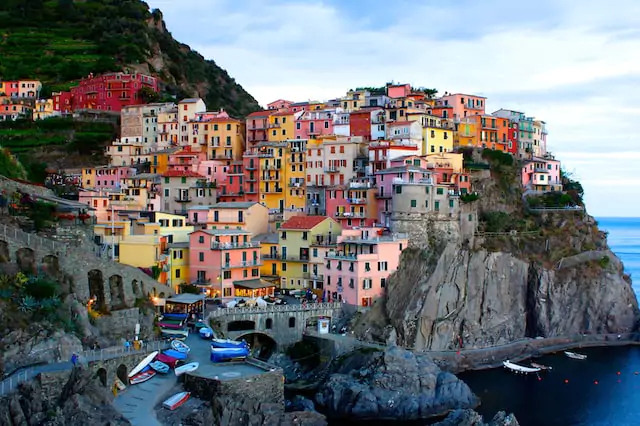
Things to do in the Cinque Terre
- Visit each of the five villages: Riomaggiore, Manarola, Corniglia, Vernazza and Monterosso
- Take a dip at Monterosso al Mare, the only sandy beach in the Cinque Terre, and home to those famous orange and green striped umbrellas
- Explore the coast by foot with one of the many hikes between the villages. The Blue Trail is the most popular track, it used to connect all five villages but was damaged by a landslide in 2012 and the route is now limited to the Monterosso – Vernazza – Corniglia sections which are 7.6km long in total. The famous Via dell’Amore (the Path of Love) from Riomaggiore to Manarola is closed until at least May 2024.
- See the coast from the water, particularly amazing in the afternoon as the sun starts to set and the colourful houses seem even more vibrant than usual. You could do this 1.5 hour kayak tour, a 3 hour kayak + snorkel tour or a full day boat tour.
- Eat lunch at Nessun Dorma, the Cinque Terre’s most well-known restaurant with stunning views overlooking Manarola. The line is always long but you can skip it by downloading the Nessun Dorma app and saving your spot while making your way there.
- Try Pesto Genovese, one of Liguria’s best-known culinary specialties
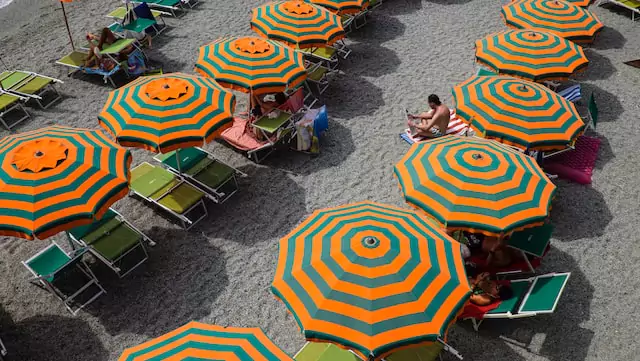
Where to stay in the Cinque Terre
Staying in the villages themselves can be quite pricey (understandably) but gives you better access to the area outside of peak day tripper hours, but for more affordable accommodation I’d recommend staying in La Spezia and then travelling to the villages during the day.
Budget | Ostello Tramonti , La Cesarina or Casa Macaia in La Spezia, or La Rosa dei Venti in Monterosso if you want to be amongst the villages
Mid-range | La Casa dei Treni Affittacamere in La Spezia, A cà da Alba Rooms in Monterosso or AMARE IL MARE Affittacamere in Corniglia
Luxury | Grand Hotel Portovenere or La Spezia by the FIrst
Day trips to Cinque Terre
If you don’t have time to spend a night in the Cinque Terre, you can join organised tours from both Milan and Florence .
Florence via Pisa
How to get to Florence from Cinque Terre: There are regional trains running constantly throughout the day to get from La Spezia to Florence, most of which have a short change in Pisa and the total travel time ranges from 1h 32m to 2h 36m.
Train prices: Tickets are cheap, typically between €14.40 and €18.80 so it wouldn’t be worth using a travel day on your rail pass.
It’s super easy to stop in Pisa to see the Leaning Tower on your way from the Cinque Terre to Florence, there’s luggage storage available at the station (most European stations have this option, usually €5-10 per large locker for a half day) so you can pay to store your suitcases and then walk 20 minutes from the station to the tower.
With Renaissance architecture to marvel at around every corner, fresco-filled churches to visit, and a seemingly endless list of sculptures, paintings and other masterpieces to admire, Florence has enough to satisfy even the most cultured travellers.
If the idea of gallery after gallery bores you then don’t stress, the city also boasts some of the country’s best restaurants, a fantastic shopping scene and easy access to the Tuscan countryside.

Things to do in Florence
- See the most iconic of all of Florence’s beautiful buildings, the Duomo Santa Maria del Fiore. Lines are always long but you can buy skip-the-line tickets with a guided tour , or this Duomo complex ticket includes access to climb the dome itself
- Say hello to perhaps the most famous statue in all of Europe, Michelangelo’s David, at the Accademia Gallery
- Visit the Uffizi Gallery , home to one of the most impressive collections of Renaissance artwork, including masterpieces from da Vinci, Botticelli, Michelangelo and Raphael, to name a few
- Try a sandwich from the original All’Antico Vinaio, the most-reviewed sandwich shop in the world with a 4.6/5 rating from more than 31,000 reviews. It’s worth the wait in line, I promise!
- See the city through Leonardo da Vinci’s eyes with a da Vinci-themed walking tour
- Window shop at the jewelry stores along the Ponte Vecchio
- Buy a genuine leather belt or bag from the artisan leather workshops in and around Piazza Santa Croce
- Visit the Basilica of the Santa Maria Novella and see art from Giotto, Masaccio, Filippo Brunelleschi and more
- Try your hand at making your own Italian dishes with a cooking class, I did this top-rated cooking class and central market tour on my last visit to Florence and now I’m obsessed with making pasta from scratch
- Watch the sunset from Piazzale Michelangelo or Basilica di San Miniato
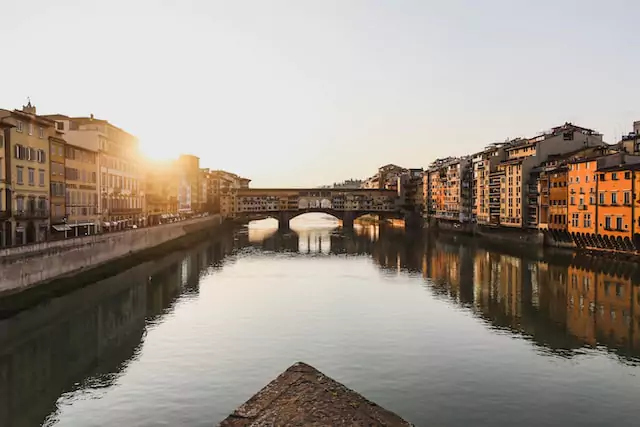
Where to stay in Florence
Budget | I stayed at YellowSquare Florence , a fantastic social hostel with brilliant facilities including a full kitchen, a rooftop bar with swimming pool, co-working areas and even a recording studio! I had a private room which had a desk (ideal as I was slammed with work) but the dorm rooms look super nice too.
Mid-range | For a mid-range budget consider Morandi alla Crocetta , 3110 ArtHotel , Room Mate Luca , Solo Experience Hotel and Residence Leopoldo
Luxury | For a fancy stay check out Villa Cora , Relais Santa Croce , Four Seasons Firenze or The Place Firenze
Self-contained | Some top-rated options with kitchens/kitchenettes are Urban Retreat , Oro Nero Florence , Geppi’s Apartment and Donati Luxury Tower Suites
How to get to Rome from Florence: High-speed direct trains take around 1h 30m
Train prices: These trains range from €14.90 to €50 depending on how far in advance you book
Seat reservations: High speed trains require seat reservations (€12). There are slower regional trains that don’t require reservations, these take around 3h 30m.
Ahhh Roma, the Eternal City that’s packed to the brim with rich culture, fascinating history, mouthwatering cuisine and a thriving nightlife and entertainment scene. Rome is one of those places where you’ll discover something new and interesting around every corner, so set aside a decent chunk of time to explore if you can.

Things to do in Rome
- Say ciao to the Pope with a visit to the Vatican, its museums, and the breathtaking Sistine Chapel. Once again, the lines will be long so a skip-the-line ticket is the best idea if you want to make the most of your time.
- See the Colosseum. Controversial opinion perhaps but I don’t think going inside the Colosseum is a must-do, I personally have only seen it from the outside on my three visits to Rome and I’m not enough of a history buff to be willing to brave the crowds. If you do want to go inside, get a skip-the-line ticket or book a guided tour to get the full experience.
- Marvel at the view from Altare della Patria. This is my all-time favourite ‘hidden gem’ of Rome and something that flies under the radar, it’s a rooftop terrace with the most incredible views across the city and its landmarks. You can catch the elevator to the terrace for only €7 (no need to book online through a travel agent or experience provider, these tickets are basically exactly the same but cost three or four times the price!), or if you’re on a tight budget you can access the terrace for free via stairs inside the monument.
- Eat and drink in the trendy Trastevere neighbourhood, which is full of cheap and cheerful trattorias, a bustling nightlife scene and funky shops. My go-to Trastevere meal is always Donkey Punch, a quirky rock’n’roll-themed sandwich bar with craft beers on offer too.
- Throw a coin into the Trevi Fountain for good luck
- Live out your Lizzie McGuire Movie dreams with a Vespa tour
- Find the Aventine Keyhole and see the perfectly-framed view of St Peter’s dome

Where to stay in Rome
Budget | YellowSquare Rome , the RomeHello and Ostello Bello Roma Colosseo are all top-rated budget options
Mid-range | The Point Suites , Relais Roma Vaticano, Hotel Balilla , Hotel Margherita and At Forty-One
Luxury | Maalot Roma , Umlita 36 , Fendi Private Suites , Baglioni Hotel Regina , Hotel Vilòn and the St Regis
Self-contained | Residenza Roma Imperiale , Trastavere 2.0 , My Bed Vatican Museum and Colosseo Accommodation Room Guest House
Optional: Bologna
How to get to Bologna from Rome: Bologna is an easy stop between Rome and Venice, it’s just over two hours from Rome (€12 seat reservation) and then it’s between 1h 20m and 2h 10m to get from Bologna to Venice (€12 seat reservation for the high speed train, no reservation needed for the slower regional trains). You can store your bags in secure lockers at Bologna train station while you’re exploring the city.
How long to stay: A day trip is sufficient
I’ve put Bologna as ‘optional’ because many first-time Europe travellers may not have even heard of it, but if you enjoy Italian food it is absolutely a must-do. Bologna is the gastronomic capital of Italy, which is saying something in a country that is renowned for its cuisine!
Bologna has many, many eateries serving up local specialties, from cured meats and cheeses to traditional pasta to creamy gelato. I’d looove to stay for a week and just try a new dish every meal, but if you are pressed for time then a day trip with a food tour is how I’d recommend seeing Bologna during this two month Europe itinerary.
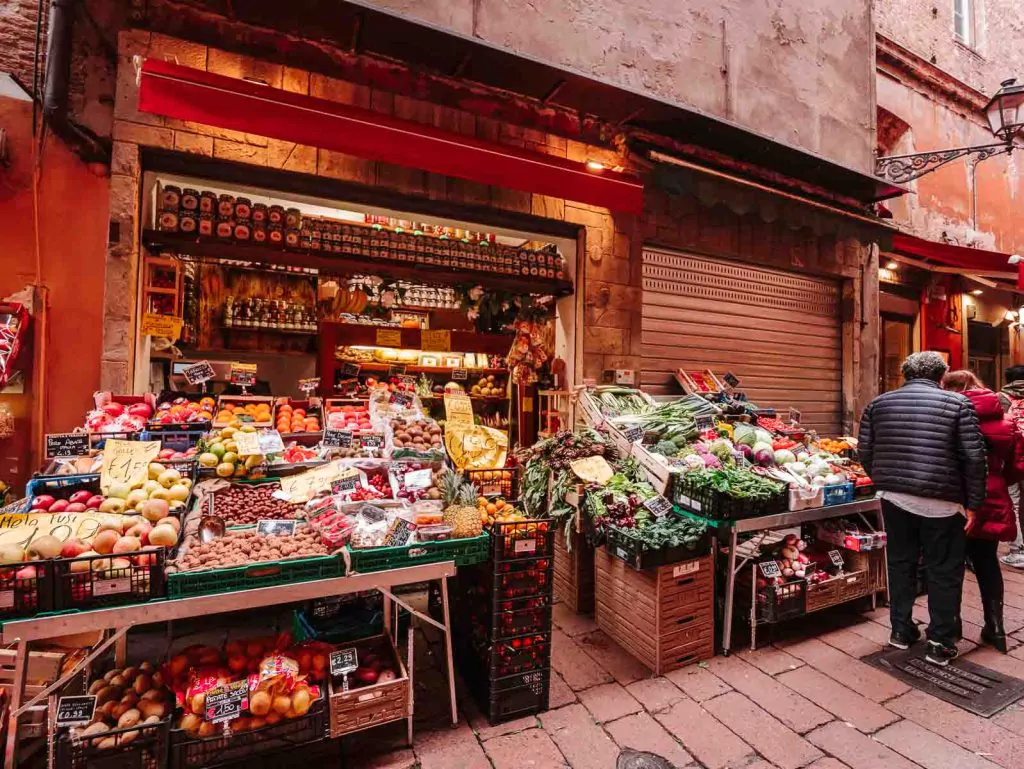
Things to do in Bologna
- A food tour is by far the best way to experience Bologna, especially if you’re limited to a day trip. I went on a food tour with Mattia from Delicious Bologna , his tours have a perfect 5/5 rating on Google from more than 220 reviews. The tour was one of the best food tours I’ve ever been on, it had the perfect mix of food, history and culture, each dish was divine, and I came away knowing so much more about Italian cuisine and produce which then helped me try new foods during the rest of my time in Italy. I genuinely can’t rave about this tour enough, it was a highlight of my two months in Europe.
- Stand under the leaning towers of Bologna, one of them even leans more than Pisa!
- If you’re visiting in summer, Bologna holds a cool summer festival that has free outdoor movies playing at Piazza Maggiore
- See the bizarre two-tone façade of the San Petronio church, which isn’t an unusual design but actually stands unfinished since 1479

How to get to Venice from Bologna: A short, cheap train ride, 1h 20m for high speed trains or around 2h for regional trains
How long to stay: 3-4 days
Venice is another love-hate destination, and it is perhaps the European city that has been most affected by overtourism in the past few decades. The floating city has no way to grow, so the ever-increasing number of tourists end up pushing locals out of their homes to make way more hotels and B&Bs, cruise passengers and day trippers try to cram the entire island into a six hour itinerary, and we all end up with massive lines, unhappy Venetians and frustrated travellers.
And while it may seem counterintuitive, one of the ways to combat overtourism is to stay longer in a destination. This means you aren’t under as much time pressure to see and do everything in a day, you can avoid peak times at the major tourist sights, and you can get a much more authentic experience enjoying slow walks and long meals compared to a hectic day trip.
I recommend at least three or four days in Venice to give yourself time to truly enjoy the city, keeping in mind that from 10am to 4pm you might want to avoid the major landmarks as they’ll be packed with fellow tourists.
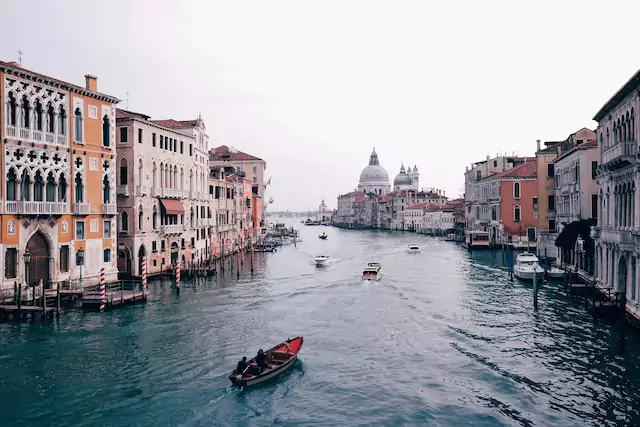
Things to do in Venice
- Take a gondola ride on the Grand Canal. Gondola rides have a standardised price of €80 during the day or €100 after 7pm for a 30 minute tour, and boats can fit up to six people. If you’re travelling solo and don’t want to splurge on a private gondola tour then you can book a shared gondola ride online for around €30 , or you could ask around at your hotel/hostel to see if there are any other solo travellers who might want to share the cost.
- Walk over the iconic Rialto Bridge
- See the magnificent paintings that adorn the walls and ceiling of Doge’s Palace , as well as the 12th/13th century gold mosaics inside St Mark’s Basilica
- Have a go at creating your own glass souvenir with a private lesson from a master artisan , this experience is only €60 which is incredibly cheap for such an authentic local experience
- Catch a vaporetto (water bus) to Burano, famous for its colourful houses, and Murano, famous for its glass workshops and galleries
- Experience the city’s gastronomy with this food tour which includes 15 food tastings!
- Visit Acqua Altadi Venezia, the floating bookshop for a cool photo spot

Where to stay in Venice
Budget | Unfortunately my go-to Venice hostel (Wombats Cenice Mestre) shut down due to Covid, but Generator Venice (7.9/10) and Ostello S. Fosca (8.4/10) are the top-rated hostels on booking.com, otherwise there’s cheap private rooms at Hotel dalla Mora , Locanda Silva and Hotel La Residenza
Mid-range | Check out Scalon del Doge , CàPatron , La Veneziana Boutique and Relais Venezia
Luxury | Hotel Metropole Venezia , Ca’di Dio , Palazzo Nani Venice and the absolutely incredible Gritti Palace for something super special
Self-contained | Cà Sant’Angelo , Hotel Rialto and Ai Patrizi di Venezia have options with kitchen facilities
The Dolomites
How to get to the Dolomites from Venice: An easy train journey with one change in Verona, the trip takes anywhere from 2h 45m to 3h 45m depending on the transfer time.
Seat reservations: Some journeys are with regional trains that don’t require reservations for rail pass holders, some have just the initial Venice to Verona train as requiring €12 reservations, some require reservations on both trains so €24 total.
The Dolomites are a mountain range in Northern Italy, and they’re home to some of the most picturesque landscapes you’ll find in the whole of Europe.
In the warmer months the Dolomites are a hub for hikers, bikers and climbers, with plenty of trails for adventurers of all ages and fitness levels. In winter the Dolomites Superski region boasts 15 ski resorts, more than 1200km of slopes and plenty of bars and restaurants to continue the fun after a day on the mountains.
In the Dolomites it’s easiest to explore by car as the public transport isn’t super well connected, and wait times can cut into your short stay. Car rental can be quite cheap, there were deals for €25 per day when I was there in October, but in peak season it would be best to book ahead if you can.
Keep in mind that non-European drivers need an international drivers license in Italy, your own country license won’t cut it. Rental companies might let you hire a car without one but if you’re involved in any accidents (not unlikely in Italy!) you won’t be covered by insurance without an international license, and if you’re pulled over for any reason then chances are you’ll get stung with a hefty fine.

Things to do in the Dolomites
- Go to Lago di Braies for sunrise, pure magic (though chances are you’ll be there with many photographers)
- Head to Lago di Carezza for picture-perfect reflections of the mountains, I’m sure this place is busy during peak season but I visited at sunset at the end of October and had the whole place to myself
- Spend a day at Alpe di Siusi, the largest alpine plateau in Europe. You can take the Mont Seuc cable car from Ortisei, then walk two hours to the other side and take the Seiser Alm cable car back to the the Valley Station, where you can catch a short bus back to Ortisei.
- Experience the unique South Tyrolean cuisine, which incorporates Italian, German and Austrian ingredients and cooking techniques
- Try some of the best pasta in the world at Pastalab in Bolzano, their menu changes daily with seasonal specialties and honestly my mouth is watering while typing this. Don’t miss it.
- Explore the hiking trails of Tre Cime di Lavaredo, some notable options are the Cadini di Misurina viewpoint and the Rifugio Auronzo loop
- Another must-do hike is the Seceda ridgeline, if you can hack a super early wake up then arriving here for sunrise will be well worth it
- If you’re up for a physical and mental challenge, consider a via ferrata, a climbing track that has iron rungs attached to the rock as well as a steel cable that climbers connect to with carabiners. My first via ferrata was the Wildwire waterfall climb in Wanaka, New Zealand and I absolutely loved it, so a Dolomites via ferrata is very high on my list for my next visit.

Where to stay in the Dolomites
There are so many different villages in the Dolomites and it would take hours to give you recommendations for different budgets for each village so I won’t do that.
Bolzano is the capital city of South Tyrol and is the gateway to the Dolomites, you can stay here and do day trips by bus or car, or you could arrive here by train and then catch local transport to one of the villages in the Dolomites, like Ortisei in Val Gardena, Colfosco or Corvara in Alta Badia, or Villabassa or Braies in Upper Puster Valley.
Where I stayed | I stayed at the LOOM Hotel in Bolzano which was super unique, it’s actually a living showroom for an interior design company who wanted to showcase what they could offer hotels around the world, and their rooms double as accommodation for travellers. Such an incredible idea for sustainable tourism and the rooms are truly something else!
Salzburg or Innsbruck
How to get from the Dolomites to Salzburg: Either a direct train or a journey with one or two stops, reservations dependent on the journey you choose
How long to stay: 2 days (accounting for a day trip at the one you aren’t staying in)
Though Salzburg’s main drawcard are its connections to music (as in ‘The Sound of’, as well as Mozart), it’s also well worth a visit to get into a more relaxed pace of tourism after the chaos of Italy. Explore the historic old town, get the best view from Festung Hohensalzburg, see the sheer opulence of grand palaces and search for the city’s most delicious schnitzel and strudel.
Innsbruck has a more modern vibe, not in the architecture but in the energy of the city, the gastronomy, and particularly in the apres-ski scene.
For your two month Europe itinerary you could choose one to stay the night in and one to stop at for a day trip on your way between the Dolomites and the next stop of Vienna.
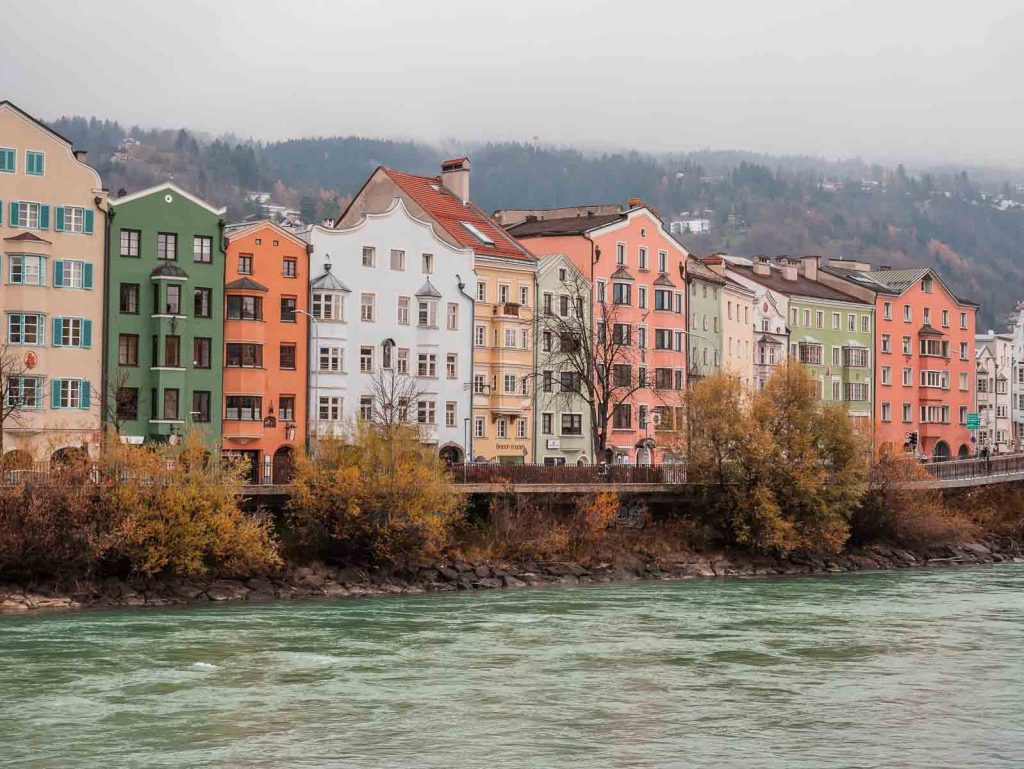
Things to do in Salzburg
- Book a Sound of Music tour to see the city from Maria’s eyes
- Catch the funicular up to Fortress Hohensalzburg for the best view of the city, then walk down the path to get back to the Old Town
- If you’re interested in medieval history, you can buy a ticket to the exhibits at the Fortress and learn more about the building’s past
- Walk through the magnificent halls and gardens of Schloss Mirabell, a 1606 palace, or see the fairytale-esque summer palace, Schloss Hellbrunn where you can find the iconic Sound of Music gazebo
- Enjoy the symphonies of Mozart with a variety of Mozart-related activities, from visiting Mozart’s birthplace (now a museum), to watching a Mozart concert at Mirabell Palace , to a Life of Mozart walking tour around the city
- Take a day trip to the Eagle’s Nest , Hitler’s vacation home in the Bavarian Alps, one of the few Third Reich buildings that remains in its original state today, complete with a marble fireplace gifted to Hitler by Mussolini. If dark tourism isn’t your thing, it’s worth going just for the sweeping views of the valley below.
- Watch the daily organ performance at the spectacular Salzburg Cathedral
Things to do in Innsbruck
- Stroll through the winding streets of the Altstadt (Old Town), where you can see vibrant facades, ornate doorways and classic Tyrolese architecture
- Climb up the City Tower if you’re visiting on a clear day, you can see right over the Old Town colourful buildings and out to the mountains that surround the city
- Spot the grandiose Golden Roof, a Gothic viewing box built in 1496 with gilded copper tiles giving it a metallic shine
- Catch the Hungerburgbahn funicular up to Nordkette, the closest mountain to Innsbruck that offers scenic viewpoints and restaurants
- Find the city’s best schnitzel, I rate Altstadt-Schmankerl as a top contender!

Where to stay in Salzburg
Budget | I stayed at MEININGER Salzburg , a hotel/hostel hybrid with dorm rooms, private rooms, guest kitchen, laundry facilities, hotel bar and bikes for rent. Slightly out of the city but right next to a bus stop, a great budget option. Other cheap options are YoHo Youth Hostel , Stadtalm Naturfreundehaus and The Keep Eco Rooms .
Mid-range | Gästehaus im Priesterseminar Salzburg , Hotel Max 70 , B&B Villa Verde and Boutiquehotel am Dom
Luxury | Hotel Bristol , Goldgasse , Hotel Goldener Hirsch and Hotel Sacher Salzburg
Self-contained | Villa Leopoldskron , Villa Maxglen , Mozart’s Garden Villa and Villa Salzburg
Where to stay in Innsbruck
Budget | Montagu Hostel , MEININGER Innsbruck Zentrum and Pension Stoi
Mid-range | Hotel Neue Post , Hotel Mondschein , Nala Individuellhotel and Faktorei
Luxury | Hotel Maximilian , the PENZ Hotel , aDLERS Hotel Innsbruck and Altstadthotel Weißes Kreuz
Self-contained | Kaiser Max Design Apartments , Apartment Mischa , Quartier 99 and Prada Elf Apartment
How to get to Vienna from Salzburg or Innsbruck: Direct train from Salzburg (2h 25m-2h 55m depending on the train) or direct train from Innsbruck (4h 20m-4h 50m) with an optional stop in Salzburg for a day trip.
Seat reservations: Seat reservations generally aren’t required in Austria but Austrian inter-city tickets are typically quite cheap so check the ticket price before using a Eurail travel day to make sure it’s worth it.
Vienna is brimming with culture, from extravagant coffee houses (with equally extravagant desserts), to countless museums and galleries, to architecture that is mostly Baroque but also spans the Gothic, Renaissance and Rococo styles.
Vienna is what you make of it, my favourite kind of city. Foodies can fill their time with food tours, sweet treats and traditional fare, travellers with an interest in history are spoilt for choice with heritage buildings and world-class museums dotted all over the city, and photographers will love the opportunities provided by Vienna’s unique architecture and fascinating interiors.

Things to do in Vienna
- See the city with a free walking tour, by far the best way to get your bearings
- Relax with a coffee and a sweet treat at one of the famous coffee houses, Café Central and Café Landtmann are two of the most famous ones, but there are many, many more to discover
- Take a 2.5 hour food tour through the bustling Naschmarkt to learn about Vienna’s culinary specialties, or try a longer four hour food tour through the city which includes a coffee house, the market, a bakery and a chocolate shop. Yum!
- Learn about one of the first famous solo female travellers, Empress Sisi. She was the Empress of Austria and Queen of Hungary but hated the rules and regulations that came with her royal titles, so she fled her responsibilities and travelled solo whenever she got the chance.
- Ride the rollercoasters at Prater themepark
- Visit the breathtaking State Hall at Austria’s National Library
- Try a käsekrainer from a würstelstand, one of the best cheap eats in the city
- Have a schnitzel dinner, you’ll find it on pretty much every restaurant menu but the best-rated ones in the city are Figlmüller, Gasthaus Kopp, Schnitzelwirt or Restaurant Pürstner
- Head up St Stephen’s Cathedral for sunset from the rooftop
I’ve got a detailed Vienna travel guide if you want more info on things to do in Vienna

Where to stay in Vienna
Budget | Vienna is home to one of the best hostels in Europe, JO&JOE Vienna . This place truly has everything you could wish for in a hostel; guest kitchens, onsite restaurant, laundry facilities, a rooftop with epic views, funky dorms with privacy blinds, spacious private rooms, loads of fun events, a big screen for movies and sports games, work-friendly spaces and more. Phew!
Mid-range | Boutiquehotel Das Tyrol , Rioca Vienna Posto 2 , Superbude Prater and ARTIST Boutique Hotel
Luxury | Rosewood Vienna , The Leo Grand , Hotel Sans Souci and Hotel Sacher
Self-contained | Karl und Anton Boutique Apartments , Oliver Apartments and URBM Rise
Day trip to Bratislava
How to get to Bratislava from Vienna: RegioJet and FlixBus have buses from as low as €4 which take between 40m and 1h 20m depending on the time of day, or if you’re totally set on train travel you can get a direct train from €10 which takes an hour
Slovakia’s capital city is an easy day trip option from Vienna, with a vibrant old town that you can explore with 5-6 hours on the ground. If you’ve got a day to spare during your time in Vienna then a Bratislava trip lets you see a new country and experience a city with fascinating history.

Things to do in Bratislava
- Take a short but steep walk up to Bratislava Castle for the best view in town
- See the Blue Church (actual name St Elizabeth’s Church), an Art Noveau church that looks like it’s straight out of The Smurfs. Its opening hours are random and changeable, currently it’s open from 6.30-7.30am Monday to Saturday, 7.30am-12pm Sunday (for services I presume), and 5.30-7pm seven days a week. It’s worth going inside if your timing is right, the interior is a mix of baby blue and yellow with intricate details if you look closely.
- Enjoy prices being a little cheaper than the other parts of Europe you’ve seen so far!
- Get a cheap lunch at Funki Punki Pancakes, my go-to eatery in Bratislava. They’ve got a brilliant menu of crepes (both sweet and savoury) with prices sitting between €2.20 and €3.50 each.
- Wander through the Old Town past bright buildings, medieval streets, quirky statues and trendy boutiques
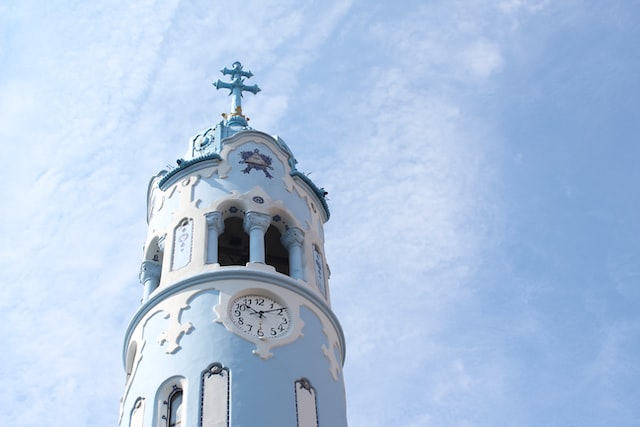
How to get to Budapest from Vienna: There are a few trains that run direct from Bratislava to Budapest but most of them go via Vienna anyway, so I’d recommend heading back to Vienna to pick up your luggage and going to Budapest from there.
Vienna to Budapest is an easy direct train that takes around 2h 41m, no rail pass reservations needed for most routes but tickets can be as cheap as €9 if you book in advance, check the price to buy outright before using a travel day on your rail pass.
Budapest is a fascinating city with a magnetic energy that attracts party-goers, history buffs, budget travellers and culture vultures alike, with things to fill the itineraries of every type of tourist.
You can see the major sights with two to three full days but if you have extra time and want to stay longer, you certainly won’t get bored.
One thing to note is that while Budapest has always been known as one of the best value destinations in Europe, Hungary is currently dealing with a cost of living crisis with inflation sitting at 22.5% in November according to WorldData , and the inflation rate for food in particular was 47.1% compared to the previous year. It was noticeably more expensive during my visit in December 2022 compared to my previous trip in 2019, so don’t be shocked if things don’t turn out to be as cheap as you initially expected.

Things to do in Budapest
- Watch the sunrise from Fisherman’s Bastion, where you’ll find the most incredible view of the city and the Danube
- While you’re up there, explore Buda Castle and the museums and galleries inside it
- See the city from the river with a Danube cruise
- Head to the Great Market Hall to buy some local meats, cheeses and produce
- Have a drink (or five) at Budapest’s iconic ruin bars
- Grab some street food from Karavan, a permanent food stall market near the ruin bars
- Relax and rejuvenate at the thermal baths , Széchenyi Baths and Gellért Baths are the most popular ones
- Learn about the city’s tumultuous past with a walking tour through the Jewish Quarter
- Visit my favourite bakery in the city, Aran, and try their famous cinnamon bun
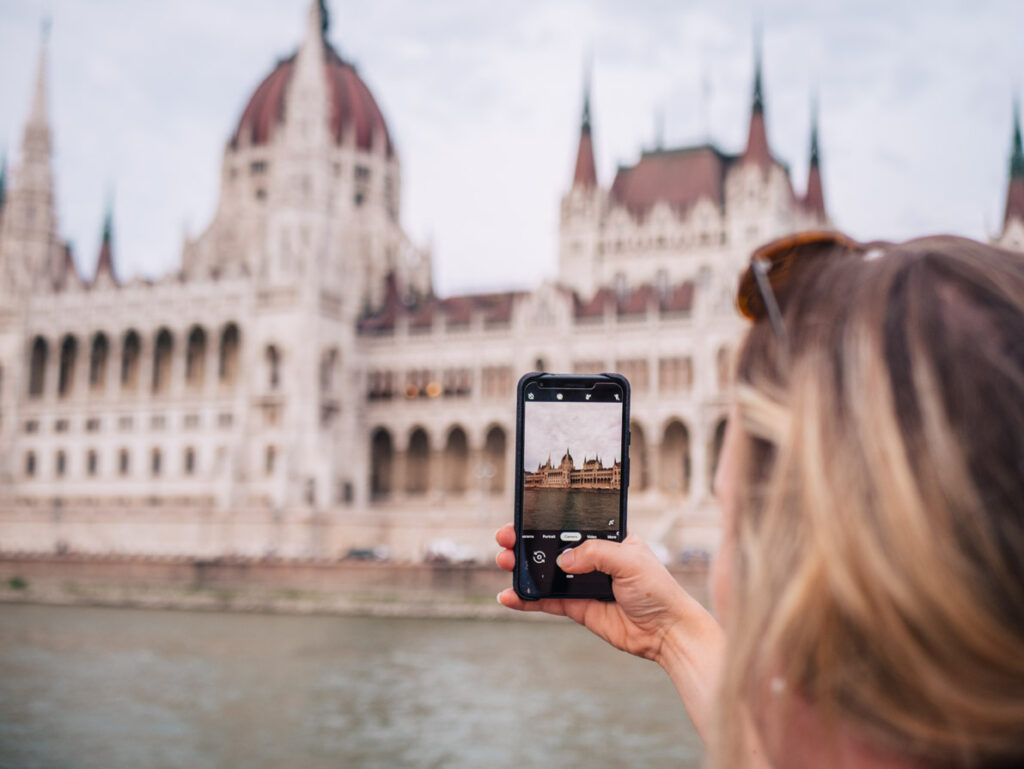
Where to stay in Budapest
Budget | I recently stayed at Flow Spaces which offers light and bright private rooms and dorm rooms, kitchen facilities and a dedicated workspace, the perfect option for digital nomads. I had a private room and loved it, I’d happily stay here for an extended period of time. I’ve also stayed at the quirky Das Nest Hostel which was ideal for a trip with friends, and other top-rated options are Hive Party Hostel and Hostel One .
Mid-range | Dob Twenty Rooms , LILIOM Apartment and OktoHome Suite are all great value apartment options, or for a mid-range hotel look at Global Suites Budapest or B&B Hotel Budapest City .
Luxury | For something sophisticated, consider staying at Alice Hotel , Hotel Memories Old Town or Hotel Moments Budapest .
Ultra luxury | If you’re celebrating something special in Budapest or just feel like treating yourself, you can’t go past the opulent Párisi Udvar Hotel Budapest or Matild Palace .
How to get to Prague from Budapest: Direct or one stop trains (stop in Vienna or Brno usually) that take between 7-8 hours.
Seat reservations: Some routes don’t require seat reservations, some require them at a cost of €6 so quite cheap.
Train prices: Outright tickets can cost as little as €18 for early or late trains when booking in advance, but could be as expensive as €110 for last minute bookings or popular times, so check prices before you decide to use a Eurail travel day.
Prague is another one of Europe’s top value cities with rich history, vibrant culture and striking architecture to offer.
While Prague didn’t totally evade bombings during WWII, it was significantly less affected than many other European cities so its historical monuments are mostly undamaged and sit in close proximity to one another, making it easy to explore on foot.
It’s also got an absolutely pumping nightlife scene, thanks to great beer, multi-storey nightclubs, and cheap flights from London making it a top choice for British lad stag dos.

Things to do in Prague
- Visit the Old Town Square, one of the most impressive in all of Europe. It dates back to the 12th century and is home to the Astronomical Clock, the Old Town Hall and the Church of Mother of God before Týn
- Stand below the Astronomical Clock on the hour between 9am and 9pm to see the procession of the 12 Apostles appear in the windows
- Climb the Old Town Hall tower to the observation deck to see Old Town Square from above
- Learn about the city’s political history with this top-rated communism and bunker tour
- Visit Prague Castle, one of the largest castle complexes in the world, occupying more than 70,000sqm. You could stroll through the Royal Garden, see the treasures inside St Vitus Cathedral, walk past colourful buildings down the charming Golden Lane and enjoy great views of the city before heading back to Old Town via Charles Bridge.
- Walking over Charles Bridge is a quintessential Prague experience in itself, the cobblestoned pedestrian bridge provides a great view of the castle on the hill as well as being able to see Baroque, Renaissance and Gothic architecture on the other side of the river
- Do a day tour to the Sedlec Ossuary , a.k.a. the Bone Church
- For something a little unique, walk down the river to reach the Dancing House, designed by Czech architect Vlado Milunić and the legendary Frank Gehry
- Try local brews with a historic pub tour
- Get amongst the buzzing nightlife with the legendary pub crawl

Where to stay in Prague
Budget | I stayed at Brix Hostel which was a social hotel, great for meeting people but not so great for digital nomads who need a quiet place to work. Other top-rated cheap accommodation options are Hostel Little Quarter , Sophie’s Hostel , Giotto Apartments , Hostel One Miru and Prague Dream Hostel .
Mid-range | Revelton Studios Prague , Hotel Residence Agnes , Hotel CUBE Prague , Allure Hotel Prague and Unitas Hotel
Luxury | The Julius , Four Seasons , The Grand Mark , Alchymist Grand Hotel and Hotel Republika
Self-contained | Mooo by the Castle , Hotel Diana and Malostranska Residence have options with kitchens/kitchenettes
How to get to Berlin from Prague: Direct trains run multiple times a day and take around 4h 15m
Seat reservations: No reservations required but you might want to book one (€8) during busy periods to ensure you get a seat
Train prices: They range drastically depending on the route, from €18.90 booking in advance to €90.60 for last minute tickets
Berlin is an essential destination for any Europe itinerary, it’s one of the best cities to learn about the atrocities that Europe suffered during WWII, the rise of communism in Eastern Europe and the subsequent reunification of Germany after many years of Berlin being split in two.
You’ve got the obvious landmarks, from museums to memorials to historical buildings that have been rebuilt and restored since bombs rained down on the city in WWII, but Berlin is also a unique melting pot of cultures, with a captivating arts and entertainment scene, superb culinary experiences and nightlife that rivals anywhere else in Europe.

Things to do in Berlin
- Any visit to Berlin would be incomplete without a city tour of some kind, to understand Berlin’s history throughout the 20th century. Some top-rated ones are this small group Third Reich & Cold War walking tour , this 75 minute Trabi safari , and this Hidden Backyards walking tour .
- Iconic landmarks to see include Brandenburg Gate, the Reichstag Building, Checkpoint Charlie, the Holocaust Memorial, Berlin Cathedral and the Berlin Wall Memorial
- Stroll along the East Side Gallery, the longest surviving section of the Berlin Wall which is now an open-air gallery with politically-charged street art
- Take a hop-on hop-off bus around the city to tick off the big sights quickly and easily
- Head up to TV Tower for the best view of the city
- Visit the museums, there are plenty to choose from!
- Delve into Berlin’s gastronomic delights with a top-rated secret food tour
- Experience the legendary clubbing scene with a night out on the town

Where to stay in Berlin
Budget | Pfefferbett Hostel , BIG MAMA Berlin , Kiez Hostel , New Hostel and ArtHotel Connection (a hetero-friendly LGBT+ hotel)
Mid-range | Wil7 Boutique Hotel , Casa Camper , Hotel Indigo , Wilmina Hotel and Hotel Q!
Luxury | Hotel Zoo Berlin , Hotel Adlon Kempinski , Hotel Luc and Regent Berlin
Self-contained | The Weinert Suites , Gorki Apartments and Wilde Aparthotels
How to get to Amsterdam from Berlin: Direct trains available a few times a day taking around 6h 15m-6h 30m, or one stop options with a short transfer in Hannover taking a similar amount of time.
Seat reservations: Seat reservations aren’t required for rail pass holders but busy routes recommend reservations (€8) to guarantee a seat
Train prices: From €37.90 if you book in advance to €161 for some routes last minute
Amsterdam is easily one of Europe’s most picturesque cities, with narrow houses reflecting in the canals, markets overflowing with vibrant flowers, and stylish locals peddling around town making for brilliant street photography opportunities.
Like Venice, Amsterdam also suffers massively from overtourism and you’ll find that the city’s landmarks can get extremely busy, particularly during summer and on weekends. With three or four full days you’ll have time to see many of the major sights without needing to be rushed off your feet, but I’d recommend purchasing skip-the-line tickets where possible just to avoid queues that eat into your adventure time.
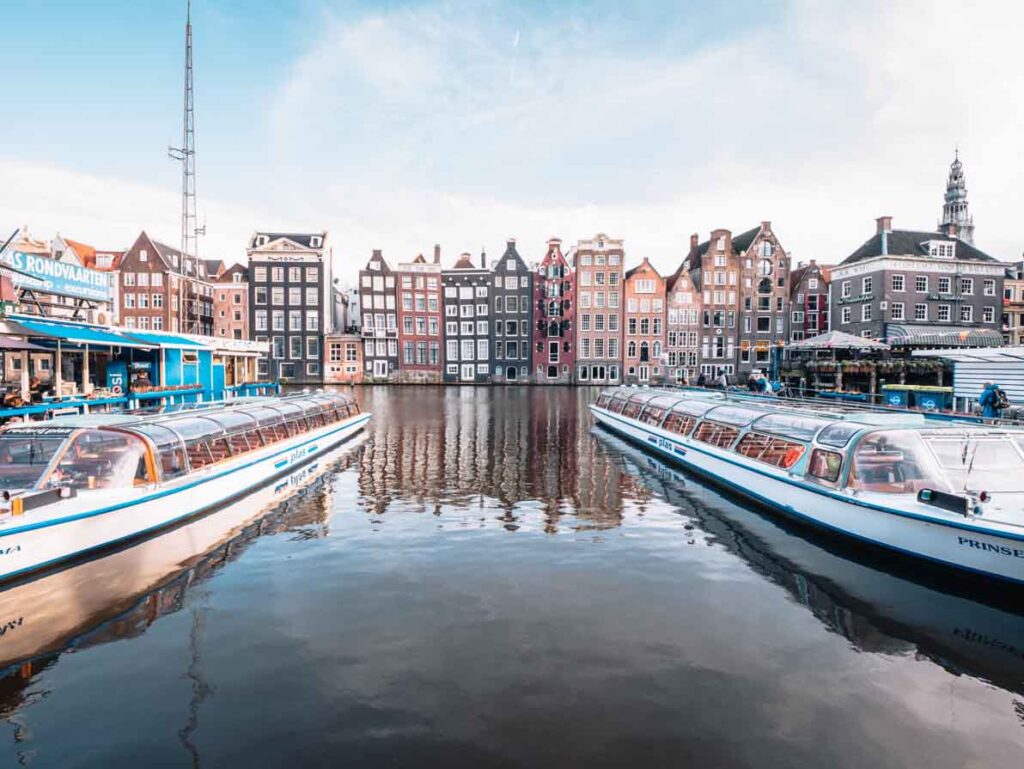
Things to do in Amsterdam
- Rent a bike and explore like a local, just be aware of all the rules so you don’t become a hazard
- Shop til you drop for vintage clothes, quirky souvenirs and stylish homewares. Amsterdam’s home and design stores in particular are beyond impressive and it hurts my soul to walk past them without being able to buy things. One day in the far future when I buy a house I’ll be coming straight to Amsterdam to stock up on knick-knacks to decorate my home.
- Hit the museums, some noteworthy ones are the Rijksmuseum for a deep dive into Dutch history and art, the Van Gogh Museum for Van Gogh masterpieces as well as works from his contemporaries, and the Moco Museum for more modern (read: Instagrammable) art
- If you’re a beer drinker, head to the Heineken Experience, an interactive self-guided tour through the beer behemoth’s former factory
- Visit Anne Frank’s house, now a biographical museum about Anne and her family
- Take a boat ride down the canal, there are plenty of cruise options ranging from budget-friendly tours to booze cruises to fancy dinner cruises
- Explore the Red Light District and get amongst Amsterdam’s infamous nightlife
- Experience Amsterdam’s growing brunch scene, I recommend Little Collins, Box Sociaal and the Lobby
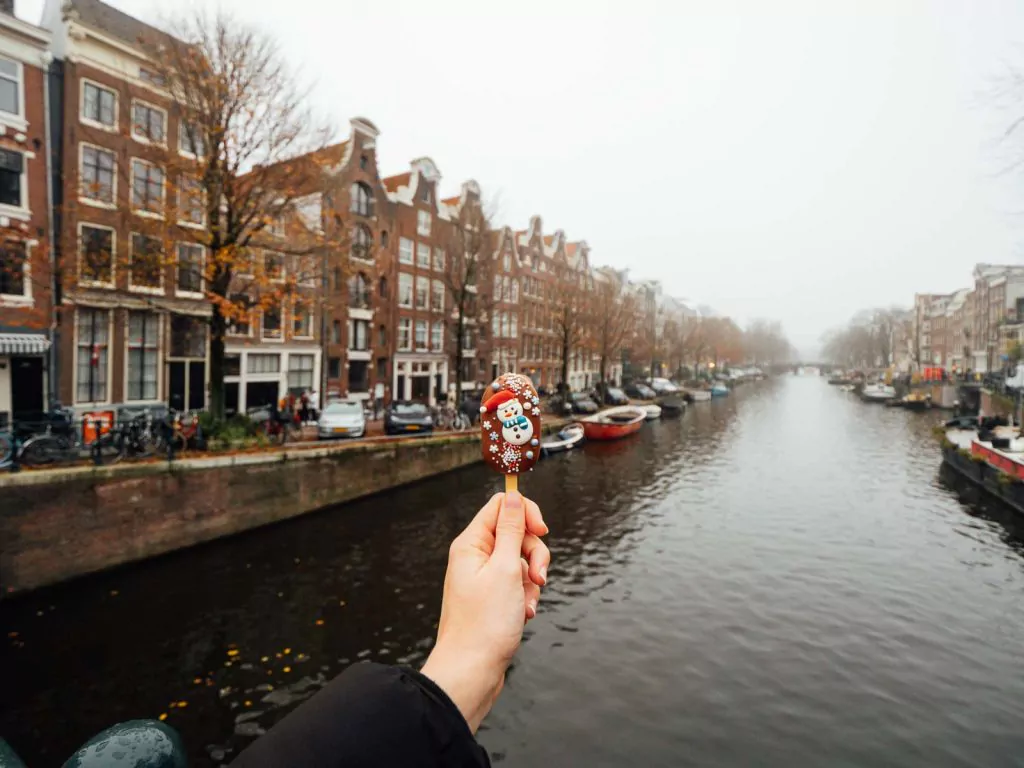
Where to stay in Amsterdam
Budget | On my most recent trip I stayed at MEININGER Amstel which was ideal, a hotel/hostel hybrid with comfy rooms, a full kitchen and a great location next to Amstel train station, ideal for rail travellers. Another great budget option is Hostelle , a ladies-only hostel which is perfect for first-time solo female travellers.
Mid-range | Outside Inn , Met Hotel , Villa Yburg ,and XO Hotels Couture
Luxury | Waldorf Astoria , Hotel TwentySeven , the Dylan , Conservatorium and De L’Europe
Self-contained | Treehouse Inn , Cityden BoLo , Social Hub and Hotel2Stay
How to get from Amsterdam to Bruges: A two-train journey with a change in Brussels (could stop for a day trip if you want)
Seat reservations: Seat reservations are usually required on the first train at a cost of €22, but there are some no-reservation options a few times a day that take closer to four hours
Train prices: From around €65 to €120 depending on when you book
The final stop in this epic 2 month Europe itinerary is Bruges, a fairytale town that’s photogenic from all angles.
It’s small and compact, easily explored by bike, by foot or by canal cruise, so it’s the ideal way to wrap up a very busy couple of months.
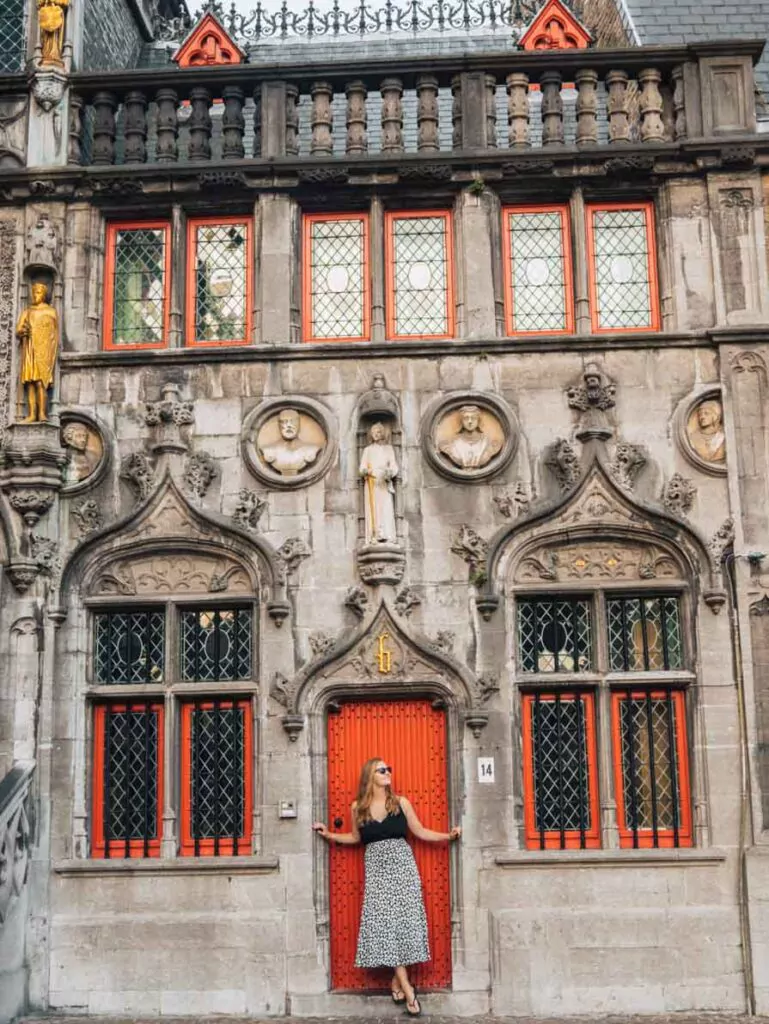
Things to do in Bruges
- Wake up early to enjoy the sleepy town as its quietest. Even cafes typically don’t open until 9am! Use this time to wander around and visit the best photo spots without the crowds.
- Walk more than 350 steps to the top of the Belfry to see the view
- Take a canal cruise
- Visit the Choco-Story Chocolate museum, do a chocolate walking tour or try your hand at making your own Belgian chocolate
- Visit the Basilica of the Holy Blood, a 12th century Romanesque church which houses a vial containing cloth stained by the actual blood of Christ (allegedly)
- Head to Sanseveria Bagelsalon, my favourite eatery in Bruges! They serve up amazing fully loaded bagels with fillings like peanut butter/banana/Speculoos, melted brie/bacon/walnuts/apple (my go-to) and raclette cheese/fried onions/gherkins
- Grab an outdoor table at one of the restaurants in the Market Square (Markt) to enjoy some moules frites with a view of the beautiful buildings that line the square

Where to stay in Bruges
Budget | There aren’t many well-rated hostels in Bruges but some good options are Snuffel Youth Hostel , Hostel Lybeer and St Christopher’s Bauhaus
Mid-range | B&B Valant , La Clé Brugge , Guesthouse Mirabel and Maison Amodio
Luxury | Dukes’ Palace , Relais & Châteaux Hotel Heritage and Dukes’ Arches
Self-contained | Maison Fred Luxury Suites , Old Bruges B&B , Aragon Apartments and Apartments Ridderspoor
Back to London
To get from Bruges to London you can catch the train to Brussels (1h) and then change to the Eurostar (around 2h).
I’d recommend spending a few hours in Brussels to see the main sights on the way, there’s plenty of luggage storage at Brussels station so you can explore without your suitcases.
Wander around the Grand Place, see the Royal Palace of Brussels, or visit one/some of the museums if you have time. And if you’re hungry, I’d highly, highly recommend heading to Tonton Garby near the Grand Place, an incredible sandwich shop with 4.8/5 on Google from more than 1600 reviews. There’s no menu, they’ll ask you questions about what flavours you like and they’ll make a bespoke sandwich perfectly suited to your tastes. Worth the wait!
If you’re flying into London rather than taking the train and you land late, consider spending a night at the airport to have a good night’s sleep and then start your London trip feeling fresh the next day. If you’re flying into Gatwick I highly recommend Bloc Hotel , they have brilliantly cosy rooms available just a minute’s walk from the arrivals section, or for Heathrow I love love love the Hilton Heathrow T4 , it has a covered walkway to Terminal 4 plus shuttles to other terminals, incredible eco-friendly design and a fantastic sustainability-focused restaurant.
Alternative cities/routes you could add or switch out
Add christmas markets if you’re travelling in november/december.
Europe’s Christmas markets start popping up from around mid-November, so if you’re braving the chilly weather and wanting to see some festive events then you’ll want to plan your itinerary around these. I’ll be putting together a Christmas market rail itinerary shortly, but in the meantime some additional places worth adding to your list are:
- Strasbourg and Colmar in France
- Dusseldorf and Cologne in western Germany
- Frankfurt in central(ish?) Germany
- Rothenburg ob der Tauber and Nuremberg in southern(ish?) Germany

Skip some of Italy
This itinerary has a lot of Italy because a) it’s probably my favourite country in Europe and b) it’s really well connected by train so easy to tick off a bunch of places without spending too long on transport.
If you’re not super keen to spend two weeks in Italy then you could limit the Italian portion of this trip to just Rome and Venice for example, and have more time for other destinations.
Skip Barcelona
Barcelona is a bit out of the way on this itinerary, with a long trip from Paris (6h 30m) and fairly trip to Lyon (5h 20m), both of which have expensive seat reservations if you’re travelling with a rail pass.
You could save yourself some travel time by skipping Barcelona and just going from Paris to Lyon direct, which is only two hours on a high speed train and reservations are only €12, so you’d save a significant chunk of money too,
Skip Switzerland to keep it cheap
Switzerland is definitely the most expensive country on this itinerary, so if you’re on a really tight budget then you could consider skipping it to have extra time in places like Prague, Budapest or add on Warsaw or Krakow in Poland instead.
If you’re travelling with a rail pass then I’d highly recommend doing at least the Bernina Express in Switzerland because you get a huge discount on the usual price. You could even just spend some time in Tirano and do the Bernina Express return trip, so you can see the scenery without needing to splurge on Switzerland accommodation.
Add on more of Germany plus Copenhagen
If you were reducing your time in other countries, there might be space for you to add on some other German cities like Munich and Hamburg, and Copenhagen is an easy 4h 45m direct journey from Hamburg. From Copenhagen you could easily do a quick trip across the Swedish border to Malmö, just 24 minutes by public transport.
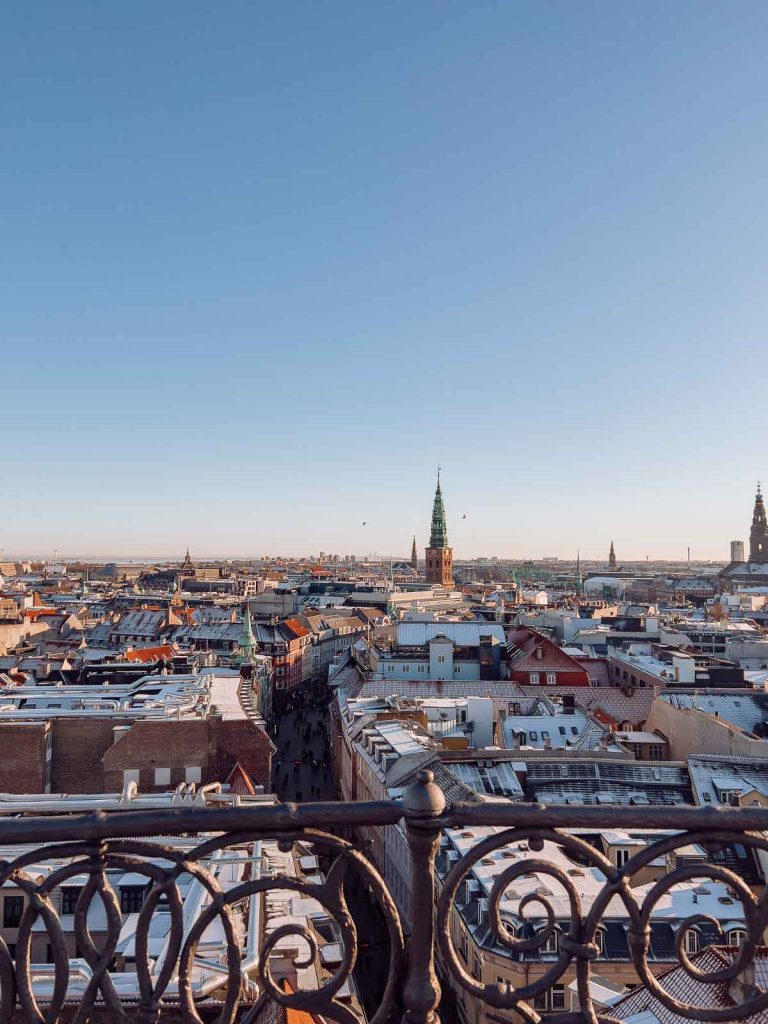
Add on some of Poland
A cheaper add on option (if you didn’t mind long travel days) would be Poland, you could visit both Krakow and Warsaw with direct train or bus routes running from Budapest, Vienna, Prague and Berlin.
Poland is super cheap so if you’re wanting the best bang for your buck this could be a great place to visit. And if you’ve got more time, you could replicate my two week Poland itinerary and slot that into your Europe trip between Prague and Berlin.
Add on more of Spain and Portugal
The reason I haven’t included much of Spain and Portugal is because if you’re using a rail pass, seat reservations must be made at the ticket offices in the country once you’re there, or with Deutsche Bahn (Germany’s railway company) at an office or over the phone. This type of admin is quite tricky for first time rail pass travellers so if you’re really keen to see this part of Europe, I’d recommend doing a lot of research on the Eurail community forum to make sure you know what you’re doing.
In Spain you could go from Barcelona to Valencia, Alicante, Granada, Seville and then Madrid, before scooting over to Portugal and heading down the coast from Porto to Lisbon to Faro.

Add on some islands
Did you know that Eurail passes also give you discounts on some ferries from Italy to Greece and through the Greek Islands? If you’re keen to enjoy paradise islands then you could travel by train to Bari in Italy, then catch the ferry to Corfu, Igoumenitsa or Patras and continue your Greece island hopping from there.
2 month Europe train itinerary FAQs
Should i train or fly in europe.
While Europe does have loads of low cost airlines with crazy cheap flights, flying comes with additional costs like transfers to the airport, wasted time in security lines and of course the impact on the environment, not to mention huge prices for add ons like a check in suitcase or seat selection.
Trains are much more straightforward, often leave from the central city or nearby, you get to enjoy the scenery, and it’s easier to stretch your legs if you’ve got a long journey.
If you need to get from one side of Europe to the other then consider flying, or if you need to get between small cities without great train connections then a flight might be easier, but for simple journeys between two major European city hubs then a train is by far the easier option.

Is a Eurail pass worth it?
It really depends. A Eurail Pass is worth it if the cost of the pass + seat reservations is less than the cost of the train tickets if you bought them outright.
I answer this question in much more detail in my Eurail budget breakdown but here’s a quick summary.
If you already have a good idea of your itinerary (or if you want to follow this one) then I’d recommend typing up all the journeys you want to take and searching them on Rail Europe to see what the price would be if you booked them outright. Then check on the Eurail website for the same journeys to find out the seat reservation cost, add this to the price of the pass you’d need, and you’ll figure out which one is better value.
If you’re spending time in Switzerland and want to take the Glacier Express , Bernina Express or any other scenic trains then the Eurail Pass is definitely worth it, you’ll save loads on these trains alone.
If you don’t know your itinerary yet (and you’re travelling soon), or if you want to keep flexible and be able to decide on your route only a few days in advance then a Eurail Pass is almost certainly worth it, it lets you avoid expensive last minute tickets.
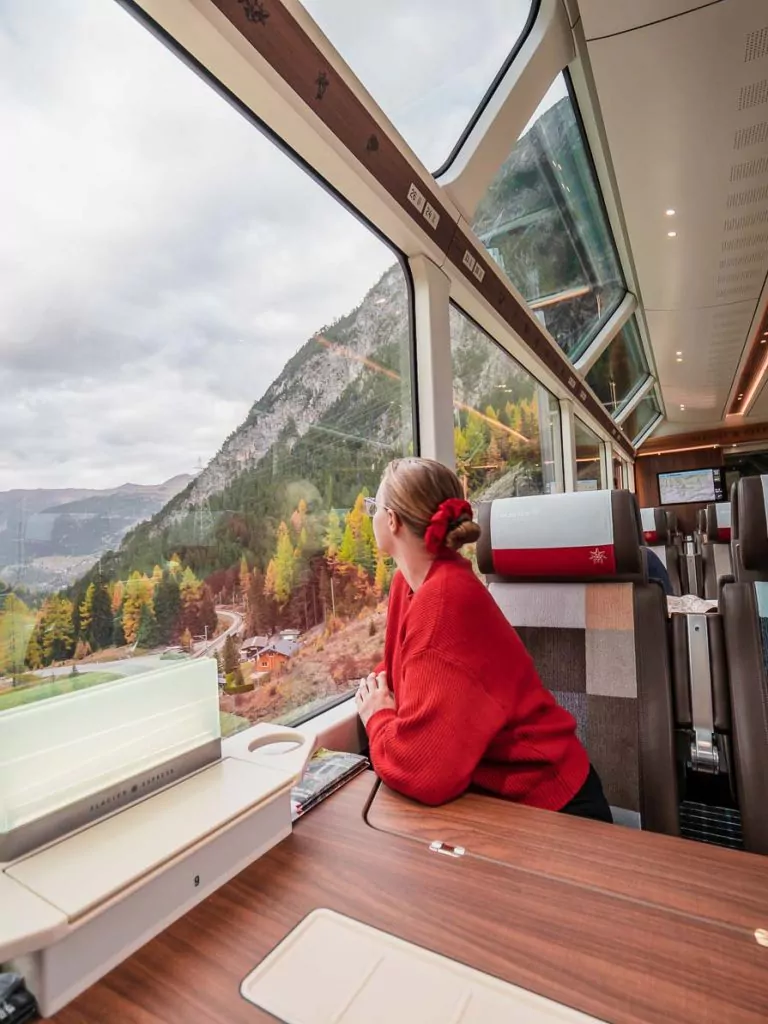
Is Europe safe for solo female travellers?
Specific safety tips will depend on the country but yes, overall Europe is absolutely safe for solo female travellers and I’ve never felt unsafe on all my solo travels in Europe.
Things to be aware of as a solo female traveller (or as any traveller!) are:
- Wear crossbody bags with your wallet in a zipped pocket
- Use a luggage cable to lock your suitcases to the luggage racks on trains
- Always have comprehensive travel insurance with both medical and luggage cover, I use Cover-More New Zealand travel insurance
- If you’re having a night out, always keep an eye on your drink and avoid getting too drunk as it can make you an easy target
- Stay in female-only dorms and night-train cabins
- Get a European SIM card that gives you data so you’re always able to access the internet, maps and transport/taxi apps

And that wraps up this huuuuge 2 month Europe itinerary! I hope this has helped you map out your own two month Europe itinerary, or at least has given you some useful destinations tips for your Europe train itinerary no matter how long you’ll be travelling.
If you have any questions or need any help with your Europe train itinerary then please let me know in the comments or flick me a message on Instagram.
MORE EUROPE TRAIN ITINERARIES:
- The perfect three month Europe itinerary without flying
- A Europe Christmas market itinerary by train
- How to spend 1, 2 or 3 weeks in Northern Italy & Switzerland
- How to spend 3 weeks in Scandinavia
- The perfect 10 day itinerary for Switzerland
- How to spend 2 weeks in Poland
MORE EUROPE TRAIN TRAVEL GUIDES:
- How to use a Eurail Pass
- Is a Eurail Pass worth it?
MORE EUROPE TRAVEL INSPIRATION:
- The most beautiful train rides in Europe
- 27 Europe holiday ideas to inspire you
- The ultimate Italy bucket list
- 33 beautiful places to visit in Switzerland
MY GO-TO TRAVEL PLANNING RESOURCES Flights ✈️ I use Skyscanner to find the best flights for my trip and then I’ll always book direct with the airline to protect myself from having to deal with dodgy third parties if anything goes wrong. Trains 🚂 If I’m travelling through Europe, I try to travel by train wherever possible! For an extended trip (2+ weeks) I’ll calculate if a Eurail Pass is worth it , or I’ll book point-to-point tickets through RailEurope or the local train operator. Accommodation 🛎️ I book almost all of my accommodation through booking.com , they have a user-friendly website + app and many of their options are free cancellation, easily cancelled with a simple click of a button. Activities 🗽 I use GetYourGuide , Klook and Viator to look for activities in the places I visit, or I just Google ‘things to do in [city]’! Travel cards 💳 I’m a Wise gal through and through, they’ve been my chosen travel card for more than five years now. You can easily top up your card from your bank account or through Apple Pay, convert your money to local currency, and spend money with minimal fees and the best exchange rates around. Travel insurance 🩺 I use Cover-More NZ travel insurance for my own trips, I have a comprehensive policy and I’ve only had good experiences with them. Cover-More also has an Australian company , but if you’re from elsewhere then two popular insurance options for global travellers are SafetyWing (cheaper policy, lower coverage) and World Nomads (more expensive but significantly better coverage). Luggage 💼 I travel with Samsonite Cosmolite suitcases , one 75cm check in bag and a 55cm carry on bag, and I absolutely adore them and will never travel with anything else! They are SUPER lightweight (2.8kg and 1.9kg respectively) so I have much more space for my actual stuff. Camera gear 📸 These days many of my photos and all of my videos are with my iPhone 15 Pro Max , my main camera is a Lumix G9 but I have a secondary camera (my old one) that’s a Lumix GX85 , I use a DJI Mini 3 Pro drone and a GoPro Hero 10 . I do all my writing and editing on my HP Spectre x360 , it’s super lightweight and perfect for travel.
You’ll Also Love

May 10, 2023 at 5:25 pm
Some of the accommodation is expensive how much money do u need for this frip
May 11, 2023 at 11:28 am
I’ve included budget accommodation in each of the cities for that reason, so you can pick and choose what accommodation and activities will fit into your budget.
If you’re happy staying in dorm rooms and cooking most of your own meals then in Western Europe you could probably budget €70-80 per day, Eastern Europe will be cheaper at €40-50 per day. If you want to stay in hotel rooms and enjoy a meal out once or twice a day then it really depends on which country/city as Switzerland is more expensive than Spain, and Paris is more expensive than Lyon for example, but as an average amount I’d say €100-130 per day for Western Europe or €70-80 for Eastern Europe. That’s if you’re sharing a hotel room with a partner or a friend, it would be a bit more if you’re travelling solo. Hope that helps!
August 5, 2023 at 6:55 pm
I found this very helpful and detailed—both important. I did have a question on how one might condense this into a two to three week trip. I think my job will not allow me to take more than three weeks maximum off for vacation. But, I’m very enticed to see as much as we can in such a short time frame. I almost considered just modifying your schedule and cutting locations that are not “essential”. Thanks for your thoughts/consideration.
August 9, 2023 at 9:08 pm
With three weeks you could do a smaller route, and it would be particularly helpful if you can fly into one place and out another so you aren’t wasting days getting back to your original destination. You could fly into London and then do Paris, Amsterdam, Berlin, Prague, Budapest and Vienna for example! It really depends on what you’re interested in and what destinations are your essential stops.
September 13, 2023 at 1:08 pm
How much stuff did you pack? Backpack? Suitcase?
September 14, 2023 at 2:33 am
I travel for 9-10 months of the year and have loads of camera gear so I use a suitcase 🙂
Leave a Reply Cancel reply
Your email address will not be published. Required fields are marked *
- SEE ALL BLOGS
- GET INSPIRED
- DESTINATIONS
- SOLO TRAVEL
- TRAVEL PLANNING
- BLOGGING RESOURCES
Join my email list
Subscribe to be the first to know about new blog posts, travel hacks, giveaways and more.
Finding Alexx is a participant in the Amazon Services LLC Associates Program, an affiliate advertising program designed to provide a means for sites to earn advertising fees by advertising and linking to Amazon.com.
- About Finding Alexx
- Work with me
- Privacy policy
Copyright © 2024 Finding Alexx
- Skip to primary navigation
- Skip to main content
- Skip to primary sidebar

Destinations
Experiences.
- Photography
Plan Your Trip
Europe starts here.
It isn’t easy to put a 2 month Europe itinerary together—I say this as someone with almost 20 years of experience traveling on the continent!
The main reason? When you consider how massive Europe is—it’s as big as the continental US, but much denser and more culturally diverse—two months just isn’t very long. Certainly, it’s not enough to see “everywhere” in Europe, or even get close to doing so.
Over the next several paragraphs, I’ll inform and inspire your travels, whether you use your two months in Europe to get a high-level overview of European cities and countries, or dig deep into one or two regions. We’ve got a lot of ground to cover, however, so let’s get started.
Practical Matters
When to visit europe.
While I love visiting Europe during the hottest part of the summer, the reality is that this is also the most crowded and expensive time to explore the continent. Likewise, although there’s no denying the charm of the Alps during the winter, things get busier and costlier the closer you get to the ski slopes. For a European vacation with great weather and relatively few fellow tourists, visit during the “shoulder” months of April, May, September and/or October.
Where to stay in Europe
You should plan on staying in a variety of accommodations during your Europe 2 month itinerary. While certain miles-and-points travelers may decide to sleep entirely at big-name hotels and resorts, the preferable strategy is to tailor your stay to your destination. Boutique city hotels (Seville’s H10 Corregidor Hotel is a great example of this) make sense in cities like Lisbon, Berlin and Stockholm, while resorts and villas with terraces and pools are more worth the expense on Italy’s Amalfi Coast or in the Greek Islands.
How to get around in Europe
The good news? Europe has one of the most efficient railway systems in the world. While not as modern as China’s or as uniform (or fast) as Japan’s, trains in Europe will get you to where you need to go at a relatively low cost and with minimal stress. In most cases, I don’t feel that a Eurail Pass is worthwhile, for what it’s worth.
What I do always recommend, on the other hand, is looking at the Schengen Area map and then comparing the price of flights and trains. If a prospective flight is cheaper—and especially if it’s on a “real” airline—this is probably your best bet.
Money, costs and communication
While most of Europe uses the euro, this is not the case in every country, particularly ones on the eastern half of the continent. Additionally, most transactions in Europe have rapidly become cashless, further decreasing the complication of traveling across borders. With this being said, costs are relatively high: The minimum you can expect to spend to enjoy Europe is 100 USD per person, per day—if you want to travel in comfort, you’ll need to spend more than this.
Regardless of your 2 month Europe trip cost, communicating on the continent is relatively easy. This is true in both a literal and figurative sense. Most Europeans can speak quite a bit of English; WiFi is ubiquitous enough that even if you don’t purchase a SIM card, you’ll be able to connect in most places you wind up.
The good news? eSIM technology has now made its way to Europe. The better news? If you buy your Western Europe eSIM or Eastern Europe eSIM online today , you can be connected the moment you land!
Where to Go With 2 Months in Europe
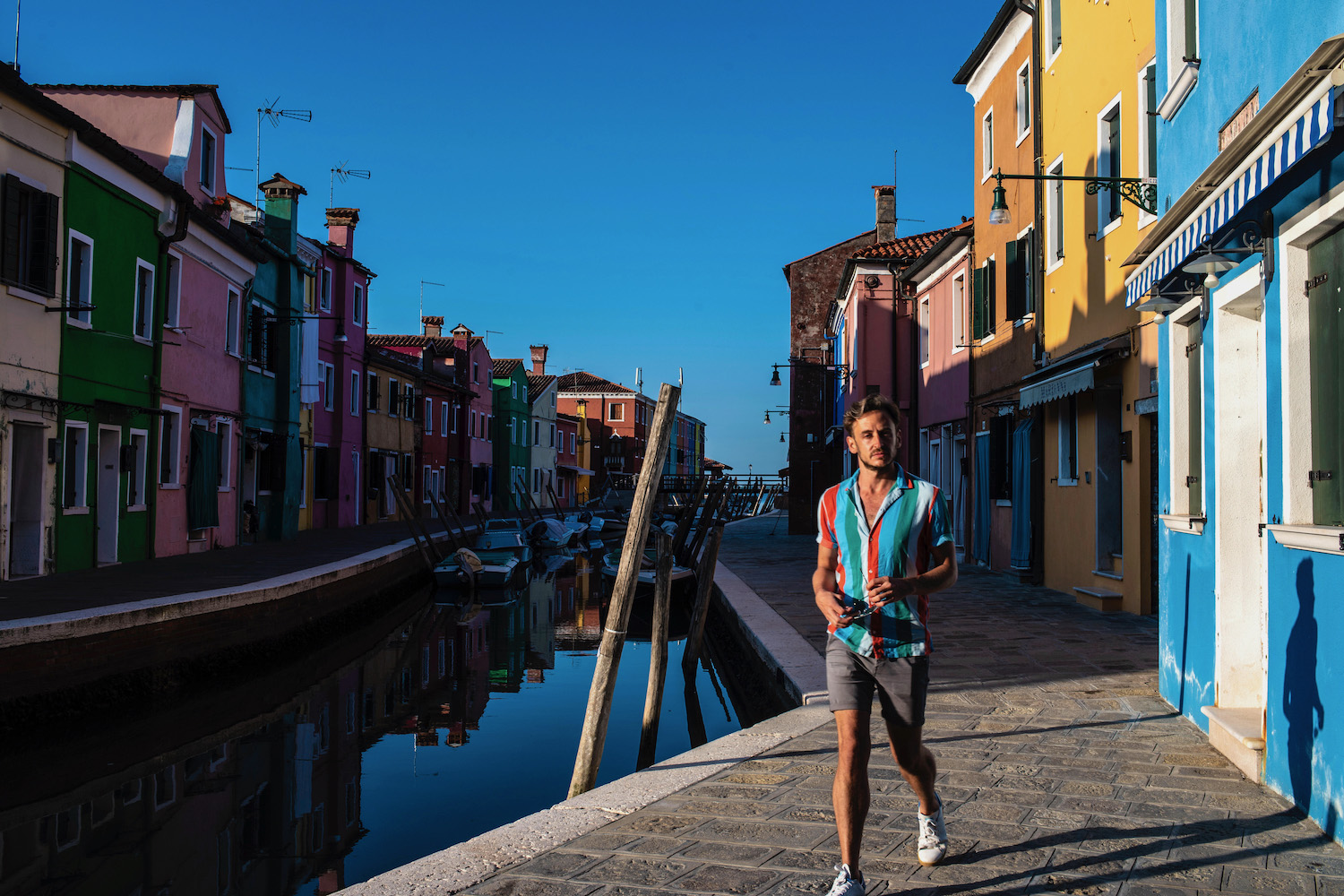
Those of you who’ve read my site for any length of time won’t be surprised that I prioritize Italy when I visit Europe. Plan to spend 2-3 weeks of your three months here. I usually like to zig-zag across the country, starting in Milan , before heading over to Venice and then traveling southward via Tuscany and Rome to Naples and the Puglia region—and, if you have time, Sicily and Sardinia .
Spain and Portugal
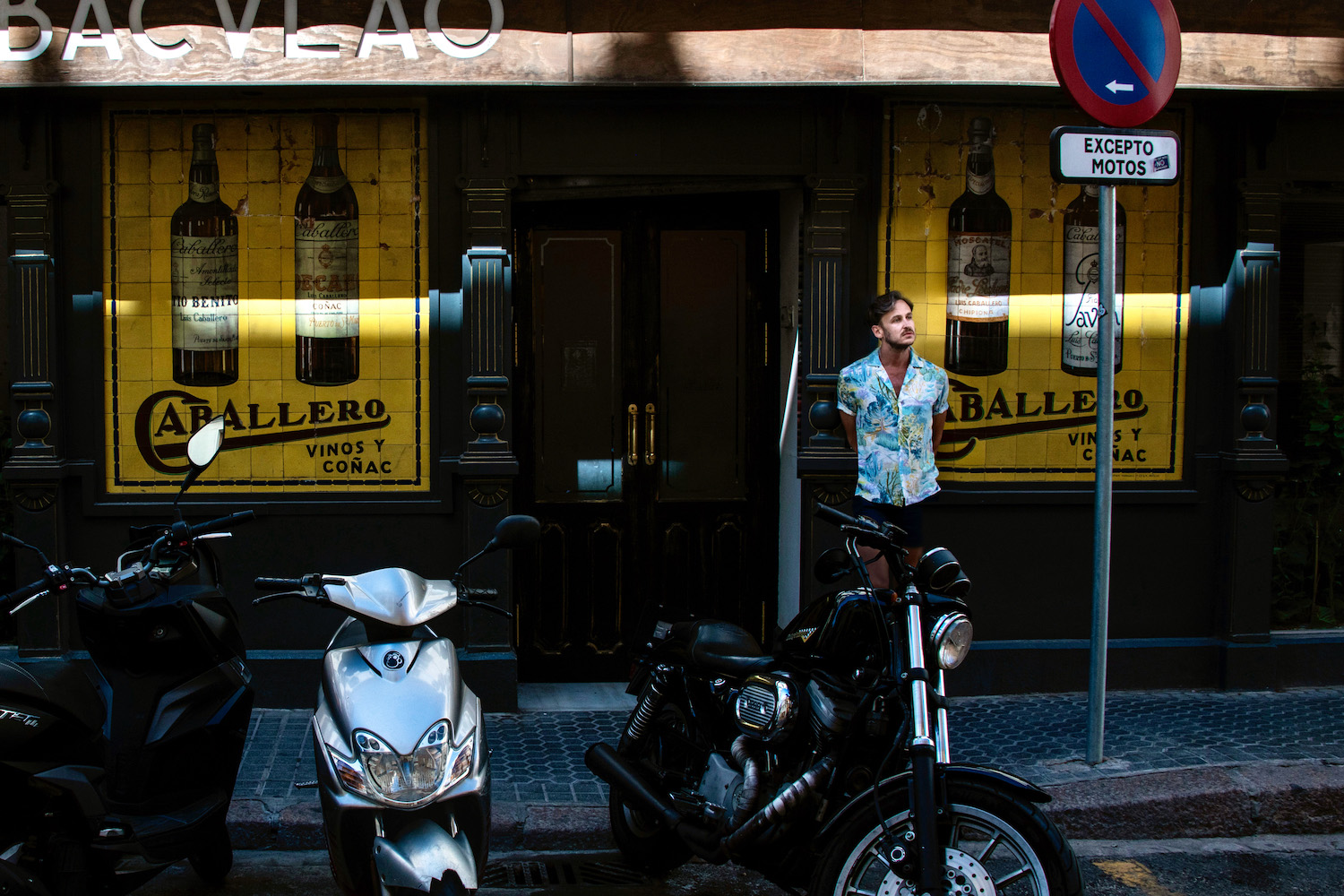
I like hot places, which is why the next stop on my 2 month Europe itinerary (though not necessarily chronologically) is the Iberian Peninsula. If you’re as warm-oriented as me, you’ll spend 2-3 weeks exploring Spain and Portugal , digging in not only to major cities like Madrid , Barcelona , Lisbon and Porto, but also destinations like the Algarve coast, the Basque Country and superlative secondary cities like Seville and Coimbra.
France and the Benelux countries
One of my favorite things about France is that it’s actually many destinations. While Nice and the French Riviera feel more like Italy or Spain, Paris can fit in (at least climactically) with cities in Belgium and the Netherlands like Amsterdam , Brussels , Antwerp and Utrecht. Regions like Brittany and Normandy almost seem like they belong in the British Isles; in Colmar and especially Strasbourg; you could practically be in Germany.

Switzerland, Austria and Germany
Speaking of Germany, while I can’t say how much of your 2 months in Europe cost will come from the (primarily) German-speaking countries of Germany, Austria and Switzerland , I will say that you will get what you pay for in these notoriously expensive places. Whether you explore Alp-adjacent cities like Salzburg, Munich and Zermatt , stick to Germany’s North Sea coast near Hamburg or frolic on the shores of Lake Geneva in western Switzerland, you’re sure to say “Ja!” to adventures in this cozy quarter of Europe.
Scandinavia
The Nordic countries of Finland, Sweden , Denmark, Norway and Iceland are the coldest and most expensive in Europe, but are also home to some of the continent’s most breathtaking scenery. Whether you road trip around Iceland in the middle of winter under the Northern Lights, hang out around the Arctic Circle in Norway or Sweden amid the “Midnight Sun” phenomenon or simply explore superlative capital cities like Stockholm and Copenhagen, you’ll definitely leave impressed.
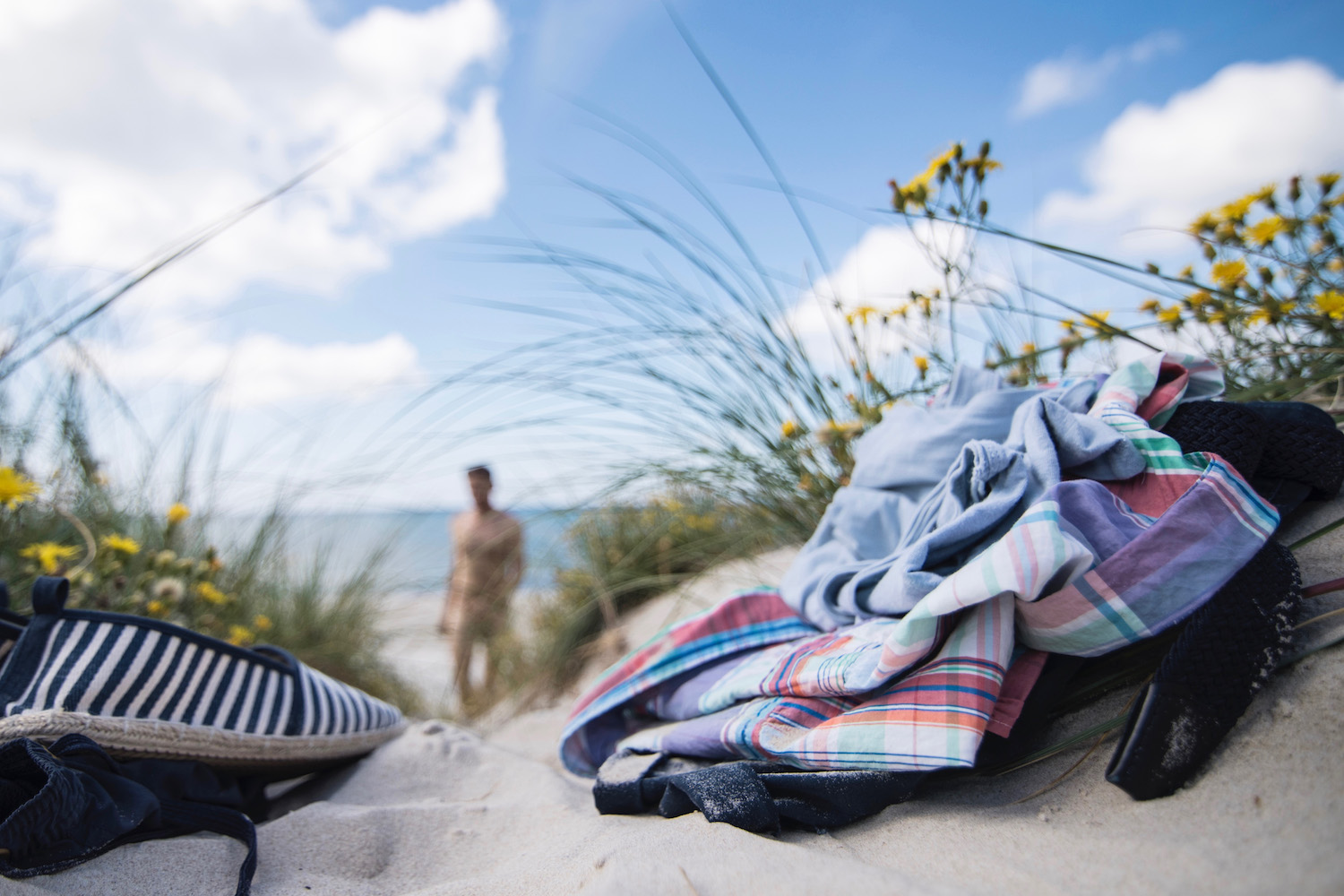
The Baltic States
I only made the mistake of referring to the Baltic States as “Eastern Europe” one time. “It’s Northern Europe,” the kind Latvian I said it to correcting me, a distinction that played itself out as I explored both her native Latvia , as well as the neighboring countries of Lithuania and Estonia . Indeed, the Baltics are something of a bridge between Scandinavia and the former Eastern bloc, with storybook cities surrounded by Soviet-style apartments, and a culture define as much by the Baltic Sea to the north as the dark empire that once loomed to the east.
Greece and the Balkans
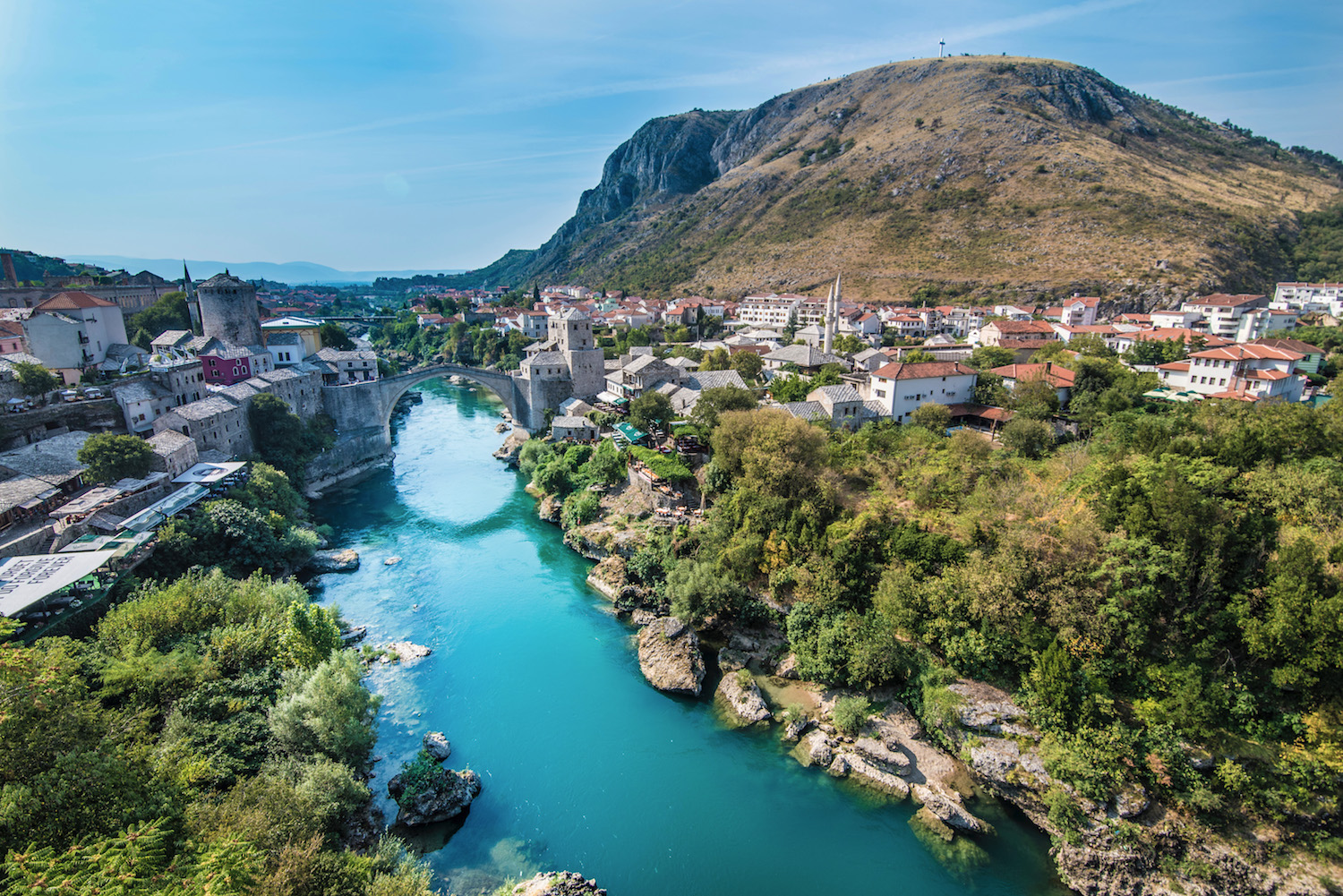
Another great place for sun on your 2 month Europe trip itinerary is Southeastern Europe: Greece and the Balkan countries (and Turkey , if you consider it part of Europe—I do). While I love Greek islands like Mykonos and Santorini, it’s no secret that beaches like Turkey’s Oludeniz and along Croatia’s Dalmatian Coast are less crowded. Likewise, you’ll see just as much history in Istanbul , Belgrade or Sarajevo as you will in Athens.
The British Isles

Brits probably won’t appreciate being lumped in with the Irish (and vice-versa), but hey: I don’t want to make my readers sit through 5,000 words. Indeed, my favorite parts of Ireland and the UK are the Celtic ones, whether I’m road tripping along Ireland’s Wild Atlantic Way , or taking side trips from Edinburgh and Glasgow , Scotland to places like the Isle of Skye and Loch Ness. England is amazing, of course, although I’m the first to admit I haven’t spent nearly enough time there during my “adult” travel life.
The Caucasus
As is the case with Turkey, The Caucasus even being part of Europe is up for debate. Still, assuming you have at least 6 weeks in Europe (and ideally longer), countries such as Georgia , Armenia and Azerbaijan are absolutely worth visiting. Personally, Georgia is my favorite of these, from cozy Tbilisi to the mountain town of Kazbegi and its stunning scenery. However, Armenia’s monasteries and the Caspian vibe of Baku , Azerbaijan are nothing to shake a stick at.

For the majority of travelers, Eastern Europe (with the exception of cities like Prague and Budapest) is separate from “Europe” (which is to say Western Europe) as a travel destination. This is especially the case for Russia , which even before Vladimir Putin’s invasion of Ukraine required a cumbersome visa to enter. Accordingly, I’d probably recommend considering this part of Europe separately from your core two months in Europe.
Is 2 Months in Europe Enough?
Over the past few years, travelers have emailed me about planning trips that range from a 6 week Europe itinerary all the way up to 3 months in Europe. And they’ve told me that this page (and previous iterations of it) have helped them put together itineraries for trips of virtually all lengths. While I’ve obviously optimized my advice for travelers who have about two months, a lot of the information you find here is evergreen.
On the other hand, if you want to comprehensively explore the continent, a 2 months in Europe itinerary is really the minimum amount of time you’ll need to devote. Europe is the size of the continental US, but is much more densely populated and features a much richer cultural tapestry as well. In fact, if you really want to see “all” of Europe, you’ll need closer to half a year here; two months simply affords you a compelling (but not complete) cross-section.
Other FAQ About Spending 2 Months in Europe
How much does it cost to travel europe for 2 months.
The minimum amount of money you can expect to spend during your 2 month Europe itinerary (not including) flights is 6,000 USD. This assumes that your food, accommodation and transport within the continent will cost no less than 100 USD per person, per day.
Do you need a visa to stay in Europe for 2 months?
If you have a US, UK, Australia or New Zealand passport, you don’t need a visa to stay in Europe if you plan to stay less than 90 days. However, there are a couple of important caveats. First, if you’ve already stayed more than 30 out of the previous 180 days, you won’t be able to stay the whole 60 days, as visa-free travel in Europe is only permitted for up to 90 out of every 180-day period. Secondly, starting in 2024, you will need to avail Europe’s nascent ETIAS travel authorization in order to enter the Schengen area.
What is the best month to see Europe?
Europe is a fantastic destination any time of year, though you should keep some things in mind. First, while the summer months of July and August are hot, sunny and lots of fun, they’re also the busiest and most expensive. This is especially the case in August, when virtually the entire country of France is on vacation. Secondly, while winter can be less crowded outside of ski destinations, it’s extremely cold, especially if you’re from a warmer country and aren’t used to it. If you want to balance nice weather with light crowds, “shoulder” months like April, May, September and October are a perfect time to visit Europe.
The Bottom Line
How’s your 2 month Europe itinerary looking? Although planning a Europe trip is a process, I hope you’ve made significant progress toward a plan you can execute. Some of you will spend your time touring European capitals, or popular regions such as Italy’s Tuscany , Portugal’s Algarve or the Swiss Alps. Others will take a more unique approach, be that hunkering down in or or two countries, or making a true marathon across the continent, from one end clear over to another. Want personalized help putting your trip together? I do hope you’ll consider hiring me as your Travel Coach!

Subscribe to email updates!
Words, images and design ©2009-2024 Robert Schrader, All rights reserved. Read Privacy Policy or view sitemap .

Two Months in Europe Itinerary
Welcome to our two months in Europe Itinerary! Europe is absolutely awash with beautiful cities and full of activities so it’s no wonder the region is one of the most popular destinations for backpackers. No matter what you enjoy doing, Europe has an array of climates to satisfy your desires; from skiing in the Alps or relaxing on a beach overlooking the Mediterranean Sea, the possibilities are endless!
Our Two Months in Europe Itinerary provides you with the best route around Europe so you can see as much of Europe in the shortest possible time. We’ll also recommend how long to stay; what to do; where to stay; and the average cost per day for each destination.
If you are travelling around Europe, here are some other guides you might find useful!
- The 23 Best Hostels in Europe
- The Top Party Destinations in Europe
- Tips for Travelling Europe on a Budget
Do I need a visa for my Two Month Europe Itinerary?
Now, this entirely depends on your nationality. For example, if you’re a UK National, despite Brexit, you can still travel to the EU/Schengen Area for up to 90 days WITHOUT needing to apply for a visa. In addition, Canadian or American nationals can also travel visa-free for up to 90 days.
To clarify whether you need to apply for a visa before entering the EU/Schengen Area, we’d advise checking your respective country’s foreign department and the European Commission’s Migration and Home Affairs policy on Visas.

What to pack for Two Months in Europe?
Some people may recommend taking a wheeled suitcase for two months in Europe and we completely understand why. However, if you are trying to keep this trip as budget-friendly as possible (like we did) you may well find yourself walking through old towns and up a lot of hills. Europe is notorious for its cute cobbled alleys, which while beautiful are not ideal for wheeled suitcases.
We would recommend taking a 40L backpack such as this Osprey one . If you find yourself having to take a flight here and there, you’ll appreciate not having to spend extra on checked-in baggage – which can double your flight price in Europe. If you are not planning on taking many flights, this larger Osprey backpack is the one we use for all our travels and it has a perfectly sized zip-off backpack for day trips.
European weather can be very unpredictable and throughout this two-month trip, it is likely you will experience varying degrees of temperatures and climates, and this can be minimised depending on the time you visit. We started with bright sunshine and ended with lots of snow; because of this, layers are your best friend. A comfy pair of shoes is an absolute must as you will be walking a lot; we brought two pairs each and felt this was the right amount considering baggage space. Europeans tend to also dress very smart-casual which is a huge generalisation but if you do not want to stand out as a tourist, neutral colours and smart-casual are the way to go. It’s also very helpful to be comfortable in whatever you wear.
A tote bag has been a great addition to our packing list and we now won’t go anywhere without one; it’s super handy as a day bag and will barely take up any room in your backpack. We’d also highly recommend an under-the-clothes money belt as, unfortunately, pickpocketing is rife in big European cities.
Accessories
As luck would have it, we’ve already set out everything you need to purchase before travelling around Europe. Make sure to check out our Ultimate Amazon Shopping List ; Top Gadgets you NEED for Travelling ; and 21 Must-Have Apps for Travelling !!
In addition, as your two months in Europe will be pretty hectic, we wouldn’t recommend bringing a laptop. Whilst technology will go a long way to helping you relax after a long day of exploring, most of this can be enjoyed through your phone.
However, if you’re planning a worldwide tour or wishing to work abroad afterwards then you should definitely consider taking your laptop. You can change your mind and have your laptop shipped out to you but this is obviously expensive.
How to get around Europe
Flying is a very viable option for exploring Europe. Flights between European countries do tend to be more affordable than in other locations in the world but it’s still quite more expensive than other options. If you are planning on flying around Europe, be sure to only take hand luggage as putting your luggage in the hold can often double the price of your ticket!
We’d recommend using Skyscanner or Expedia to get all the best deals.
We mostly got around using buses during our two months in Europe. Buses are usually the cheapest option but they do tend to take longer than trains. Therefore, if you aren’t tight on time, we’d definitely recommend looking into using buses on your travels.
We’ve found that Flixbus was a very reliable and popular company for getting around Europe. However, make sure to check out Omio who will provide you with all the best options!
Trains are probably the most common way for backpackers to get around Europe as many people travel via Interrail or Eurorail route.
One of the reasons why is that they’re affordable, quicker and tend to take you directly to the centre of the city you wish to visit. They’re also very affordable
Check out these interrail tips for first-timers to decide if this is the best option for you!
Renting a car
While renting a car is a less popular option for getting around Europe, if you have a larger budget, it can be a great way to explore the region. Pretty much the whole of Europe is driveable and there are some stunning road trips through the countryside.
As you can imagine, renting a car has numerous benefits; you’ll get to experience each country at your own pace and not rely on the (sometimes) inferior local transport to get around.
How much would Two Months in Europe cost?
We’ll be completely honest here, Europe was our first destination and we hadn’t had a holiday for over two years so it is safe to say that we weren’t frugal with our money at the beginning; as shown by the amount of sangria and olives we consumed. As a result, we spent nearly £10k between us in two and a half months.
However, if you’re eating cheaply and staying in hostels, you could easily spend two months in Europe for less than £4k (per person). That being said, make sure you still enjoy yourself and don’t be weighed down by the cost of everything; money can be earnt back but opportunities can’t.
Where to start?
As we’re from the UK, London was naturally our starting point as it has great air and land links with the rest of Europe. No matter where you’re from in Europe, it will be far easier starting from your nearest biggest city like Munich or Milan. Alternatively, if you’re coming from the United States or Canada, we’d recommend flying to a major city in Western Europe; any city that has good connections and is well-priced. This could include London, Amsterdam, Paris, Madrid or Barcelona. From these locations, you can follow this recommended route or do it backwards.
Do bear in mind that your route will also depend on your plans after your two months in Europe I.e. which airport is the best/cheapest to fly out from to go home or my next destination.
However, for our two months in Europe itinerary, we’d recommend starting off in London due to Heathrow’s great connections worldwide.
Starting Point: London, England

Our two months in Europe itinerary starts in London. London is one of the best tourist destinations in the world with vast amounts to do and see in each part of the city. Frustratingly, however, London is quite expensive for backpackers so whilst you could easily spend a week here, it will blow a massive hole in your budget that isn’t really worth it. Moreover, people spend years living in London and they’ll still not have seen everything London has to offer; it’s just that big of a place. As a result, we’d recommend spending three or four nights here and focusing on the bits you REALLY want to see.
If you’re a foodie, then London is the absolute place to be. We love the fact there are so many independent cafes and restaurants offering quality food from a variety of different cuisines. Moreover, getting around London is incredibly easy; the London Underground or Tube is arguably the best in the world when taking into account cost and coverage.
Even though we like to think we know our stuff about London, we found these London Travel Plans guide super informative and really handy. It gives you tonnes of tips on how to get around and where to visit so its definitely a must-read if you’re planning to visit.
How long to stay: 3-4 nights
Getting around: Tube or walking
Currency: GBP, £
Where to stay: Generator London
Must Do’s: Camden Market, London Eye, Big Ben, London Walking Tour
Average cost per day: £60-£80
Stop 2: Madrid, Spain

How to get there?
Travelling from London to Madrid is incredibly easy; flights operate from London Heathrow and Gatwick airports multiple times a day and normally fly into Madrid’s Adolfo Suárez airport. Flights start at around €50 and many deals include checked-in baggage which makes them very affordable!
Madrid is a city that many backpackers miss out on but it was one of our favourite stops throughout the whole of Europe. In comparison to Barcelona, we found Madrid a lot less touristy and enjoyed the fact that you could get to all the attractions on foot.
We also particularly enjoyed and embraced the Spanish culture of eating tapas as the sun sets every evening. Whilst eating later in the day (no earlier than 9pm) took some getting used to, we fell in love with sangria and olives in Madrid; you absolutely must try!
How to get there: Fly from London €50
How long to stay: 3-4 nights
Getting around: Walking or Metro
Currency: Euro, €
Where to stay: The Hat Hostel
Must do’s: Museum des Illusions , Parque de El Retiro, Plaza Mayor, Mercados (Food Markets)
Average cost per day: €50-€70
Why don’t you check out our Madrid Travel Guide for more information about visiting Madrid?
Stop 3: Barcelona, Spain

As you can imagine, Spain’s two biggest and most populous cities are very well connected. You can choose to travel by plane, bus or train; however, we’d recommend taking the latter as it’s affordable and can provide better comfort than the other two options.
Whilst we met tons of backpackers in Barcelona , it is a VERY popular holiday destination as it is home to a lot of Europe’s most iconic landmarks , so if you want to put yourself in a position to meet other people then definitely make sure to stay in a busy hostel.
The metro is by far the best way to get around given the frequency of stations and how big Barcelona is; trust me, it can take some time on foot. This city has so much to offer we would recommend staying for at least 4 days in Barcelona .
How to get there: Train from Madrid €30
How long to stay: 5 nights
Getting around: Metro
Where to stay: Yeah! Hostel €20
Must do’s: Sagrada Familia , Park Guell , Free walking tour, Beach day
Average cost per day: €50-€85
Thinking about visiting? Make sure to check out our Barcelona Travel Guide for more information!
Stop 4: Nice, France

Travelling to Nice from Barcelona is only really accessible by bus or flying, given that there are no direct train links. As the journey takes 9.5 hours, you can either choose to write off one day or take a night bus.
The City
We’ll be honest, we actually visited Marseille but didn’t find it backpacker-friendly at all. Having made the mistake for you, we’d definitely recommend visiting Nice instead and this recommendation is based on our own research. Nice is a beautiful city located on the French Riviera which is definitely worth stopping off at.
There are far more activities to do in Nice and we’ve heard the food is also particularly amazing , whilst the metro makes every part of the city accessible. Just be aware, as with any southern French city, the prices of anything will be quite expensive.
How to get there: Night Bus from Barcelona €25
How long to stay: 2 nights
Where to stay: Villa Saint Exupery Beach €18
Must do’s: Promenade des Anglais, Cours Saleya Market, Beaches
Average cost per day: €70-€80
Stop 5: Genoa, Italy

How to get there?
Given the locations of both Nice and Genoa, on the Ligurian Sea, it is incredibly easy (and surprisingly affordable) to travel between the two. We’d recommend travelling by bus as it is only €8 per person.
We found Genoa to be a great introduction to Italy and was a lovely place to visit. Whilst Genoa is dominated by its port, the city has ample things to do. We particularly enjoyed the views over the city from Spianata di Castelletto, you can easily enjoy two days exploring Genoa . In addition, it is a great location to visit the beautiful fishing village of Portofino where you can act like a celebrity enjoying the beautiful al fresco dining.
How to get there: Bus from Nice €8
How long to stay: 3 nights
Getting around: Walking
Where to stay: Ostello Bello Genoa €21
Must do’s: Spianata di Castelletto, Museo di Palazzo Reale , Day trip to Portofino
Average cost per day: €60-€65
Stop 6: Florence, Italy

Italy, and the major cities, in particular, are incredibly well connected so travelling by train or bus is very easy. This includes Florence so we opted to take the bus due to it being marginally cheaper than a train at €7pp; however, either method is feasible.
Florence was easily one of our favourite destinations in the whole of Europe so if you’re going to Italy, you MUST visit! The city itself has an amazing atmosphere with beautiful streets and cafes on every corner to sit and people-watch. Its location means it’s a great spot to take some day trips from Florence , which is why we think that 3-4 days is the perfect amount of time to spend at this stop.
We unfortunately only spent 1 full day here so didn’t fully appreciate everything Florence had to offer; we wished we stayed for two or even three more days. It is also a very walkable city so there is no need to spend any money on other modes of transport; unless you want to try your hand at an e-scooter.
How to get there: Bus from Genoa €6
Where to stay: PLUS Florence €25
Must do’s: Piazzale Michelangelo Viewpoint , Magnum Factory, Mercato Centrale, Michelangelo’s David
Average cost per day: €60-€80
Stop 7: Rome, Italy

Again, as Rome is the country’s capital it made getting to and from incredibly easy. Due to the price and convenience, we decided to take a direct train from Florence which was £24 each.
Whilst Rome was admittedly not our favourite destination, mainly due to its poor inner-city transport links, it is obviously a must-visit. However, it is still a city you need to tick off your list as the Colosseum is something you have to see! We spent 3 days here but you could easily see most of the main highlights of Rome in 1 day !
We particularly enjoyed staying at Yellow Square Hostel as it was a great chance to meet like-minded people in the Yellow Square bar opposite. They have happy hour each night and those staying at the hostel get an even further discount.
How to get there: Train from Florence for €16
Getting around: Walking and metro
Where to stay: Yellow Square Rome €35
Must do’s: Colosseum , Trevi Fountain, Vatican City
Average cost per day: €75-€90
Stop 8: Venice, Italy

For logistical and budgetary reasons, we stayed on the mainland at Anda Hostel and we were very glad we did so; it is cheap and easy to take the train onto the island every day. In addition, it is right next to the train and bus station which means you can choose either method of getting here from Rome.
Venice is absolutely as nice as advertised and the canals are stunningly beautiful. Whilst Venice has so much to see and do , it is most enjoyable just getting lost in the maze of walkways; some you won’t even think lead to anywhere. Doing this will allow you to find out the true Venice and some great handmade local food.
We’d also highly recommend taking a day to visit the neighbouring islands of Murano and Burano which are also part of the Venetian region; the latter’s brightly coloured houses are beautiful.
How to get there: Train From Rome €44
How long to stay: 3 nights
Getting around: Walking and taxi boats
Where to stay: Anda Venice €32
Must do’s: Murano & Burano day trip, St Mark’s Basilica, Doge’s Palace , St Mark’s Square, Gondola Ride
Average cost per day: €80-€100
Stop 9: Zagreb, Croatia

Venice’s bus and train station are right next to each other so it’s all about what method of transport you’d prefer. We ended up taking the bus from Venice, which cost £21 pp, as we didn’t mind the slightly longer journey for the cheaper price.
Zagreb was another one of our favourite cities and the whole place really surprised us. We absolutely loved the atmosphere, where it was slightly cold (puffer jacket weather) but every still sat outside drinking. In addition, everything was super walkable and the food was amazing. It also has a great range of activities to do; if you like views or walks then the viewpoint and Art Park are beautiful whilst Ivana Tkalcica is a street full of bars and great eateries. Hopefully, you’ll agree that Zagreb is definitely worth a visit ! Ideally, you would want to spend a few days here but you can easily spend just one day in Zagreb .
How to get there: Bus from Venice €20
Currency: Croatian kuna, HRK
Where to stay: Chillout Hostel €23
Must do’s: Museum of Broken Relationships , Viewpoint, Art Park
Average cost per day: €55-€60
Stop 10: Vienna, Austria

Again, as all of Europe’s main cities are really well connected, you can either choose the bus or train depending on where you’re staying. Vienna’s International Busterminal (VIB) is a huge train station with well-connected metro links all over the city. We ended up getting a bus to Vienna from Zagreb because it was the cheapest but the train is just as easy.
Admittedly, Vienna wasn’t our favourite city as the weather wasn’t our friend and it was quite expensive. As a result, we wouldn’t recommend staying that long here. Having said that, we particularly enjoyed the Royal Palace and the Hop-on, Hop-off bus which allowed us to see most of the city. The food was also particularly amazing so if you do visit, there is an extensive list you must try!!
If like us you make a stop in Vienna over the festive period, be sure to check out some of the city’s beautiful Christmas markets !
How to get there: Bus from Zagreb €17
How long to stay: 2-3 nights
Getting around: Walking and Metro
Where to stay: Wombats Hostel €26
Must do’s: Palace, Walking tour , Prater Wien, Big Bus tour
Stop 11: Budapest, Hungary

You can either choose the bus or train from Vienna as it’s simple, easy and direct. We ended up commuting by bus but had real trouble finding a taxi once we got to the Nepliget Train Station as there was no taxi rank nearby and we didn’t have the Bolt app downloaded. As such, we’d recommend getting a train to Budapest as it’ll be easy to get into the city centre.
What a place. By far our favourite place in the whole of Europe. It has everything one could want from a holiday destination, apart from a beach. You can visit the beautiful Buda Castle that overlooks the city and the relaxing Széchenyi Thermal Baths.
However, by far the most enjoyable aspect of Budapest was that it is one of the best party destinations in Europe which is epitomised by the Szimpla Kert or Ruin Bars, as they’re commonly referred to. Here you can relax, drink and chat into the early hours whilst being surrounded by a unique setting; it has a great atmosphere and is our favourite place to visit in Budapest.
To top it off, the city is easily walkable and a fairly cheap city to visit and explore. Ultimately, Budapest has it all and if you’re going to visit in place on the list, it has to be here.
How to get there: Train from Vienna €15
How long to stay: 5 nights
Getting around: Walking and Tram
Currency: Hungarian Forint, HUF
Where to stay: Hostel One €19 or The Hive €12
Must do’s: Buda Castle , Fisherman’s Bastion, Ruins Bars, Széchenyi Thermal Baths , Boat Party
Average cost per day: €25-€40
Stop 12: Krakow, Poland

We ended up taking the bus as it was again cheaper and we couldn’t find a direct train to Krakow from Budapest at the time. Coming from Budapest also gives you the top room to fly; whilst more expensive it’s ideal for those who wish to keep their travelling time down.
Krakow is arguably the best city in the whole of Europe for backpackers. This is because it has great nightlife, it’s very cheap to socialise and there is a great deal of sightseeing to do (Old Town in particular). The only more expensive part we found was the accommodation; however, we found Greg & Tom’s Beer hostel which is just a five-minute walk to Old Town and was perfect. Your stay includes free breakfast and dinner and it was surprisingly really good although you must get out and try local food because it’s amazing also!
How to get there: Fly from Budapest or Bus €28
How long to stay: 4 nights
Currency: złoty, zł
Where to stay: Greg and Toms Hostel €18
Must do’s: Old Town Square, Jewish District, Bar crawl, Auschwitz and Birkenau , Free walking tour
Stop 13: Prague, Czech Republic

We ended up getting the train to Prague as it then allowed us to get the metro to our accommodation. The transport system in Prague was really really good; you had the choice of the metro but we loved walking and taking the trams.
Another one of our favourite cities as it had such a good atmosphere and the whole city was beautiful! To make it even better, we visited in autumn so the air was crisp but not too cold. As a result, we thoroughly enjoyed sitting in the Old Town Square with a beer, gluhwein or hot chocolate to watch the world go by. The city is also home to some incredible restaurants and bars, so you won’t struggle to fill your evenings here!
How to get there: Train from Krakow €9
How long to stay: 4 nights
Currency: Czech koruna or crown, CZK
Where to stay: Hostel One Old Town €19
Must-do’s: Lennon Wall, Prague Castle , Charles Bridge, Old Town Square, Pub crawl, Walking tour
Average cost per day: €30-€50
Stop 14: Berlin, Germany

Germany has arguably the best train network in the whole of Europe. There are three huge train stations the size of Waterloo, all within a couple of miles of each other. As the city is so vast, you’ll be able to hop onto the metro or any tram from a variety of locations as walking can be time-consuming.
Being the capital of Germany and with its history, Berlin is a must-visit for anyone backpacking Europe. We loved visiting everything Berlin has to offer and particularly enjoyed (as much as you can) the Topography of Terror and sampling some Currywurst. As Berlin is a recent modern city (i.e. rebuilt after the war), everything is quite spread out which means a massive reliance on its impressive transport system. As such, it costs time and money to get to different parts of the city BUT Berlin is still well worth a visit, especially for its infamous nightlife!
How to get there: Train from Prague €20
Where to stay: St Christopher’s Alexanderplatz €17
Must do’s: Berlin Wall , Topography of Terror , Brandenburg Gate, Walking tour
Average cost per day: €45-€60
Stop 15: Hamburg, Germany

We chose to take the bus from Berlin (£10pp) as the pickup and drop off location was right outside our accommodation and it was cheaper. But again, the train is equally as viable and arguably comfier.
Whilst there isn’t as much to do compared to Berlin, we found it to be a great contrast and loved the atmosphere. The food in Germany is absolutely incredible and we definitely managed to eat our body weight in currywurst during our visit! We were unlucky during our stay as it pretty much rained the whole time we were there. Having said that we still had a great time, so if you’ve got a spare few days then definitely don’t skip out on Hamburg as it is very underrated!
How to get there: Bus from Berlin €7
Getting around: Walking
Where to stay: Generator Hamburg €28
Must do’s: Speicherstadt, Harbour cruise , Miniatur Wunderland, Treasure hunt
Stop 16: Copenhagen, Denmark

Surprisingly, getting a bus from Hamburg to Copenhagen is much cheaper and quicker than getting a train. In addition, your route will likely take you across the Femer Baelt which is a beautiful ferry crossing.
Whilst not necessarily your typical backpacking location, a trip to Copenhagen is definitely unique; in a good way! Admittedly whilst it is one of the most expensive cities on our European travels, it was also a lot of fun. If you don’t fancy becoming a true Dane and decide to cycle everywhere, the metro is also very good and worth getting a zone pass for your stay. There are so many things to do in Copenhagen , but some of our highlights were Tivoli Gardens and Copenhagen Zoo!
We only spent three days in Copenhagen, but if you do want to stay a bit longer there are some amazing day trips that are worth checking out!
How to get there: Bus from Hamburg €20
Getting around: Walking, metro and bicycle
Currency: Euro, €
Where to stay: CityHub €89 or Copenhagen Downtown Hostel €25
Must do’s: Proud Mary Pub, Copenhagen Zoo , Freetown, Bike tour , Tivoli Garden
Average cost per day: €70-€120
Stop 17: Malmo, Sweden

Due to its close proximity, getting to Malmö from Copenhagen via train is incredibly easy and cheap. We met loads of people who live in Malmö but work in Copenhagen in order to save money on accommodation; Scandinavia really is that expensive!
If you’re in Copenhagen, you’d be silly not to take a quick trip to Malmö for a day or two. As with a lot of Scandinavia, it rains a lot and it was no exception during our visit. Nonetheless, Malmö is utterly beautiful and a great city to walk around; we particularly enjoyed the cold, crisp air (when it wasn’t raining).
How to get there: Train from Copenhagen €13
Currency: Swedish krona, SEK
Where to stay: Hotel n Hostel Malmo City €35
Must do’s: Technology and Maritime Museum , Turning Torso, Kungsparken, Cycle tour , Pildamnsparken.
Average cost per day: €55-€70
Stop 18: Amsterdam, Netherlands

Surprisingly, getting to Amsterdam from Malmö is quite simple. You’ll firstly need to get to Copenhagen via train (which is very easy) before walking to the nearby bus station for a night bus to the Netherlands. This was our first night bus on our trip and we were incredibly surprised to find the bus was full to the brim so be prepared for very little sleep!
Amsterdam ended up going into lockdown just before we were about to visit so we, unfortunately, didn’t get the chance to explore the beautiful city – we will one day! Nonetheless, it is obviously a hotbed for Europeans to visit for all the obvious reasons so why not try it for yourself?
How to get there: Night bus from Copenhagen €37
How long to stay: 3 days in Amsterdam is the perfect amount of time to explore the city!
Where to stay: Flying Pig Downtown €30
Must do’s: IJ-Hallen flea market, Anne Frank House , Heineken Experience , Van Gogh Museum
Average cost per day: €65-€80
Stop 19: Brussels, Belgium

With Brussels being the epicentre of European politics, it is incredibly easy to get to. Visiting from Amsterdam is no exception with both the bus (€10pp) and train (€20pp) going direct to Brussels.
Despite being warned by many people that there wasn’t much to do in Brussels , we surprisingly found the city really enjoyable. The Grand Place is a beautiful square, especially at night, and we were lucky enough to visit in December so we were able to explore all the festive Christmas markets the city offered.
If you fancy visiting more of Belgium, Brussels is a great location for day trips to Ghent , Antwerp and Bruges!
We also visited Pairi Daiza Zoo and this is easily the best zoo we’ve visited ever; the animals had so much space to roam which was great to see.
How to get there: Bus from Amsterdam €10
Getting around: Walking and trains
Where to stay: MEININGER Bruxelles City Center €32
Must-do’s: Pairi Daiza Zoo , Grand Palace, Atomium, Walking tour ,
Average cost per day: €50-€90
We definitely recommend checking out Carolin’s Day Trip to Brussels Itinerary as it has everything you need to know about visiting Brussels.
Stop 21: Lille, France

Whilst taking the bus is an option, we found Brussels’ great transport links meant we could get a direct train to Lille; simple, easy and just €9pp.
Lille is definitely one of northern France’s hidden gems and whilst we only really stayed here to kill a few days before Paris, we were very glad we did. The city is really walkable and the canal de la Moyenne-Deul is beautiful to walk around. We also loved the fact that the main square was always bustling and there was so much to see. Being the foodies we are, we loved the sweet and savoury crepes at Crêperie Beaurepaire; truly amazing!
How to get there: Bus from Brussels €4 or train €9.
Where to stay: CALM Appartments and Hostel €24
Must do’s: Grand Place, Old Lille, Parc Zoologique, Sightseeing tour .
Final Destination: Paris, France

In a similar fashion to the rest of Europe, transport links to Paris are very good. As such, you can choose to take the train or bus from Lille and arrive within a good time.
Due to a series of unfortunate events, we had to skip out on sightseeing during our trip to Paris, but luckily we have been before. Paris is one of the most famous cities in Europe, home to some of the continent’s most iconic landmarks and best museums .
Brimming with history, art, food and fashion, Paris is on everyone’s bucket list and you can easily spend 3 to 4 days in Paris . However, it is not the most backpacker-friendly location budget-wise so be sure to pick your activities wisely and try to do a free walking tour to see a lot of the sights.
How to get there: Bus from Lille €12
Where to stay: Jo&Joe Paris €40
Must do’s: Eiffel Tower , Louvre Museum, Montparnasse Tower, Walking tour
Average cost per day: €65-€95
Where next?
Paris is a great final destination because of its great links with the rest of the world. You have the ability to fly out of Paris’ Charles de Gaulle airport which has great connections with Africa, North America and Asia. Alternatively, you can get the Eurostar train back to London, as Heathrow’s international links are arguably a little better, or to finish your journey; what’s next is completely up to you!!!
Ultimately, your trip around Europe totally depends on where you want to visit and when. However, in order to keep costs to a minimum, it would be wise to travel as shorter distances as possible between cities. In addition, you could easily adapt this itinerary to include places like Munich, Split or Dubrovnik , or even cut out Scandinavia if your budget doesn’t stretch that far.
If you are heading to Europe during the festive season, do check out our places in Europe to spend New Year’s Eve post!
There you have it; our Two Months Backpacking Europe, outlining all the best places to visit; how much it costs and where to stay. No matter wherever you visit, you’re going to absolutely love Europe as there are so many places to visit and so many things to see and do. You’re also bound to meet tonnes of people that you’ll continue to be friends with; that, for us, is the best part about travelling.
Travelled to Europe before? Let us know any of your top tips in the comments!

Check out some of our other Europe content!
- The Ultimate Madrid Bucket List – 26 Things to do in Madrid
- 25 Unmissable Experiences To Add To Your Italy Bucket List!
- 28 Unmissable Experiences to add to your Spain Bucket List
- Is Zagreb Worth Visiting?
- Unusual Museums in Europe: A Journey Through the Bizarre and the Curious
Related Posts:

Similar Posts

How to get to Tortuguero, Costa Rica

What is Thailand famous for?

Top Party Destinations in Europe

Where to Find the Best Nightlife in Thailand

How to Spend 2 Days in Prague – Prague Travel Guide

How to Get Around Thailand in 2023
43 comments.
What a great itinerary! I would love to spend 2 months wandering around in Europe!
Thank you so much Marianne, so glad you liked our post!
Loved this article. I agree 100% on staying in London 4 days. London is such a big city that it would be impossible to see everything during one vacation! I have been living in London since 2013 and I still haven’t seen everything!
So pleased you loved this article Valentina. We love London as well and totally understand not seeing everything!
Spending two months traveling around Europe is such a dream! I’ve been to most of these cities, but not all of them yet. This is great inspo for planning a trip around Europe and exploring a bunch of amazing places.
It really was an amazing experience; we’d recommend it to anyone! Thank you for your kind words Kate.
Sooooo, this is basically my DREAM. I would love to spend 2 months (or even more, why limit myself you know?!) traveling around Europe. Totally agree with the luggage recommendation – I feel I would get quite tired of wheeling around a larger suitcase quite quickly. Better to stick to a backpack.
Totally agree Alaina!! Trust me, it really is tiring, especially on cobbled streets; backpacks are the way forward!
My husband and I spent almost a month in Europe, and we had such a great time! My only regret was not staying longer! Haha. This is such a great itinerary. Croatia and Germany are two spots on your itinerary that really caught my eye because I’m dying to visit there! Thanks for sharing.
So glad you enjoyed your trip Brittany! You really should visit; we’re gutted we missed out on Split and other sunny places in Croatia.
How I wish I could go to Europe right now for 2 months! You have hit a lot of places I have been, and you are absolutely right – they MUST be on this list. You also had some I haven’t been to. Thanks for getting them on my radar for a future trip! Excellent details!
So glad you agree Erin! Our pleasure; don’t hesitate to get in contact if you have any questions!
Sounds like you had a blast and so many amazing places! So much information as well for planning a trip!
It was such an amazing time thanks Emma, so glad we visited. Thank you.
What a fabulous breakdown of your Europe itinerary. There was so much helpful information! I’m envious of your two month adventure. It looks and sounds like amazing experiences.
It really was an amazing experience Michele; so glad the information was helpful!
Two months in Europe? Yes, please! Love this itinerary. I’veen to 10 of these lovely cities…and actually spending three weeks in England in September. So will also check out your London posts.
You’ll absolutely love London; if you want any further tips then don’t hesitate to get in contact!
We love this itinerary! It’s packed with things to do but not overloaded so you feel burnt out by the middle of the trip.
So pleased you liked our guide, thank you for your kind words.
I’d love to spend two months in Europe! This looks like a great pick of cities. Thanks for the tips about which ones might be more expensive and that you would probably spend less time in if you’re wanting to be more budget friendly.
It was so worth it Anushka and totally agree! Our pleasure, so glad we’ve be able to help.
We are happy that as Canadians we don’t need a visa for a 2 month visit. But we still need to watch the 90 day Schengen rules. On our current long trip to Europe we did indeed have to pack for a wide range of weather. And still probably packed too much! You sure have some great stops on your itinerary. I hope you have a great trip.
We were in exactly the same boat Linda.. too much stuff and too many climates! Thank you, we hope you do too!
Wow! You guys are loving the dream!! I loved all of these places 😁
Ahah we’re very lucky! So glad you enjoyed them Belle!
This is a great itinerary! I hope I get to travel it one day!
Thank you Yvonne; you definitely should!
Wow, I’m totally envious. I would love to spend two months in Europe! It’s on the horizon though, Normally I avoid large cities but I can see how transport between the bigger cities in Europe would be a cinch!
Europe definitely lived up to expectations! Totally agree Angie.
This is a great itinerary very inspiring! Although I know very well London, France and Italy I’ve never been in Sweeden and I’d love to visit Hamburg. They look so charming! Thank you for sharing this!
So pleased you enjoyed our guide Anita! Thank you for your kind words; you should definitely visit Sweden if you get the chance!
I probably wouldn’t want to backpack through Europe, but spending two months in all of these destinations would be pretty awesome.
It was honestly amazing; so glad we did it and it’s definitely worth it!
Love this itinerary! It’s awesome you saw so much in just 2 months. I’m saving for a future trip!
You’re very kind Nikki, thank you. Looking back it was definitely crammed a lot of places in a couple of months but we loved it!
This is exactly my dream Europe trip with so many beautiful destinations to visit and useful tips to make it a seamless journey. Definitely saving this post now!
Thank you so much Fiona Mai. We’re so pleased you enjoyed our post!
- Pingback: How to spend Two Days in Prague - Prague Travel Guide - Alex and Leah on Tour
- Pingback: Top 15 places in Europe to spend New Years - Alex and Leah on Tour
How much more to add do you think on all the prices you have given on every place (buses, trains, fly, accomodation etc). I have plan to go to Europe for 2 monts in October 2023. With the weather in October and November, is it good idea that we start from the nothern part first? As we are coming from Australia. Thanks!
Hi Nia, thanks so much for getting in touch. We’ve dropped you an email, would love to help you out!
Two months in Europe is in my bucket list for 2024. I really like your itinerary. However, I have been to several of these cities. I have a list of cities I would like to visit, I’m just not sure how to organise them. I would appreciate any suggestions?
Leave a Reply Cancel reply
Your email address will not be published. Required fields are marked *
Save my name, email, and website in this browser for the next time I comment.

2 Months of Solo Travel in Europe: Itinerary + Reflections

I’ve wanted to try longer-term or “slow” travel for while, especially since I’ve had a fully-remote job since Fall 2019.
But then, 2020 happened, and we all had to stay at home. 2021 rolled around, and we were all still cautious. 2022 came by, and I was looking forward to a summer of travel—but then life threw a ton of bricks my way and I was extremely unwell for most of the year due to a B12 deficiency ( please take your vitamins if you’re plant-based!). It took me months of vitamins and therapy to feel more like myself, and I’m so grateful to be feeling up to traveling again.
This is the story of the European trip that was supposed to happen in 2022, but actually finally happened from August-October 2023. I’ll share where I went, who I met, and what I learned. It will be more personal, but there will also be some practical tips and cost breakdowns.
This post contains affiliate links to some of the travel services I use and love, meaning that I may earn a small commission on any purchases through those links .
Table of Contents
How to Navigate this Post
If you just want to see what I’ve been up to, then this entire post will hopefully be interesting (it’s longggg though). If you want to skip around, Chamonix had the most drama, Paris had the best photos, Brussels had some of my favorite memories, and Berlin was all about the marathon (use the table of contents above).
If you’re just here for the logistics/itinerary of a 2-month trip in Europe, know that my destinations were limited to France (half my time was spent there), Belgium, Germany, and Denmark (plus day trips to The Netherlands and Sweden). This post won’t be that helpful if you’re trying to plan a grand European tour, but it will hopefully be helpful if you’re interested in these countries in particular.
For more touristy/travel tips, check out the blurbs at the end of each stop with my favorite things to do in these destinations, plus the more logistical/reflective sections.
Where I Went + How I Got There
I decided to stay in Europe for 2 months because I was invited to a wedding in France at the beginning of August, and also had the Berlin Marathon on my schedule at the end of September.
Instead of taking two round-trip international flights, I wanted to stick around in Europe and make my way slowly from France to Germany. It would be perfect for saving emissions and getting blog content.
I stayed in 10 different cities and 3 countries over the span of 2 months. They included:
I also made day trips to:
- Saint-Émilion, France
- La Réole, France
- Talloires, France
- Amsterdam, Netherlands
- Ghent, Belgium
- Malmö, Sweden
I flew from Ohio (where I’m based these days when I’m not traveling) to NYC, where I then stayed with friends a few days on the way there and back. I flew nonstop into Paris from NYC, and then flew nonstop back from Copenhagen.
It was my goal to take trains the rest of the trip, for both environmental and comfort reasons. I was able to do this, other than a flight from Bordeaux to Geneva, as that was the best way to get to Chamonix without a car.
Pro tip: If you plan to do extensive train travel in France, and you’re under 28 years old, I highly recommend getting a carte jeune , or young person’s card. It costs 50 euros and will save you at least 30% on high-speed trains, plus there are capped prices depending on the length of the trip. It paid itself back in one longer trip for me, and the same happened with my friend.
Logistics: Working, Costs, Etc.
In case you’re curious about the practical aspects of the trip, here’s some info:
Was this work or vacation?
This wasn’t a vacation—I was working pretty much the entire time. I work remotely for an edtech startup and they’re very flexible with location; I just had to work Eastern Time, which was an adjustment, but not as bad as it sounds (2-10pm, sometimes 3-11pm Europe time). I also treated this a trip for gathering info/experiences to be able to blog about later.
I didn’t mind having the morning to myself to explore, and then working the rest of the day. I did get pretty tired around 9pm each day briefly, but then I got it together for the rest of the night.
The worst part of working Eastern Time in Europe was the social aspect. I wasn’t able to hang out in the evenings, and that made me feel like I missed some experiences or social connections. Next time, I’ll definitely arrange a day a week where I work European hours.
Was this trip expensive?
This was relatively expensive because of housing, especially since I was moving around basically every week. I stayed in Airbnbs (mainly shared with the host), and I spent just under $4,740 on housing for 59 days, which worked out to $80.30 per day.
I would’ve loved to spend a lot less, especially since rent in Europe is cheaper in comparably-sized US cities, but the cost of short-term housing is just much higher. You could definitely save money by staying in places for longer, and you’ll save the most if you sublet or have an actual rental contract.
The most expensive places were Copenhagen, Berlin, and Cologne (almost $100/night or more). I spent a little extra in Berlin on a hotel since I wanted to be close to the marathon start/finish, but looking back, I should’ve saved and relied more on the very good public transport.
All that said, I didn’t have rent to pay in the US since I’ve been traveling so much that all my stuff is at my parents’ place. So, this works out to about the cost of a 1-bed each month in a city like Boston.
Food and groceries seemed pretty much similarly-priced, so no complaints there. You can go out to eat and get a good meal for around 20€. I cooked as much as possible to save money.
Also, I still had euros leftover in my Wise borderless account from when I lived in Dijon, so I used that along with my US credit cards with no foreign transaction fees.
Any other questions?
Leave them in the comments and I’d add my response to the post if I think it would help others!
Trip Recap/2-Month Europe Itinerary
Let’s dive into a little storytime off all the places I went, plus my favorite spots in each city.
Dax, France

I arrived in Paris and only stayed one night before heading south to Dax for a wedding nearby in the French countryside. This wedding was super special because I actually introduced the couple (totally by chance).
When I studied abroad in Bordeaux in 2016, I befriended my French and math tutors (Aurélie and Stéphane). On a visit back to Bordeaux the following spring, I stayed with Aurélie. I caught up with Stéphane at a teahouse, and then he joined us when I met Aurélie for dinner.
The story isn’t exactly linear, but Aurélie and Stéphane got together about a year later, and they had a beautiful baby last fall. I joked that I’d never been “responsible” for a whole family (of course, causality isn’t actually that simple). The story really makes you realize how random and wonderful life can be.

Their wedding was at their countryside home, and I loved all the romantic and sustainable details. The chairs and tableware were thrifted, we threw dried flower petals instead of confetti or rice, there were tons of veggie food options, and wedding favors were handmade candles in thrifted teacups as well as flower seeds.

I’d worried a bit about whether I’d find people to talk to at the wedding, since I wouldn’t know anyone other than the couple, but everyone was super friendly and I ended up hanging out with another couple from abroad for most of the evening. It was also of course really lovely to see Aurélie and Stéphane again after several years, and meet their new baby!
A couple random tidbits of French wedding culture:
- French weddings often go all day and all night! The civil ceremony was at 2pm and then there was a more personal ceremony, plus games, snacks, dinner, and dancing. I left a little past midnight, but the party was still going strong, and I’ve heard of weddings going until the wee hours of the morning.
- There’s usually a brunch for close friends and family the morning after. I guess this is also kind of common in the US (the “farewell brunch”), but I think it’s even more common in France.
Bordeaux, France

This was my third time back to Bordeaux after I’d studied abroad. Since it was only 1.5 hours from Dax, and I still have friends in the area, I figured I’d stop by.
It was both lovely and strange to see people after anywhere from 4-6 years. It feels like forever has passed, but you pick up and catch up as if things haven’t changed much.
I got to see Alicia, a friend I’d made while playing for an amateur orchestra in Bordeaux, as well as Alex, who’d been in one of my classes. Both of them had even come to visit me when I was studying at Oxford!

I also took a day trip to Libourne to see another friend I’d had a class with during study abroad (who’d invited me over for Christmas that year, and later came to visit me in Ohio during her year abroad!). Caroline and I biked through the vineyards to Saint-Émilion, a medieval village I’d wanted to visit but hadn’t had a chance to see during my semester abroad. The winding cobblestone streets and coral rooftops were definitely worth seeing in-person.

The week went by quickly, and I didn’t want to leave. It felt good to be in Bordeaux as an adult with disposable income and no classes to take. It was a stark contrast from my study abroad experience; the French university system is notoriously disorganized, and I was so worried about doing well in my classes that I didn’t end up having as much fun as I could’ve. Seven years later, I feel like I’ve kind of turned the story around; I’m still coming back to the city, still in touch with my friends, and making better memories.
If you want to know more about Bordeaux as a city, I have blog posts with my favorite spots in Bordeaux and the best vegan/veggie restaurants in Bordeaux .

Chamonix, France
As soon as I arrived at my Airbnb in Chamonix, I wanted to leave. The hallway was cluttered with furniture and the kitchen appliances were dysfunctional. The host was also nowhere to be found, and he’d asked another guest to check me in.
The biggest problem was the fridge. It froze my vegetables, ruining my lettuce and turning my lemon, carrot, and tomato as hard as rocks.
On my second day there, someone booked last-minute, and the room he reserved was a huge mess, with dirty clothes and linens were strewn everywhere. I had to check him in since the host wasn’t there. Then, a couple days later, a girl arrived and said she’d reserved by text, as she’d stayed at the place two years ago. There were no more rooms left, and she had to sleep on the couch a night before finding somewhere else for the rest of the week.

When the host did come around, he stayed for a few days, and each night, he unplugged the fridge. If I woke up in the middle of the night, I sneakily plugged it back in. Even so, I ended up getting food poisoning my second weekend in Chamonix, and was totally incapacitated for a day.
The host seemed like he meant well overall (he shared food and cooked once for us), but I ended up leaving a 2-star review because of how dysfunctional the place was (I felt so guilty about it, but it was so justified; I had no idea how the place had had 4.7 stars, and I suspected that recent guests just didn’t review it at all rather than leave a bad one).
While I had the worst Airbnb experience I’ve ever had, I really enjoyed Chamonix overall. I was lucky to be able to commiserate in the Airbnb with another guest, Aoife, an Irish ultrarunner who’s super accomplished and even holds the Irish women’s record for most miles run in 24 hours.

We spent a lot of time sitting in that cramped kitchen, complaining about our host, and talking about running and random life stuff. Without Aoife, I would’ve definitely left the Airbnb (I contemplated it, but because I was in Chamonix before/during the UTMB, one of the most prestigious trail races in the world, there was nowhere else to go).
Here are some other highlights:
- Chamonix is a trail runner/hiker’s heaven , with rails galore starting directly from the city. I went on hikes and trail runs basically every other day (and my quads paid the price). I’m planning to do a separate post on the hikes I did, and will link it here when it’s done. I even got to do a hike with my friend Claire, who I met while I was living in Dijon in 2018-2019.

- I got to be part of a running photoshoot! (For a small UK brand). I saw a post by the photographer in a Chamonix trail runners’ Facebook group, and I ended up joining 3 other runners for the shoot. It was a LOT of running back and forth all day in the summer heat. But it was a lot of fun, and I’m looking forward to seeing the photos when the collection releases in the spring.

- I got to see the UTMB (Ultra Trail du Mont Blanc) , the reason I stayed in the city for so long. This prestigious trail race is made up of multiple races of different distances, with the UTMB itself being 170km (106 mi). I didn’t stay long enough for the UTMB itself, but I did get to cheer some runners on during the TDS, which is almost 100 miles. The COROS team was also in the city for the event, and I got to meet with the partnerships manager.

- I met Molly Seidel (Olympic bronze medalist in the marathon) one day while running on the track! She was in Chamonix for a photoshoot and to spectate the UTMB. I’ve always appreciated her openness about mental health, especially since she was going through her own struggles around the same time I was last year. We chatted for a little and it was so cool to randomly run into her (pun not intended).

So, while Chamonix was a rough time, I’m glad it survived it and had some fun in the process. I hope to be back one day to run the UTMB OCC 50k (but I’ll stay in a different Airbnb 😝).
Annecy, France
Annecy is known as “the Venice of the French Alps,” and it’s just as romantic as it sounds. The water is an unreal shade of mint (kind of like the “Gatorade water” you may have heard about in Nice, France), the old town is full of pastel buildings and canals, and the large lake named after the city is surrounded by mountains.

I’d been to Annecy twice before for day trips, but had never stayed there. It just happened to be a good point in-between Chamonix and Paris, so I booked it.
I was glad to be back down at elevation for my 20-mile training run for the Berlin Marathon, and to have a chance to get some lake swimming in.
Since I’d just gotten food poisoning the weekend before, I attempted the 20-miler twice before just trudging through it on my second attempt. I just seemed to have no endurance both times and lost steam very early on. After 9 miles on my second attempt, I had to start run/walking. While it was very rough, I got it done, and had a couple more days to enjoy the city.
Some of the highlights were:
- Running/hiking to Talloires, a beautiful little lakeside village with a covered bridge leading to a dock covered in flowers. I would also recommend renting a bike and doing the ~40k all around Lake Annecy. I did this on my first visit, and it’s a beautiful way to spend a day.

- Swimming and reading at the Plage d’Albigny . There are several beaches around the city, and this one is the only one (as far as I know) with sand and in walking distance of the old town. The swimming area is small, but there’s a beautiful view of the mountains, and there’s a good amount of shade. I also passed by Plage les Choseaux – Clos Berthet on my long run, and while it doesn’t have sand (it’s grassy), the views looked absolutely breathtaking.

- Walking through the Annecy Market (Tuesday, Friday, Sunday mornings). The town is filled with vendors, from food to artisanal items. Just be wary of pushy salespeople–I got flagged down by a tapenade vendor who had me try at least 5 different tapenades, and I didn’t feel like I had a chance to stop him in-between each one. After all that, I felt pressured to buy some tapenade, and somehow ended up with 13€ worth of it, even though I’d only asked for a little haha. Luckily, my Airbnb host liked tapenade and said he’d finish the rest, but I was still bitter about this experience.

Paris, France
I can’t even count the number of times I’ve been to the city at this point, as I stopped by during several connections when I lived in Dijon, and I’ve visited with multiple people. But no matter how many times I go to Paris, I never get tired of it.
Paris was a natural stopping point after Annecy since it was time to go North and start making my way over to Berlin. My childhood friend Jingwen was on her way to see another friend in Nice, and what better place to fly into and visit than the capital?

I spent 3 days exploring the city with Jingwen, doing all the touristy and basic bitch things, and having a wonderful time. Here’s our entire itinerary:
Day 1 (half day):
- Arrive in the afternoon (we stayed near the Parc de Buttes-Chaumont, which is closer to the outskirts of the city and was very calm and charming).
- Visit the outside of the Arc de Triomphe and walk down the Champs-Elysées
- Go grocery shopping for a picnic
- Take the picnic to the banks of the Seine by Pont d’Iena , where we ate and watched the Eiffel Tower sparkle at night

- Lunch at Hotel Grand Amour (gorgeous interior with okay veggie dishes, but they lacked protein).
- Walk along Canal Saint-Martin , a place where many locals go to hang out and picnic.
- Browse Les Sales Voleurs thrift shop (they have a flat rate depending on the day of the week, and it was only 1,50€ on Wednesdays). It’s pretty small and we didn’t find anything unfortunately.
- Walk through the Cimetière du Père-Lachaise , a cemetery with graves of many famous people like Edith Piaf, Oscar Wilde, Jim Morrison, and Marcel Proust.
- Have a pit stop at the Used Book Cafe/Merci . Merci is a heaven of trendy/hipster/high-quality home goods. You’ll find stuff like candles in the shapes of vegetables, maximalist clothing, and unique beauty products.
- Eat the best vegan falafel pitas in the world at L’As du Fallafel (I literally teared up being able to eat these again after 4 years), and stroll around the quaint shops of Le Marais.
- Walk by Notre Dame and the Louvre around sunset.

- Lunch at La Maison Rose (you must reserve in advance). The veggie options are decent but again lacking protein. I always love walking around the artsy Montmartre neighborhood and taking in the view of the city beneath the Sacré-Cœur Basilica .
- Visit the Bibliothèque nationale de France and walk around the covered passages in the area (Galerie Vivienne is right across).
- Have tea and pastries at the Grand Mosque of Paris . You can also pay a small fee to visit the beautiful mosque, which I’ve done a few times. Just make sure you wear more modest clothing (cover your shoulders and knees), or use one of their scarves.
- Grab crêpes on Rue Mouffetard (Au P’tit Grec has HUGE crêpes, but make sure to bring cash; also keep in mind that they only have vegetarian and not vegan options)
- Eat pastries from Too Good to Go at sunset at the Square du Vert-Galant in the middle of the Seine

When I told my manager at work how I spent my time in Paris, he said it sounded like scenes you’d see in a movie when the main character is seeing flashbacks of their life. I can totally see that because Paris is really such a special, beautiful city to experience with friends and create “core memories.”
Brussels, Belgium
Brussels was a really special time for me not because of the city, but because of the people I was able to meet while staying there.
I got to take a day trip to Amsterdam and meet Nina, a blogging friend I’ve had for a few years now (definitely check out her blog Lemons and Luggage for vegan and sustainable travel guides!).
Nina and I spent the day together walking around the city and eating vegan food. My favorite spots were Margo’s for pastries and TerraZen Centre for Caribbean and Japanese fusion. MILK Cafe was also super aesthetic for a mid-afternoon drink break, and it was fun to check out some sustainable fashion shops on The 9 Streets (De 9 Straatjes). I wrapped up the day by going to the Anne Frank House , which was sobering to see the cramped quarters, but really helpful to learn more history and context of the Jewish experience during WWII.

I also have fond memories of Brussels because of my Airbnb host, Andries. Sometimes you just really click with people and don’t really know why. I definitely think part of it was some shared interests. His space was full of plants, vintage items like record players and his grandma’s radio, and charming used furniture (pretty much what I’d love my future home to be like, though I’m not sure I’d be able to keep the plants alive). He was learning the cello, which gave me nostalgia for my violin and orchestra days.
We had a lot of interesting chats about culture, music, food, and life. We even cooked together; he made endives, mashed potatoes, and brussels sprouts (Belgian specialties), and I made my signature fusion dish, broccoli and tofu with Indian spices. Staying with Andries felt like staying with a friend, and I was really sad to leave.

In terms of the city itself, I didn’t actually see as much as I wanted, so there’s all the more reason to go back. Here’s what I did do that I enjoyed though:
- Grand Place —the iconic, historic square in Brussels. The architecture is truly impressive and takes you back to another era.

- Melting Pot Kilo —a thrift store where you pay for items by weight. The price by weight was on the more expensive side, but you could still get a trench coat for ~20€ and a long skirt for ~5€.

- Marché aux Puces —flea market with all kinds of jewelry, art, and home goods. The prices seemed to be pretty high, however.

- 58 Rooftop —free rooftop viewpoint of the city. There’s also a bar/cafe. Lines can be super long on the weekends, so go early or go on a weekday.

- Day trip to Ghent —a beautiful medieval city in the Flemish-speaking part of Belgium. I didn’t do much, other than going on a run and going to the grocery store haha, but it was a beautiful city. Next time, I also want to go to Bruges, Lille, and Mechelen from Brussels.

Cologne, Germany
I didn’t actually want to go to Cologne that much, but I needed somewhere to stop between Brussels and Berlin. Hamburg was my top choice, but it was too out of the way.
My time in Cologne was my least favorite. I went from really getting along with my Airbnb host in Brussels to a more impersonal Airbnb in Cologne where the other two guys there kept to themselves.

The city itself also wasn’t my favorite. A lot of Cologne was destroyed in WWII, so it lacks the same old-town charm as some other European cities.
That said, the city was also my first introduction to German supermarkets (loved REWE), which are a vegan’s heaven. There were so many meat substitutes (I really liked the cold cuts) and they weren’t that expensive.

Here’s what else I did that I enjoyed:
- Cologne Cathedral —I only visited the outside, but you can climb the spires (I was just tapering at that point for the marathon). The cathedral is the largest and most impressive I’ve seen. The scale is simply incomparable to other cathedrals.

- Flora and Botanical Garden —this botanical garden was really beautiful and free!

- Lindt Chocolate Museum and Fragrance Museum Farina-House —two classic museums in the city, one dedicated entirely to chocolate and the other to the original eau de cologne.

Berlin, Germany
Berlin meant marathon time. My only weekend in the city was basically completely dedicated to the race, from packet pickup to actually running and then recovering.
I started the weekend by meeting up with a Strava friend, Jeannette, who was in the city to cheer for her niece running the race. Jeannette had found my Strava through a blog post, and we started following each other after she’d commented on one of my runs about the post. It was super sweet to meet her after seeing each other’s runs this year, and she even cheered for me during the marathon and got a couple photos of me.

I was pretty nervous for the race itself since it was my first marathon in almost 1.5 years. My last marathon was when all my health issues started happening, so I had a lot of trauma associated with racing. I luckily made it to race day without too much nerves, and I was also extremely grateful to make it there uninjured (I’d had a bone stress injury at the beginning of the year).
The race was the biggest I’ve run—47,000 people—and it was pretty fun (it’s hard to say it was a lot of fun because there’s always so much suffering in races haha). I knew going into it that I wasn’t in PR shape, but I wasn’t exactly sure what I could run since my long runs had gone weirdly. I ended up running a 4:09:34, which I was overall satisfied with. I slowed down a decent amount in the second half, but it was nothing too out of the ordinary for me, and I was glad to be able to run the whole time after the disastrous 20-miler. You can read more about the race in my Berlin Marathon recap .

The city itself was one of my favorites because of its vegan restaurants and diverse neighborhoods. It reminded me a little bit of Paris and its arrondissements, and it was also like Paris in that you could keep visiting and never get tired of it.
I also made a friend, Octa, through the Berlin Marathon Facebook group, and we limped through the city a couple days after the race and sampled veggie food. I was happy to see the city with someone who’d lived in Germany for a while, and who was vegetarian, so we could enjoy the same restaurants.

My favorite vegan restaurants/cafes were Miss Vegan, Quy Nyguen, FREA Bakery, and Brammibal’s Donuts. Dervish, a Uzbek vegan place, was also a cool stop (thanks to Nina for the many vegan recs in Berlin!). I would’ve loved to also try Försters, a vegan German place, but I didn’t end up having time. Quick tip: make sure to have cash in Berlin as many restaurants don’t take card.

My favorite sights were:
- East Side Gallery —section of the Berlin Wall that is covered in murals by over 100 artists from countries around the world.

- Charlottenburg Palace —Baroque palace built in the 17th century and greatly expanded over the years. The rooms are so lavish and intricate.

- Hackesche Höfe —a lovely network of cafes and shops in different courtyards. For something more alternative, check out the Haus Schwarzenberg, a street art alleyway next door. I also enjoyed the open-air market at the nearby Hackescher Markt, which had tons of artisans and food stalls (it happens every Thursday and Saturday).

- Museum Island —a collection of 5 museums in the heart of the city. Even if you don’t go to any museums, it’s fun to walk to the island and admire the architecture.

Copenhagen, Denmark
I didn’t intend to go to Copenhagen when I initially planned the trip, but I ended up adding a weekend here since it had better flight options and was “only” 6 hours away from Berlin. I’d also always wanted to see the colorful houses at Nyhavn (that was literally the only reason I wanted to go to Copenhagen).

I actually didn’t like Copenhagen as much as I expected. Everything was expensive, the vegan food options were sparse, and the city just felt colder (literally and figuratively—I went from warm and sunny weather in Berlin to cold and cloudy in Copenhagen; I also didn’t meet up with anyone during the trip, and my Airbnb host kept to herself, so I just felt lonelier).
I also lost my self-cleaning LARQ water bottle at the airport, which my brother had gotten me as a gift, so that was a big downer. I left it in-between two seats and totally forgot it. The lost and found can only be visited in-person, so if anyone happens to be in CPH in early November and wants to check for me, I’d be so grateful!
Here’s what I did that I did enjoy though:
- CopenHill —a huge waste-to-energy plant that has ski slopes off the building, a climbing wall, and a bar.

- Boat tour from Nyhavn —the iconic colorful houses were beautiful, but quite crowded as you can imagine. I took a boat tour through the canals to learn more about the city and see iconic sights like the Little Mermaid statue (it’s very small). The boat tour was over just fine, but it’s how I learned about Copenhill, so I’d say it was worth it.
- Freetown Christiania —an anarchist commune where you can do anything as long as it doesn’t infringe upon the freedom of someone else. There’s lots of graffiti, veggie food, chill vibes, and weed. I ate at Morgenstedet, a veggie restaurant there, and it was good (just make sure you have cash).

- Magstræde —a quaint street with colorful buildings

- Day trip to Malmö, Sweden —Malmö is only a 20-minute train ride away, so I visited at the recommendation of Nina. The local park (Slottsträdgården) was quaint, and their cafe looked super cozy. I ate at Vegegården, a vegan Chinese buffet that was very satisfying, as well as Farm2Table, a cozy cafe (thanks again to Nina for her vegan Malmö recs !).

What I Learned
This was my first time doing longer-term traveling, and here are the tidbits I learned along the way:
I should’ve stayed longer in each city. I stayed in most places for a full week, but when you’re working most of the time, 7 days isn’t enough. This was especially true if I had a specific event that took up most of the weekend (like the Berlin Marathon or a day trip to another city). Next time, I would try to stay in each place at least 10 days or even 2 weeks. If I can only stay a shorter time, I’ll try to find housing closer to the city center so it’s more convenient to explore.
I kinda wish I had been more flexible in my plans. There were a few places I wished I could’ve stayed longer (Bordeaux, Brussels, Berlin). But, because I had nonrefundable transport at that point (most train tickets are only adjustable without a fee up to a week before), I didn’t change my itinerary. I know you save a lot of money by booking trains and Airbnbs in advance, but I’m almost tempted to kind of play it by ear in some places next time.
I’m happiest when I prioritize connection, but I also need to understand that they may not last. My favorite stops on my trip have one thing in common: spending time with old or new friends. I’ve always been a big solo traveler, but there’s something special about sharing these experiences with others. Travel friendships can be hard though, as you connect in this specific time and place, and then you disperse across the world. I’m still trying to learn to appreciate the moments and memories, rather than focusing on how ephemeral they were.
I like feeling foreign? There’s a sense of awe that comes with being in another country, even when you’re going about mundane tasks. Being a foreigner also lends itself nicely to connecting with other open-minded people. They’re curious about your culture and you’re curious about theirs. I definitely miss this headspace when I’m in the US.
What’s Next?
Well, my carte jeune (young person’s railcard for France) is still valid until I turn 28 in June, so…
In all seriousness though, this trip was the most alive I’ve felt in a while, especially after a really rough 2022. My therapist says it’s like I was able to take all these pieces of me (travel, running, languages) and hug them.
I also didn’t get to do everything I wanted this time around, so I might have to go back and do those things.
While I have appreciated this year of travel, I also have a sense of longing for a home base and my own space. After I came back from Europe, I was mopey for a while (until I went on my next trip haha), as I felt like there were very few constants in my life, particularly friends I can see physically. I wonder sometimes what it would be like to live consistently in one place and have more of a routine. The closest I got to this after college was living in Boston from 2019-2021, but the pandemic kept me from making a lot of plans during that time.
I don’t have a particular place I feel like I need to be right now though, so we’ll see what happens.
Similar Posts

2019 Blogging Income Report + 2020 Goals
In this post, I’ll be laying out how I made my first $400 blogging in the…

9 Prettiest Day Trips from Nice, France by Train or Bus
Nice is a popular seaside destination in the beautiful southwest corner of France. The weather is…

Mediavine Income Report + Review
Mediavine is like the holy grail of ad networks for bloggers, and I’ve wanted to join…

How to Support the Asian-American Community
There’s been a massive increase in anti-Asian hate crimes in the last year (NYPD data shows…

Is Blogging Dead? Is it Still Worth Starting a Blog?
With the proliferation of Instagram, YouTube, TikTok, and other social media platforms, do people even read…

A Month Without English: French Immersion Challenge
In spring 2017, I banned myself from speaking English for a month. At the time, I…
Awww, it’s so lovely to ready a recap of your time here in Europe. I’m glad you got to enjoy it, and I’m excited to hear you might be coming back. It was so nice to hang out with you in Amsterdam, and I hope we get to reconnect soon.
I’m so glad we could meet up in Amsterdam! Thanks again for all the wonderful recs, and hoping to see you again soon too <3
Leave a Reply Cancel reply
Your email address will not be published. Required fields are marked *
Save my name, email, and website in this browser for the next time I comment.
I accept the Privacy Policy
The Gallivanting Spoon
A Custom Travel Planning Service
The Ultimate 2-Month Europe Backpacking Trip

This post contains affiliate links. If you use these links to buy something I may earn a commission at no additional cost to you. Thank You and Happy Gallivanting!
Table of Contents
2-Month Europe Backpacking Itinerary & Tips
Europe is one of the most popular travel destinations in the world. It is made up of 44 countries, all connected with a system of trains making it one of the easiest places to travel. Whether you are backpacking through Europe on a budget or no budget at all, you will get to see the same stunning landmarks. We spent two months backpacking through Europe in the Fall of 2021. Planning a trip like this does take some time, but that’s where this guide comes in. This guide will give you tips on backpacking, what cities to visit, what to pack, transportation, and more!
Europe Trip Highlights
- Wandering the Charming Streets of Prague, Czechia
- Scirocco Restaurant Collaboration in Naxos
- Blue Caves Boat Tour in Zakynthos, Greece
- Eating Endless Authentic Cheap Greek Gyros
- Seeing Venice, Italy for the First Time
- Staying at a 5-Star Luxury Hotel in Florence
- Hiking the Amalfi Coast
- Relaxing by the beach in the Surf Town of Ericeira, Portugal
- Touring Barcelona for just One Day
Europe Backpacking Route
Backpacking Tips:
- Time of Year: I recommend visiting Europe in the Spring or Fall to avoid the crowds and cold weather.
- Main Forms of Transportation : Europe offers great transportation services that allows you to travel on a budget. We took advantage of the metro and public transportation services in each city. Planes, buses, and trains are a great way to travel long distances.
- Be Flexible: If you are a Type A Planner like me you will most likely have your entire trip planned out, before leaving. Not everything always goes to plan! If you are visiting Europe for an extended time, I recommend having a rough layout of where you want to visit and for how long. Some places you may love and want to extend your stay!
- Always have Extra Water and Snacks : You never know when hunger might strike, so pack some extra snacks and water. Protein bars are my go to. Many cities throughout Europe have FREE drinking water spouts, bring your reusable water bottle to fill up.
- Accomodation : We stayed in a variety of accomodations. Hostels are very budget friendly and a great place to meet people. Depending on how many people you travel with, Airbnb can be a great option with a full kitchen and extra living space. If you have the extra money, don’t be afraid to splurge on one luxury stay even if it is for just one night!
- International Drivers Liscense: Get your international driver’s license before heading to Europe. Rental shops will ask for it and if you are renting a scooter you may want to look into getting your motorcycle license as well.
- Currency: I highly recommend exchanging USD for a couple hundred Euros with your bank before crossing the pond. Europe is very credit card freindly but it is always a good idea to carry the local currency.
Europe Packing Guide
- Carry On Backpack
- Tripped Travel Gear Day Pack
- Walking Shoes
- Travel Sized Curling Iron/Straightener
- Compressable Packing Cubes
- Noise Cancelling Airpods
- Reusable Water Bottle
- Think! High Protein Bars
- USB Portable Charger
- Outlet Adapter
- Power Converter
Subscribe for my Full Packing List Free Download
Email address:
Paris, France
24-hours, 1 night.
Paris, France is one of my favorite European cities to visit. This charming city takes my breath away each and every time. Paris does a great job of making you feel like you are immersed in their culture with the numerous landmarks, stunning buildings, and delicious French cuisine. Paris was the beginning of our two-month Europe backpacking trip, and I couldn’t have been more excited.
Why only 24-hours?
We were not planning on visiting Paris at all during our two-month Europe trip because we had both spent some time in the city prior. We found cheap flights from New York to Paris that we could not pass up. Our plan was to head straight to Prague when we crossed the pound but there were not many flights to Prague until the next day. We thought we would make the best of our one night in Paris.
How Long to Spend in Paris : 5 Full Days
Must-Try Foods : French Dinner at Brasserie Dubillot , Warm Flakey Croissants, French Macarons, and Duck Confit

Prague, Czech Republic
3 days, 2 nights.
Prague is the capital of the Czech Republic and home to colorful baroque-styled buildings, the Vltava River, and the stunning Charles Bridge. Prague is very traditional with its rich and hearty cuisine. At most restaurants, you will find goulash, Svíčková (braised beef) with dumplings, Grilované klobásy (grilled sausages), and the sweet treat Trdelnik. This was our first time visiting Prague and I quickly fell in love with this romantic city, I cannot wait to return!
How Long to Spend in Prague : 4 Full Days
Must-Try Foods : Trdelnik, Tapas at Fortel , Staropramen Beer, and Svíčková (braised beef with dumplings)

Vienna, Austria
4 days, 3 nights.
Vienna is the capital of Austria and home to some of the most gorgeous buildings. You may also hear the city be called “Wien” this is the local’s way of saying Vienna. Being just south of Germany, the prominent language spoken here is German. Many people will speak English, making it easy to navigate and explore the city. There are numerous things to see in this historic and expensive city. If you are traveling on a budget but still want to get the full Vienna experience then this is the guide for you!
How Long to Spend in Vienna : 2 Full Days
Must-Try Foods : Goulash, Manner Wafers, Sachertorte, Viennese Coffee, Apple Strudel, Wiener Schnitzel

Budapest, Hungary
4 days , 3 nights.
Budapest is separated into two cities by the large winding Danube River. On the east side of the river is Pest which is known for a lively experience for tourists with bustling cafes and modern shops. Buda lies directly opposite of Pest and is home to the Buda Castle and Castle Hills. You may notice things are a little bit quieter and more relaxed here. I highly recommend visiting both sides, as they are just one mile apart with the famous Chain Bridge connecting the two.
How Long to Spend in Budapest : 4 Full Days
Must-Try Foods : Goulash, Drinks at the Ruins Bars, and Töltött káposzta (Stuffed Cabbage)

Zakynthos, Greece
6 days , 5 nights.
Zakynthos is a large northern Greek island known for its stunning Navagio beach and bright blue waters. This is a hidden gem that you may have not heard of but I highly encourage a visit! Zante (what the Greeks call it for short) is an exotic island with a natural landscape of olive trees, beaches, large cliffs, and rolling hills. We stayed in Zakynthos, Greece for one week and absolutely loved our time. If you love adventure as much as us I highly encourage a visit to this stunning Greek island.
How Long to Spend in Zakynthos : 4 Full Days
Must-Try Foods : Greek Salads, Portokalopita (Orange Cake), Lamb, and Olives

Athens, Greece
3 days , 2 nights.
Acropolis means the city at the top, Athens is home to one of the best Acropolis sites that still stands today. Millions of people visit Athens Acropolis each year, making it one of the top attractions in this large city. The Parthenon is the main building atop the Acropolis with over 60 marble columns built at a small angle. The symmetry and attention to detail is an incredible work of art that dates back to 447 BC. The Athens Acropolis is one place you should visit once in your lifetime!
How Long to Spend in Athens : 1 Full Day
Must-Try Foods : Gyros, Mousakka, Greek Dips with Homemade Bread, and Dolma

Naxos, Greece
4 days , 4 nights.
Naxos, Greece is one Greek island you need to add to your bucket list. This stunning island is home to white-sand beaches, the Temple of Apollo, and charming white stone narrow streets. The port city and capital of Naxos is Chora, Chora is a small touristy town where the ferry meets the island dropping off visitors from around the world. Keeping with the traditional Greek cuisine Naxos has some amazing restaurants, including one of my favorites in all of Europe!
How Long to Spend in Naxos : 3 Full Days
Must-Try Foods : Gyros, Saganaki, Orzo (Greek Pasta), and Naxos Cheese

Santorini, Greece
Santorini is one of the most visited and well-known Greek Islands. Its pristine white-painted buildings, blue domes, and cliff views have been posted all over the internet making this one of the top Greek islands to visit. I first thought Santorini was going to be a bit overrated and overly touristy but it ended up being one of my favorite Greek islands!
*Crete is also a stunning island I highly suggest visiting. It is great for solo travel and adventure.
How Long to Spend in Santorini : 4 Full Days
Must-Try Foods : Gyros, Saganaki, Greek Wine, and Spanakopita (spinach pie)

Venice, Italy
Venice is by far my most favorite city in Italy, with its winding canals, charming streets, and gothic palaces. This unique destination is also called “The Floating City” because it is made up of over 100 small islands. San Marco is the most popular island in Venice with historic landmarks, restaurants, and shops. This charming city will surely feel like a dream with delicious Venetian food and romantic gondola rides through the Grand Canal.
How Long to Spend in Venice : 3 Full Days
Must-Try Foods : Cicchetti, Aperol Spritz, Pasta E Fagioli, A full Italian Dining Experience, and Baccalà (local fish)

Florence, Italy
Florence is the capital of Italy’s Tuscany region and home to many museums and art galleries. Fiorenza is the birthplace of the Renaissance, the piano, and the famous frozen Italian dessert, the gelato. The famous red tin roofs and large Duomo have been photographed for years and have become a large tourist attraction with over 16 million visitors each year. This is one charming city that you will fall in love with!
How Long to Spend in Florence : 2 Full Days
Must-Try Foods : Gelato, Famous Italian Sandwiches from All’antico Vinaio, Florentine Steak Dinner, and a 5-Star Dinner at Mimesi Restaurant

Rome, Italy
We spent four days in Rome exploring all of the major landmarks. The Rome Collesuem was a highlight with the wealth of history and large presence it has. Besides eating the best Pasta Carbonaro of my life we also delved into some delicious Neopolitan and Roman food. Visit the charming Ristorante da Barbara for some classic Neopolitan and Roman dishes.
How Long to Spend in Rome : 4 Full Days
Must-Try Foods : Pizza, Pasta Carbonara, Cannolis, and Tiramisu

Positano, Italy
Positano is an Italian village located on the Amalfi Coast of Italy. This colorful city has become one large tourist destination with fancy restaurants and charming hotels overlooking the blue waters of the Tyrrhenian Sea. The city is built on a steep cliffside with winding narrow streets and lots of stairs. Positano is not the cheapest place to visit in Italy but with my top 10 budget-friendly things to do, you can enjoy all that Positano has to offer without breaking the bank.
How Long to Spend in Positano : 3 Full Days
Must-Try Foods : Pizza, Gelato, Anything Lemon, and Italian Charcuterie

Lisbon, Portugal
Lisbon (Lisboa) is Portugal’s capital and one of my favorite cities to visit in Europe. This large city is home to some of the best food with multiple Michelin Star restaurants, authentic pastel de natas, and the famous Time Out Market. Its rolling hills and yellow trams remind me of San Francisco, USA. The colorful tiled buildings and orange-painted city views will take your breath away! Lisbon is a wonderful place to visit with many things to do, famous landmarks, and great food.
How Long to Spend in Lisbon : 5 Full Days
Must-Try Foods : Pastel de Natas, Anything at Time Out Market, Salted Cod, Port Wine, and Ginja

Ericeira, Portugal
10 days , 9 nights.
Ericeira is a small surf town on the west coast of Portugal. This stunning place was added to the World Surf Reserve in 2011 making this a surfer’s paradise. Whether you surf or not you will find plenty to do here. The charming downtown offers fun shops and delicious restaurants. My favorite part was the warm ocean views and watching the waves crash in. Ericeira was a great place to regroup and relax after a lot of travel and sightseeing.
Tip: Book a long stay in a relaxing and low-cost area to take a moment and relax after traveling every 3-4 days!
How Long to Spend in Ericeira : 2-14 Days
Must-Try Foods : Seafood, Smoothie Bowls, and Pastel de Natas

Barcelona, Spain
1 day , 2 night s.
Barcelona is one of my favorite cities in Europe. The ease of living, stunning architecture, sandy beaches, and amazing food won me over after our quick visit. Antoni Gaudí paints this bustling city with architectural works of art. The grandest of them all is the La Sagrada Familia, it will take your breath away. I cannot wait to be back in Barcelona to explore more of this wonderful city!
How Long to Spend in Barcelona : 4 Full Days
Must-Try Foods : Croquetas, Seafood Paella, Patatas Bravas, and Jamon Iberico

Valencia, Spain
Valencia is Spain’s third-largest city. It is one of the country’s most beautiful places with charming warm colors, unique buildings, and large food markets. It is home to the first Paella, an authentic rice dish. The most famous attraction is the City of Arts and Sciences. Valencia is not a very popular city to visit but it will welcome you with delicious comfort food and fun activities.
How Long to Spend in Valencia : 3 Full Days
Must-Try Foods : Paella, Healthy Lunch at Salad Planet, and Fideuà Paella’s (seafood-and-noodles)

Madrid, Spain
3 days , 3 nights.
Madrid is the capital of Spain and is filled with a variety of things to do. It is home to the Royal Palace of Madrid which is the largest functioning palace in Europe. Madrid reminds me of a European New York City with a multitude of food types, large parks, and famous boulevards. The welcoming people, delicious foods, and easy transportation make this one of the top places to visit in Spain.
How Long to Spend in Madrid 3 Full Days
Must-Try Foods : Spanish Hot Chocolate with Churros, Sushi at Sakale, and Huevos Estrellados (fried eggs and potatoes)

Recommended Articles
24-hours in paris.

Riverhorse On Main Park City – Ranked One of the Top 108 Restaurants in America, Canada, and Mexico

Your #1 Vienna Austria Food Guide

I'm Just A Girl
Affordable Luxury Travel
The Ultimate 2 Month Europe Interrail Itinerary & Route
This post about the ultimate 2 month Europe Interrail itinerary contains affiliate links and mentions of collaborative work with Interrail .

Are you planning to spend 2 months in Europe? Not sure where to start when it comes to creating the perfect interrail itinerary in Europe? This post is for you!
I’ve been lucky enough to experience numerous interrailing trips throughout Europe now, with our most recent trip taking us on a 2 month Europe interrailing adventure through countries such as Belgium, Germany, Italy, Switzerland, Denmark, Sweden and more!
My ultimate 2-month Europe interrail itinerary includes everything you need to know about planning the perfect trip to Europe! From spending time in popular cities such as Amsterdam , Berlin , Milan and Rome , to adventures in lesser frequented cities such as Cologne, Zürich and Ghent , I’ve compiled everything I know about interrailing in Europe into one huge itinerary and guide!
If you’re planning to spend two months in Europe, check out my ultimate Europe interrail itinerary, route and guide below!
✈️ COME TRAVEL WITH ME IN 2023/2024 ✈️
If you’ve been wanting to experience a bucket list trip, now is your chance to do it as I’m looking to host my very own group travel trips! 🤯
If you’re interested in joining, or just learning more about these trips, PLEASE fill this survey out to help me choose the destination, the dates, the activities and the cost! It only takes 2 minutes and it shows me where you might want to travel to! 👀
EUROPE TRAVEL ESSENTIALS Interrail Pass / Eurail Pass Flights: Kiwi.com Accommodation: Booking.com / Hostelworld Transport: Flixbus / Trainline Activities/tours: Get Your Guide / Viator Travel insurance: SafetyWing Reviews: TripAdvisor My backpacking essentials: Amazon
What is the Interrail Pass?
The Interrail Pass is an all-encompassing train ticket that allows you to travel on almost all available trains across Europe. With the Interrail Pass, you can choose from over 30,000 destinations in 33 European countries, with a choice of numerous different passes to suit your budget, trip length and itinerary.
How much does the Interrail Pass cost?
There are 10 different Interrail/Eurail Passes to choose from, including:
- 4 days within 1 month – £171 | £227
- 5 days within 1 month – £196 | £260
- 7 days within 1 month – £232 | £310
- 10 days within 2 months – £278 | £370
- 15 days within 2 months – £342 | £456
- 15 days (consecutive) – £307 | £409
- 22 days (consecutive) – £359 | £479
- 1 month (consecutive) – £465 | £620
- 2 months (consecutive) – £506 | £676
- 3 months (consecutive) – £626 | £833
Please note that the above prices are based on second-class Interrail Global Pass tickets. A youth ticket is for people aged 12-27, and an adult ticket is for people aged 28-60. The first price is for youths and the second price is for adult tickets.
Read more: The Ultimate 1 Month Europe Interrail Itinerary & Route
Read more: Interrail Budget For 6 Weeks – How Much Does Interrailing Cost?
Do I need a Eurail or an Interrail Pass?
A Eurail Pass is for non-European citizens and residents (such as the USA, Asia and Australia), whereas the Interrail Pass is for citizens and residents of Europe (including the UK – even after Brexit).
Both passes are exactly the same (and the same price) but you need a different pass depending on where you’re from in the world.
How to use an Interrail Pass

The best (and easiest) way to use your Interrail/Eurail Pass is by downloading the Rail Planner app. You can then add your Pass to the app using the details that would have been emailed to you when you purchased it. Check out the step-by-step guide below on how to use the Interrail Pass.
- Simply add your last name and Pass number to the app using the details on your confirmation email.
- Connect a new trip to the “My Pass” section of the Rail Planner App. You can name the trip anything you like; we named our most recent 2-month Europe interrail itinerary “Winterrailing” as we were travelling across Europe in the winter months!
- Before your trip starts, you’ll need to fill in relevant information such as your name and passport details.
- You can then choose a start date for your trip. If your trip is due to commence in the future, you can skip this part until you’re ready to travel, or you can add your intended start date when you decide on it.
- Once your trip begins, you can use the “planner” section of the Rail Planner app and add your journeys. You can do this one at a time if you’re not sure of the exact route you’ll be taking or you can choose the trains you want to take in advance and press “save journey”.
Read more: Interrail Planning Tips For Beginners – How To Plan An Interrail Trip
What are seat reservations?

While most of the trains in Europe are included in the Interrail Pass, there are some trains (such as overnight trains and high-speed trains) that require a seat reservation as they are often very busy, so a seat reservation guarantees that you can travel on a particular train. Seat reservations aren’t included in the Interrail Pass, so you will have to purchase these separately.
The cost of seat reservations depends on numerous factors, including the type of train, the type of seat (1st or 2nd class), the railway company and the country you’re travelling in/to. Some companies also charge a booking fee of €2 per seat reservation.
Countries such as Austria, Belgium, Germany, the Netherlands and Switzerland usually have the most train journeys without seat reservations, whereas countries such as France, Italy, Spain and Sweden usually require seat reservations on many of the journeys.
Read more: Is The Interrail Pass Worth It? An Honest Interrail Review
2 months in Europe itinerary map – interrail route

The map above shows the driving times for a 2-month Europe itinerary, so it’s not entirely accurate!
This route could also be adapted for a 1-month or a 3-month interrailing itinerary if you decide to purchase a shorter or longer length Interrail Pass.
You could also do the itinerary in reverse if you wanted to fly into Oslo and conclude the itinerary in Amsterdam (or London , by getting the Eurostar back to the UK from Amsterdam).
Read more: How Much Does Backpacking Europe Cost?
2 month Europe interrail itinerary summary
- Amsterdam (3 days)
- Bruges (2 days)
Ghent (3 days – with a day trip to Antwerp)
Brussels (2 days), cologne (3 days – with a day trip to düsseldorf).
- Zürich (3 days – with a day trip to Bern )
- Milan (3 days – with a day trip to Lake Como )
- Rome (4 days)
Venice (3 days – with a day trip to Burano/Murano)
- Munich (3 days)
Vienna (4 days – with a day trip to Bratislava)
- Prague (3 days)
Berlin (3 days)
Copenhagen (3 days).
- Stockholm (3 days)
- Oslo (3 days)
Many people also like to incorporate cities such as Barcelona , Paris , Madrid , Valencia , Kraków , Warsaw and more into their interrail routes, but for the purpose of this 2-month itinerary, I’ve stuck to the cities that we visited on our most recent interrail journeys.
The Ultimate 2 Month Europe Interrail Itinerary

Below, you’ll find my ultimate 2 month Europe interrail itinerary which includes the perfect route, which countries/cities to visit, how long you should spend in each place, the best day trips from each city, how to get to each place, how long it takes to travel by train to each city in Europe, the best things to do in each place and much more!
Please note that the savings below are based on my personal experience of using the Interrail Pass, prices are subject to change throughout the year.
Read more: Interrail Packing List Essentials – What To Pack For An Interrail Trip
Amsterdam (Days 1 – 4)

This 2 month Europe interrail itinerary begins in the beautiful city of Amsterdam . Known for its eclectic nightlife, intriguing culture, plentiful museums and an abundance of canals and bridges, Amsterdam is the perfect place to begin your 2 months in Europe.
Three or four days is the perfect amount of time to spend in Amsterdam. You could probably see most of the sights and attractions in just two days, but as Amsterdam is such an incredibly popular destination, many of the best sights and landmarks get super busy, so give yourself enough time to explore the wonderful city by spending a good few days there.
If you have time, you can even take a couple of day trips out of the city as well!
How to get to Amsterdam : You can fly into Amsterdam from most major airports in Europe (and beyond!). Alternatively, you can take the Eurostar from London (if you’re travelling from the UK) which is included in the price of your Interrail Pass, but you will need to purchase a seat reservation to board the train (prices start at €34). The Eurostar from London to Amsterdam takes less than four hours.
How much does the train cost without the Interrail Global Pass (15 days within 2 months): If you decide to get the train (Eurostar) to Amsterdam from London, prices start from around £51, but they can often cost upwards of £200 if you buy them last minute.
Best things to do in Amsterdam on a 2 month Europe interrail itinerary
- Visit the Rijksmuseum
- Stroll through one of Amsterdam’s most famous neighbourhoods, the Red Light District
- Check out the Heineken Experience
- Rent a bike and cycle around Amsterdam’s many canals and bridges
- Pay a visit to the Van Gogh Museum
- Visit the Anne Frank House & Museum to learn about the tragedies of the famed diarist
- Take a day trip to Keukenhof to see the beautiful gardens
Where to stay in Amsterdam
When we first stayed at City Hotel Amsterdam , it was one of the cheapest places to stay in the city, even though it’s less than a mile from the main attractions in the centre. While it’s a little pricier now, I would still recommend staying here during your 2 month Europe interrail itinerary as it has super comfortable rooms, great staff and it’s located so close to all the best sights in Amsterdam!
Read more: 3 Days In Amsterdam Itinerary – How To Spend 3 Days In Amsterdam
Bruges (Days 4 – 6) – 2 month Europe interrail itinerary

Bruges is a place that I’d had on my travel bucket list for many years, so I was super excited when we decide to visit on our most recent interrail trip.
It’s a relatively small city that can easily be explored in just one day, but there are so many beautiful sights and awesome places to eat, that I’d recommend spending two days there to ensure that you can see everything.
How to get from Amsterdam to Bruges : The train from Amsterdam Centraal to Bruges takes approximately four hours, with at least one or two changes (usually in Antwerp, Brussels or Ghent). Seat reservations are required for most journeys (prices start at €24).
How much does the train cost without the Interrail Global Pass (15 days within 2 months): This train can cost as much as €64.80 (2nd class) and €102.40 (1st class) if booked 2 days in advance or as little as €30 (2nd class) and €46 (1st class) if booked 2 months in advance. Therefore, it’s probably worth using your Interrail Pass to travel from Amsterdam to Bruges.
Best things to do in Bruges on a 2 month Europe interrail itinerary
- Visit the Frietmuseum
- Admire the stunning architecture in Market Square (Grote Markt)
- Indulge in an abundance of chocolate at the Choco-Story Chocolate Museum
- Visit the fascinating Basilica of the Holy Blood
- Take a romantic canal cruise to see the city from the water
- Eat at the House of Waffles
Where to stay in Bruges
Snuffel Youth Hostel is a great budget choice in the heart of Bruges that offers both dormitories and private rooms. Alternatively, I’d recommend Dukes’ Palace Brugge if you’re looking for something a little more luxurious, while still being located in the heart of the city.
Read more: How To See Bruges In One Day – The Perfect Day Trip Itinerary

Ghent is another Belgian destination I really wanted to visit and while I think I preferred Bruges to Ghent, I’m still so glad that we visited it because it’s so gorgeous.
There’s plenty of stunning architecture, wonderful market squares and so many great places to indulge in waffles, stews, fries, chocolate and more!
Two days give you enough time to see everything in Ghent, leaving you with the third day to take a day trip to Antwerp.
Antwerp is another great destination in Belgium that can easily be visited from Ghent and it’s less than an hour on the train. There isn’t quite as much to do in Antwerp as in the other Belgian cities featured in this itinerary, but I still think it’s worth the day trip.
Known for being the hub of the world’s diamond trade, its spectacular central train station and the beautiful Grote Markt square, Antwerp shouldn’t be missed while travelling through Europe.
How to get from Bruges to Ghent : The direct train from Bruges to Gent-Sint-Pieters (Ghent) takes approximately 25 minutes. No seat reservations are required.
How much does the train cost without the Interrail Global Pass (15 days within 2 months): This train costs €9.50 (2nd class) and €13.40 (1st class) no matter whether you book two hours before or two months before. Therefore, it’s probably not worth using your Interrail Pass to travel from Bruges to Ghent as the train tickets are so cheap.
Best things to do in Ghent on a 2 month Europe interrailing trip
- Pay a visit to Gravensteen Castle
- Climb to the top of the Belfry for stunning views of the city
- Take a guided tour of the city on a medieval boat trip
- Stroll around Korenmarkt and Vrijdagmarkt and enjoy the architecture
- Check out Saint Bavo’s Cathedral (Sint-Baafs Cathedral)
Where to stay in Ghent
If you’re looking for budget accommodation in Ghent, look no further than KaBa Hostel . Offering private rooms, as well as dormitory options, KaBa Hostel is less than half a mile from the city centre of Ghent. If you prefer something a bit more sophisticated, I’d recommend checking out B&B Achilles .
Read more: One Day In Ghent Itinerary – Is Ghent Worth Visiting?

Brussels was one of my favourite cities that we visited on our 2-week Europe interrailing trip in August 2022 and it’s definitely somewhere that I recommend visiting. While it might not be quite as charming as the likes of Bruges or Ghent, Brussels is home to some truly beautiful feats of architecture, plenty of chocolate-making workshops and intriguing museums.
You can see most of what Brussels has to offer in just two full days and as it’s located so close to Ghent, Bruges and Antwerp, it’s super easy to get to and from while you’re travelling across Belgium and beyond.
How to get from Ghent to Brussels : The direct train from Gent-Sint-Pieters (Ghent) to Bruxelles-Midi (Brussels) takes approximately 30 minutes. No seat reservations are required.
How much does the train cost without the Interrail Global Pass (15 days within 2 months): This train costs €12.20 (2nd class) and €18.60 (1st class) no matter whether you book two hours before or two months before. Therefore, it’s probably not worth using your Interrail Pass to travel from Ghent to Brussels as the train tickets are so cheap.
Best things to do in Brussels on a 2 month Europe interrailing trip
- Take a Belgian Chocolate Workshop
- Admire the magnificent Town Hall
- Visit the Atomium
- Wander through Parc du Cinquantenaire
- Spend a few hours at the Autoworld Museum
- Go window shopping at Galeries Royales Saint Hubert
Where to stay in Brussels
While it might not be the most glamourous place to stay on a 2 month Europe interrailing trip, our stay at Bedford Hotel & Congress Centre was so good. We had a huge, comfy bed, a very sizeable room and a bathroom complete with a giant bathtub (a very warm welcome after travelling across Europe by train!).
Read more: The Best 2 Days In Brussels Itinerary

The next stop on this epic two-month Europe interrail itinerary takes you to Germany, specifically to the 2000-year-old city of Cologne.
Cologne is a great place to base yourself for a few days as its convenient location in West Germany means that it’s not too far from other popular cities such as Düsseldorf, Duisburg, Essen and Dortmund.
Home to the breathtaking Cologne Cathedral, the incredibly cool and quirky Hohenzollern Bridge (known for the thousands of “love locks” that decorate the bridge), as well as plenty of museums and gardens, Cologne is a great city to add to your Europe interrailing itinerary.
I’d also recommend taking a day trip to Düsseldorf from Cologne as it’s less than half an hour on the train and while there’s plenty to see and do in Cologne, you probably don’t need three full days.
There isn’t a tonne of things to do in Düsseldorf so you can easily see everything within a couple of hours on a day trip from Cologne.
How to get from Brussels to Cologne : The direct train from Bruxelles-Midi (Brussels) to Cologne takes approximately 1 hour and 50 minutes. Please note that some trains require seat reservations of €29, but there are many direct routes available that don’t require reservations.
How much does the train cost without the Interrail Global Pass (15 days within 2 months): This train costs €72 (2nd class) and €82 (1st class) if booked 2 days in advance and as little as €31.90 (2nd class) and €47.90 (1st class) if booked 2 months in advance. Therefore, it might be worth using your Interrail Pass to travel from Brussels to Cologne.
Best things to do in Cologne on a 2 month Europe interrail itinerary
- Check out the beautiful Cologne Cathedral
- Go on a Brewery Tour and taste the local beer, Kölsch
- Spend a few hours at the Museum Ludwig
- Take a cruise down the Rhine River
- Go to the top of the Cologne Triangle Observation Deck
Where to stay in Cologne
Stadthotel am Römerturm is an excellent choice of accommodation in Cologne as it offers huge beds, and a daily breakfast buffet and it’s situated less than a 10-minute walk from the main train station (perfect for this 2-month Europe interrailing itinerary!).
Zürich (3 days – with a day trip to Bern)

After spending a few days in Cologne, take the train to the fourth European country on this itinerary; Switzerland.
Switzerland is a place that I wanted to visit for so long and after visiting numerous cities and ski resorts in the beautiful, mountainous country, I can safely say that it’s one of my favourite countries in the world.
Zürich is a great place to add to your 2 month Europe trip as it’s such a gorgeous city with plenty of things to see and do. I’d highly recommend visiting the Lindt Home of Chocolate Museum from Zürich as it’s literally a chocolate lover’s dream and the views of the Old Town from Lindenhof Hill cannot be missed!
It’s also possible to take a day trip to Switzerland’s capital city, Bern , from Zürich as it can take as little as an hour on the train (included in your Interrail/Eurail Pass!).
Bern is a very small capital city and can be explored in just one day from Zürich. Be sure to check out the Parliament Building (Bundeshaus) and Bundesplatz, the Zytglogge (Clock Tower) and the infamous bear pit next to the Aare River/Bridge to see one of the city’s oldest traditions!
Read more: 10 Best Things To Do In Bern In One Day – Perfect Bern Day Trip
How to get from Cologne to Zürich : The train from Cologne to Zürich Main Station takes between five and six hours, depending on the time of day. Most journeys have 1-3 changes, usually in Basel, Mannheim and Stuttgart. No seat reservations are required.
How much does the train cost without the Interrail Global Pass (15 days within 2 months): This train costs as much as €168.50 (2nd class) and €260.70 (1st class) if booked 2 days in advance or as little as €39.90 (2nd class) and €55.90 (1st class) if booked 2 months in advance. Therefore, it’s probably worth using your Interrail Pass for the journey from Cologne to Zürich.
Best things to do in Zürich on a 2 month Europe interrailing itinerary
- Head to the top of Lindenhof Hill for impressive views of the city
- Indulge in as much chocolate as possible at the Lindt Home of Chocolate Museum
- Wander through the Altstadt (Old Town)
- Go on a cruise on Lake Zürich
- See the beautiful Grossmunster Church , Fraumunster Church and St Peter’s Church
Where to stay in Zürich
When we first arrived at Gasthaus 210 in Zürich, I was very apprehensive as the accommodation is located directly above a 24-hour convenience store. However, our room was actually very lovely and the shower in the bathroom was perhaps one of the best we experienced during our entire 2 months in Europe!
Milan (3 days – with a day trip to Lake Como)

While many people favour the likes of Rome and Venice over Milan , I’m a firm believer that the Italian city deserves a place on this 2-month Europe itinerary as it’s super easy to visit on an interrail trip.
Milan is home to the world-famous Duomo, Da Vinci’s Last Supper, Galleria Vittorio Emanuele II and its close proximity to the wonderful Lake Como region makes it a great addition to any European interrail itinerary.
Of course, as with many of Europe’s best and biggest cities, Milan can be extremely crowded and overwhelming, but I think it’s worth battling the crowds to see the city’s top sights as it’s such a fun and energetic place!
I’ve allocated three days in Milan so you can spend two days in the main city centre and one day on a trip to Lake Como . Many people would argue that you need to spend much longer in Lake Como, but you can easily see the Golden Triangle – Bellagio, Menaggio and Varenna – in just one day!
How to get from Zürich to Milan : The train from Zürich Main Station to Milano Centrale takes between three and five hours, depending on the time of day. There are some direct routes that only take 3 hours and 15 minutes. Seat reservations are required for most journeys (prices start at €13).
How much does the train cost without the Interrail Global Pass (15 days within 2 months): This train costs as much as €96.31 (2nd class) and €157.56 (1st class) if booked 2 days in advance or as little as €40 (2nd class) and €71 (1st class) if booked 2 months in advance. Therefore, it’s probably worth using your Interrail Pass for the journey from Zürich to Milan.
Best things to do in Milan on a 2 month Europe interrailing itinerary
- Admire the spectacular Duomo di Milano and check out the views from the rooftop terraces
- Go window shopping at Galleria Vittorio Emanuele II
- Head inside The Church of Santa Maria delle Grazie and see Da Vinci’s infamous Last Supper
- Stroll through Parco Sempione and check out Castello Sforzesco
- Take a day trip to Lake Como to see the Golden Triangle
- Enjoy the designer stores in the Quadrilatero d’Oro (Fashion District)
- Embark on a guided tour of the San Siro Stadium
Where to stay in Milan
We stayed in this lovely Airbnb in Milan for three nights as part of our interrail trip through Europe and I would definitely recommend checking out Airbnb for places to stay in Milan, especially if you prefer somewhere with a kitchen. Alternatively, Booking.com has thousands of hotels, hostels and apartments all over the city.
Read more: 2 Days In Milan – The Ultimate Weekend Itinerary
Rome (4 days) – 2 month Europe interrail itinerary

Rome is a city that’s on most people’s European bucket lists and rightly so, it’s an absolutely dreamy place! Home to the world-renowned Colosseum, the Trevi Fountain, the Pantheon and of course, Vatican City and the Sistine Chapel, you could easily spend weeks in Rome and still not scratch the surface of what it has to offer!
During this two-month itinerary in Europe, I’d recommend spending four days in Rome. This should give you enough time to see many of the top sights and attractions without having to rush around the city too much. We once spent just six hours in Rome and while we saw so much during that time, we were absolutely exhausted by the end of the day!
How to get from Milan to Rome : The direct train from Milano Centrale to Rome usually takes three hours and 40 minutes. Seat reservations are required for most journeys (prices start at €12).
How much does the train cost without the Interrail Global Pass (15 days within 2 months): This train costs as much as €96 (2nd class) and €124.90 (1st class) if booked 2 days in advance or as little as €29.90 (2nd class) and €39.90 (1st class) if booked 2 months in advance. Therefore, it’s probably worth using your Interrail Pass for the journey from Milan to Rome.
Best things to do in Rome on a 2 month Europe interrailing itinerary
- Admire the marvellous Pantheon
- Visit the infamous Vatican Museums and Sistine Chapel
- Make a wish at the Trevi Fountain
- Take a tour of the world-famous Colosseum
- See St. Peter’s Basilica
Where to stay in Rome
There are over 6,000 listings in Rome on Booking.com so you shouldn’t struggle to find somewhere to stay! As with every city, the closer you are to the main sights and attractions, the more expensive hotels and hostels will be.
Read more: 6 Hours In Rome – The Best Things To Do In Rome In One Day

Three days in Venice gives you plenty of time to explore the many bridges and canals, see the breathtaking St Mark’s Basilica and Doge’s Palace, ride a Gondola along the waterways and also take a day trip to nearby Burano and Murano.
Venice is yet another Italian city that gets incredibly crowded, especially during the busy summer months, and while some people would argue that it’s a bit too overwhelming, I personally think it’s worth adding to your two-month Eurail itinerary as it’s such a unique place.
How to get from Rome to Venice : The direct train from Rome to Venice takes between four and four and a half hours (there is sometimes a change in Bologna). Seat reservations are required for most journeys (prices start at €12).
How much does the train cost without the Interrail Global Pass (15 days within 2 months): This train costs as much as €101 (2nd class) and €126 (1st class) if booked 2 days in advance or as little as €27.90 (2nd class) and €72.90 (1st class) if booked 2 months in advance. Therefore, it’s probably worth using your Interrail Pass for the journey from Rome to Venice.
Best things to do in Venice on a 2 month Europe interrailing trip
- Explore Doge’s Palace and St Mark’s Basilica
- Take a Gondola Ride along the famous canals
- Go on a day trip to Burano and Murano
- See the Rialto Bridge and the Bridge of Sighs
- Head on a street food tour to sample local Italian cuisine
Where to stay in Venice
We stayed at Hotel Castello during our time in Venice which is an adorable hotel just minutes from the Piazza San Marco. The rooms and hotel itself aren’t overly fancy, but they do the job of hosting you on your interrailing trip and I’d definitely recommend booking a stay there.
Read more: 3 Days In Venice Itinerary – How To Spend 3 Days In Venice, Italy
Munich (3 days – with a day trip to Neuschwanstein Castle )

Bavaria’s capital city of Munich is my favourite city in Germany and I would happily return there time and again. It’s a great place to visit all year round, so regardless of whether you’re planning to explore Europe by train in the summer or winter months, Munich always has something to offer.
The English Garden and Hofbräukeller Biergarten cannot be missed in the summer, whereas the Neues Rathaus and the Altes Rathaus in Marienplatz can be enjoyed all year round.
If you have time during your three days in Munich, I’d recommend taking a day trip to Neuschwanstein Castle as it looks like something straight out of a fairytale!
How to get from Venice to Munich : The train from Venice to Munich takes approximately seven to eight hours, usually with a change in Verona. Seat reservations are recommended, but not always required, for some journeys (prices start at €12).
How much does the train cost without the Interrail Global Pass (15 days within 2 months): This train costs as much as €148.90 (2nd class) and €179.10 (1st class) if booked 2 days in advance or as little as €44.90 (2nd class) and €71.90 (1st class) if booked 2 months in advance. Therefore, it’s probably worth using your Interrail Pass for the journey from Venice to Munich.
Best things to do in Munich on a 2 month Europe interrailing itinerary
- See the Neues Rathaus and the Altes Rathaus in Marienplatz
- Climb to the top of the Rathausturm (New Town Hall Tower) for views of the Old Town
- Spend an afternoon in The English Garden
- Take a day trip to Neuschwanstein & Linderhof Castle
- Admire the glorious Frauenkirche (The Church of Our Lady Munich)
- Eat and drink in Hofbräukeller Biergarten
- Enjoy Bavarian beer at Hofbräuhaus München
Where to stay in Munich
We spent three nights at the 25hours Hotel The Royal Bavarian during our first interrailing trip in 2022 and it was one of the coolest and quirkiest places I’ve ever stayed! The rooms are so uniquely decorated, the breakfast and dinner menus are utterly fantastic and it’s situated just next to Munich Hauptbahnhof (Main Station) so it’s very conveniently located.
Read more: 25hours Hotel Munich – Best Place To Stay In Munich, Germany
Read more: 3 Days In Munich Itinerary – The Ultimate Weekend Guide

Austria’s capital city, Vienna , is a must-visit on your 2 month Europe trip itinerary as it’s another city that can be enjoyed at any time of the year.
The Hofburg Palace cannot be missed, especially at sunset, and the magnificent Belvedere Palace is well worth a visit, especially during the summer months when you can explore the stunning gardens as well.
The food in Vienna is also some of my favourite in Europe and while it’s not quite as cheap as the likes of Prague, Budapest and Cologne, for example, Vienna definitely needs to be on your Europe itinerary.
How to get from Munich to Vienna : The train from Munich to Vienna Centrale takes between four and four and a half hours; there is sometimes a change in Salzburg. No seat reservations are required.
How much does the train cost without the Interrail Global Pass (15 days within 2 months): This train costs as much as €100.70 (2nd class) and €185 (1st class) if booked 2 days in advance or as little as €19.90 (2nd class) and €33.90 (1st class) if booked 2 months in advance. Therefore, it’s probably worth using your Interrail Pass for the journey from Munich to Venice.
Best things to do in Vienna during 2 months in Europe
- Admire the breathtaking Hofburg Palace
- Marvel at the Belvedere Palace
- Check out the Vienna Rathaus (City Hall)
- Visit the Schönbrunn Palace and Gardens
- See the Kunsthistorisches Museum and the Naturhistorisches Museum (Natural History)
- Ride the Giant Ferris Wheel at Prater (amusement park)
Where to stay in Vienna
If you’re looking for somewhere super fun, quirky and incredibly conveniently located, look no further than the 25hours Hotel beim MuseumsQuartier in Vienna.
This was our second stay at a 25hours Hotel (after staying at Munich’s offering) and I really couldn’t fault it at all. The rooms are so fun and individually decorated, they have a great breakfast selection, the staff are so wonderful and it’s situated right in the heart of the Museum Quarter, so you couldn’t really ask for a better location!
Read more: 2 Days In Vienna Itinerary For First-Time Visitors
Prague (3 days) – 2 month Europe interrail itinerary

Prague has been one of my favourite cities in Europe ever since Matt and I first visited in 2018 and it’s now a place that I recommend to everyone if they’re planning a Europe trip .
It might not be quite as cheap as it once was thanks to its dramatic increase in popularity in recent years, but it’s still one of the best and cheapest cities in Europe that cannot be missed.
The Old Town Hall and Astronomical Clock are must-sees while you’re in the Old Town and if you venture over the river to Prague Castle, you’ll be greeted with one of the largest castle complexes in the world.
How to get from Vienna to Prague : The direct train from Vienna Centrale to Prague Hlavni Nadrazi takes four and a half hours. No seat reservations are required.
How much does the train cost without the Interrail Global Pass (15 days within 2 months): This train costs as much as €78.30 (2nd class) and €125.20 (1st class) if booked 2 days in advance or as little as €14.30 (2nd class) and €24 (1st class) if booked 2 months in advance. Therefore, it’s probably worth using your Interrail Pass for the journey from Vienna to Prague.
Best things to do in Prague on a 2 month Europe interrailing trip
- See the Old Town Hall and Astronomical Clock
- Walk across the Charles Bridge
- Cruise along the Vltava River at night
- Pay your respects at the John Lennon Wall
- Take a guided tour of Prague Castle
Where to stay in Prague
We stayed at the Empirent Karlin Apartments in Prague which is probably one of the most beautiful places I’ve ever stayed. It’s not the cheapest accommodation in the city, but it is probably one of the most beautiful and these fully furnished apartments offer a great base for 3 days in Prague during your Europe interrailing adventure.
Read more: Empirent Karlín Residence Apartments Prague Review
Read more: 3 Days In Prague Itinerary – The Best Things To See & Do In Prague

The capital city of Germany often divides many people as some seem to love it, while others would happily never return, but after spending two days in Berlin , I can safely say that I’m in the former camp; I absolutely loved it!
The abundance of beautiful architecture throughout the city really surprised me and I was also pleasantly shocked to discover that food and drink can be remarkably cheap in some places!
Two or three days gives you enough time to see the highlights of the city, including the Berlin Wall, Checkpoint Charlie, the Berlin TV Tower, the Topography of Terror Museum and much more!
How to get from Prague to Berlin : The direct train from Prague Hlavni Nadrazi to Berlin Hauptbahnhof (Central Station) takes four hours and 15 minutes. No seat reservations are required.
How much does the train cost without the Interrail Global Pass (15 days within 2 months): This train costs as much as €273.70 (2nd class) and €365.10 (1st class) if booked 2 days in advance or as little as €29.90 (2nd class) and €43.90 (1st class) if booked 2 months in advance. Therefore, it’s definitely worth using your Interrail Pass for the journey from Prague to Berlin.
Best things to do in Berlin on a 2 month Europe interrailing trip
- See Checkpoint Charlie and the Berlin Wall
- Go to the top of the Berlin TV Tower (Berliner Fernsehturm) for views of the city
- Visit the Topography of Terror Museum
- Check out the Reichstag Building and the Brandenburg Gate
- Explore Museum Island
- Take a cruise along the river
- Wander through Tiergarten
Where to stay in Berlin
We stayed at Safestay Berlin Kurfurstendamm which was the perfect place to base ourselves for three days. Our room was pretty sizeable, complete with a double bed, desk and chair and a lovely bathroom. The hotel is also conveniently located just a couple of minutes walk from a metro station, so we could easily explore the city.
Read more: 2 Days In Berlin – The Perfect Weekend Itinerary

While the journey from Berlin to Copenhagen is incredibly long, it is 100% worth doing, especially if you have the Interrail Pass as you only need to pay an additional €6 in seat reservations for some journeys, compared to the €200+ cost of buying a ticket without the pass!
Copenhagen itself is also such a beautiful city that’s famous for sights such as the Tivoli Gardens, Nyhavn and Rosenborg Castle. It’s one of the more unique city breaks in Europe, but definitely one that’s worth experiencing!
How to get from Berlin to Copenhagen : The train from Berlin Hauptbahnhof to Copenhagen takes between eight and 13 hours depending on the time of day you travel. I’d recommend getting the earliest possible train so that you’re only travelling for eight hours. There are usually changes in Hamburg , Padborg and Fredericia. You could always spend the night in Hamburg to break up the journey as well (which is what we did). Seat reservations are recommended for most journeys, but not always required (reservations start at €6).
How much does the train cost without the Interrail Global Pass (15 days within 2 months): This train costs as much as €139.90 (2nd class) and €287.60 (1st class) if booked 2 days in advance or as little as €41.90 (2nd class) and €262.30 (1st class) if booked 2 months in advance. Therefore, it’s probably worth using your Interrail Pass for the journey from Berlin to Copenhagen.
Best things to do in Copenhagen on a 2 month Europe interrailing itinerary
- See the Little Mermaid Statue
- Embark on a canal cruise from Nyhavn
- Go to the top of the oldest observatory in Europe – Rundetaarn (Round Tower)
- Enjoy all the rides at Tivoli Gardens
- Check out Freetown Christiania
Where to stay in Copenhagen
We stayed at SleepCph in Copenhagen which is such an awesome hostel/co-living/digital nomad space just outside of the city centre!
They have dorm rooms as well as private double and twin rooms available, plus multiple lounge/work areas, a giant communal kitchen, a laundry room with plenty of washing machines/driers and awesome shower/bathroom facilities.
It’s a little out of the centre, but that only made it much cheaper than some of the more central accommodation options and it was also super easy to get to and from the city centre via public transport.
Stockholm (3 days) – 2 month Europe interrail itinerary

Unfortunately, I was incredibly unwell when we spent three days in Stockholm as part of our 2 month Europe interrail itinerary, so I didn’t get to enjoy quite as many things as I would have liked.
We did, however, manage to check out the Parliament House (Riksdagshuset), the Kungliga Slottet (Royal Palace), and the Vasa Museum and of course, we also indulged in a hearty portion of traditional Swedish meatballs!
How to get from Copenhagen to Stockholm : The train from Copenhagen to Stockholm Central takes approximately five and a half hours, with direct routes available. Seat reservations are required for most journeys (prices start at €9).
How much does the train cost without the Interrail Global Pass (15 days within 2 months): This train costs as much as €89 (2nd class) and €139 (1st class) if booked 2 days in advance or as little as €48 (2nd class) and €73 (1st class) if booked 2 months in advance. Therefore, it’s probably worth using your Interrail Pass for the journey from Copenhagen to Stockholm.
Best things to do in Stockholm on a 2 month Europe interrailing trip
- Explore the Parliament House (Riksdagshuset)
- Pay a visit to the Vasa Museum
- See the Kungliga Slottet (Royal Palace)
- Head on a local food tour to eat traditional Swedish cuisine
- Check out the Abba Museum
Where to stay in Stockholm
During our three nights in Stockholm as part of our Europe interrail itinerary, we stayed at the super cheap Stockholm Hostel .
We expected accommodation in Stockholm to be really expensive and while there certainly are many expensive hotels in the city, we loved our stay at Stockholm Hostel as it was so cheap, very comfy and very centrally located.
Oslo (3 days) – 2 month Europe interrail itinerary

The final stop on this two month Europe interrailing itinerary (should you follow this exact route!) is the Norwegian capital of Oslo .
I first visited Oslo during the winter months in 2019 and ever since, it’s been a place that I highly recommend everyone to visit. With its stunning Parliament Building, gorgeous Royal Palace and ample opportunities to take a sightseeing cruise through the many fjords, Oslo is the perfect place to conclude your 2 months in Europe!
How to get from Stockholm to Oslo : The train from Stockholm Central to Oslo S takes between six and 13 hours depending on the time of day you travel. I’d recommend getting the earliest possible train so that you’re only travelling for 6-7 hours. Direct trains are available, but there are some routes with changes in Gothenburg. Seat reservations are required for most journeys (prices start at €9).
How much does the train cost without the Interrail Global Pass (15 days within 2 months): This train costs as much as €224 (2nd class) and €249 (1st class) if booked 2 days in advance or as little as €58 (2nd class) and €86 (1st class) if booked 2 months in advance. Therefore, it’s probably worth using your Interrail Pass for the journey from Stockholm to Oslo.
Best things to do in Oslo on a 2 month Europe interrailing itinerary
- Check out the Stortinget Parliament Building
- Wander around Akershus Fortress
- Enjoy an Oslo Fjord sightseeing cruise
- See the Royal Palace & Park
- Explore the wonderful Aker Brygge area
Where to stay in Oslo
Unfortunately, the apartment that we stayed in during our 3 days in Oslo is no longer available to book, but there are plenty of excellent hotels, apartments and hostels available on Booking.com .
Read more: 3 Days In Oslo Itinerary – The Ultimate Guide To Visiting Oslo
I hope you found this ultimate 2 month Europe interrail itinerary, route and guide useful and I hope it helps you to plan an epic interrailing trip through Europe !
Related posts:
- The Best 2-Week Europe Interrailing Route
- 26+ Best European City Breaks To Take All Year Round
- 3 Days In Prague Itinerary – The Best Things To See & Do In Prague
- Interrail Budget For 6 Weeks – How Much Does Interrailing Cost?
- The Ultimate 1 Month Europe Interrail Itinerary & Route
Pin for later – 2 month Europe interrail itinerary

Are there any more cities or countries you’d add to this 2 month Europe trip itinerary? Have you ever considered using an Interrail Pass? Let me know in the comments or on Instagram at @imjustagirl_16 .

1 Month Europe Itinerary By Train – The Ultimate Interrail Route

The Ultimate Lake Como Golden Triangle Itinerary

Is The Interrail Pass Worth It In 2024? An Honest Interrail Review

2 Days In Vienna Itinerary For First Time Visitors
Leave a comment cancel reply.
Your email address will not be published. Required fields are marked *
Notify me of follow-up comments by email.
Notify me of new posts by email.

Get our Rail Planner app
Plan your trip, get extra discounts, and show your Pass as you go.

Our favorite spring routes
Celebrate spring with these 7 off-the-beaten-path train routes

All about seat reservations
Everything you need to know about booking your seats

Alternatives to Busy Routes
Travel between popular European cities without seat reservations

Through our Chatbot in the bottom right corner.

Ask the Community
Browse questions from fellow Eurail travellers, or ask your own!
- Plan your trip
- Travel tips from our Community
2 month summer itinerary
- Order overview
- Reservations overview
- My Trips & Travelers
- {{translatedTraveler}} {{#promotional}} {{currencySign}} {{standardPrice}} {{/promotional}} {{quantity}}x {{currencySign}} {{finalPrice}}
- Child {{childPasses}}x FREE
- {{translatedPassType}}
- {{translatedValidityPeriodDescription}}
- {{translatedClass}}
- Remove Pass(es)
- {{variant.localizedTravelPackDescription}} {{quantity}}x Free
- {{variant.localizedPassUpgradeDescription}} {{quantity}}x {{currency}} {{price}}
- Your order will arrive by {{expectedDeliveryDate}} 1 x {{currency}} {{price}}
Your cart is empty
A community itinerary from Heather
As you get ready to travel again you may be wondering where a Eurail Global Pass can take you... The answer is, wherever you choose! Every trip follows a unique itinerary , so some of the best sources of inspiration are the maps and photos sent in by Eurail travelers like you.
This itinerary was sent to us by Heather , who traveled from Finland to 17 countries last summer! Her photos from 10 of those countries showcase some of Europe's biggest attractions. We've also added some travel tips to send you on your way.
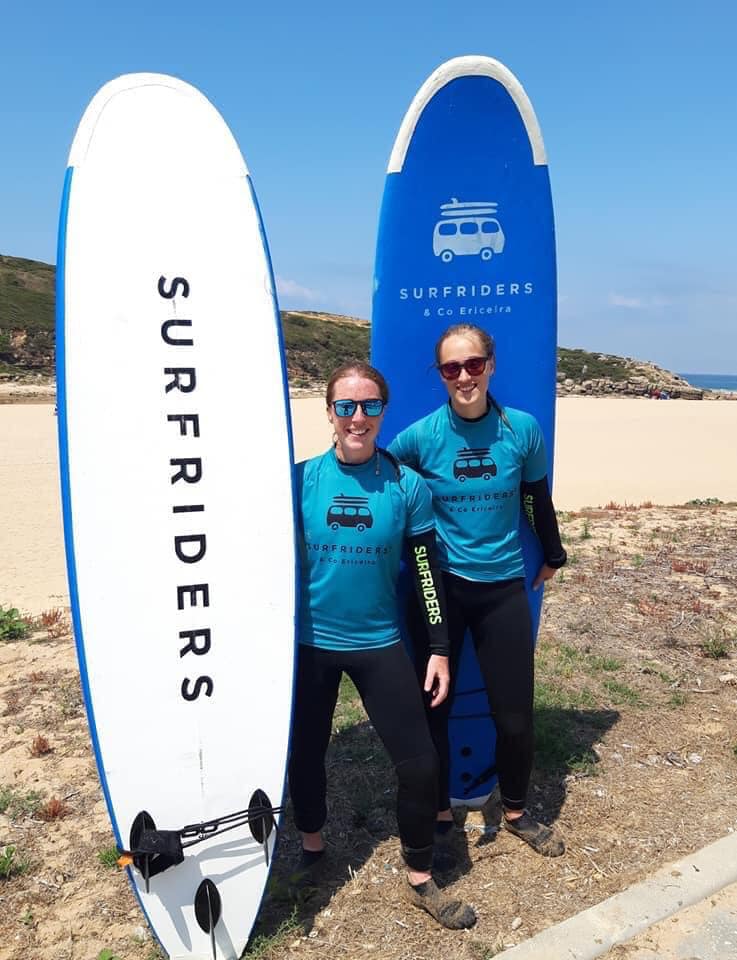
Heather's itinerary
''At this uncertain time I thought I’d share the highlights from my amazing 2-month-long trip around Europe last summer with Eurail... we did 17 different countries on the 2 month Global Pass and it was the best experience of my life ❤️.'' - Heather
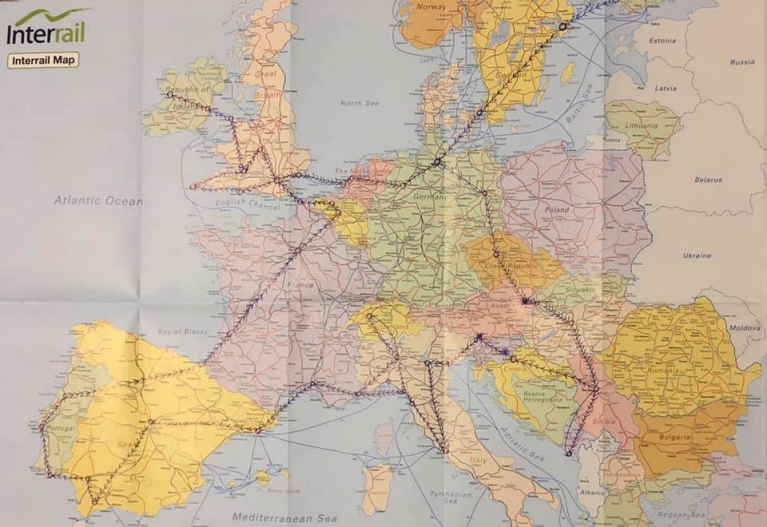
A historic trading town that forms the rail gateway to Denmark and the rest of Scandinavia. Its most known attraction also happens to be a gate - the red-brick Holstentor city gate (pictured above).
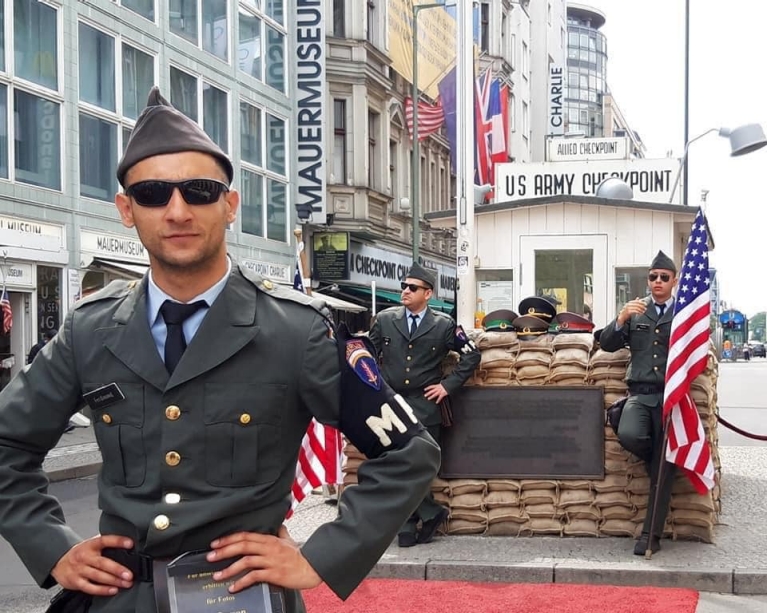
Checkpoint Charlie, Berlin
A 2h 40m journey, including a stop in Hamburg, will bring you to Germany's capital, Berlin. You'll want to stay in the city as long as you can, to discover its history, landmarks and nightlife.
Travel time:
Reservation needed:
Berlin, Germany
Berlin Südkreuz
Reservation optional
Prague, Czech Republic
Prague Hlavni Nadrazi
2. Czech Republic
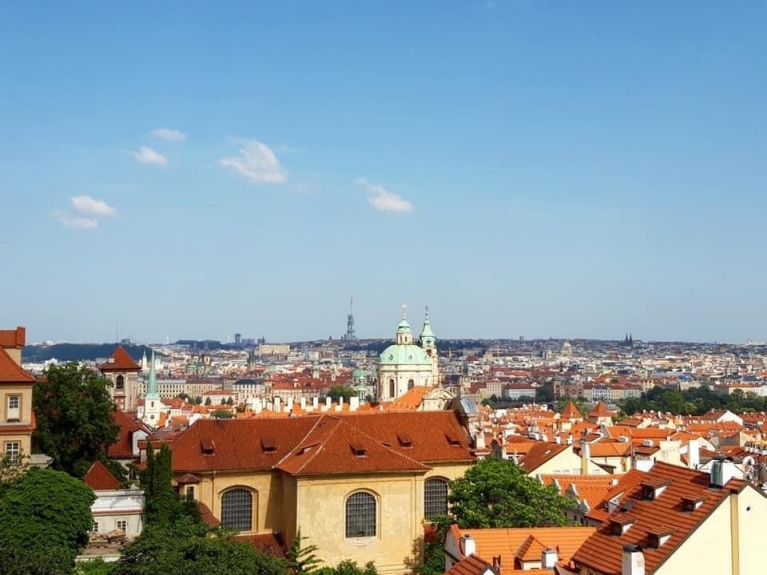
Prague's incredible skyline can be a lot to take in. Thankfully it has enough high places to see it all from different angles. Try Letna Hill to see the Vltava River and its many bridges; Petrín Tower to view the old center and castle complex; or the Klementinum for a view like this, amongst the orange rooftops.
Linz, Austria
Salzburg, austria.
Salzburg Hbf
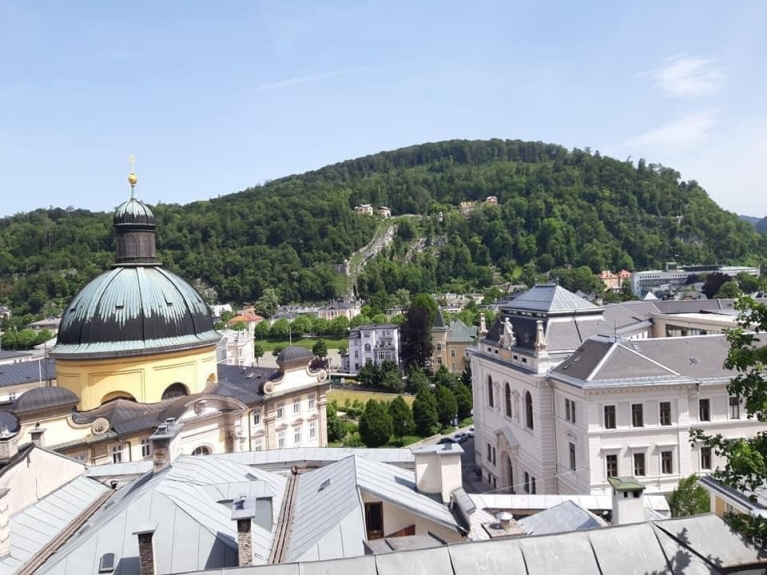
There's no direct route from Prague to Salzburg, so why not stop off in some of central Europe's smaller cities... Discover characterful Český Krumlov in Bohemia, or Austria's thrid-largest city Linz, all before you enjoy Mozart's birthplace .
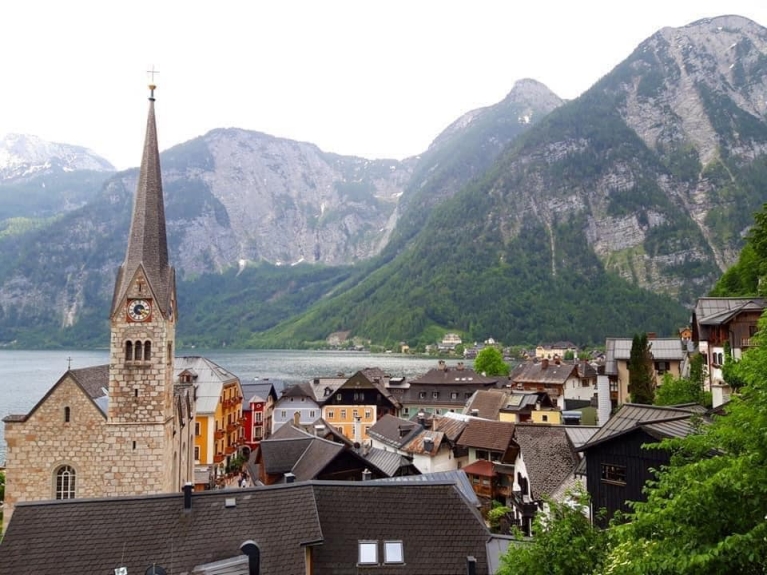
2 hours 30 minutes from Salzburg (via Attnang-Puchheim) is a view that is definitely worth the journey! Hallstatt is the most magical town of the Upper Austria lake district.
Hallstatt, Austria
Vienna, austria, bratislava, slovakia.
Bratislava-Petrzalka
4. Slovakia
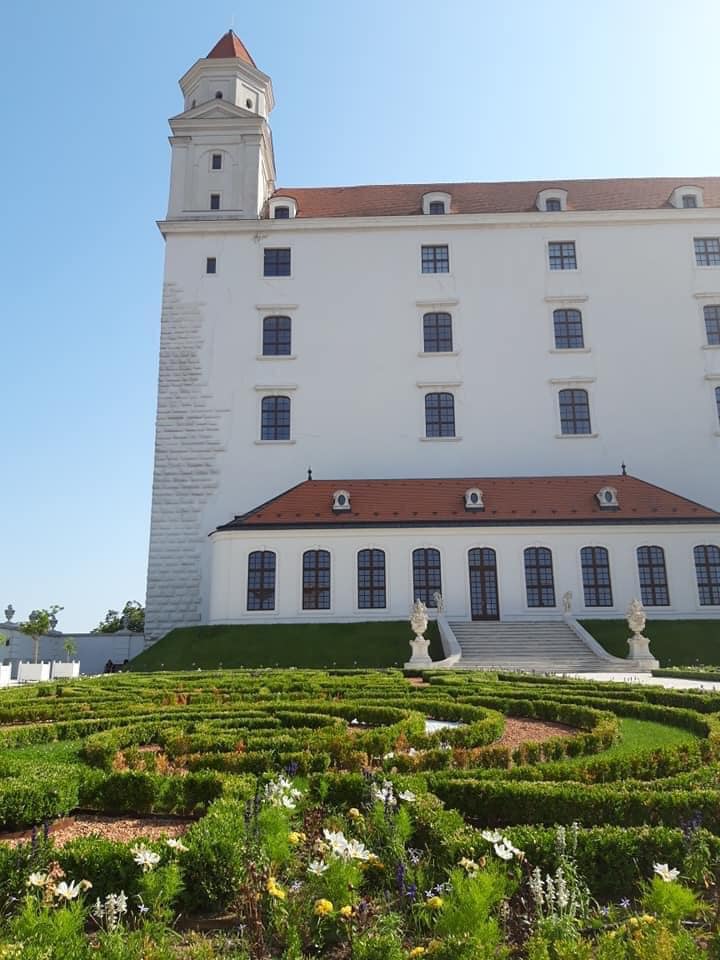
Bratislava Castle, Bratislava
You may want to break your journey in Austria's capital, Vienna, as you head east to the capital of Slovakia. Picturesque Bratislava has a lively historic center and a grand castle (pictured above) overlooking both the city and the Danube river.
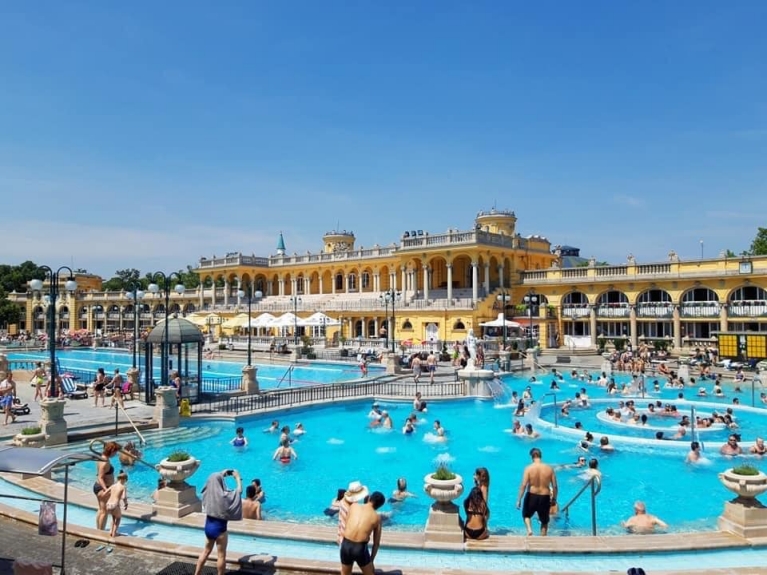
Széchenyi Thermal Bath, Budapest
A journey of 3h 47m via Vienna will drop you into Budapest without needing to make reservations. Once there you can enjoy the Széchenyi thermal baths or a cruise on the Danube.
6. Slovenia
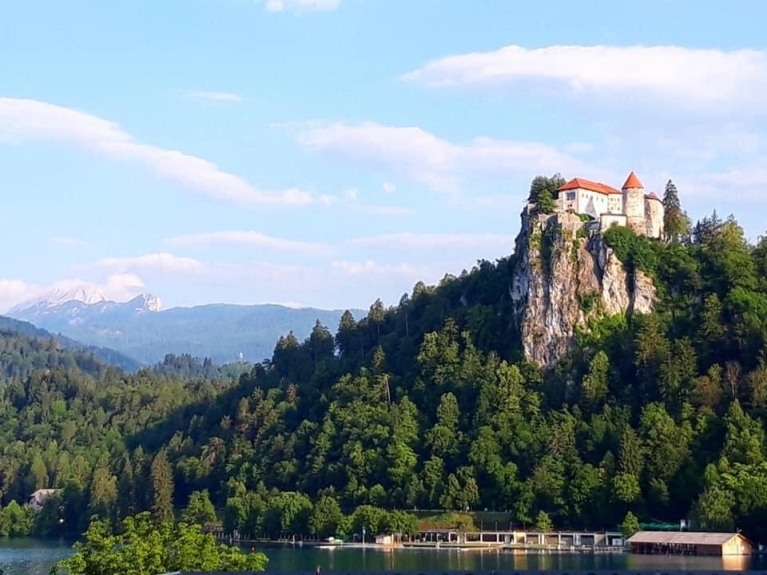
Bled Castle, Lake Bled
An overnight journey, taking the daily EuroNight from Vienna at 1:40am, will bring you to Slovenia's most-famous spot in time for a lakeside sunrise. Lake Bled, with its iconic island and castle, is a perfect backdrop for outdoor summer activities, including swimming, hiking and SUP-ing.
A once daily night train, leaving Bled at 12:36am, will take you to Italy via Austria.
Bled, Slovenia
Reservation required
Villach, Austria
Villach Hbf
Venice, Italy
Venezia S. Lucia
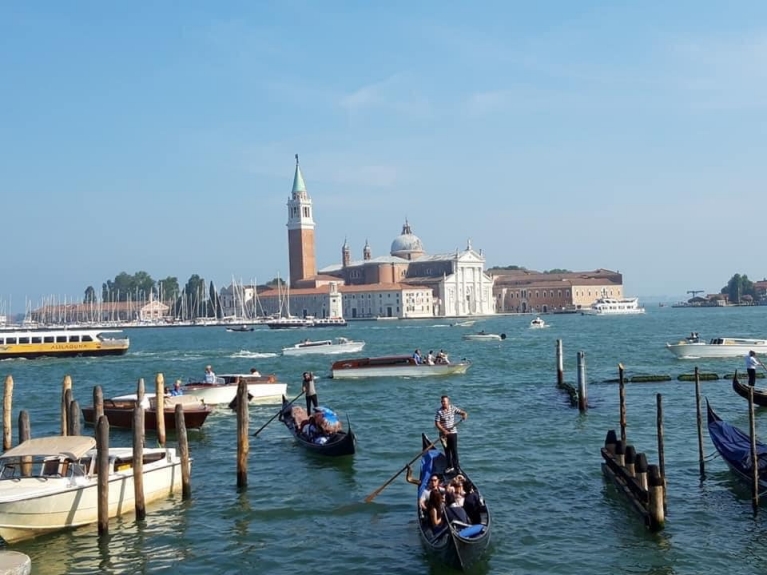
The famous city of canals is built across more than 100 small islands.

Colosseum, Rome
A 3h 48m direct train from Venice (with reservation) will bring you to the geographic, political and cultural center of Italy.

Just under 3 hours from Rome is the famous Leaning Tower. It's just a 20 minute walk from the central train station.
Cinque Terre
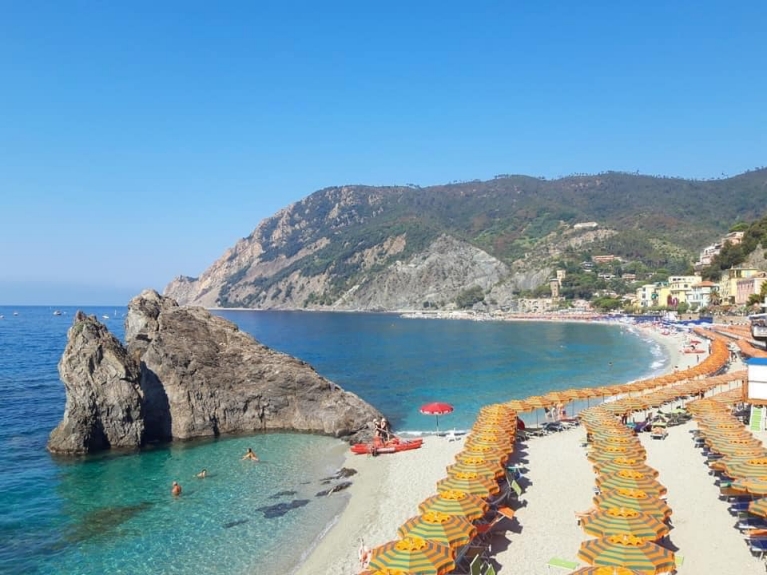
The Cinque Terre is a stretch of five historic seaside villages along the Ligurian coastline: Riomaggiore, Manarola, Monterosso, Vernazza and Corniglia . A Eurail Pass is perfect for exploring them... Arrive at La Spezia central station (about an hour from Pisa), then take the Cinque Terre train . It connects each of the 5 villages and is covered by the Eurail Pass!
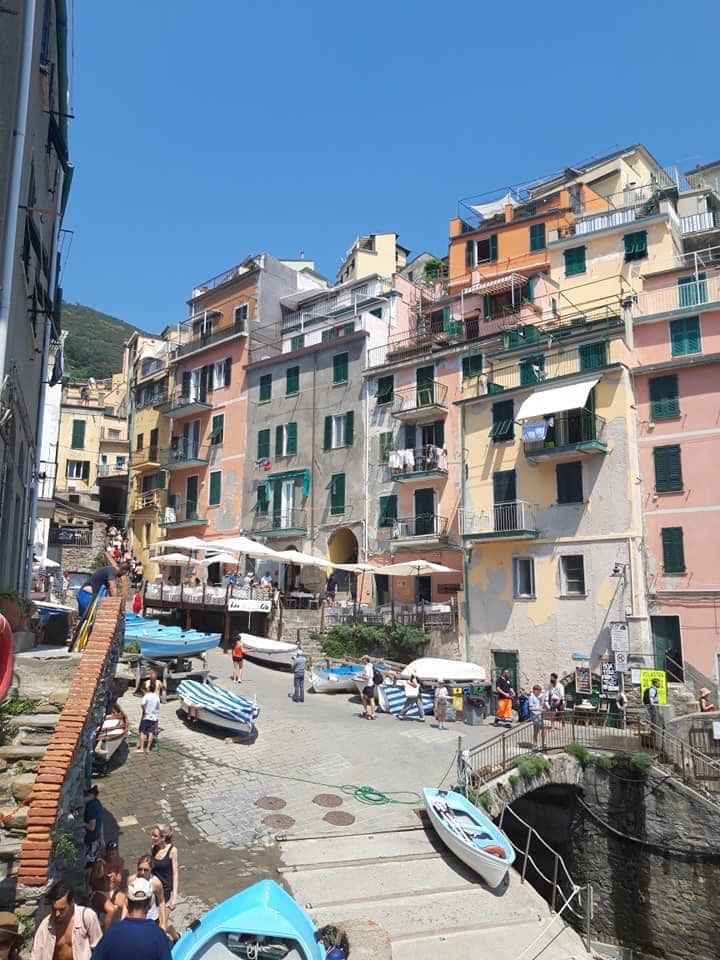
La Spezia, Italy
La Spezia Centrale
Genova, Italy
Genova Brignole
Ventimiglia, Italy
Ventimiglia
Monaco Monte Carlo
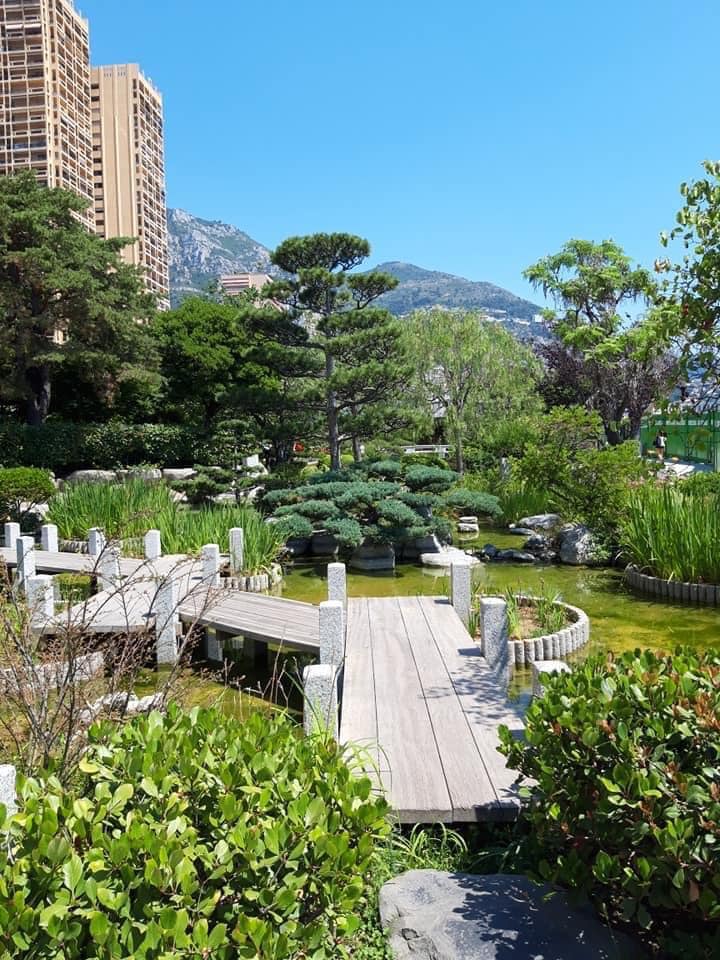
The Japanese Garden, Monte Carlo
The tiny but wealthy principality of Monaco may not be included in our list of 33 Eurail Pass countries, but a Pass is still valid for travel there! Stop off for sun, sea and luxury.

Sagrada Família, Barcelona
To avoid a long journey, it's best to stop off in one of the seaside towns of the southern coastline of France. Then take a direct train from Nîmes (France) to Barcelona in 3h 40m (reservation required). In the capital of Catalonia, you can enjoy Gaudí's fantastical architecture and relax at La Rambla or the beach.
Barcelona, Spain
Barcelona-Sants
Madrid, Spain
Madrid-Puerta De Atocha
Transfer between stations in Madrid, then take the Renfe Trenhotel night train to Lisbon. It leaves at 21:50 daily and arrives in Lisbon at 7:20. You must reserve a seat or sleeper cabin in advance.
Madrid Chamartin
Lisbon, Portugal
Lisbon Oriente
10. Portugal
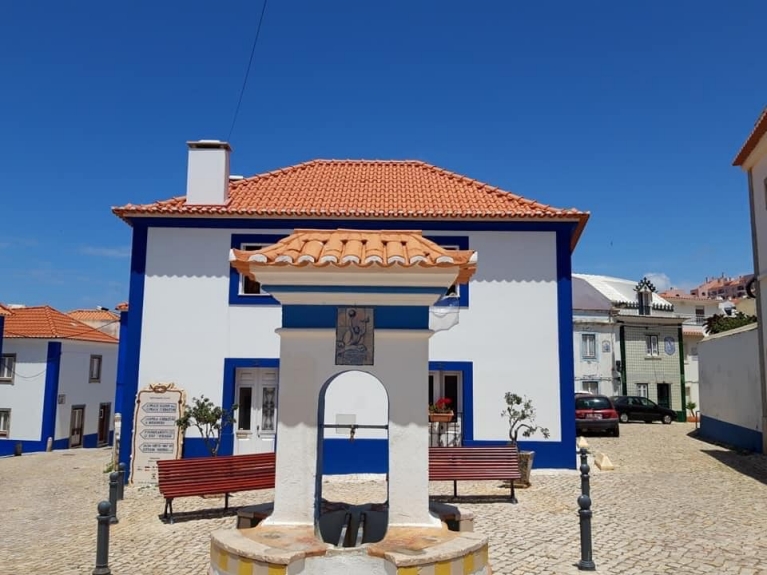
Our snapshot of Heather's 2 month itinerary concludes at the Atlantic coast in Ericeira, considered the surfing capital of Europe. It lies outside of Portugal's rail network, but can be reached in an hour by bus from Lisbon.
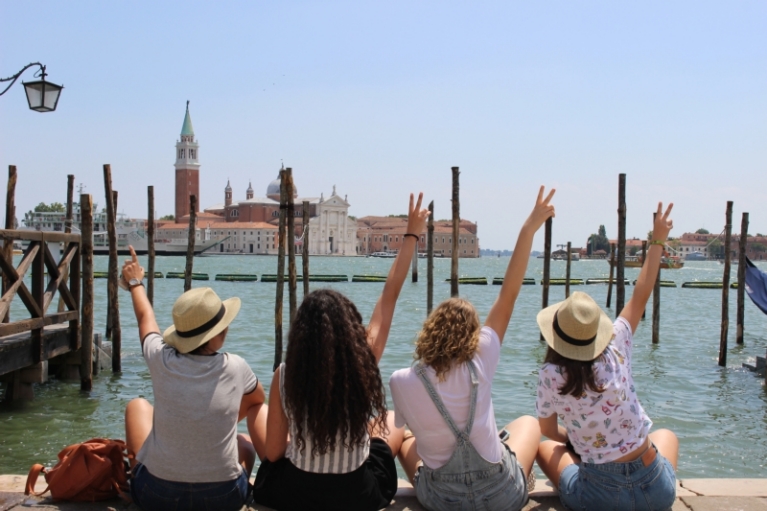
Join our community to keep up-to-date with even more itineraries, tips and Q&As from travelers just like you.
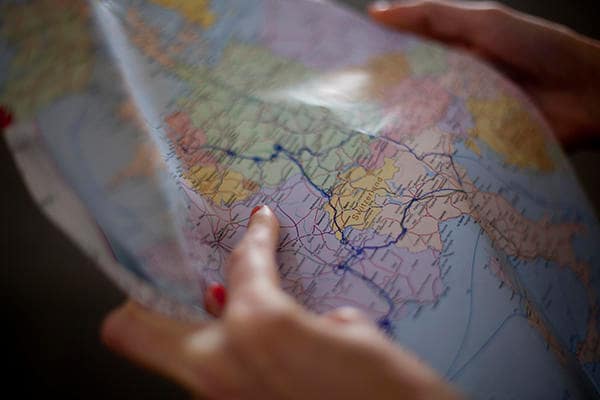
For more itinerary inspiration you can find routes of all sizes, ranging from 2-months across Europe to in-depth single country tours, on our suggested itineraries page.
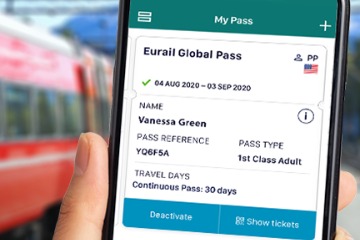
To follow Heather's itinerary, or to add even more countries, then there is only one Pass for you - the Eurail Global Pass, with access to the rail networks of 33 countries in Europe.
Change of currency
You cannot change the currency once you have a Pass in your cart. Remove the Pass, and then change the currency on the website header.
Nomadic Matt's Travel Site
Travel Better, Cheaper, Longer
Europe Travel Guide
Last Updated: April 18, 2024

From beautiful Paris to smoke-filled coffeeshops in Amsterdam, Oktoberfest to La Tomatina, Europe is a massive, diverse continent with an unlimited assortment of things to see and do. You won’t have any problem filling your time, whether you’re backpacking Europe for a few months on a budget or just spending a few weeks there on a well-earned vacation.
The continent boasts wonderful beaches, historical architecture, amazing wine, and tons of world-class festivals. Every country is incredibly different from the next too, providing limitless variety in what you do during your trip.
I first backpacked Europe in 2006 and was hooked immediately. I’ve been visiting every year since, have run tours around the continent, and even wrote a book on traveling in Europe . It’s a destination I love and never get tired of exploring.
This guide will give you an overview of Europe and the tips and tricks you need to start planning your trip. I’ve also written extensive travel guides to each country on the continent (linked below in this post) so you can get more in-depth information for your specific itinerary too!
Table of Contents
- Things to See and Do
- Typical Costs
- Suggested Budget
- Money-Saving Tips
- Where to Stay
- How to Get Around
- How to Stay Safe
- Best Places to Book Your Trip
- Related Blogs on Europe
Click Here for Country Guides
Top 5 things to see and do in europe.

1. Tour the Greek Islands
These islands are the mecca of summer beach fun and each is unique in its own great way. There’s Ios (beach party central with archeological ruins and awesome boat tours); Kos (ancient ruins and nature); Crete (Bronze Age ruins of Knossos, hiking, beaches, and wine), Santorini (iconic blue water, white buildings, and local wineries); Mykonos , (the upscale party island with beautiful beaches, villages, and sunsets), Naxos (best island in the Cyclades). Plus, Milos, Corfu, Lemnos, Zakynthos, and so many more! With hundreds of islands in the country, you can always find what you are looking for!
2. Ride the rails
Europe is famous for its international rail system. Rail passes like the Eurail Pass have been around forever and still make it very easy to get from country to country on a relatively small budget (and with lots of flexibility). Europe has some of the fastest trains in the world that travel up to an incredible 217 mph (350 kph). The whole continent is connected by trains and there’s a growing push for even more connections and long-distance, high-speed trains in order to reduce flying and help combat climate change. There’s nothing more quintessential than riding the trains in Europe and I encourage you to take as many trains as possible. It’s one of the best ways to see the continent.
3. Get lost in Paris
The “City of Lights” is everything people say it is. I fell in love with it the first time I stepped foot in Paris . The city is just magical. You have a ton of museums, cafes, jazz clubs, famous art, and beautiful architecture. I love just strolling around the streets of the Quartier Latin (Latin Quarter) or Montmartre neighborhood as it makes for a breathtaking day. Another one of my favorite things to do here is just sit in the Jardin des Champs-Élysées park and picnic like the Parisians. For something a bit different, check out the famous Catacombs and Paris Sewer Museum. With so much to offer in the way of culture, history, and gastronomy, it would take years to see everything here but you can still get a good feel of the city in a few days.
4. Go city hopping
There are so many amazing cities in Europe that we’d need a top 100 to list them all. Here are some of my personal favorites and must-see cities: London is rich in history, culture, and the famous Big Ben clock; Edinburgh is a vibrant medieval city with cozy pubs and a famous castle with a huge New Year’s Eve Party; Amsterdam has cozy coffee shops and canopied tree-covered canals; Berlin has a wild party scene, street art, and the Berlin Wall; Barcelona has tapas, beach, and unique Gaudi architecture; coastal Lisbon has colorful tiles, old tramcars, cobblestone streets and plenty of fresh seafood; Prague has a beautiful intact Old Town, incredible architecture and eclectic bars; Tallinn Estonia has beautiful medieval buildings with colorful roofs. Florence is a mecca for Italian Renaissance architecture, art history, and gelato; Stockholm mixes medieval architecture and modern art and design. Crisscross the continent, take in the culture, and enjoy all the historic cities!
5. Hit the Alps
Whether you go skiing in the winter or hiking in the summer, the Alps hold some of the most breathtaking views in all the world. You don’t even need to be an expert hiker because there are mountain trails for all levels and crystal-clear Alpine lakes. Check out the spectacular Eibsee trail loop in Bavaria at the foot of Die Zugspitze, Germany’s tallest mountain, for the clearest, multi-colored, sparkling lake you’ve ever seen. Or the Männlichen Kleine Scheidegg Panorama trail in Switzerland’s stunning green and snow-capped Alps. Or visit Italy’s Dolomites in South Tyrol for the scenic Seceda trail. The Alps have trails for every fitness level and in every season.
Other Things to See and Do in Europe
1. tour amsterdam.
I love Amsterdam so much that I lived here for a short period of time in 2006. Here cobblestone and brick streets weave around lovely canals as people ride their bikes to and fro. My favorite things to enjoy here are Amsterdam’s vibrant art and music scene and there are also a ton of interesting museums here like the Anne Frank House, FOAM, the history museum, and the hemp museum. Be sure you get out of the center into Jordaan and Oost with their wonderful outdoor cafes and fewer tourists. Also, a visit to Amsterdam wouldn’t be complete without a canal cruise to visit the many islands and there are many to choose from that include snacks and drinks, sunset cruises, live guided tours, and more.
2. Hang out in Barcelona
Barcelona is a city that goes 24 hours a day, 7 days a week. It truly could give NYC a run for the “city that never sleeps” title. Be prepared for late-night dinners and parties until dawn. Besides a great food and nightlife scene, there is a wonderful beach, tons of Gaudi architecture (including the fairytale-like Parc Güell, as well as the iconic Sagrada Familia , which has been under construction for over 100 years!), incredible food tours, one of the best history museums in the country, and lots of outdoor spaces. What I love about Barcelona is that when you’re ready to chill, you can wander around Parc de la Ciutadella and marvel at the majestic fountains, plant life, and buildings created from an ornate military fortress.
3. Visit Berlin
Hip and trendy Berlin is an energetic destination. It is one of Europe’s most affordable capital cities, with a vibrant music and art scene and a growing foodie movement. Be sure to spend some time learning about the city’s darker history via the many excellent museums, memorials, and landmarks. The East Side Gallery, a section of the Berlin Wall that’s now painted with murals, and the Memorial to the Murdered Jews of Europe are two especially powerful reminders of Germany’s past. For all periods of German history, don’t miss the Deutsches Historisches Museum (German Historical Museum) – it’s one of the best history museums in the world. Once you’ve had your fill of history, relax in Berlin’s many green spaces, from Tempelhof Field, the site of a former airfield and popular local hangout spot, to Tiergarten, a tree-covered former hunting ground for 17th-century aristocrats.
4. Drink beer at Oktoberfest
Oktoberfest is a must for anyone going to Germany at the end of September. While not a budget option since beers now cost 15 € a maß, I love the energy and friendly camaraderie this event inspires. For two weeks, millions of people from all over the world gather for lots of beer, excitement, music, and wild fun. Watching thousands of people sing together, raising quart-sized beer mugs for endless toasts, and enjoying the general party atmosphere makes you feel good about the world. (Or maybe that’s just the beer?) Just be sure to book your accommodation well in advance and be prepared to pay top prices for them. If you don’t have an outfit, don’t worry, there are plenty of shops even at the main train station where you can buy a Bavarian dirndl dress and men’s lederhosen.
5. Experience London
Get a taste of English culture in diverse London . The museums here are some of the best in the world (most are free) and include the Tate, the British Museum, the City Museum, the National Gallery, the Historical Museum. There’s no shortage of iconic sights here as well, with Big Ben, the House of Parliament, the London Eye, the Tower of London, Tower Bridge, and of course, Buckingham Palace. I love London’s diversity because of the countless international eateries with great food and wonderful pub culture, perfect for after a long day seeing the sights. Head to Brick Lane on the weekends for some amazing food and craft markets. I prefer Paris to London, but there is something sophisticated and fun about London. Just watch those pints — London is not a cheap destination!
6. Get outdoors in Scandinavia
My favorite region in Europe is Scandinavia. The quality of life here is high, the people are beautiful and friendly, and the cities are clean and historic. Cycling the cities, taking canal tours, hiking the vast forested areas, archipelago hopping, enjoying fika (a Swedish coffee break), and warming up in saunas are just a few of the popular activities that await you here. True, this area of Europe is not cheap, but there are plenty of ways to reduce your expenses. Don’t let the high prices scare you away. Highlights for me include Copenhagen , Stockholm , Gotland, Norway’s fjords, and Lapland in Finland .
7. Get enchanted in Prague
Prague has an amazing history and is one of the most beautiful and picturesque cities I’ve ever seen. Highlights include the 9th-century Prague Castle, the magnificent Charles Bridge (built in the 14th century and one of the oldest standing bridges in the world), the 10th-century old square with its iconic astronomical clock, and the winding Jewish Quarter. Even if you only have a few days there don’t miss the free walking tour which is one of my favorites in Europe and the best way to learn about the Old Town and the tragic history of the city that went from thriving Bohemian capital of art, music, and literature to part of the Iron Curtain after WWII. Some of my favorite gems here include the fantastic black light theater shows in 4D and the one-of-a-kind medieval dinner show in an old tavern complete with musicians and jugglers not to mention hearty food and drinks. During the weekends it heaves with people enjoying the bars, cheap beer, and delicious food so try to visit during the week (and in the spring or fall) to beat the crowds.
8. Relax on the French Riviera
Here, you can pretend to live the high life for a little bit. Have fun in the sun, relax on the beach, swim in azure blue water, hobnob with the rich and famous, and sail on (or gaze at) gigantic yachts. As for cities, Nice is nice with its palm-tree-lined promenade, old town, and many art museums. If you want to go see how the rich and famous live, spend an afternoon checking out Cannes to soak up some glamorous vibes on La Croisette where they hold the famous Cannes Film Festival. The kingdom of Monaco with its tiny streets, beautiful buildings, and world-famous casino is just a skip away too.
9. Enjoy the great outdoors in Interlaken
Located in the beautiful mountains of Switzerland, Interlaken is a gorgeous place to unwind with fantastic hiking, delicious hot chocolate, and plenty of outdoor sports. The area is full of natural attractions to explore, including the St. Beatus Caves (complete with a legendary dragon), the cascading 500-meter-high (1,640 feet) Giessbach Waterfalls, the Jungfraujoch mountain railway (which leads to the highest train station on the continent), and a plethora of lakes (hence the town’s name). It’s a good alternative to all the cities and museums. Interlaken is also a popular party destination for backpackers and other young travelers. By far, my favorite scenic and visually stunning trail was the Oberberghorn panoramic hike, where you can wander the green mountain ridge ogling the amazing views and the turquoise-blue Brienzersee.
10. Experience history in Rome
In this thriving historical city, you can’t walk two feet without stumbling over a ruin, making Rome a history buff’s dream. Its tiny streets are perfect for wandering as you explore the Colosseum, see the Forum and Palatine Hill, visit the Pantheon, spend time in Vatican City, admire the Spanish Steps, and toss coins into the famous Trevi Fountain. The skip-the-line tickets can definitely be worth it so you don’t waste time waiting outside attractions. Rome also has amazing food (it’s Italy, after all) and nightlife. Visit the Trastevere area for a taste of “local” Rome and chill bars. It’s my favorite area in the city because you feel like you’re in a small village in the middle of a big city.
11. Hike around the Cinque Terre
Cinque Terre is my favorite part of Italy. These five beautiful cliffside towns are perched near warm waters and beautiful olive and grape groves. There are wondrous and strenuous hikes in these hills; for a real challenge, take trail #8. Or just walk the coastline for something less difficult. Many activities here revolve around the coastline: kayaking, swimming, having a beach picnic or visiting the Technical Naval Museum. If you happen to be here in December or January, don’t miss the Nativity Manarola, the world’s biggest lighted nativity scene.
12. Tour Krakow
Krakow looks like it stepped out of a medieval postcard. It’s a hip, trendy, and youthful city that’s the center of education in Poland, meaning there are a lot of university students here. Most travelers come to party here (the vodka is cheap) but try to enjoy the city’s history and food besides just the bars. Walk the Royal Road through the Old Town to the 13th-century Wawel Castle, tour Schindler’s Factory (where Schindler saved over 1,200 Jews during World War II), and visit the sobering Auschwitz-Birkenau concentration camp. You can also take a fascinating day trip to the UNESCO World Heritage Wieliczka Salt Mine, a 13th-century mine with cavernous chambers, statues, chapels, chandeliers, and cathedrals all carved out of salt.
13. Visit the ruin bars in Budapest
The coolest nightlife in all of Europe is found in Budapest . Built in abandoned buildings, ruin bars feature funky art installations, repurposed furniture, and quirky decor. They are amazing, fun, and great places to meet locals, as people of all ages flock here. Open since 2001, Szimpla Kert is the original ruin bar and one of my favorites, along with Instant-Fogas Complex, which takes up an entire building and is actually many different bars in one. Don’t skip the ruin bars — they’re one of the most unique things about the city!
14. Explore Cornwall
The best part of England is outside London, yet unfortunately, not a lot of travelers leave London. Head west to the area of Cornwall for cheaper prices, welcoming locals, natural beauty, great hiking, rolling hills, plenty of medieval castles, and picturesque small towns. If you like biking, the Camel Trail from Bodmin to Padstow is worth the trip and you even pass by a local vineyard. It’s an easy way to spend a day (and it’s pretty flat so it’s not too hard to do.) Plus, I had the best fish and chips in Cornwall! Overall, it’s what you think of as “traditional England.”
15. Walk the Camino
El Camino de Santiago (The Way of Saint James) is an ancient pilgrimage route that stretches from France all the way across northern Spain. It is a 500 mile (800 km) trail that winds through incredible terrain, ending in Santiago de Compostela at the cathedral where St. James is supposedly buried. As a pilgrim, you get a “pilgrim’s passport” which allows you to stay in affordable pilgrim-only hostels, making this a surprisingly budget-friendly adventure. While it usually takes over a month to complete, you can just walk a section if you don’t have the time. To receive a “Compostela” (certificate of completion), you just need to walk the last 62 miles (100 km), which generally takes 4-5 days.
16. Throw tomatoes during La Tomatina
By far my favorite festival, the largest food fight in the world happens during the last Wednesday of August in Bunol, Spain. What started in 1945 as a local brawl has turned into a massive event drawing tens of thousands of people from all over the world. For about an hour, everyone throws tomatoes at each other, leaving streets ankle-deep in tomato juice. Afterward, everyone walks down to the river, cleans off, and then heads to the town square for sangria and music.
17. Find Dracula in Romania
Not a lot of people visit Romania but this underrated country in Eastern Europe has undiscovered yet picturesque medieval towns like Brasov (home to “Dracula’s castle”), Sighisoara, and Sibiu; gorgeous beaches on the Black Sea; and incredible hiking in the Fagaras Mountains — all at dirt-cheap prices. Other major sights include frescoed Byzantine monasteries, the steepled wooden churches of Transylvania, the hip university town Cluj-Napoca, the post-communist capital of Bucharest, and the Danube Delta, a huge nature reserve.
18. Drink whisky in Islay
Whisky has a long history on Islay , an island off Scotland’s west coast. It’s been made there since the 16th-century — first in backyards and then, starting in the 19th-century, in large distilleries. Over the years, whisky from the island came to be considered a specialty and was used to flavor a lot of other blends on the mainland. There are currently nine working distilleries on the island, all located along the island’s shores, with Laphroaig, Ardbeg, and Lagavulin being the most famous. Most distilleries here make single-malt Scotch, meaning that only one type of grain (barley) is used. My visit here was amazing and, even if you don’t like whisky, there are tons of good hikes and walks throughout this magnificent island.
19. Explore Iceland
Iceland is a magical country with majestic waterfalls, hidden hot springs around every corner, and sweeping vistas unlike anywhere else in the world. After my first visit, the country quickly became one of my favorite countries. With whale watching in the summer, the northern lights in the winter, and geothermal baths for soaking in year-round, there really is no bad time to visit! While Iceland’s main draw is the epic natural landscapes, it’s worth spending a couple of days in Reykjavik with its café culture, artsy feel, and brightly colored wooden row houses.
20. Sail the Croatian coast
With calm winds, short distances, a coastline littered with over 1,000 islands, and countless historical sites, Croatia is one of the world’s best sailing destinations. If you can, go during the shoulder season when you can find some great deals. Plan to stay at least a couple of days on one of the islands, with the most popular being Brac, Hvar, Krk, Cres, and Lošinj. However, don’t be afraid to get off the beaten path and explore some of the lesser-known islands such as Silba, Vis, and Lastovo. If you want to splash out and spend a week partying on a yacht, check out The Yacht Week, which hosts week-long parties, complete with DJs, from May-September. You can book a full boat to share with friends or just a cabin if you’re traveling solo. Prices start at 5,250 HRK per person and go up to 9,300 HRK.
21. Explore the Balkans
While the Balkans have become more popular with backpackers in recent years, it’s still largely overlooked by most budget travelers, despite being an extremely budget-friendly region. The Balkan peninsula is home to great (and again, overlooked) wine, beautiful medieval towns like Kotor and Mostar, stunning mountainous landscapes, beautiful pebble beaches, coffee culture, fresh, hearty yet inexpensive food, and museums covering the area’s history, including the most recent turbulent events of the early 1990s. I especially loved my time in Albania . Don’t miss the beautiful beaches in Ksamil, nicknamed the “Maldives of Europe’ as well as the mountain village of Gjirokastër, which was occupied by Romans, Byzantines, and Ottomans. The Balkans have so much to offer for every budget and every country has its unique cultural flavor.
22. Take a wine tour in the Loire Valley
Located in central France, the picturesque Loire Valley is a UNESCO World Heritage site and stretches 280 kilometers (174 miles) along the Loire River. One of the major wine-producing regions of France, the area is home to some of the best wines in the world, with over 1,000 vineyards open to the public. Even those who don’t drink wine will enjoy the beautiful small towns, great food, and the region’s over 300 impressive chateaux. I loved the medieval Chenonceau Castle and Chateau Villandry and the small villages like Saint-Florent-le-Vieil. Spring and Autumn are my favorite times to visit because you can go biking and do outdoor activities when it’s not too hot and there are fewer people. It’s an area not to be missed.
23. See Fado in Portugal
Fado is an important musical tradition in Portugal , originating in Lisbon and stretching back some 200 years. The word “fado” likely stems from the Latin word for fate, and it’s very haunting, poetic, and emotional music. Most of the songs follow themes of loss and mourning, and the music was popular with the working class (especially sailors). Performances normally take place in restaurants during dinner. In Lisbon, head to Clube de Fado, Tasca do Chico, Parreirinha de Alfama, or Senhor Vinho.
24. Tour green Slovenia
Slovenia is one of Europe’s least-visited destinations, which is mind-blowing to me because it’s an amazing place to visit. Slovenia offers all the beauty of Western Europe but at a fraction of the cost and with a fraction of the crowds. Perfect for outdoor adventure lovers, Slovenia offers rugged mountains, untouched landscapes, fantastic ski resorts, plentiful wine, sprawling cave systems, incredible food, and postcard-perfect lakes, such as the famous Lake Bled with its castle on an island. I loved Piran, Slovenia’s often overlooked coastal Venetian-style harbor town that was actually founded 3000 years ago. Stroll around its beautiful windy cobble-stoned streets, beautiful plazas, and take advantage of the many affordable restaurants right on the water. Make sure to also spend a few days in the country’s capital, Ljubljana, known as one of the continent’s greenest and most livable cities. Take a river cruise to see the city and enjoy the friendliness of the locals.
For more information on specific countries in Europe, check out the guides below:
- Albania Travel Guide
- Austria Travel Guide
- Belgium Travel Guide
- Belarus Travel Guide
- Bosnia & Herzegovina Travel Guide
- Bulgaria Travel Guide
- Czechia Travel Guide
- Croatia Travel Guide
- Denmark Travel Guide
- England Travel Guide
- Estonia Travel Guide
- Finland Travel Guide
- France Travel Guide
- Germany Travel Guide
- Greece Travel Guide
- Hungary Travel Guide
- Iceland Travel Guide
- Ireland Travel Guide
- Italy Travel Guide
- Latvia Travel Guide
- Lithuania Travel Guide
- Malta Travel Guide
- Moldova Travel Guide
- Montenegro Travel Guide
- Netherlands Travel Guide
- Norway Travel Guide
- Portugal Travel Guide
- Poland Travel Guide
- Romania Travel Guide
- Scotland Travel Guide
- Slovakia Travel Guide
- Slovenia Travel Guide
- Spain Travel Guide
- Sweden Travel Guide
- Switzerland Travel Guide
- Ukraine Travel Guide
Europe Travel Costs

Accommodation – Accommodation prices vary greatly by region. In Western Europe, hostel dorm rooms cost between 25-45 EUR per night, depending on the room’s size and the popularity of the hostel. I stayed in a 6-bed dorm in Berlin for 20 EUR, while the same one would have cost me around 45 EUR in Paris. A room in Paris costs on the higher end and a room in cheaper Athens costs on the lower end.
In Eastern Europe, hostel dorm rooms cost between 10-15 EUR per night depending on the size of the dorm room and the popularity of the hostel. The further east you go, the cheaper it gets. Expect to pay around 30-60 EUR per night for a private room that sleeps two.
In Scandinavia, hostel dorm beds cost around 25-45 EUR, while private rooms are 65-80 EUR. Budget hotels start around 85 EUR.
Most accommodations offer free linens, free Wi-Fi, and a lot offer free breakfast, but it’s important to check specific websites for exact amenities.
Campsites cost between 10-15 EUR per night for a basic plot for two without electricity.
Food – Food traditions in Europe run deep, stretching back centuries to become integral parts of each country’s culture. From baguettes in France to tapas in Spain, from hearty Eastern European stews and goulash to the fresh vegetables and olive oils of the Mediterranean, European cuisine varies as much as the countries themselves. Food prices differ greatly across the continent, so check individual country guides for specifics.
But no matter where you are, even in the more expensive countries, finding places to eat within your budget is easier than you might think. Throughout Western Europe, you can find small shops, street food stalls, or food trucks where you can get sandwiches, gyros, kebabs, slices of pizza, or sausages for between 3-7 EUR. These shops are most often found in train stations, bus stations, and main pedestrian areas, and offer cheap food alternatives that can have you eating on 12-17 EUR per day. Fast food (think McDonald’s) costs around 7-10 EUR for a combo meal.
Turkish, Middle Eastern, and Vietnamese eateries abound in Germany, while Indian food is incredible and everywhere in the United Kingdom. Meals at these restaurants usually cost between 8-12 EUR.
Restaurant meals in casual, traditional eateries generally cost around 13-25 EUR for a main dish and drink. Food is much cheaper in the east than in the west, and in the west, northern regions like Scandinavia and the UK are more expensive than southern countries like Spain, Portugal, and Italy.
In Eastern Europe, even if you are eating out for all your meals, you can still get by on a food budget of as little as 15 EUR per day.
For drinks, a pint of beer is 2-5 EUR, a glass of wine is 2-7 EUR, a cappuccino is 2-5 EUR, and cocktails range from 6-14 EUR.
If you eat out, do so at lunch and get the prix-fixe menu (two-course or three-course set menu). Restaurants offer this set menu during lunch, and with prices between 10-20 EUR, it’s a way better deal than the regular dinner menu. You can also get affordable lunches at outdoor markets. So many European cities have huge fresh food markets throughout town.
You can cook your own food for around 45-65 EUR per week. This gets you basic staples like rice, pasta, seasonal produce, bread, and some meat. You can save money by shopping at discount supermarkets like Profi, Lidl, Aldi, and Penny Market.
If you want to save big money on meals, head to one of the markets, pick up some cheese, wine, bread, meats, or anything else, and go to the park for a picnic. (Or grab a sandwich for later!) You’ll find the locals doing the same thing, and it’s one of the cheaper ways to get a true taste of local food.
Backpacking Europe Suggested Budgets
Prices for travel in Europe vary greatly depending on how far north, east, south, or west you travel. If you stick to the budget accommodations, food, and tours listed here and use all my tips on saving money, you need about 65-110 EUR per day in Western Europe, 40-50 EUR in Eastern Europe, and about 85-130 EUR in Scandinavia.
Those numbers reflect a traveler who stays in hostels, cooks some meals and eats out cheaply, enjoys a few drinks, and sticks to free and cheap activities like hiking, walking tours, and enjoying nature. This is your typical backpacker budget. You aren’t going to have a fancy time, but you aren’t going to want for anything either.
However, by getting tourist cards and rail passes, avoiding flights, occasionally Couchsurfing or camping, cooking all your meals, and not drinking, you can travel a lot cheaper. On this budget, you could do Western Europe on 35-45 EUR per day, Eastern Europe on 20-25 EUR, and Scandinavia on 50-65 EUR. That would require you to take a train or a bus or hitchhike everywhere, skip most museums, and limit how often you go out.
Generally, the suggested daily budget for Europe is 80-120 EUR. You can use the chart below to get an idea of how much you need to budget daily. Keep in mind these are daily averages – some days you’ll spend more, some days you’ll spend less (you might spend less every day). We just want to give you a general idea of how to make your budget. Prices are in EUR.
Europe Travel Guide: Money-Saving Tips
Individual country guides have more specific information on how to save money in them but here are some general tips on cutting your costs while you explore Europe:
- Picnic – This continent has a lot of little shops where you can buy pre-made sandwiches or ingredients to make your own. Many supermarkets have delis as well where you can get food to go. Buy some food, eat outside, and watch the city and its people go by. It’s a much more enjoyable and cheaper way to eat.
- Eat local and cheap – Not into picnicking? Eat at local sandwich shops, pizza parlors, Maoz, Wok to Walks, and outdoor street vendors. Avoiding restaurants and eating at a lot of the local “grab n’ go” places gives you a taste of the local cuisine at a much cheaper price. If you’re really on a budget, use your creative cooking skills to prepare meals at the hostel as well.
- Stay with a local – Hostels can add up really quickly. If you don’t have any friends with whom you can stay, consider using Couchsurfing , which connects you with locals who let you stay with them for free. Plus, they tend to also have meetups to meet other locals and travelers. It’s a great way to save on accommodation and meet a local who can share their insider tips and advice.
- Camp in a garden – A very good camping service specific to Europe is Campspace , which allows you to pitch a tent in someone’s backyard for free or for a small fee (around 10-20 EUR). All of the garden owners have profiles that tell you what services and facilities they offer. Also, many countries allow wild camping (like Sweden), which can save you a fortune if you have a tent.
- Take the bus – Budget bus companies like Flixbus can take you across the continent for cheap. I personally feel it’s best for day travel as sitting up for an overnight bus isn’t really ideal for sleeping. It isn’t glamorous, but with tickets starting at 5 EUR, you really can’t complain!
- Get a Rail Pass – Eurail Passes have saved me hundreds of dollars. If you are traveling far distances and through many countries, they are a great deal.
- Take the free city tours – One of the great things about Europe is that you can find free walking tours in all the major cities. They can be a great way to see the city attractions, take in some history, and learn your bearings without spending any money. Just make sure to tip your guide at the end!
- Plan accordingly – Plan your trip around Europe so you avoid doubling back. Transportation is a big expense so proper planning can save you a lot of money (and time). Go in a straight line or a loop. Booking your accommodation ahead helps you save as well since cheap, good places unsurprisingly get reserved first. One thing I’ve learned is that waiting until the last minute means you get stuck with expensive places or cheap places no one wants.
- Fly cheap – If you know where you are going and a train won’t do, try to book flights early. You can often get round trip fares for as little as 5 EUR from many of the European discount airlines like Ryanair or Wizz. Many capital cities have smaller airports farther from the city with ‘inconvenient’ times but cheaper fares. Keep in mind you might need to factor in an early morning Uber or taxi if the busses aren’t running and you have an early flight!
- Drink less – Those 5 EUR beers add up. Hit happy hours or pick and choose when you party. Hostel bars are a good place to get cheap drinks or buy your alcohol at the supermarket. Plus, in Europe, it’s legal to drink outside in parks, plazas, by the lakes or rivers. You’ll find you can save a lot of money by not going to bars and clubs. Partying your way across the continent will destroy your bank balance in no time.
- Get a city tourist card – Many local tourism offices sell a tourism card for all their attractions, tours, and restaurants. This card gives you free entry and substantial discounts on all the attractions and tours in a city, free local public transportation (a huge plus), and discounts at a few restaurants and shopping malls. They save a ton of money. If you plan on doing a lot of sightseeing, get one of these cards.
- Rideshare – If you’re flexible in your schedule, use the ridesharing service BlaBlaCar to catch rides with locals between cities (or countries) by paying a small fee. It’s like Airbnb but for rides. I used this service in Switzerland and, not only did I save a lot of money, but I got to meet interesting people and learn about local culture and life. Drivers are verified and it’s perfectly safe, though sometimes rides cancel at the last minute (which is why you need to be flexible). Check their ratings first and try to use rides where the person has done many trips.
- Bring a water bottle – The tap water is safe to drink in most of Europe, so bring a reusable water bottle to save money and reduce your plastic use. LifeStraw is my go-to brand as their bottles have built-in filters to ensure your water is always clean and safe.
- Get a HostelPass – HostelPass is a discount membership for hostels in Europe. Members get 10-20% off select hostels around Europe, as well as perks like free breakfast or free drinks. There are discounts on tours and activities too. It’s a great way to save money if you’re bouncing around Europe as they have hostels in 18 countries around the continent.
Where to Stay in Europe
Europe has a ton of budget accommodation options. The individual country and city guides have tons of recommendations but here’s a short list of some of my favorite budget hostels and hotels around Europe:
- The Flying Pig (Amsterdam, The Netherlands)
- Hotel 54 (Barcelona, Spain)
- Generator Hostel (Copenhagen, Denmark)
- Harcourt Hotel (Dublin, Ireland)
- Castle Rock (Edinburgh, Scotland)
- Ios Palm Pansion (Ios, Greece)
- Greg and Tom’s Party Hostel (Krakow, Poland)
- Largo da Sé Guest House (Lisbon, Portugal)
- Sophie’s Hostel (Prague, Czech Republic)
- The Yellow (Rome, Italy)
- City Backpackers (Stockholm, Sweden)
How to Get Around Europe

Public transportation – Transportation around most European cities is by tram, subway, or bus. Prices are typically around 2 EUR for a one-way ticket in Western Europe and closer to 1 EUR in Eastern Europe. Most large cities also have day passes available that offer unlimited public transportation. These passes are usually 5-12 EUR per day.
In large cities with international airports, there is usually a bus or train available that ferries travelers from the downtown core to the airport. Expect to pay around 5-15 EUR to get to/from the airport.
Bus – Buses are not quite as comfortable as Europe’s trains, although certain lines do have great amenities (like roomy seats and Wi-Fi). While buses are not the most efficient way to travel around the continent, they’re certainly dependable, reliable, and cheap. You can find last-minute rides for as little as 5 EUR. A route from Berlin to Munich is about 25 EUR, while Paris to Bordeaux can be as low as 10 EUR. Longer routes, like Amsterdam to Copenhagen, start at around 47 EUR.
Each country has its own national bus service, but some lines also take you long distances internationally. Megabus and Flixbus (which now owns Eurolines) are the most popular companies.
Train – Train travel is a great way to see Europe. Intercity train prices vary wildly from country to country, depending on whether you take the slow train or a high-speed train and how far in advance you book. For example, a high-speed train from Berlin to Munich costs around 38-60 EUR, Bordeaux to Paris is about 50-85 EUR, and Madrid to Barcelona ranges from 45-85 EUR. Non-high-speed trains and other intercity lines are a lot cheaper, generally costing about 40-50% of the price of high-speed trains. Eastern Europe inter-country trains usually cost between 45-100 EUR when the ticket is booked last minute. Short train rides of 2-3 hours within countries cost about 27 EUR.
To find routes and prices for trains around Europe, use Trainline .
You may also want to consider getting a Eurail Pass , which allows travelers to explore Europe by providing a set number of stops in a specific time period. These passes are continent-wide, country-specific, or regional. It can potentially save you hundreds of dollars.
Ridesharing/Car sharing – If your schedule is flexible, use a ridesharing service and catch rides with locals between cities (or countries). Drivers are verified and it’s perfectly safe. BlaBlaCar is the most popular.
If you’d rather rent a car yourself and find passengers to share a ride with, use Discover Cars to find the best car rental prices.
Flying – Budget airlines are so prolific that competition helps keep fares low. You can often find tickets where the fare is just 5 EUR round-trip! Companies like EasyJet, Ryanair, Wizz, and Vueling offer mind-blowingly cheap flights throughout Europe. Book at least a month early to scoop up great deals.
Make sure that the airport they fly into isn’t too far out of your way (transportation from the secondary airport sometimes negates the savings from using the budget airline itself).
Keep in mind that you’ll have to pay to check your baggage on these cheap flights. It costs about 25-39 EUR for one checked bag. If you wait to pay for your luggage at the gate, you end up paying almost double. Travel carry-on only to avoid this added cost.
Hitchhiking – Hitchhiking in Europe is very safe, but it’s not for everyone. Hitching is quite common around the continent and I’ve met a number of travelers who have done it (I, myself, traveled this way in Bulgaria and Iceland). Some countries are very supportive (Romania, Iceland, Germany) while others may be a bit more time-consuming (Italy, Spain). HitchWiki is the best website for hitchhiking info.
Here are my suggested articles for how to get around Europe:
- 7 Cheap Ways to Travel Across Europe
- Are Eurail Passes a Giant Scam or Do They Save You Money?
- The Ultimate Guide to Finding Cheap Flights
When to Go to Europe
There’s no wrong time to visit Europe. Peak season is summer, when Europe gets crowded and August is the time most European families are at the beach so everything becomes more crowded and expensive. But the overall atmosphere and weather are great during this time, so it’s still worth visiting during peak season (just book your accommodation in advance — especially in August). Keep in mind it’s much hotter in summer so if you like AC, be sure to check that your hostel or hotel has it before you book. You can expect the most crowds in Western Europe. For this reason, I feel summer is a great time to visit the Balkans and the Baltics because many people head to the beaches in Spain, France, Italy, Croatia, and Greece.
Shoulder season is spring and fall (April-May and September-October). It’s still warm during this time but there aren’t as many crowds and prices are cheaper. This is my favorite time to visit hotspot places like Spain, Croatia and Greece, where it’s still hot enough to swim in the sea but you have way more room on the beach. It’s also a good time to go hiking in the Alps in Germany, northern Italy, Slovenia and Switzerland because it’s cooler during the day so you’re much less sweaty on the mountain without shade. The weather is good, the crowds are smaller, and the prices lower.
Winter is from November to February but in much of Central Europe, it’s wet and cold until March or April. It gets cold, even as far south as it gets (like Greece). On the other hand, the Christmas season has Christmas markets and festivals galore! Even if it’s cold, this is a cultural tradition you can’t miss and why I love Europe in December. There is hot mulled wine, sweets, and plenty of hot snacks, which vary by country. One of my favorites is Prague because the Old Town Square is lit up with a gigantic tree with aromas of crispy cinnamon pastries and mulled wine. Berlin takes their Christmas markets very seriously, so there are around 80 different markets with special themes.
Winter is fantastic in Europe for skiing and snowboarding but it doesn’t have to break the bank if you plan carefully. While Switzerland and France are probably the most famous, they are also expensive, but there are plenty of budget winter options.
How to Stay Safe in Europe
Europe is very safe for backpacking and solo traveling, even if you’re traveling solo, and even as a solo female traveler. Violent crimes against tourists are very rare. In fact, some of the safest countries in the world are in Europe. (I wrote a whole article about how Europe is safe to visit right now .)
That said, there are scams and petty crimes you should watch out for, especially around popular tourist landmarks. The most important thing to be aware of is pickpockets in crowds and on public transportation. Zip your bags and don’t put your mobile phone in a jacket pocket where someone could quickly take it. This should be obvious but don’t flash your money to let everyone know you have a huge wad of cash.
When choosing a hostel, look for ones with lockers. It’s always a good idea to carry around a padlock or combination lock. Most hostels are safe and travelers respect each other and I’ve rarely seen things happen to people’s valuables. Nevertheless, I always think that prevention is better.
As anywhere, the standard precautions apply (never leave your drink unattended at the bar, never walk home alone intoxicated, etc.). When at the bar, always keep an eye on your drink. Avoid walking home alone at night if you’re intoxicated.
For female travelers in particular, it’s always a good idea to have a bit of extra money on you just in case you need to take an Uber or taxi back by yourself so you don’t take unnecessary risks to save money. If you’re using apps to date people while traveling, please use common sense and meet in public places. Since I’m not a female traveler, please check out the numerous female bloggers who have first hand knowledge of this.
If you’re worried about scams, you can read about common travel scams to avoid here.
If you rent a vehicle, don’t leave any valuables in it overnight. Break-ins are rare, but it’s always better to be safe than sorry. Be aware that the UK drives on the left and that most rental cars in Europe will have manual transmissions unless you request otherwise.
When hiking, always bring water, sunscreen, and bandaids or foot plasters. There is nothing worse than being halfway up the mountain with a blister and nothing you can do about it!
Likewise, when at the coast, don’t forget not only to wear sunscreen! I can’t tell you how many times I’ve seen people get burnt to a crisp the first day. Be sure to check the weather before you depart and dress accordingly.
If you do experience an emergency, dial 112 for assistance.
Always trust your gut instinct. Make copies of your personal documents, including your passport and ID. Forward your itinerary to loved ones so they know where you are.
The most important piece of advice I can offer is to purchase good travel insurance. Travel insurance will protect you against illness, injury, theft, and cancellations. It’s comprehensive protection in case anything goes wrong. I never go on a trip without it as I’ve had to use it many times in the past. You can use the widget below to find the policy right for you:
Europe Travel Guide: The Best Booking Resources
These are my favorite companies to use when I travel. They consistently have the best deals, offer world-class customer service and great value, and overall, are better than their competitors. They are the companies I use the most and are always the starting point in my search for travel deals.
- Skyscanner – Skyscanner is my favorite flight search engine. They search small websites and budget airlines that larger search sites tend to miss. They are hands down the number one place to start.
- Hostelworld – This is the best hostel accommodation site out there with the largest inventory, best search interface, and widest availability.
- Booking.com – The best all around booking site that constantly provides the cheapest and lowest rates. They have the widest selection of budget accommodation. In all my tests, they’ve always had the cheapest rates out of all the booking websites.
- HostelPass – This new card gives you up to 20% off hostels throughout Europe. It’s a great way to save money. They’re constantly adding new hostels too. I’ve always wanted something like this and glad it finallt exists.
- Get Your Guide – Get Your Guide is a huge online marketplace for tours and excursions. They have tons of tour options available in cities all around the world, including everything from cooking classes, walking tours, street art lessons, and more!
- The Man in Seat 61 – This website is the ultimate guide to train travel anywhere in the world. They have the most comprehensive information on routes, times, prices, and train conditions. If you are planning a long train journey or some epic train trip, consult this site.
- Rome2Rio – This website allows you to see how to get from point A to point B the best and cheapest way possible. It will give you all the bus, train, plane, or boat routes that can get you there as well as how much they cost.
- FlixBus – Flixbus has routes between 20 European countries with prices starting as low 5 EUR! Their buses include WiFi, electrical outlets, a free checked bag.
- SafetyWing – Safety Wing offers convenient and affordable plans tailored to digital nomads and long-term travelers. They have cheap monthly plans, great customer service, and an easy-to-use claims process that makes it perfect for those on the road.
- LifeStraw – My go-to company for reusable water bottles with built-in filters so you can ensure your drinking water is always clean and safe.
- Unbound Merino – They make lightweight, durable, easy-to-clean travel clothing.
- Top Travel Credit Cards – Points are the best way to cut down travel expenses. Here’s my favorite point earning credit cards so you can get free travel!
GO DEEPER: Nomadic Matt’s In-Depth Budget Guide to Europe!

While I have a lot of free tips on Europe, I also wrote an entire book that goes into great detail on everything you need to plan a trip here on a budget! You’ll get suggested itineraries, budgets, even more ways to save money, my favorite restaurants, prices, practical information (i.e. phone numbers, websites, prices, safety advice, etc etc), and cultural tips.
I’ll give the insider view of Europe that I got from years of traveling and living here! The downloadable guide can be used on your Kindle, iPad, phone, or computer so you can have it with you when you go. Click here to learn more about my book on Europe!
Europe Travel Guide: Related Articles
Want more tips for your trip? Check out all the articles I’ve written on Europe travel and continue planning your trip:

The 6 Best Hotels in Copenhagen

The 6 Best Hotels in Florence

The 7 Best Hotels in Madrid


The 6 Best Hotels in Vienna

The Best Walking Tours in Barcelona

How to Be a Digital Nomad in Europe
Get my best stuff sent straight to you, pin it on pinterest.
- Where To Stay
- Transportation
- Booking Resources
- Related Blogs
- Destinations
- Travel Tips
- Travel With Us
- Paid Travel Internship
- TTIFridays (Community Events)
- SG Travel Insider (Telegram Grp)

18 Budget Tips to Travel Europe For a Month Under S$2.4k
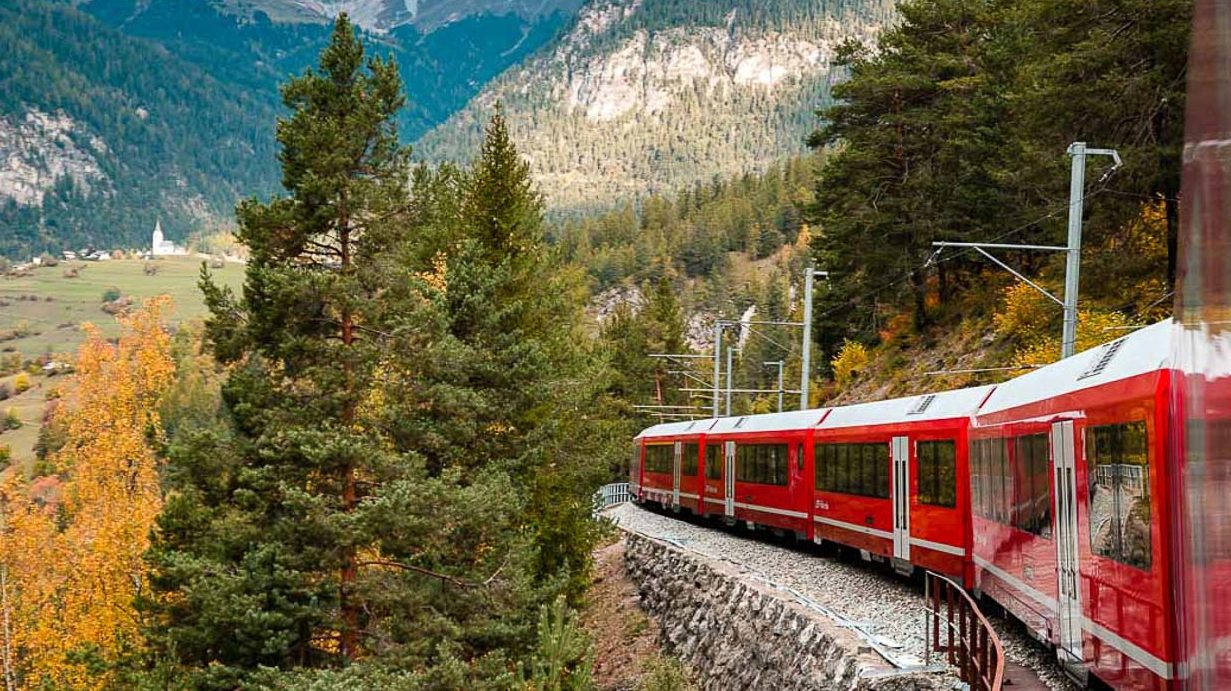
Travelling in Europe is notoriously expensive. While it may seem so on the surface, there’re always ways to stretch your dollar (or euro, for that matter). Here, we’ve put together some nifty money saving tips to make travelling a whole month in Europe for under S$2.4k a reality.
Fret not, none of these tips involve sleeping on the streets 😉

Budget Breakdown Accommodation: €517 Food: €375 Transport: €485 Activities + Miscellaneous: €150 Total: €1,527 (S$2,326.8)
PRE-TRIP TIPS
1) avoid the peak season.
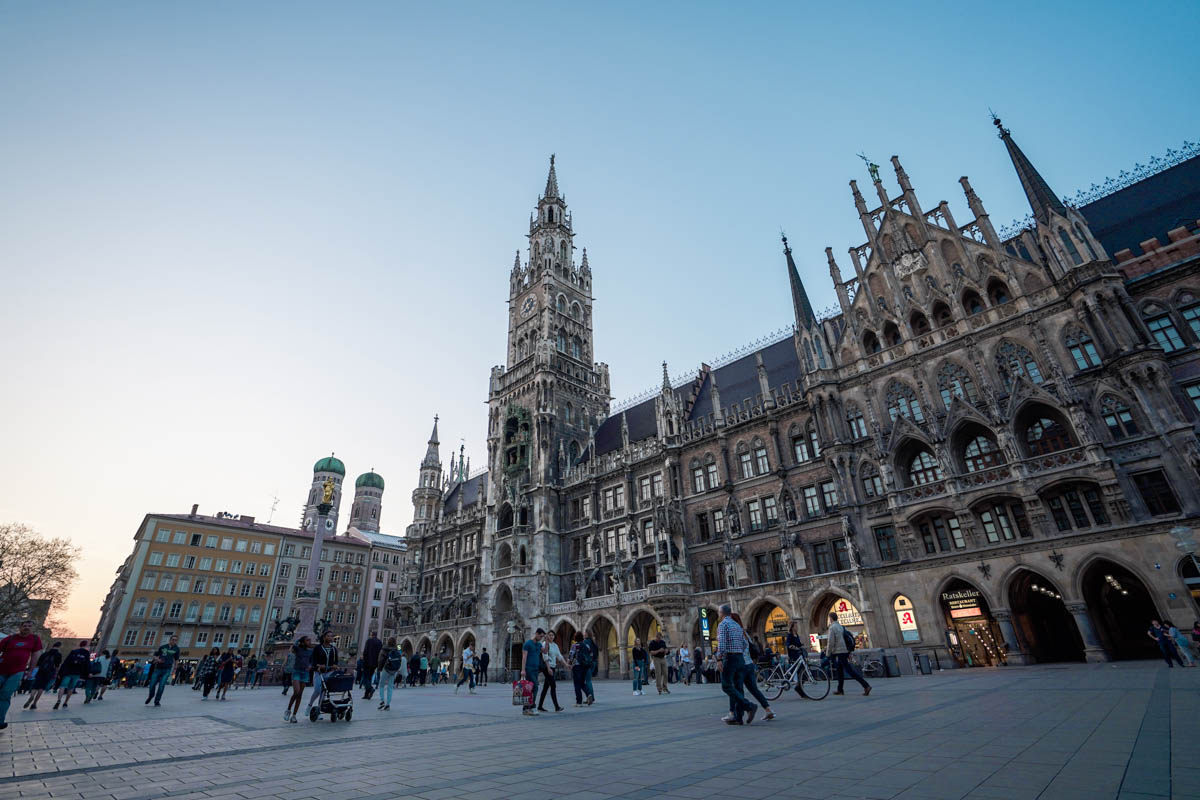
Airfare will probably take up the bulk of your cost so the key to keeping flight costs low is to fly during non-peak season .
Summers (June to September) are popular travel seasons in Europe so try to avoid those. Not only will the flights be expensive, prices for hotels and restaurants will hike between 20 – 50% — not to mention the risk of having everything booked out early.
Plan to fly between November to March and you’ll see a pretty significant drop in price; you’ll get to enjoy fewer crowds too. You might think travelling in December is expensive, but it will still be cheaper than flights in the peak summer season.
*Pro-tip: Visit in December to soak in the festive atmosphere at Christmas markets seen in most major European cities.
2) Search for flights early

Planning early allows you to scout for the cheapest European cities to fly to. Keep a lookout for promotional airfares to European cities which major airlines will run from time to time.

*Pro-tip: Look out for special deals under the “ Promotions ” tab on UOBTravel for extra discounts on flights, hotels and tour packages.
I was able to book a flight from SG to Munich, Germany with Singapore Airlines for just under S$1,000 in December 2015, which was really a steal for European cities on a direct flight.
3) Check out Eastern Europe
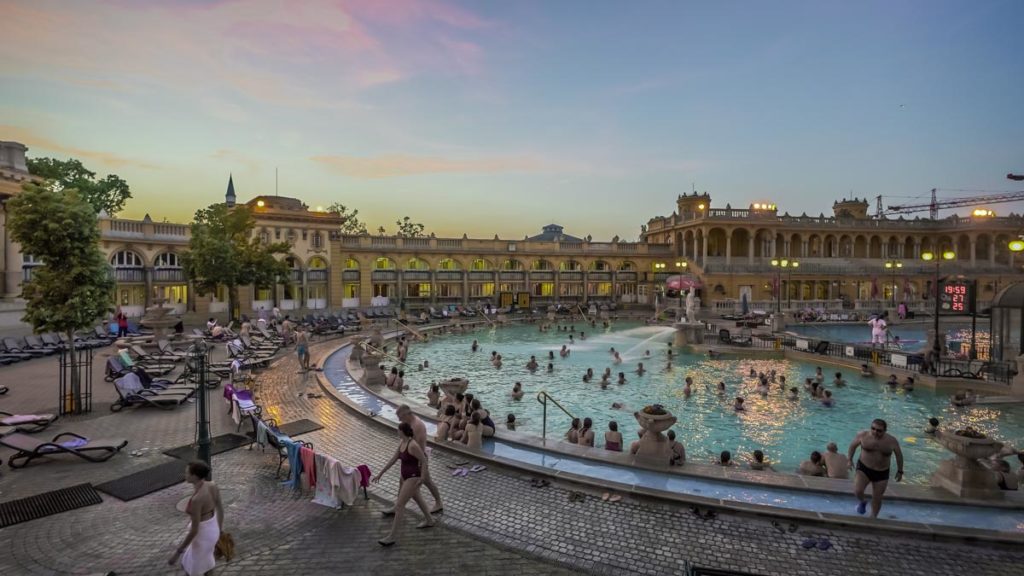
While countries like France and UK are must-visit European destinations, Eastern European countries have their own charms too and are cheaper travel destinations compared to their Western siblings.
Take Budapest for example, a medieval city filled with hidden historical wonders. Find yourself transported back in time at Buda Castle and Citadel, while feasting your eyes on a panoramic view of the city on Gellert Hill.
Meals in Eastern European cities are also on average about half the cost of that in Western European cities. Take the path less explored, and open up to wonders of what the lesser known can bring.
ACCOMMODATION
4) take overnight sleeper trains.

Imagine going to bed in Vienna and waking up in Zurich, how cool does that sound?
As long as there’s space to lay flat, I have personally grown to love overnight train travel. Not only does it save time but also a night’s accommodation in the city.
Cross-border sleeper or couchette trains tickets start at €59 per bed in a 6-berth couchette cabin. Fresh sheets and blankets are provided. Some services even provide a simple breakfast with croissant and coffee. Check out Seat61 for more information on Sleeper Trains.
5) Try Couchsurfing
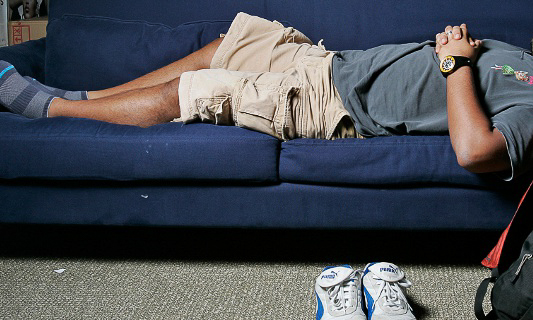
While sleeping on the couch of a stranger’s home may be a terrifying idea to many, I’ve heard a fair share of incredible experiences from friends who’ve tried and tested this.
Not only is this free, it is also a great way to interact with locals! These locals are usually very friendly since they too are taking up the risk of opening their homes to absolute strangers.
The couch-surfing community maintains a safe environment for hosts and surfers alike by sharing information and leaving references for each other. Besides couchsurfing.com , another notable free accommodation platform is stay4free .
6) Consider Youth Hostels

On days you just want to pamper yourself and rest your head on comfy pillows but not spend too much on accommodation, turn to youth hostels. Although this cheaper form of accommodation is targeted to younger travellers and backpackers, there are usually no age limits imposed.
Communal spaces within the youth hostels allow for interaction between guests, and that’s the charm of youth hostels, where like-minded travellers come together and share travel stories and experiences with one another.

Many youth hostels also offer private rooms which are great for days you want a little more privacy. Some even come with ensuite toilets and are still more than half of what it would cost in a three to four-star hotel.
Expenses on Accommodation: Sleeper train x 3 nights: €59 x 3 = €177 (S$287) Couch-surf x 10 nights: FREE Hostel x 17 nights: €20 x 17 = €340 (S$551) Total expenses for accommodation: €517 (S$838)
7) Avoid ordering set meals

It may be tempting, but you can save a lot ordering à la carte instead of full meals. I mean do you really need that extra serving of soup and drink?
Apart from avoiding the post-lunch coma, you’ll be saving your stomach for other interesting snacks along the way!
Avg. cost per meal in Europe: €7.50
8) Prepare your own meals

If your accommodation permits, cook your own meals. Fresh local produce can be bought at local farmers’ markets and supermarkets. Ingredients for a week’s worth of meals will cost you between €50-60 — a lot cheaper than eating out, where meals will cost you around €10 each.
Avg. cost per self-prepared meal: Under €2.50 (S$4)
9) Save money on drinks

i) Cut down on sugary drinks. These €3-6 add up with every meal. Not only do you save money, also save your calories for better grub such as steak and escargots.
ii) Tap water in most Western European cities is safe for consumption. When I visited Vienna, I was told that their tap water came directly from the Alps, and is comparable to Evian.
iii) At restaurants, always request for “tap” water. If you simply say “water”, servers might serve you bottled water which can be more expensive than wine.
How much you can save per meal when not buying drinks: €6 (S$9)
Expenses spent on food: Self-prepared meals: €2.50 x 30 days = €75 E ating-out: €10 x 30 meals = €300 Total : €375 (S$571.40)
10) Get the Eurail Pass
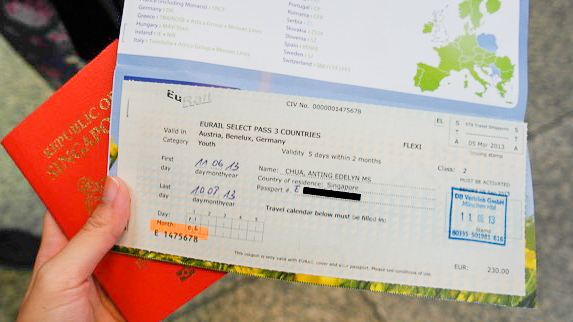
If you are travelling across more than three European countries, get the Eurail Pass as it will be more economical. It also saves you the trouble of buying single trip tickets for each and every leg.
If you are between 12 to 27 years of age, you can get the Eurail Youth Pass — 20% cheaper than regular adult tickets. Above 27 years old but travelling in a group? There’s a Saver Pass for people travelling in a group of 2-5pax — you save 15% on adult prices.
Prices : Youth Pass (7 Days in 1 Month): €456 (S$695) Adult Saver Pass (7 Days in 1 Month): €484 (S$738) Children under 12 travels for FREE with accompanying adults.
Read also: The Essential Eurail Pass Guide For a Fuss-Free Europe Trip
11) Get a City Pass

Most greater cities within Europe have city passes for tourists, which includes free rides on public transport, free admission to major attractions, and also discounts to certain shops and restaurants.
Prices of city passes range from €9.90 (S$16) to €49 (S$80), and is worth purchasing if you have plans to check-off most attractions in the city you want to visit. Do note that many city passes are valid for 24 to 72 hours only.
12) Skip that city pass
Yeah, I know, it’s like giving myself a slap in the face for advising you otherwise from the previous point. While city passes offer a lot of value and convenience, they are only worth getting if you plan on conquering at least 70-80% of the attractions within the validity period (24/72hours).
Otherwise, buying a single day or single trip ticket on the subway will be cheaper.
13) Walk whenever you can
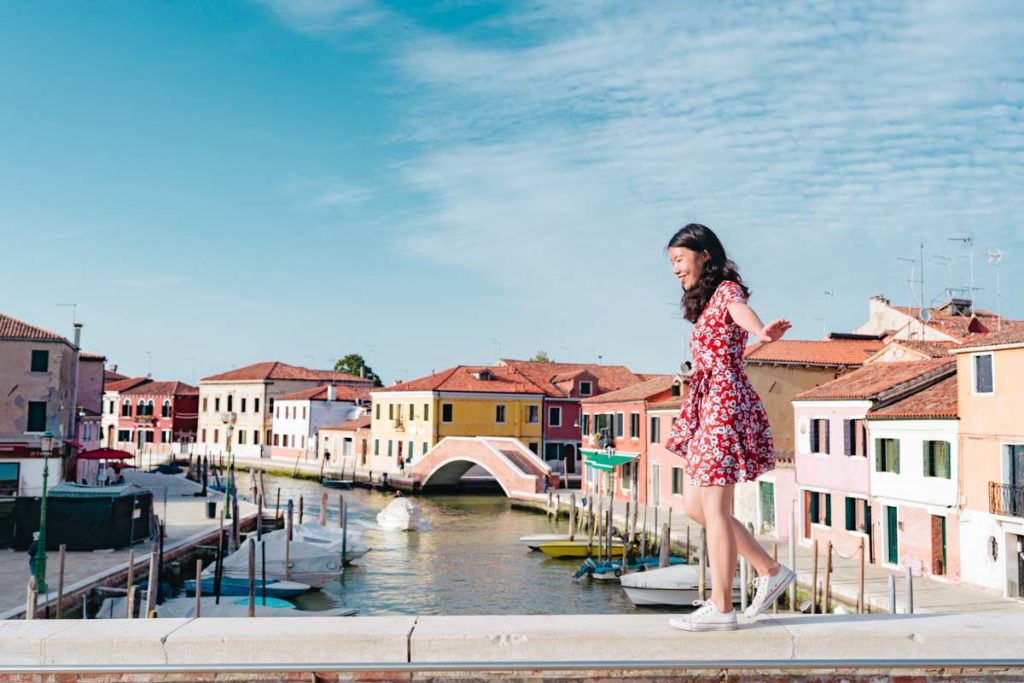
After visiting Europe twice, I have learnt to let my feet bring me wherever I want to go. Cities such as Amsterdam, Munich, Vienna, and Budapest are very walkable. Pathways are very pedestrian-friendly, and some subway stations are so near to each other you’d reach faster if you walked.
Total Transportation expenses: Eurail Pass: €456 (S$694) Avg. cost of a City Pass: €29 (S$44)
14) Sign up for free walking tours
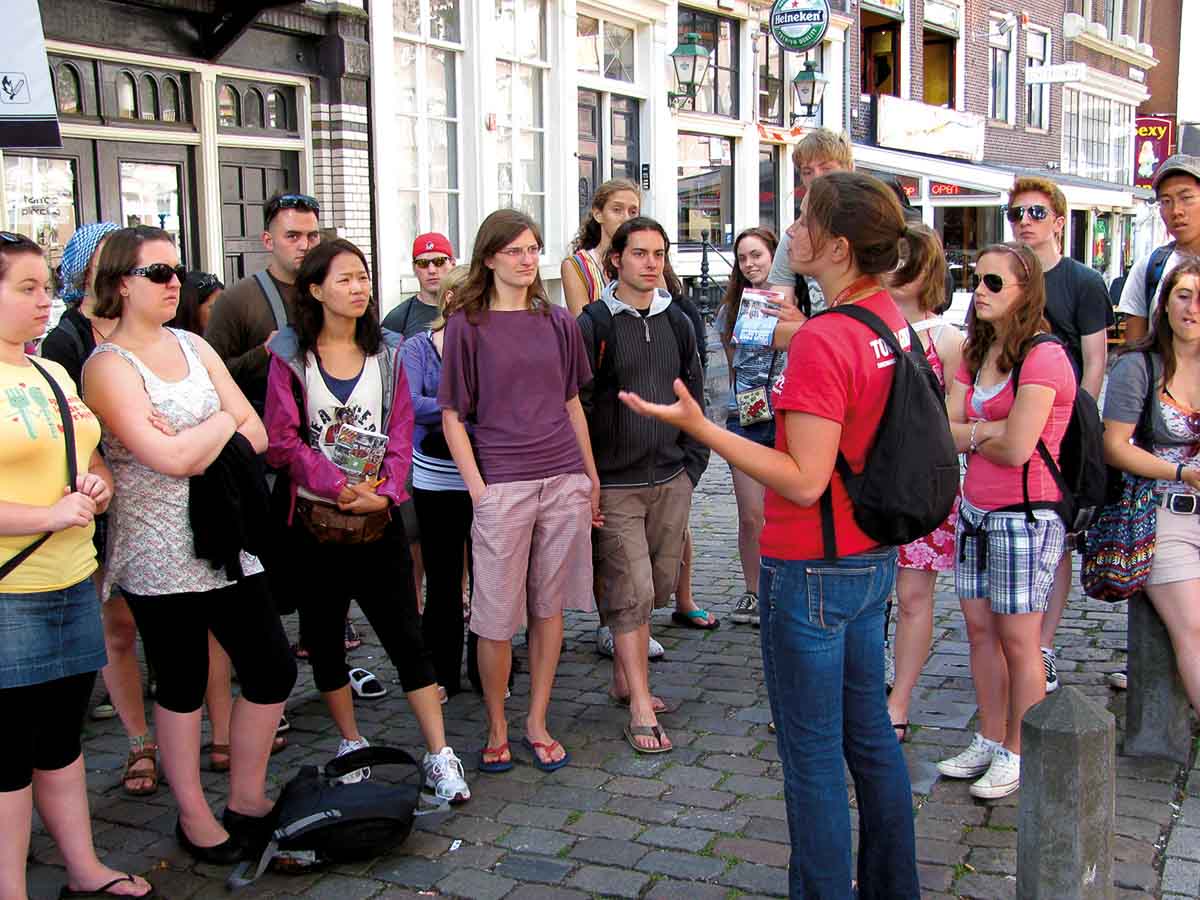
Paid guides and tours are often unnecessary money spent as information and historical facts can be easily obtained from the Internet. Instead, when in Europe, sign up for the FREE walking tours.
Simply register and sign up for a walking tour — while will bring you around some notable landmarks and attractions. SANDEMANS is a pretty popular choice.
Price: Free, but a tip of €5-10 (S$7-15) is quite common
15) Visit museums on free admission days
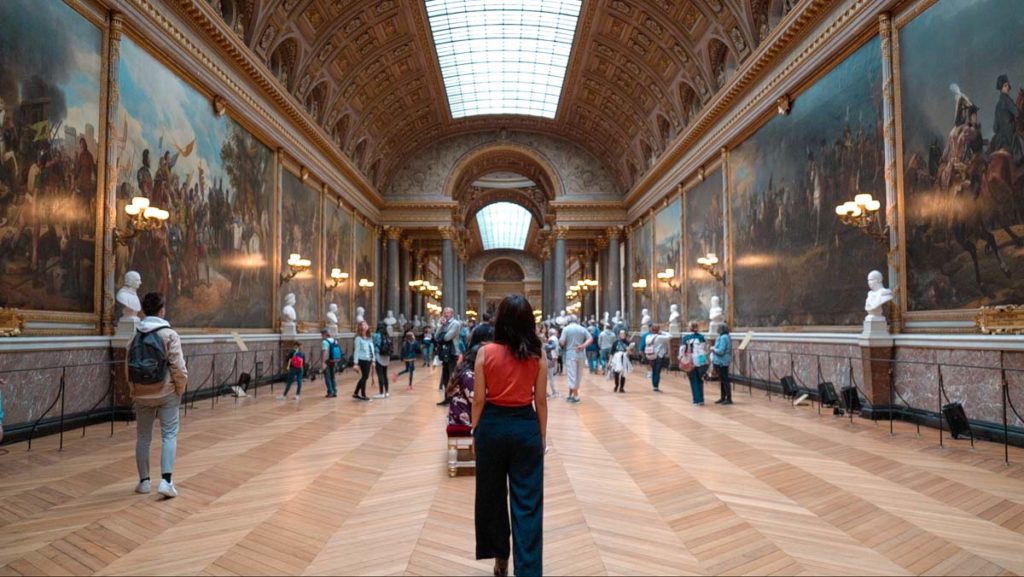
Some museums have free admission during certain time periods. In Paris, admission to the Louvre museum is free for those under 26 every Friday from 6pm — applies to all nationalities as long as you present a valid ID.
Musée Rodin, Musée Picasso, and Musée d’Orsay open their doors to the public for free on the first Sunday of every month.
But of course, do be prepared to squeeze with the crowds on free admission days.
16) Go for free (or ridiculously cheap) music events
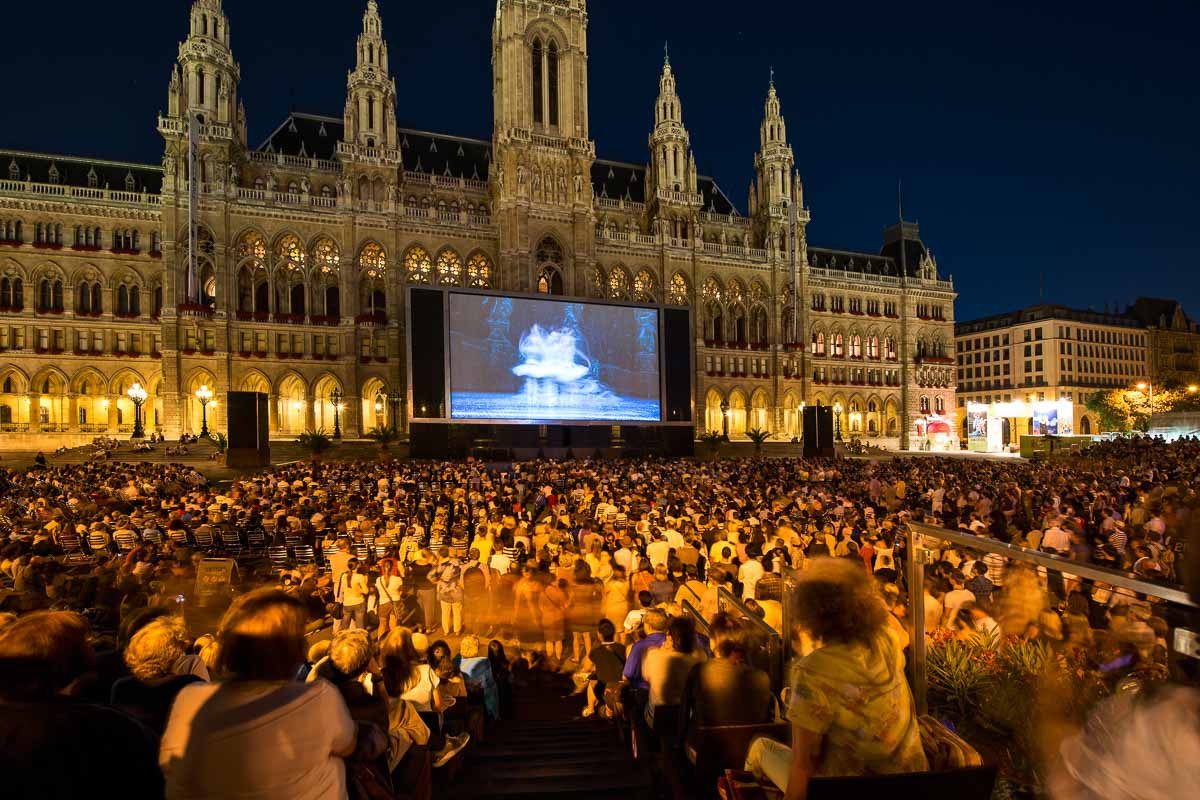
Free open-air concerts and music festivals are quite common in Europe. If you don’t mind standing, you can find standing pit tickets for musicals for a fraction of the original price. In Vienna, there were standing tickets for under €5.
*Pro-tip: Start queuing 2 hours earlier to get cheap standing tickets.
More information: Italy – Amsterdam – Paris – Salzburg – Vienna – Munich
17) Picnic at local parks
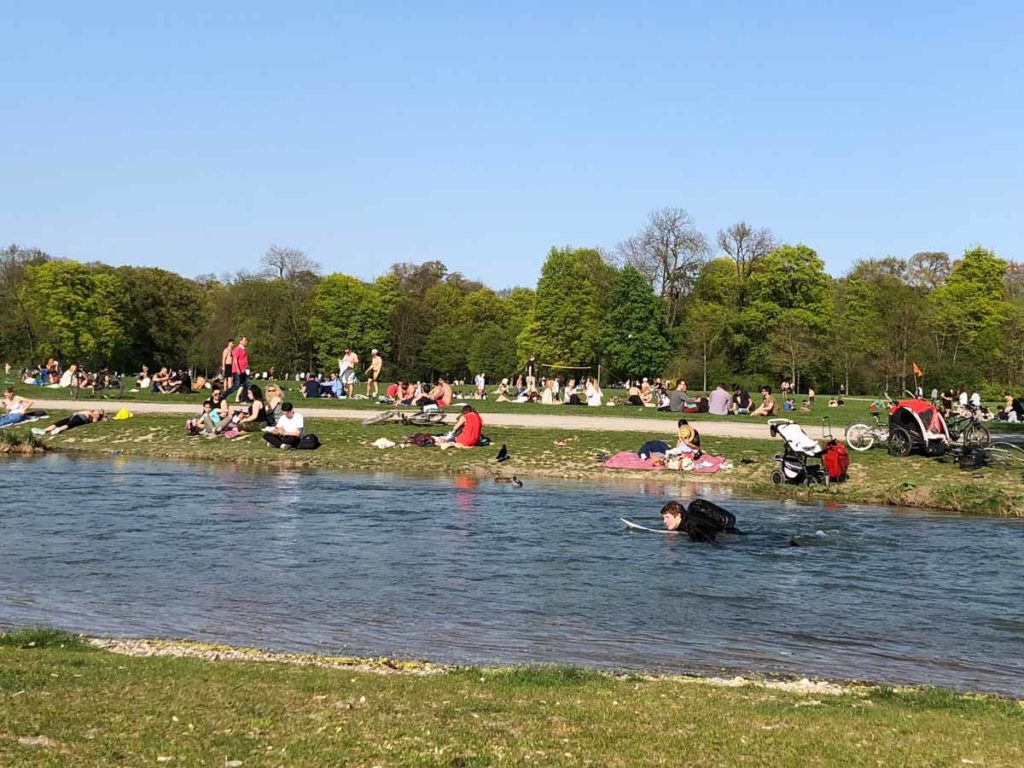
People-watching from an al fresco Parisian café, sipping on a café au lait is almost a mandatory experience in Paris. But that can also be expensive.
A cheaper alternative to people-watching is from the comfort of a sprawled out mat on top of freshly cut grass. Pack some sandwiches and head to a local park — it’ll cost close to nothing!
Some beautiful parks to spending an entire afternoon just watching the world go by: English Garden in Munich, Hyde Park in London, Stadtpark in Vienna, Champ de Mars in Paris.
18) Buy postcards instead of souvenirs

Unless your friend or family member is a collector of tacky souvenirs from around the world, chances are, they would much prefer a handwritten postcard. Not only are they more meaningful than magnets and key chains, postcards cost less and won’t take up much luggage space.
I once wrote a birthday postcard to my best friend en route Grindelwald to Jungfrau, Switzerland. Turns out she only received it four months after her birthday. Well, it’s better late than never! I’m sure that was the best birthday present she received that year 🙂
With this list of Europe budget tips, we hope to have piqued your interest in fulfilling your European adventures soon! If you are looking for more inspiration on touring Europe on a budget, check out these budget guides too!
2-Month Europe Itinerary: 10 Countries Under S$5K with the Eurail Pass 10-Day Switzerland Itinerary: 6 Cities Under S$2.3k with the Swiss Travel Pass 10-Day France Itinerary: Paris And Beyond Under S$1.5k 7-Day Summer Norway Itinerary: Under S$2.5k Incld. Round Trip Flights From Singapore 9-Day Greece Itinerary : Under S$1.5k incl. flights & accom — Athens, Santorini, Meteora
Itching for a getaway? Book your flights, accommodation and activity packages with UOBtravel.com

UOBTravel’s newly revamped site allows you to search and book your flights, accommodation and travel packages — which is great for UOB card members because you can now pay for your travel essentials in UNI$!
On top of offsetting your flight with UNI$, every redemption of UNI$3,088, earns you an extra $50 off your flight!
Earn up to five miles (UNI$2.50) for every S$1 spent on selected travel packages . Once you’ve clocked up enough UNI$, spend them on entire holidays like an epic 8-day trip to Turkey or a relaxing 2D1N spa getaway to Batam .
In celebration of UOBTravel’s 45th birthday, the first 45 flight and accommodation bookings on UOBTravel will receive $20 GRAB e-vouchers and $20 off your second night stay (respectively).
Don’t have a UOB Card? Sign up now at http://www.uob.com.sg/credit-cards/all-cards.html
This post was brought to you by UOB Travel .
RELATED ARTICLES MORE FROM AUTHOR

Madeira Travel Guide — What to Eat, See, Do in The Most Beautiful Place on Earth

5 Europe Itineraries to Check Off While You’re Young — Perfect for First-Time Solo Travellers

Nørrebro: Denmark’s Coolest District with an Unfortunate Bad Rep — Cultures Explained

10 Smart Money-saving Tips to Combat High Travel Costs in 2022

10-Day Switzerland Itinerary — 6 Cities Under S$2.3k with the Swiss Travel Pass

5 Epic Getaways From Singapore with Flights Under S$500
14 comments.
Hey Thanks for sharing such an budget friendly tips. Especially not to travel in peak seasons . And taking overnight trains seems awesome idea’s .
this is great! anything on a multi-trip tour? i’ve looked at a few but they’re all super expensive
Hi Casey! Tours will generally be expensive because they do the planning and coordination for you. We travelled free and easy to keep the costs low!
Well, I just stumbled across this blog while surfing about traveling. Being a travel blogger I know traveling is fun but expensive too. Thank you so much for your tips it will help all the users. Great!
I guess I traveled too much frugally… completed 3 months in 676$. Ye Even I can’t believe it. Though the flight rates cost much to me as I live far away.
Wow that’s amazing! What tips do you have to share?
Could you email me? I plan to go soon and I would love to hear your tips…
rail pass is not cheap at all, and u need to pay booking fees on some rail.. not recommand
Hi Ken, While I do agree that rail passes can be expensive, they are undeniably cost-effective. Also, having a rail pass in hand makes boarding trains convenient, especially for first-timers in Europe 🙂
We recently explored Europe via rail on three separate trips, and we do hope to inspire more people to discover the beauty of Europe. – UK By Rail: 10D Scotland, Wales And London Itinerary Under S$1,400 – 10-Day France Itinerary under S$1.5k — Paris and Beyond by Rail – https://thetravelintern.com/europe-budget-itinerary-eurail-pass/
Cheers! 🙂 -Edelyn
Very helpful. Specially youth hostels to stay in is a great tip.
1527 euro = 1699 us dollars
Hey, you’re absolutely right! Though the converted prices shown in this article are in Singapore dollars . Hope you’ve found these budget tips useful! 🙂
Really sensible, doable and moolah-saving tips. Great going. Thanks for that.
Other options: 1. Avoid buying water and opt for free drinking water from safe sources 2. Try to join a compatible group to rent a car to share car-rental costs. Risky at times… 3. Try to budget and make fewer ATM cash withdrawals to avoid various charges. But tis means keeping/carrying more cash 4. Carry a sleeping bag and rough it out whenever possible 5. Many restaurants, bakeries, supermarkets etc sell food at discounted rates late in the evening…
LEAVE A REPLY Cancel reply
Save my name, email, and website in this browser for the next time I comment.

11 Unique Things to Do in South Australia — Quirky Wineries,...

7 Boutique Hotels in Singapore For an “Out of the Country”...

How to Pay in China Without WeChat or Alipay — New...

11 Things to do in Clark, Philippines — A Quiet Adventure...

20 Things to Eat-See-Do in Sabah’s Capital Besides Climbing Mount Kinabalu

- Terms Of Use
- Privacy Policy

- Meet the Team
- Work With Us
- Itineraries
- Italy Travel Guide
- Hawaii Travel Guide
- Travel Tips
How to Plan a Trip to Europe (2-Week Europe Itinerary)
If you’ve been wanting to visit Europe for a while, you’re probably super excited to begin planning your trip and building your Europe itinerary. In this post, we’re going to show you how to plan a trip to Europe that you’ll never forget!
We know from experience that planning a trip to Europe can be quite overwhelming because there are so many places to go and things to see. You want to make sure you add everything possible to your Europe itinerary. Believe me, we understand how important travel planning is!

We’ve been traveling around Europe for more than 10 years. We now spend at least 2 weekends per month traveling in Europe. That’s why we’ve prepared this Europe trip planner for you.
If you have at least 10 days to spend in Europe, this itinerary will cover all the top spots you must see. Do keep in mind that traveling in Europe can be expensive. You also have to be very wise in your planning to make everything fit together perfectly.
You can fly between cities cheaply if you plan it right. Or you can plan to travel with the Eurail Pass, though this option will take longer.
Let’s get your dream European vacation started. Here’s how to plan a trip to Europe, and see as much as humanly possible in 10-14 days.
Quick. Check these necessities off your prep list!
- Travel insurance : Travelex has reliable coverage at a reasonable price. You can search for the insurance you need on their website, and filing a claim is easy.
- The right luggage can make or break your trip. These hard-sided suitcases come in all different sizes, with spinner wheels and TSA-approved lock.
- Renting a car? Discover Cars helps you search and compare offers from all the top companies. Don’t forget to check if you need an International Drivers License.
Table of Contents
Where to Go in Europe
Europe is full of history, bustling cities, incredible sights, unique places to stay , and – my favorite – amazing food! There are a good number of tourist destinations that just about anyone planning a trip to Europe would want to include in the itinerary.
But, obviously, with just 10-14 days in Europe, there’s no way you can cover them all. We’ve chosen the top destinations that we feel you can fit comfortably into 10+ days.
Planning for Europe? Here’s more…
- How to Plan a 2-Week Trip to Europe
Ultimate Summer Europe Packing Guide
- 11 Charming Small Towns & Cities in Europe

Here are the top destinations we recommend visiting in 10+ days in Western Europe: London (I’m still considering this Europe even if it’s no longer in the EU), Paris , Venice , Rome , Berlin , and Amsterdam .
We love all of these cities for different reasons as you’ll see below, but if you can’t fit them all in, you might need to decide between them. For instance, if you’re wondering if should I visit Paris or Rome , consider aspects like cost, activities, and your own personal interest in those activities.
If you have additional time, you could add Munich , Barcelona , Dublin , and/or Edinburgh . We also suggest checking out some of the more charming and small towns in Europe . Or maybe you’re into history – there are so many great medieval towns to visit .
You might want to take a look at this post with 50 of the best street food destinations in Europe before you decide where to go. There are quite a few that would persuade me.
How to Spend 2 Weeks in Western Europe
There are really two perfectly acceptable ways to take a vacation in Europe. Either way can be quite rewarding, but it depends greatly on your travel style how much time you want to put into planning, and what trips you are looking to book for.
Option 1: Book a pre-planned guided tour
A guided tour is the easiest option, by far. While Europe is very easy to get around for travelers, it can be difficult to figure out how to get from place to place, and very tedious trying to decide what to do in each location.
A pre-planned tour won’t give you the same freedom to do what you want, but it is completely planned out for you and you will always have a guide along to help you with anything you need.
Option 2: Plan your own trip
Planning your own self-guided tour of Europe gives you ultimate freedom to choose what you want to do and when. You can go to the places you want, without a group to tag along with.
The drawbacks are that you have to plan it all out yourself, which can be daunting. Check out these additional Europe travel tips to help with your planning.
We will give you the options for both below, including a pre-planned tour we highly recommend and a 14-day self-guided itinerary to follow.
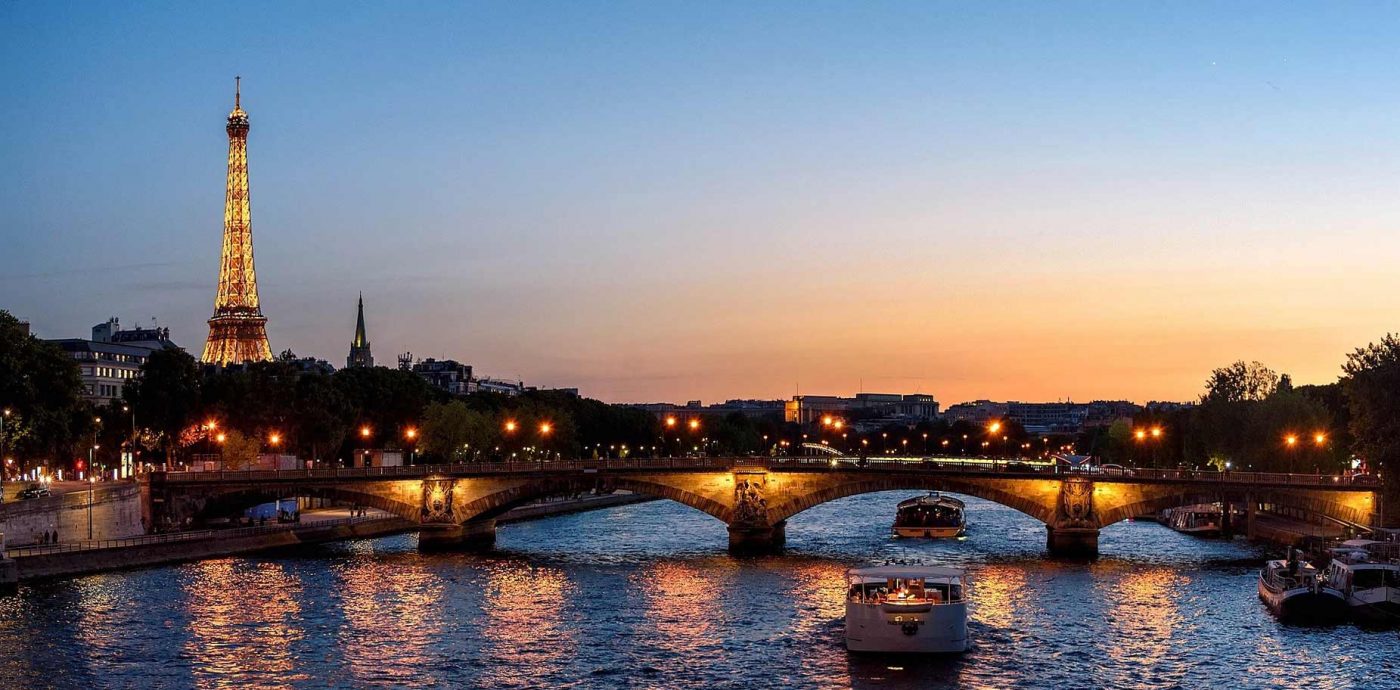
Guided Tour of Europe
If you want to try a guided tour, I recommend a Classic Europe 14-day tour.
This tour is run by Expat Explore Travel and includes everything except International airfare, extra excursions that aren’t in the tour itinerary, and personal incidentals.
» See more information about the Classic Europe tour .
The 14-day itinerary includes:
- Start in Amsterdam
- Drive through Brussels for a quick stop en route to Paris
- Visit Burgundy and the breath-taking Swiss Alps
- In Italy , see Pisa, Tuscany, Florence, Rome, and Venice
- Travel into Munich and Bavaria in Germany , then to Nuremberg and Berlin
- Head back to Amsterdam
There are other Europe tour options with varying destinations. Check out the website to see all options with this tour operator .
Self-Guided Tour of Europe – Plan Your Own Travel Itinerary
With a good plan of action, your 2-week Europe trip will run smoothly and provide you with a comprehensive overview including some of the main countries in Western Europe.
If this schedule seems too ambitious for just a 10 day Europe trip, you can always extend your stay in the cities that interest you most and decide not to visit others.
There’s no right or wrong way to do it. It’s entirely up to you.
Day 1-2: London
Arrive in London . Take the Heathrow Express from the airport to your hotel.
You’ll want to stay in West London for easy access to all the top sights. London is very walkable. To get around to all the sights in a day or two, you’ll want to get your walking shoes on.
You can take a hop-on-hop-off bus tour if you’re not up for the walking. For foodies, we highly recommend spending some time doing any of these fun foodie activities in London .
The city is one of the best for restaurants in the world. If you want to take a day trip from London, we suggest Stonehenge , Bath , or Windsor . They’re all very close by and offer a fantastic experience.

In London, be sure to see these sights:
(You can purchase tickets in advance for these activities. These links are affiliate links to activities we’ve done and recommend.)
- Tower of London (with the Crown Jewels)
- Tower Bridge Experience
- Shakespeare Globe
- Churchill War Rooms
- Westminster Abbey & Big Ben
- View from the Shard
- Kensington Palace
- Kew Gardens

How to Spend One Day in London

Things to Do in Windsor: A Perfect Day Trip From London

21 Fun Foodie Things to Do in London
Where to Stay in London: We recommend the Trafalgar St James by Hilton . It’s in a historic building in a really prime location. The hotel and rooms are designed in art deco and the rooms are really spacious and bright. ⇒ Read reviews on Trip Advisor .
Day 3-5: Paris
Travel to Paris on the Eurostar train . The journey takes just 2 hours from St. Pancras Train Station.
Don’t forget to take a picnic lunch and a bottle of wine with you to enjoy on the train. There are so many things to do in Paris . In only two days, you can cover a lot of ground. You can do a few of these great foodie activities , see the top sights on a walking tour, or join this fun gourmet bus tour for a multi-course meal on a double decker tour bus.
You’ll want to either plan on walking a lot, or acquaint yourself with the Paris Metro map and take short trips in between sights. You can also take the Paris hop of hop off bus to get between sights.
Check out our 3-day Paris itinerary that will help you plan what to see.

In Paris, be sure to see these sights:
- Eiffel Tower
- Notre Dame (closed for renovations)
- Seine River Cruise
- Luxembourg Gardens
- Arch d’Triomphe
- The Avenue des Champs-Élysées
- Louvre Museum
- Sacre Coeur & Montmartre

How to Spend One Day in Paris

3-Day Paris Itinerary for First Timers

9 Fun Foodie Things to Do in Paris
Where to Stay in Paris: The best location to stay in Paris is 6th Arrondissement. It is the Latin Quarter. The heart of Paris. And it’s the best location for tourist who are planning to see everything. Here are 8 top hotels with an Eiffel Tower view . We recommend the boutique 4-star Hotel Parc Saint Severin . The rooms are larger than most in Paris and they’re nicely refurbished. Plus it’s a really great location. The metro is really close. ⇒ Read reviews on Trip Advisor.
Day 5-7: Venice
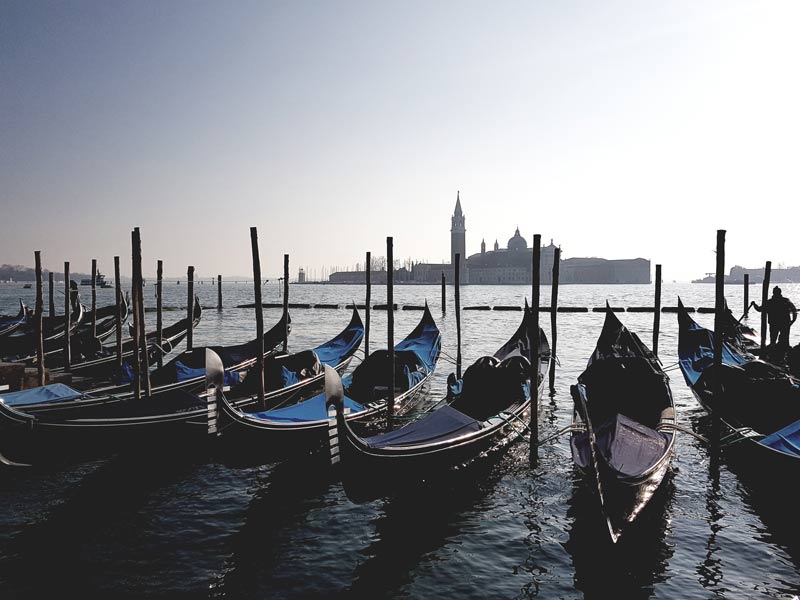
Venice is just one of those places you have to visit at least once in your life. It’s an incredibly enchanting city, with so much character that you feel a little like you’re floating around in a Disney movie.
The views across the Grand Canal are so beautiful, and the narrow alleys can lead you to get lost in a city of charm. Everywhere you turn is another incredible view, and a gondola floating by in the distance. It’s one of a kind.
With so many great things to do in Venice, you really need to set up a good itinerary before you leave, to make sure you fit everything in.
Check out our shortcut guide to all the best parts of Venice, which will help you plan. Definitely make time for a Venice food tour .
The food in Venice is great, if you know where to look. And you can check out our YouTube video for the top 10 things to do in Venice , if you need more ideas.
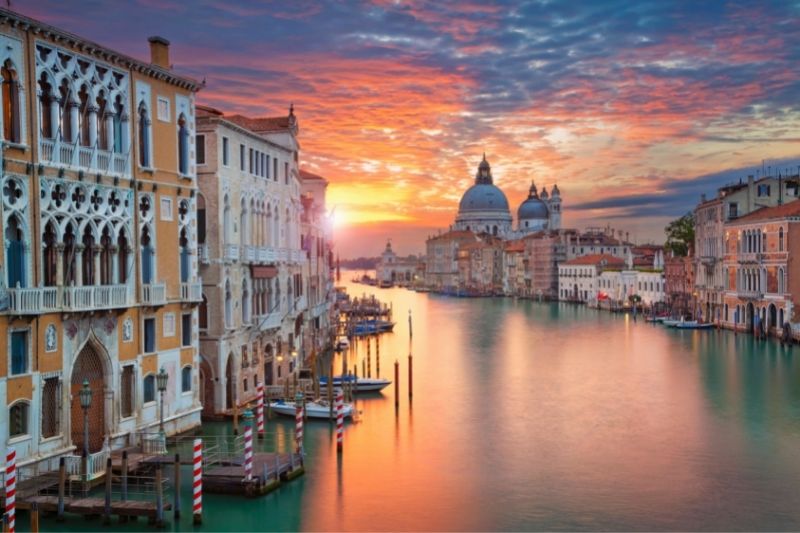
You can pre-book some of the activities. I would definitely pre-book the activities below, so you don’t miss out.
- Venice Gondola Ride and Serenade
- Eat Like a Local: 3-hour Venice Small-Group Food Tasting Walking Tour
- Legendary Venice St. Mark’s Basilica and Doge’s Palace
![Essential Travel Guide to Venice, Italy [Infographic] 7 Venice waterway at sunset](https://www.savoredjourneys.com/wp-content/uploads/2018/01/venice-feature-600x600.jpg)
Essential Travel Guide to Venice, Italy [Infographic]

Top Foods to Try on a Venice Food Tour

Guide to the Best Wine Regions in Italy
Where to Stay in Venice:
Ai Patrizi di Venezia If you’re staying for 3+ nights, I highly recommend this apartment. It’s in the perfect location, is incredibly comfortable and clean, and has a kitchenette. We sometimes prefer an apartment to a hotel so we’re not being bothered by housekeeping. This place is a gem. | Read Reviews or Book a Stay Hotel Londra Palace If you’d rather stay in a hotel because you like the extra amenities, then Hotel Londra Palace is a great choice. It’s in a very good location, only 5 min walk from St. Mark’s Square, with free wifi and a restaurant. Some rooms have a balcony and an incredible view. | Read Reviews or Book a Stay
Day 8-10: Rome

Rome is a city that will capture your heart the moment you arrive. It’s amazing to see so much history packed into one place, and so much of it is scattered right in the middle of a modern city. There’s really no where else like it. Plus the food. You have to go on a food tour and witness it first hand.
If you’re planning a trip, we’ve got you covered with our shortcut travel guide to Rome : an informative and helpful infographic that will give you a quick peek at all the top things you should plan to do in Rome. Here’s our 3-day itinerary to help plan it all out.
Top things to put on your itinerary:
- The Colosseum : This monumental amphitheater is one of the most recognized symbols of Rome, offering a peek into the world of ancient Roman gladiators. Try to book a guided tour to get the full historical context.
- Roman Forum & Palatine Hill : Located near the Colosseum, the Roman Forum was the political, commercial, and judicial center of ancient Rome. The Palatine Hill, according to Roman mythology, is where the city was founded by Romulus.
- Pantheon : This best-preserved monument from the Roman Empire is a marvel of architectural design, with its impressive dome and the oculus at its center.
- Vatican City : Here, you can visit St. Peter’s Basilica, the Vatican Museums, and the Sistine Chapel, with Michelangelo’s renowned frescoes. Be sure to dress modestly as a sign of respect.
- Trevi Fountain : Throw a coin into this iconic fountain to ensure your return to Rome. It’s beautiful during the day, but consider a visit at night when it’s lit up.
- Piazza Navona : This square is home to Bernini’s famous Fontana dei Quattro Fiumi (Fountain of the Four Rivers), as well as various artists, musicians, and street performers.
- Spanish Steps : Climbing these steps from Piazza di Spagna to Piazza Trinità dei Monti offers a wonderful view. The nearby shopping district is a must for fashion enthusiasts.
PRO TIP: Skip the line tickets are necessary in Rome, especially during high season. You won’t waste time waiting in huge lines.
- Eating Europe’s Twilight Trastevere Tour (We loved this tour! Read about it here .)
- Faster Than Skip-the-Line: Vatican, Sistine Chapel and St. Peter’s Basilica Tour (definitely worth it)
- Colosseum and Ancient Rome Small-Group Tour

What To Do in Rome in 3 Days
![Essential Travel Guide to Rome, Italy [+Infographic] 11 Rome Coliseum](https://www.savoredjourneys.com/wp-content/uploads/2019/01/rome-feature-600x600.jpg)
Essential Travel Guide to Rome, Italy [+Infographic]

Eat Like a Local on a Rome Food Tour
Where to Stay in Rome
The best location in Rome depends on what you want to accomplish during your stay, but it’s always best to be centrally located so you can walk to all of the main attractions.
Two great choices in the affordable luxury range are The Inn at the Spanish Steps (with a gorgeous roof-top pool) and Il Palazzetto . We also really enjoyed staying at Nerva Boutique Hotel in the popular Rione i Monti area.
Day 10-12: Berlin
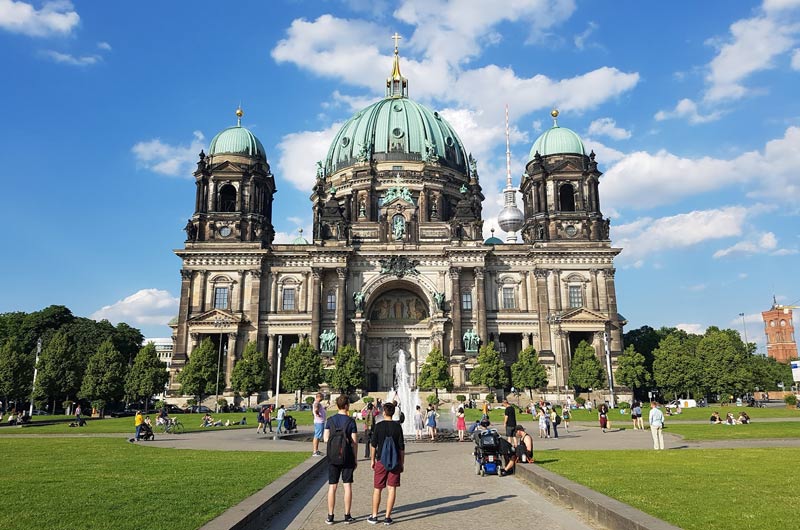
Berlin is a very modern city with a good art scene, many museums, great food options, and cultural/historical things to see and do. It’s a sprawling city so you’ll want to be ready for public transportation.
There are a few Berlin attractions and sights you don’t want to miss like these we’ve listed here:
- Brandenburg Gate : This iconic symbol of Berlin was once a symbol of division during the Cold War, but now stands for German unity and is a must-see.
- Berlin Wall Memorial and Checkpoint Charlie : No visit to Berlin is complete without learning about its Cold War history. The Memorial provides an insightful look into the era of the city’s division.
- Reichstag Building : The seat of the German Parliament, the building’s glass dome offers a panoramic view of the city. It’s a good idea to register in advance for a visit.
- Museum Island : Home to five world-class museums, including the Pergamon Museum and the Neues Museum. The latter houses the bust of Nefertiti, an ancient Egyptian queen.
- Alexanderplatz and TV Tower : A large public square and transport hub in the central Mitte district, featuring the iconic TV Tower (Fernsehturm) which provides excellent views over the city.
- Holocaust Memorial (Memorial to the Murdered Jews of Europe) : A poignant, powerful monument to one of history’s darkest times.
The best way to see all of these sights is on this Discover Berlin half-day walking tour . The tour is really inexpensive and is the best way to learn the historical and cultural past of Germany, while see the top sights.
Foodies will also want to check out Markethalle Neun , an indoor market with international food vendors, especially on Street Food Thursdays! Also plan for a beer tour and a Berlin food tour in order to taste the best parts of the city!
![Essential Travel Guide to Berlin, Germany [Updated 2024] 13 Berlin](https://www.savoredjourneys.com/wp-content/uploads/2019/09/berlin-feature-600x600.jpg)
Essential Travel Guide to Berlin, Germany [Updated 2024]
Berlin is a city that holds a certain mystery, due to its interesting history that forever changed the world. ...
Where to Stay in Berlin
One of my favorite hotels is the Hotel am Steinplatz, Autograph Collection . It’s located right in the center of the city, conveniently located for transportation, so you can easily get around to the top sights. There’s a bar, restaurant, and really comfortable rooms. ⇒ Read reviews on Trip Advisor .
Day 12-14: Amsterdam
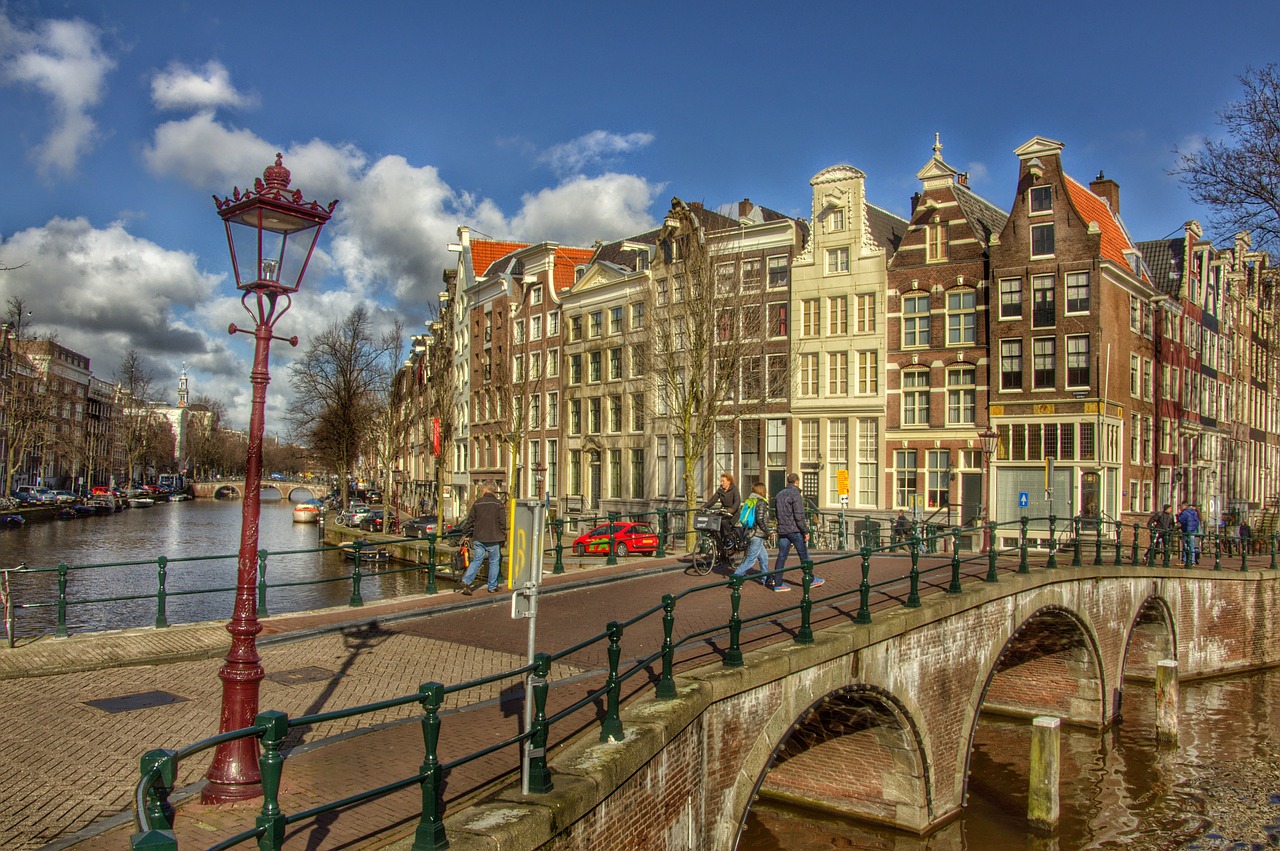
As a tourist, you’ll likely find Amsterdam to be a very welcoming and fun place to explore. The canals and old cobblestone streets make it the quintessential European city, and it’s just so easy to get around. Read our full guide to 3-days in Amsterdam for the full rundown.
The many activities in Amsterdam include history, art and food. I think a good plan to tackle the city includes a bit of walking tour, interspersed with stops to try the local food and drinks.
Be sure to try bitterballen, poffertjes, and frites (which you can get with dozens of different sauces), along with all the cheese. There are dozens of different canal cruises you can take that are often paired with cheese, beer, wine or even pizza.
For drinks, we recommend stopping at some of the beer bars , like Proeflokaal Arendsnest and Beer Temple, as well as the top cocktail bars like Tales & Spirits and Flying Dutchman. And don’t forget to sample the genever at Proeflokaal ‘t Kelkje, one of the best places in Amsterdam to taste genever!
Here are a few links to our favorite tours and activities in Amsterdam so you can purchase your tickets in advance:
- Amsterdam Canal Cruise in Classic River Boat
- Skip-the-line Rijksmuseum & Van Gogh Museum Guided Combo Tour – Private Tour
Eat like a local in Amsterdam with Eating Europe Food Tours – there are 5 tours available:
- Jordaan Food Tour
- Jordaan Food & Canals Tour
- Amsterdam at Twilight Food Tour
- Food Tour in Haarlem
- A Taste of Life in Haarlem
![Essential Travel Guide to Amsterdam [Updated for 2024] 15 Amsterdam waterway and buildings](https://www.savoredjourneys.com/wp-content/uploads/2015/06/amsterdam-feature-600x600.jpg)
Essential Travel Guide to Amsterdam [Updated for 2024]

Where to Find the Best Beer in Amsterdam
Where to stay in Amsterdam
We like staying near Dam Square in central Amsterdam. It’s fun and lively, close to or within easy walking distance of many of the top attractions, and easily accessible for public transportation.
Radisson Blu – This is a nicely-decorated 4-star hotel located directly on a canal near Rembrandt Square. Great place to stay. Read Reviews on Trip Advisor
Tips for Planning a Trip to Europe
Best time to go to europe.
When you decide to go to Europe should be based on what type of experience you want to have. A lot of people make it a priority to go to Europe in the summer because that’s when they take vacation, or when the kids are out of school.
However, everyone else is doing the same thing. That means July-August is high season and there are a lot of visitors. Attractions are packed, lines are long, prices are high, and it can be really hot outside.
The best weather in Europe can be found from late March to early June and from late September to early December. This is considered the shoulder season in Europe and there will be less people and lower prices.
We prefer to travel during these times because it’s just so much easier. And the nicer weather makes all the difference.
We especially caution against traveling in Italy in August. It is one of the hottest months and the weather can be a real hindrance to your happiness.

Getting to Europe
Many top airlines from around the world have direct flights into London. It’s probably one of the easiest cities to get into.
Check Skyscanner for great deals on airfare. We prefer to fly into London for the ease of it all, but you can skip London and fly directly into Paris, if you wish.
Also keep in mind that airfare is lower on the shoulder and off season than it is during the summer. (See this article for more on how to find great airfare ).
We also recommend flying into one city and out of another, so you don’t waste some of your holiday time flying back to the starting point. Using the multi-city option on Skyscanner , you should be able to find this option without the fares getting to high.
Getting Around Europe
When planning your Europe itinerary, keep in mind the distance between each destination. Europe seems small, but it takes a while to get between destinations. In most cases, you’ll need at least a half day to get between locations, more if taking the train.
Once you arrive in Europe, you can either fly or take the train between cities. We prefer to take early morning or late night flights, to avoid burning active hours in our destination.
Flying is relatively cheap on budget airlines like Ryanair and EasyJet . We fly with them all the time.
There are fees for any extras you add, and checking luggage can be expensive, so do be mindful of that.
See here for an idea of what it costs and the flight times for each of the legs in our itinerary:
- London to Paris: $50
- Paris to Venice: $85
- Venice to Rome: $70
- Rome to Berlin: $95
- Berlin to Amsterdam: $70

Via Train – Eurail Pass
Another way to travel around Europe in by train. You can purchase individual train tickets for each journey you wish to take. That will help you mix and match, if you want to fly between some cities and take the train between others.
However, a more economical way to go by train is with a Eurail Pass. The price of the Eurail Pass varies depending on your needs. They range from $250 to over $1000. For the itinerary we laid out in this post, you would need a 5 days within 1 month pass, which costs $326 (updated 2019).
This allows you to travel on any 5 days over a period of a month. There’s also a 7 days in one month pass for $388, if you think you’d like to tack on another destination. These passes entitle you to travel on specific trains only.
You can’t just show up and get on any train, but you don’t need reservations except for the high-speed and overnight trains (which also require an extra fee). They’re only for non-European travelers. And they can only be used for the class of service booked.
Travel Documents – Schengen Area
Always verify the entry requirements and travel documents needed for each specific country you are trip planning for as requirements can vary. You can check with the embassies or consulates of the countries you’ll be visiting or use official government travel websites for the most accurate and current information.
Ensure that your passport is valid for at least six months beyond your planned return date. Some countries may have different requirements, so it’s always a good idea to check the specific entry requirements for the countries you plan to visit.
Depending on your nationality and the specific European countries you plan to visit, you may or may not need a visa. Citizens of the United States can generally enter the Schengen Area (a group of 26 European countries that have abolished passport control at their mutual borders) for short stays of up to 90 days within a 180-day period without a visa. However, if you plan to stay longer or visit countries outside the Schengen Area, you may need additional visas.
Tipping in Europe
Yes, you do need to tip in Europe. However, it’s not at the custom level of the U.S. There are some key differences.
First of all, 10% is the norm for tipping in a nice restaurant. You can give more if you had a stellar experience, but that’s more like 12%. Not 20%. In a cafe or deli, just round up your bill to the nearest dollar. If it was €3.80, leave the .20 cents as a tip.
In pubs in London and bars in Europe, tipping isn’t expected on small amounts.
Whatever you do, always check the bill for a service charge. There are MANY places throughout Europe now that charge a set service fee and include it in the bill. This is often 10 or 12%. If this fee has been added to your bill, there is no need to tip.
Eating in Europe

Since you’ll be visiting many different countries while in Europe, the food will be very diverse. You will have the best overall experience if you’re willing to try all the foods you come across and have an open mind that you mind really like something you’ve never tried before.
- In London, you should have a Sunday roast , Fish and Chips , a Steak & Ale pie . See our foodie guide to London for more.
- In Paris, are you daring enough to try frog’s legs or escargot ? Definitely make room for crepes and a Croque Monsieur . See our foodie guide to Paris for more.
- In Italy, you’ll find an unimaginable array of pasta dishes , pizza, dried meats, and cheeses. Berlin has a very international food scene. It’s not just Schnitzel and sausage anymore.
- And in Amsterdam, you must try the frites , the bitterballen and the Poffertjes (pancakes).
In every city, there is now a food tour taking place. We always recommend going on a food tour first thing when you arrive because it gives you a very good overview of the foods you should look out for and where to find them.
Frequently Asked Questions
Is $5000 enough for a trip to europe.
With careful planning and budgeting, $5000 can allow you to have an enjoyable and fulfilling trip to Europe. However, the amount of money you need for a trip to Europe can vary widely depending on several factors, including the duration of your trip, the countries you plan to visit, your travel style, and the activities you want to experience.
How early should I plan my Europe trip?
Starting to plan your Europe trip 6 months in advance is a good timeframe, especially if your trip involves multiple destinations, is during the peak season, or requires visas. This allows you to also get your accommodation booked in advance. However, if your trip is relatively simple and during the off-peak season, you might be able to start planning 3 months before your travel dates.
What’s the best time to visit Italy?
Italy is a year-round destination, but many people prefer the spring (April to June) and fall (September to October) when the weather is pleasant, and tourist crowds in Italy are generally smaller at this time of year.
YOU MIGHT ALSO LIKE

21 Most Charming Small Towns & Cities in Europe
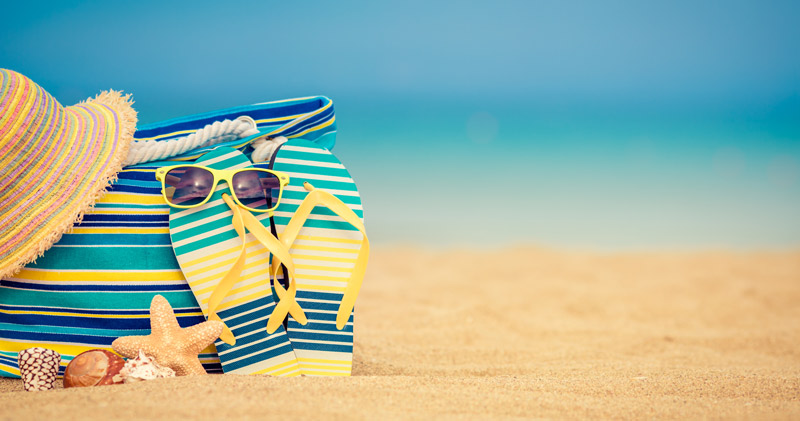
8 Unique Places to Stay in Europe & UK

21 Best Places to Spend Christmas in Europe
Now you know how to plan a trip to Europe, and we’ve given you a 2-week itinerary to follow. What are you waiting for? Whether you take a guided tour or do this Europe 2-week itinerary on your own, I am certain you will find it to be the most exciting and rewarding trip you’ll ever take.
Europe is fascinating and full of surprises. Let us know how your trip to Europe turns out!
Be Prepared For Travel Planning is the most important part of any successful trip. Do it the easy way:
🧳 Travel Packing List | ✔️ Why You Need Travel Insurance | ✈️ What to Do Before You Leave Home
- Find and book the best hotel (our favorite booking site is Expedia)
- Research flight options (our favorite tool is Skyscanner )
- Book a tour (we always use Viator to find the best tours)
- Rent a car through Discover Cars (they search the best deals for you!)
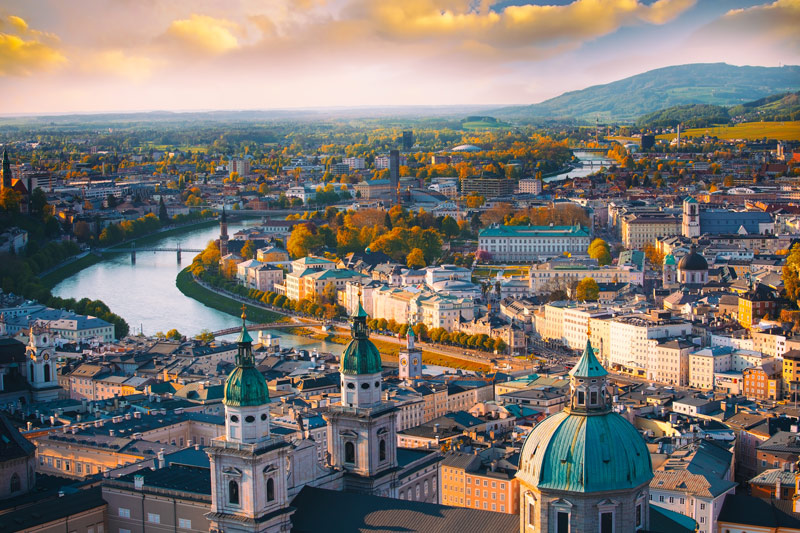
21 of the Best Cities to Visit in Europe

18 Best Wine Regions in Europe for Wine Lovers
Like this post? Why not save it to your Pinterest board ?

Laura Lynch, creator and writer of Savored Journeys, is an avid world traveler, certified wine expert, and international food specialist. She has written about travel and food for over 20 years and has visited over 75 countries. Her work has been published in numerous guidebooks, websites, and magazines.
15 thoughts on “ How to Plan a Trip to Europe (2-Week Europe Itinerary) ”
A great two-week itinerary for those looking to see the capital cities of Europe Laura – and totally agree with the London food choices! We are heading to the UK early next month and the Sunday roast and fish and chips ( with curry sauce) are high on our agenda;) Also an afternoon tea with clotted cream! 🙂 Thanks for sharing this thorough article. Shelley x
I always love a good cream tea!
I am planning on visiting Europe – more like a backpacking trip. And believe, I probably have read all the possible articles about “How to Self Organize Europe Trip” and this is the first article which covered everything I needed to know in a simple and minimal way. I couldn’t thank you enough, Laura. Really helpful!!!!!
Glad you found it useful, Sneha. Enjoy your trip.
This is awesome, thank you ❤️
Thank you for ALL of this great information. I’m in the beginning stages of planning a vacation for my family of 6. We will fly out of JFK – probably late June 2023 and we would like to visit: London, Paris, Venice, (Rome maybe) and Barcelona. Does the order of countries make sense? And know we would do train from Paris to Venice – but what would you suggest for the rest of the trip as far as traveling between countries? Thank you!
Hi Jill. That trip route sounds good. You can actually do all trains, if you don’t mind overnight travel, to save time. I would likely take the Eurostar from London to Paris, fly to Venice, train to Rome, and flight to Barcelona. You can easily get low-cost airline flights between all of those places.
Hi Laura, do you know whether the flight from Paris to Venice would be very busy? We definitely want to hit up London, Amsterdam, Paris and Italy (Venice/Florence/Rome) but felt that 14 days was ambitious for us. We also were hoping to avoid flights as much as possible due to the mass flying and worry it might take forever at the airport during August/September.
Hi Linda. The flight from Paris to Venice is likely always full, but it’s not a bad experience. We fly these routes all the time. You could also take the train! If you want to take a slower journey and actually cover it well, I would recommend 3 weeks for that trip. It is quite ambitious to do it in 2 weeks, but most people don’t have that much vacation time.
Hi and thank you so much for sharing all of this information! I am planning a summer trip for next year and am just researching to get a jump start on things and saving up!
I have a question…is there a way to add in the Almafi coast in this itinerary easily? What would you suggest as far as when you would add that? Before or after Venice…etc. and how many days would you recommend there? I was planning to do a boat day there.
Hi Cassandra. We were just in the Amalfi coast! You’ll love it. If you have time, I would suggest doing this itinerary the opposite way – starting in London and ending in Naples. Then you can visit the Amalfi coast and travel home from Naples.
Thanks so much for the in-depth wonderful article you turned out here .God Bless You
Hi there! This is really helpful!! I’m just confused, and trying to follow the map you post at the top. Just underneath your header “Self-Guided Tour of Europe – Plan Your Own Travel Itinerary”, there’s a map with a travel route posted. But that map does not match up with the route that is detailed below. The map appears to start in London and go to Paris, and them double-back to Amsterdam. But in the written itinerary, you talk about going from Paris to Venice, but this is not shown as the route on the map, and there’s no mention of how to get from Paris to Venice. Just trying to figure out if I follow what’s posted on the map, or what is outline in the written itinerary?? THANK YOU!!!
Hi Sherry. It looks like Amsterdam just got inserted in the wrong place on the map. I’ve updated it to be last instead of 3rd. Although if you wanted to fly into London and out of Rome, you could still put Amsterdam 3rd in the itinerary.
Leave a Reply Cancel reply
Your email address will not be published. Required fields are marked *
Save my name, email, and website in this browser for the next time I comment.
- Travel Resources

How to Plan an Epic 2 Week Europe Trip (+ Europe Itinerary Ideas!)
Ready to plan a 2 week Europe trip but not quite sure where to start?
We want to help!
Whether it’s your first trip to Europe or your tenth, there’s something simultaneously overwhelming and exhilarating about planning a trip through multiple countries that–for us and most of the readers of this blog post–lie across an ocean from home.
I’ll never forget planning our first 2 week Europe itinerary: I pored over flight schedules, bucket lists, budgets, and maps for months, desperate to pull together the ultimate Europe trip.
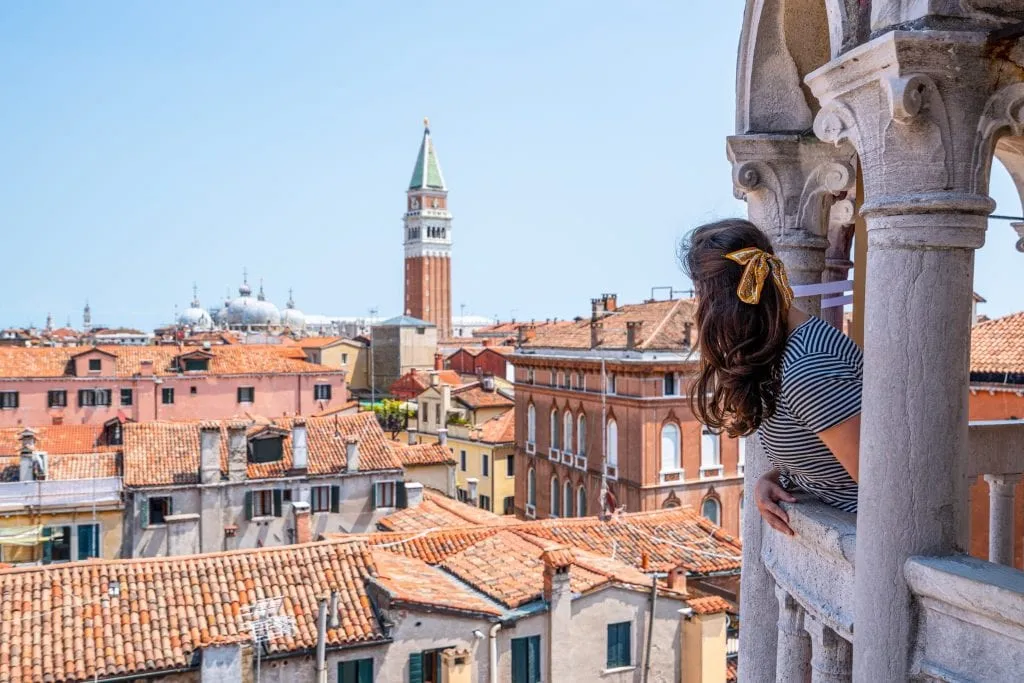
Some links in this post may be affiliate links. If you make a purchase through one of these links, we may earn a small commission at no extra cost to you. Please see our disclosure policy for more detail.
There were many, many lists involved in planning that first trip, and after months of planning, I emerged with an eclectic but incredible itinerary that kicked our love of travel into high gear.
In the summer of 2015, Jeremy and I spent a little over 2 weeks in Europe exploring Krakow , Budapest , Plitvice Lakes National Park , Zadar , Dublin , and the Cliffs of Moher (I told you it was eclectic!).
We’ve now cumulatively spent years of our lives traveling in Europe, falling in love with world-famous cities and less iconic locations alike, and there’s absolutely nothing we like better than helping people plan their own unforgettable adventures.
Over the years, we’ve explored the continent in almost every way possible, from backpacking Europe on a budget for 2 weeks to checking into luxury hotels to playing tour guide for family and friends to finally spending more than a year living in Lisbon, Portugal !
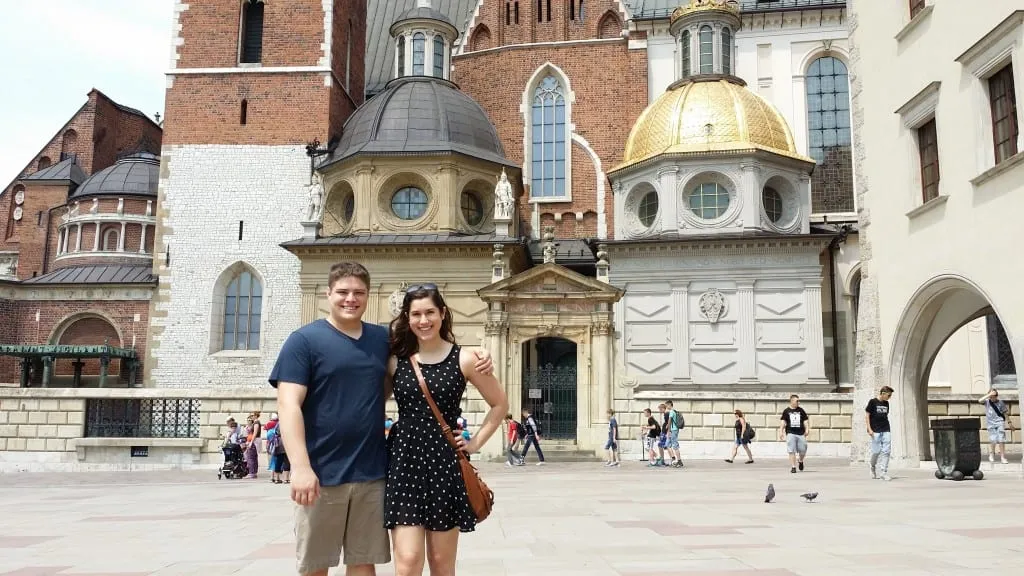
We’ve put together this 2 week Europe itinerary guide to help you plan your trip–here’s what you need to know before you go.
(Also, yes–this is an incredibly long blog post! We recommend using the table of contents right below this paragraph to help you navigate to different sections depending on what you’re hoping to read first.)
Table of Contents
How to Use This 2 Week Europe Trip Guide
Exciting 2 week europe itinerary ideas, how to get around during 2 weeks in europe, important tips for planning a 2 week europe trip, faq for spending 2 weeks in europe, what to pack for 2 weeks in europe, read more about visiting europe.
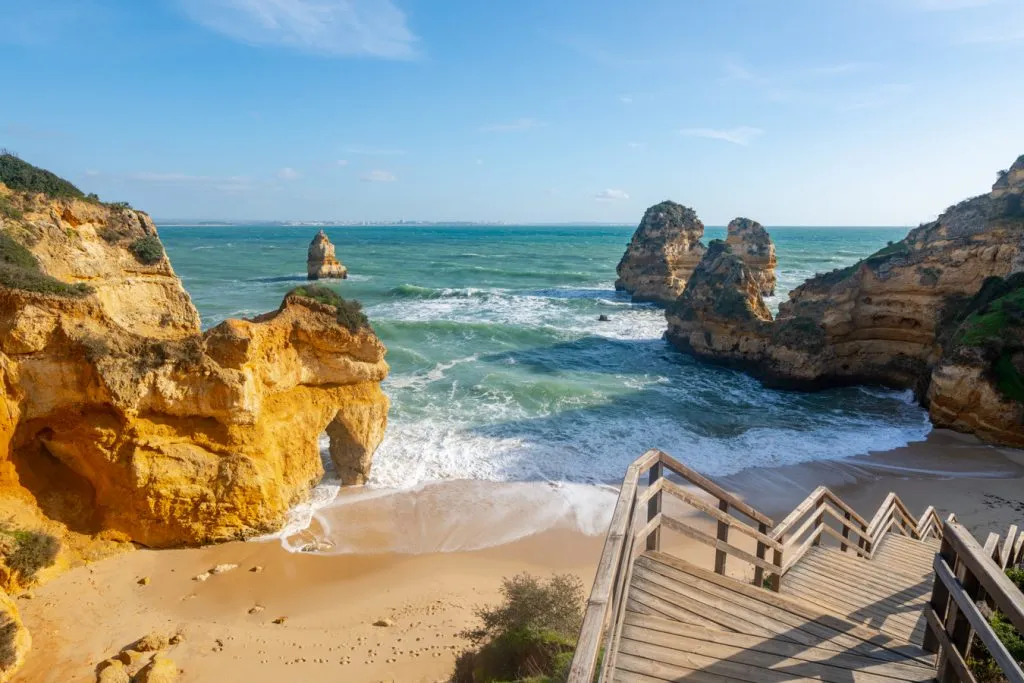
This 2 week Europe trip guide is designed for someone hoping to see the highlights of a few different European destinations, spread across multiple countries, in only a couple of weeks.
We’ve primarily written it for someone planning their first trip to Europe, but if this is your second trip, third trip, or beyond, hopefully, we have some interesting ideas and tips for you, too!
And, of course, given that Europe is home to more than 50 countries and is roughly the same size as the USA, no 2 weeks in Europe could hope to cover the entire continent or all of its numerous and distinct cultures, languages, and histories.
For ease of communication, we’ll talk in general terms about traveling in Europe here, but once you pick your itinerary, of course, you’ll want to follow up with further research on the specific locations you’ll be visiting.

And, once you’re further along in your planning process, we’d love to help you with some of that planning here on Our Escape Clause, too!
We’ll link to relevant blog posts throughout this travel guide, but given the hundreds of posts we have on the site, we won’t be able to link them all.
You can use our destinations page or the search bar on the top right of the page (on desktop) or at the top of the pop-out menu (on mobile) to find our content about various specific destinations across Europe or general travel tips.
For example, a few of our most popular guides that might come in handy next include our guide to traveling Europe by train , our 75 best Europe travel tips , and our (biased) guide to the best cities in Europe .

The number of possible 2 week Europe itinerary ideas is truly infinite–just look at the odd itinerary that I cobbled together for us in 2015 as an example !
However, the sample itineraries for Europe outlined below should give you a good idea of what you can accomplish with around 14 days in Europe .
I truly struggled to narrow down these ideas–I could name 10 more excellent 2 week Europe trips in an instant, and still feel like I was leaving so much on the table.
I aimed to keep these mostly focused on destinations that are popular for first-time visitors to Europe, with just a couple of slight curve balls thrown in.

The Classic: London, Paris, Rome
As three of the world’s most beloved and celebrated cities, you can’t go wrong with splitting your 2 weeks in Europe between London, Paris, and Rome.
As the capital of an English-speaking country and home to an enormous airport hub, London makes logistical sense for a first trip to Europe hailing from North America–and, of course, it’s a truly fascinating city.
Visit Buckingham Palace and Hyde Park, stroll through Notting Hill, snap photos of Big Ben, check out the Tower Bridge and the Tower of London , visit the Wizarding World of Harry Potter, stop by Piccadilly Circus, ride the London Eye , and tour the British Museum.
… And that’s just to get you started !
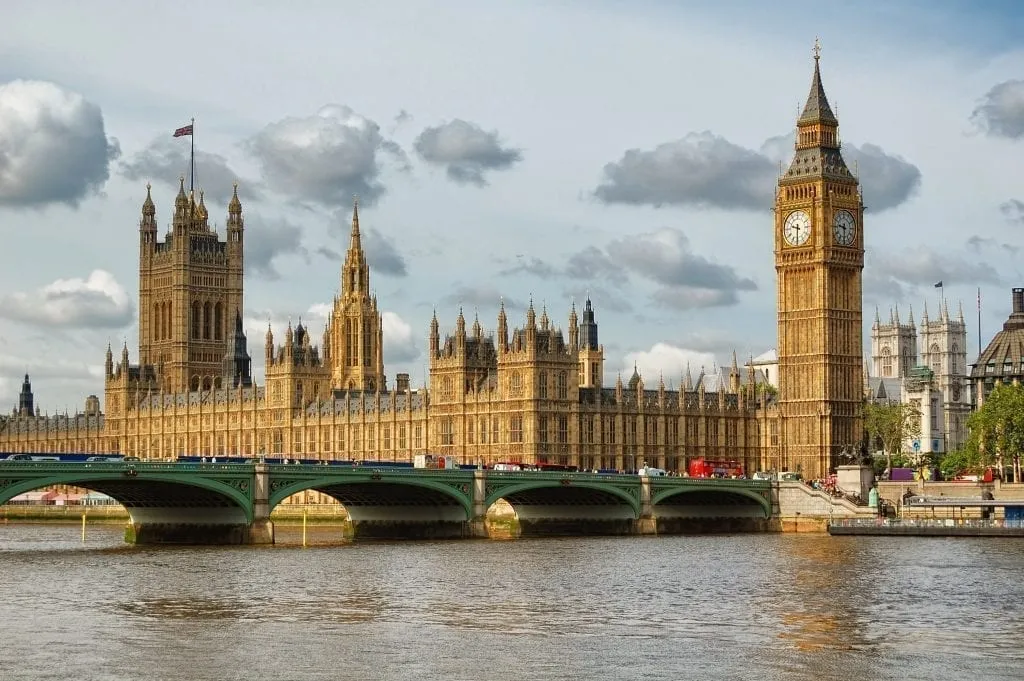
The City of Lights is one of our favorite cities in the world and was also the first place we visited on our very first trip to Europe (we spent a week there and then planned our 2 week Europe trip outlined in the introduction of this blog post the following year).
Since then, we haven’t been able to stop going back, and believe that it’s an excellent addition to any 2 week Europe itinerary!
While you’re in Paris , visit the Eiffel Tower, marvel at the beauty of Sainte-Chapelle, tour the Louvre and the Musee d’Orsay, stroll the picturesque streets of Montmartre and the Latin Quarter, visit the Palais Garnier, discover hidden passages and tiny cafes, and soak up every minute of that Parisian charm.
Our full guide to planning your first trip to Paris can help you get started!

Ah, Rome –if Paris is the first European city we fell in love with, Rome is probably our deepest love on the continent.
From wonders of Ancient Rome like the Colosseum, Roman Forum, and Pantheon to more recent additions like the Vatican Museums , Trevi Fountain, and winding cobblestone streets of Trastevere , exploring Rome is a captivating, engaging experience that we can’t recommend highly enough.
And, of course, you couldn’t ask for a better cuisine to savor during your 2 weeks in Europe: Rome is home to some of the best pasta in all of Italy!

Southern Europe Charm: Madrid, Rome, Amalfi Coast
Want your 2 weeks in Europe to focus on a delightful combination of history, food, and sunshine?
Head directly to Spain and Italy!
While Barcelona gets all the love (and a lot of the crowds), we’re personally smitten with the Spanish capital of Madrid… and excellent flight deals from North America make it almost irresistible on a 2 week Europe itinerary.
With a few days in Madrid , you can admire world-class art in the Prado, soak in Spanish culture with a stroll through Retiro Park, eat all the tapas and churros con chocolate you can get your hands on, tour the Royal Palace , check out an Egyptian temple, and take day trips to fairytale towns like Toledo and Segovia.
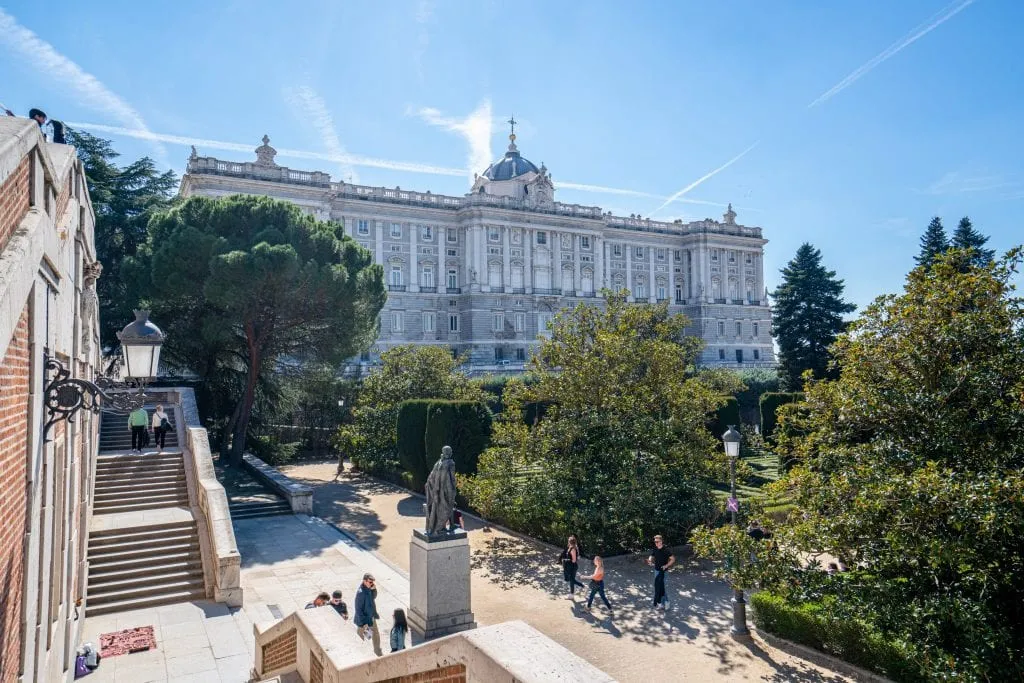
I described Rome in the first Europe itinerary on this list, so I won’t repeat myself here, but as I sit typing this Europe travel blog post out in a Rome apartment while dreaming of the carbonara I’ll eat for dinner tonight, all I can say is: you won’t regret coming to Rome (and scroll up for more details).
And, while I detailed some of Rome’s highlights above, let me also say… don’t forget to get off the beaten path in the Eternal City , either!
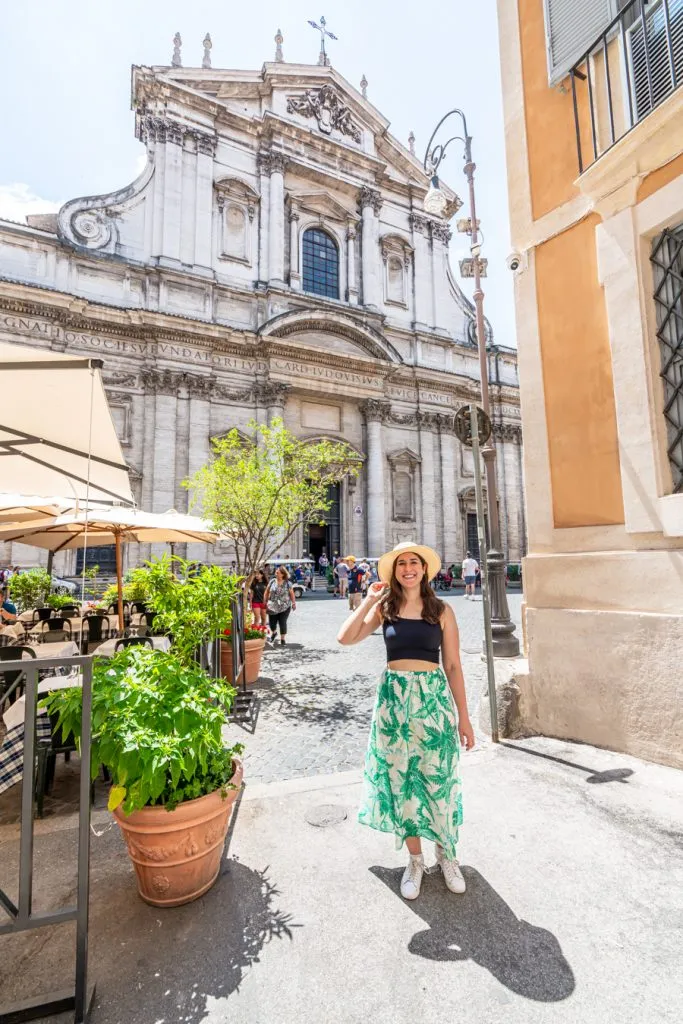
Amalfi Coast
The famed Amalfi Coast , with its dramatic cliffs, chic villages like Positano, delicious lemons, and jaw-droppingly beautiful hikes like the Path of the Gods, is a fabulous conclusion to any 2 week Europe trip–where better to relax than one of the most beautiful coastlines in the world?
While you’re there, be sure to make room for plenty of day trips!
Iconic locations like Capri and Pompeii , as well as less-popular but equally amazing spots like Ischia, Herculaneum , and Procida, are all at your fingertips when staying on the Amalfi Coast.
(Also, if you like page-turning novels about friendship and Italy, I highly recommend reading Elena Ferrante’s My Brilliant Friend series before coming or while visiting Europe).
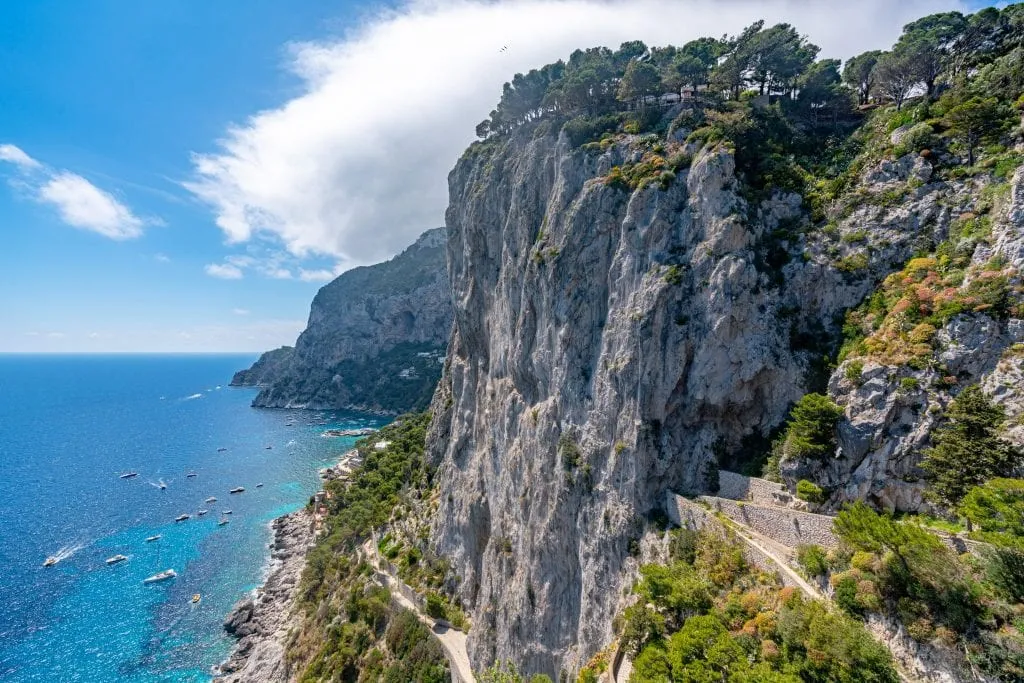
Regal Central Europe: Prague, Vienna, Budapest
Sweeping boulevards, dramatic architecture, beautiful coffeehouses, and tasty comfort food: a trip to Central Europe is an absolute delight.
In my opinion, this region truly shines during the winter months when Christmas markets are in full swing and the hearty cuisine keeps you warm from the inside out.
I’ll try to keep this section quite brief, as I’ve already written a detailed Central Europe itinerary here , but suffice it to say, we love it.
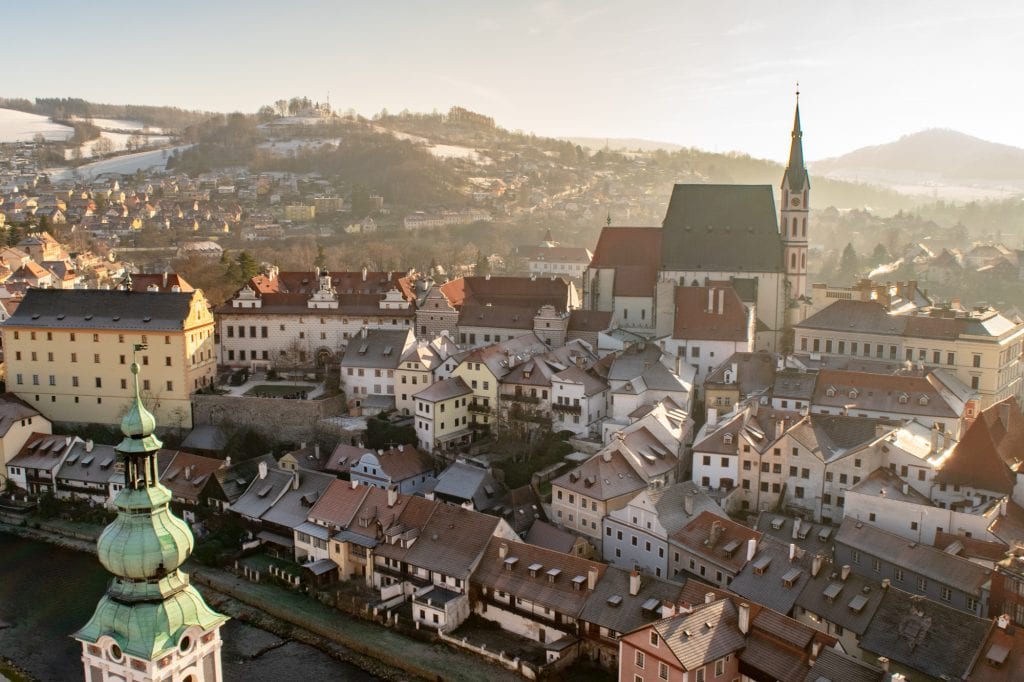
Known as the City of a Hundred Spires (and also for the fact that beer is cheaper than water here–true story, at least when it comes to pricey bottled water at restaurants), Prague is easily in the running for the most beautiful city in Europe.
The beauty of Prague Castle, St. Vitus Cathedral, the famed Charles Bridge, and Prague’s well-known astronomical clock will all draw you in.
If you have enough time, consider adding a day trip to a smaller Czech town like gorgeous Český Krumlov as well!
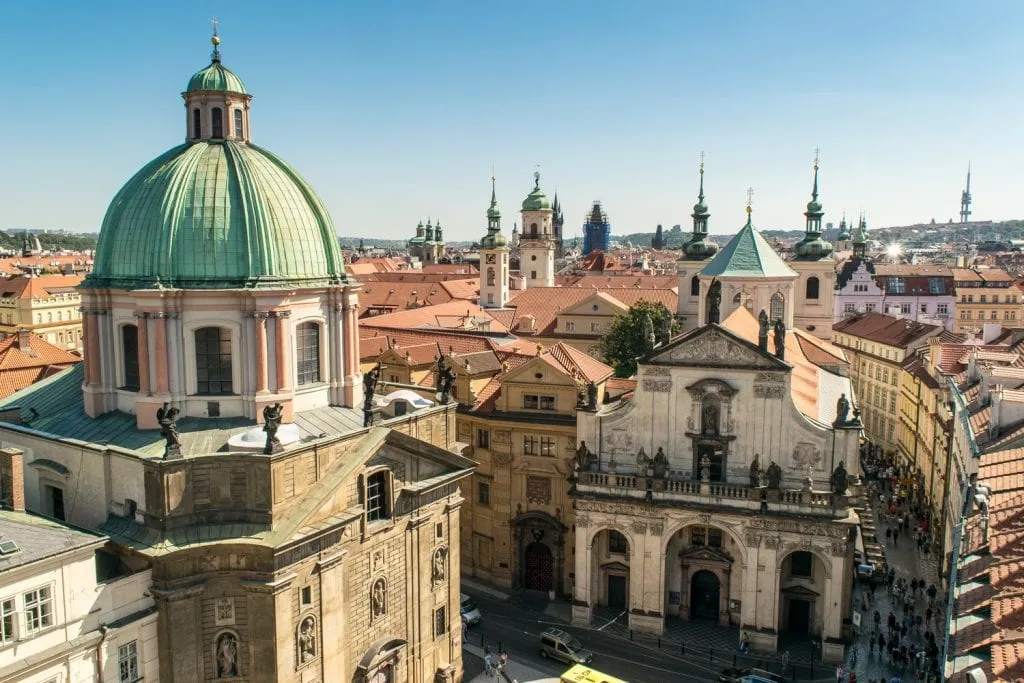
Regal and beautiful, full of spacious, wide avenues and ornate buildings, Austria’s capital city is the perfect place to come to tour grand palaces ( Schonbrunn is one of the most popular), see a show in one of the world’s premier opera houses, and to enjoy European cafe culture at its finest.
We absolutely adore Vienna’s coffee houses–be sure to try a slice (or several) of Esterhazy Cake while there, as well as Viennese hot chocolate.
The city’s famed Spanish riding school and striking St. Stephen’s Cathedral are also worth adding to your list!
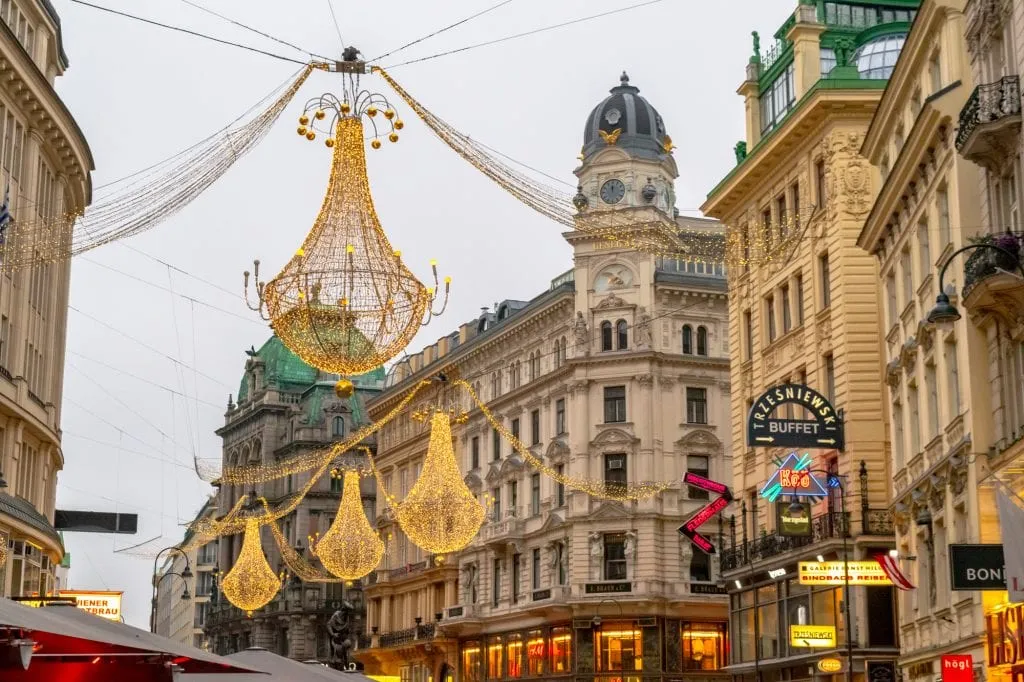
As our favorite city in central Europe and one of our top 10 cities in Europe overall, I really can’t say enough about how beautiful Budapest is!
The city is somehow, simultaneously, both grand and down-to-earth , absolutely gorgeous while also remaining accessible, affordable, and fairly simple to visit and explore.
While in Budapest, go for a soak in the famous thermal baths, tour one of the most beautiful houses of Parliament in Europe, check out a castle, visit grand basilicas, take a boat ride down the Danube, and, if you’re up for a bit of adventure, even go on a cave tour!
Be sure not to miss the great food , either–Budapest’s hearty cuisine is a delight, and one of our all-time favorite wine tastings took place there!
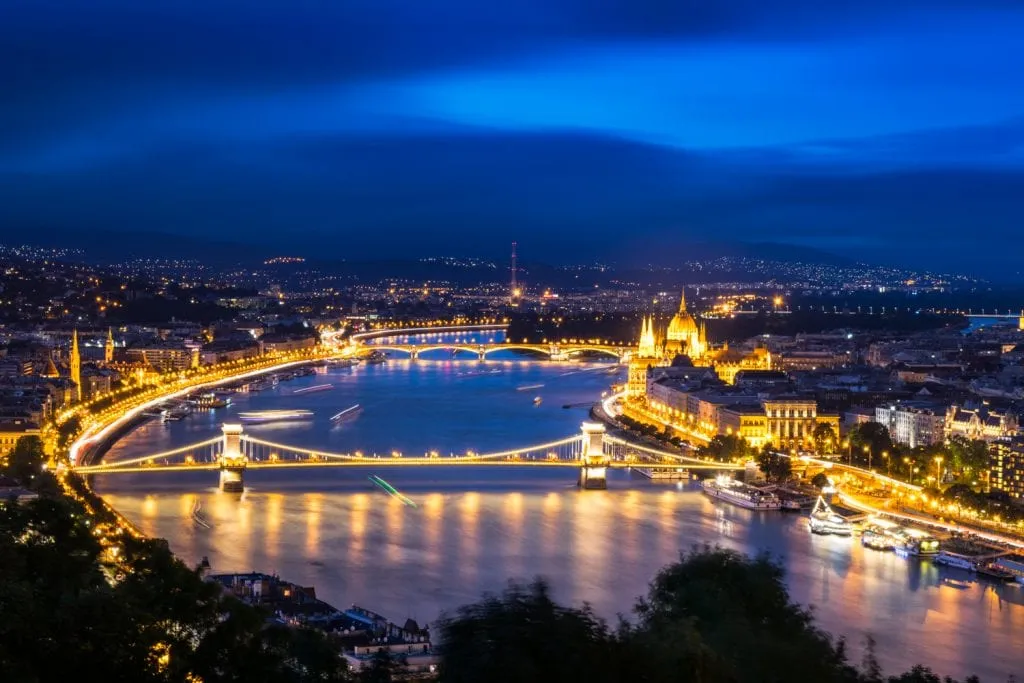
Europe for Art Lovers: Paris, Florence, Venice
If you’re an art buff at heart, you can’t ask for a better sampling of some of the continent’s most beloved artistic cities than the trifecta of Paris, Florence, and Venice (and it certainly helps that each city is practically an art museum in and of itself).
From the Louvre to the Musee d’Orsay to the Orangerie to the Musee Rodin to the Centre Pompidou to the Cluny Museum, it would probably take a lifetime to enjoy all the art museums in Paris alone.
And of course, the city has so much more to offer once you need a break!

Nicknamed the Cradle of the Renaissance, Florence boasts the finest collection of Renaissance art on the planet–and claims many of its most famous artists as locals.
Michelangelo, DaVinci, Botticelli, and more all originally hailed from Florence, and their works are scattered about the city.
Perhaps most famously, Michelangelo’s David is in the Galleria dell’Accademia and Botticelli’s The Birth of Venus is in the Uffizi Gallery .
And of course, no art-focused trip to the Cradle of the Renaissance can overlook Florence’s iconic Duomo , a masterpiece of the era!

Located an easy train ride away from Florence, Venice may be slightly less well-known for its art than the first two cities on this 2 week Europe itinerary, but there’s no doubt that there’s plenty to find!
From the utter masterpiece of St. Mark’s Basilica (don’t miss a chance to go in!) to the incredible Doge’s Palace to the famous Galleria dell’Accademia (not to be confused with the one in Florence!) that focuses mostly on Venetian artists, Venice is an art lover’s dream.
Mix it up by adding a visit to the Peggy Guggenheim Collection, which holds modern art, and a gondola ride .
A fter all, Venice itself is no doubt one of the best artistic masterpieces in the city, and it deserves to be seen from all its best angles.
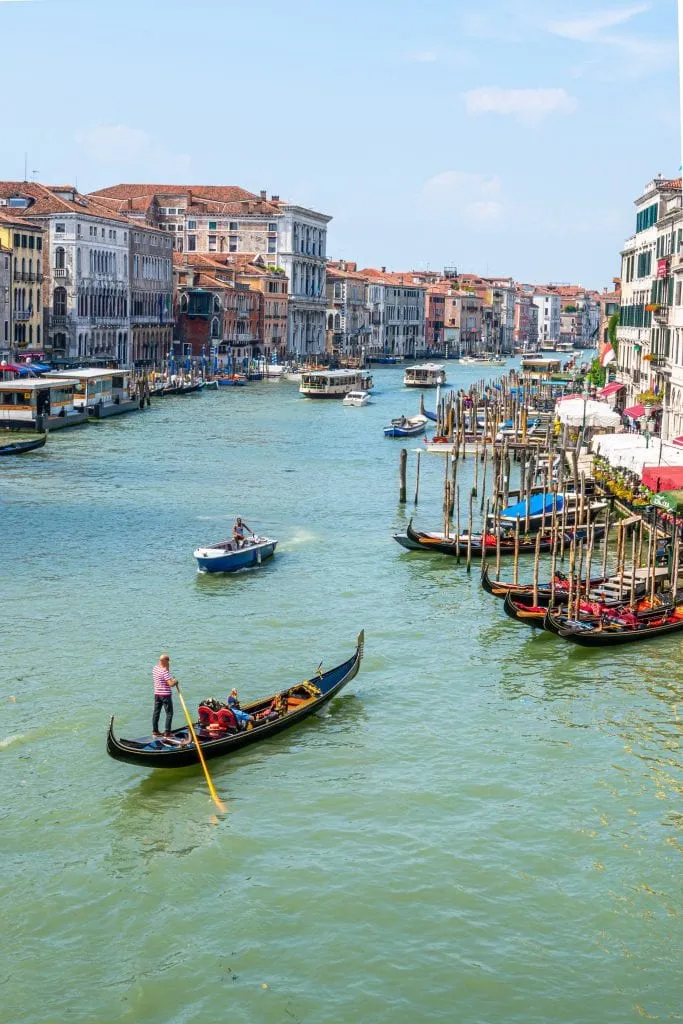
The Incredible Iberian Peninsula: Lisbon, The Algarve, Andalucia
The Iberian Peninsula is dominated by Spain and Portugal , and while I might be biased after spending more than a year living in Lisbon, it makes for an unforgettable Eurotrip!
(The fact that there are often flight deals from the US to Lisbon and Madrid doesn’t hurt, either).
There are infinite ways to craft southern Europe itineraries out of these two countries, but here’s one great option…
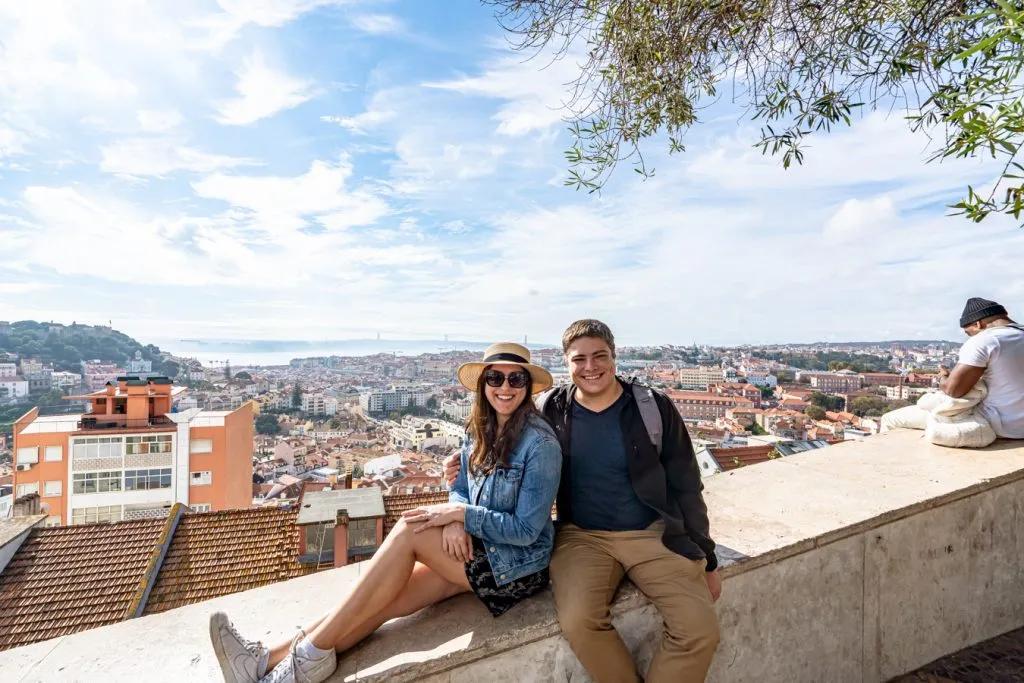
Start your trip with a few days in Lisbon , Portugal’s trendy capital city, soaking up beautiful views from its many miradouros , sampling Portuguese food (starting with pastéis de nata ), touring the incredible Jerónimos Monastery, and taking day trips from Lisbon to nearby gems like the palaces of Sintra and/or the beach resort town of Cascais .
Be prepared to head up and down a lot of hills while you’re there–but Lisbon is worth the climb.
If you’re looking for neighborhoods to wander through, Alfama, Castelo, Chiado, and Bairro Alto are particularly picturesque–keep an eye out for trams, azulejos, and peacocks as you explore!
And, while Lisbon’s top attractions are definitely worth a visit, seeking out some of the many hidden gems in Lisbon will add extra beauty to your trip.
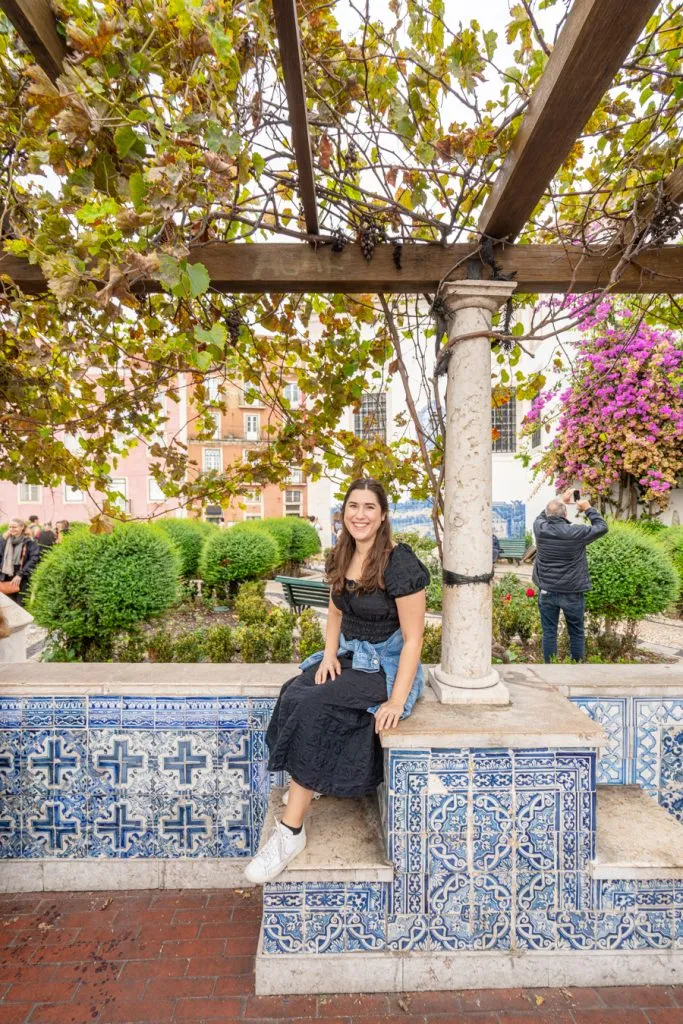
The Algarve
After saying goodbye to Lisbon, head south of Portugal’s Algarve for a dizzying array of whitewashed villages (you’ll find many of the best beach towns in Portugal here) and a picturesque coastline.
Lagos is one of the most popular places to stay, and we can highly recommend it–don’t miss the famous Ponta da Piedade, which photos can’t do justice to.
Nearby attractions (ideally, you’ll want to rent a car in the Algarve) include the famous Benagil Cave and the unmissable Seven Hanging Valleys Trail!
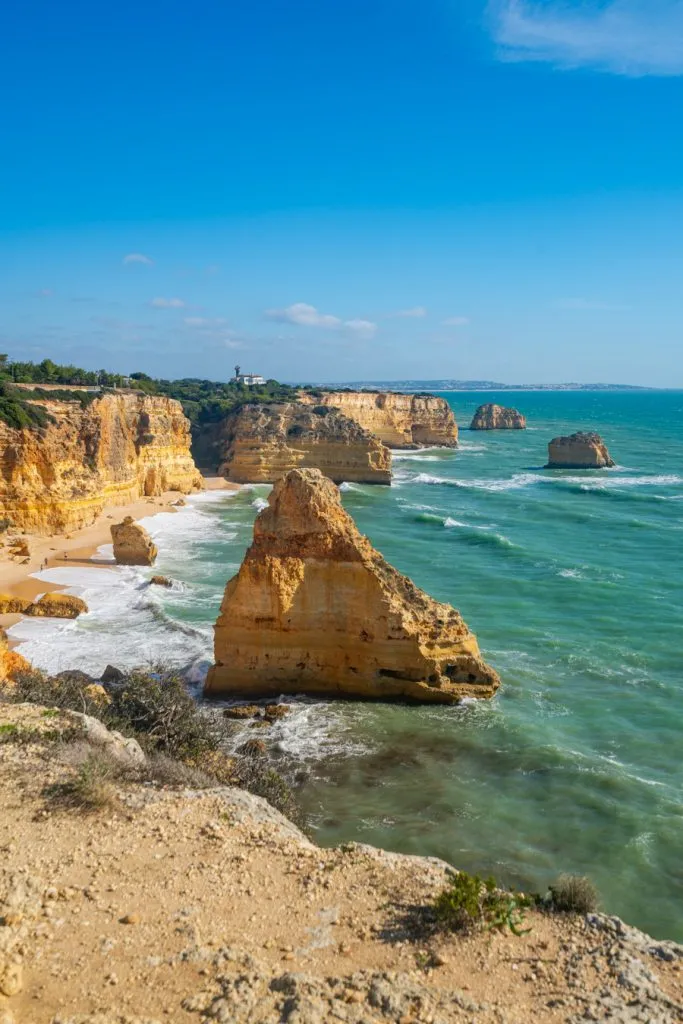
For the second week of your trip in Europe, cross the border into southern Spain (note: there’s no direct train access for this journey, but there are buses).
Split your time between any two of Andalucia’s incredible cities, taking nearby day trips from there.
Seville (with its Alcazar and famous Plaza de Espana), Granada (home of the Alhambra ), and Cordoba (home of the Mosque-Cathedral , one of the most unique houses of worship in the world) are all wonderful inland options.
On the coast, options include Cadiz, Malaga, Marbella, Tarifa, and many more.
With a bit more than 2 weeks in Europe or an ambitious schedule, you may be able to squeeze in a day trip to Gibraltar and/or Tangier, Morocco while here!

Food + History: Athens, Santorini, Istanbul
Feel like heading further east–as far east as you can get during a Europe vacation?
Greece and Turkey pair very well for a 14 day European itinerary–here’s what that might look like.

Start your trip in Athens, marveling at some of the world’s most remarkable ruins, including the famous Acropolis complex and museum.
Be sure to make time to explore non-ancient aspects of Athens as well, including the trendy Plaka neighborhood, Monastiraki Square (and nearby flea market!), and Syntagma Square.
And of course, one of the absolute best things to do after you touch down in Athens is to dive into plate after plate of phenomenal Greek food –that alone is worth traveling to Greece for ( our Athens food tour remains one of my favorites that we’ve taken in Europe).

Truly, any one of Greece’s amazing islands would fit nicely into this 2 week Europe itinerary, but where better to choose than Santorini , with its iconic blue-and-white color scheme, fantastic caldera views, and excellent flight connections?
While Santorini isn’t best known for its beaches–you’re better off heading to Crete for those–you sure can’t beat the charming villages or stunning nature.

The city of two continents, where thousands of years of history blend seamlessly with modern life, and where you can eat one of the best breakfasts you’ll ever experience in your life: Istanbul tops bucket lists around the world, and there is simply nowhere on the planet quite like it.
Marvel at the Blue Mosque, step inside the Hagia Sophia, eat your weight in Turkish breakfast (seriously, I can’t emphasize enough how tasty it is), admire the views of the Bosphorus, climb the Galata Tower, and shop your way through the Grand Bazaar.
Since this Europe travel blog post focuses on, well, Europe, I won’t sketch out any other possibilities further east in Turkey in detail…
But, if you have time, you could easily add a visit to Cappadocia , complete with a sunrise hot air balloon ride, to your trip, or even a visit to the ruins of Ephesus.

Architecture + Culture: Cologne, Amsterdam, Belgium
With this small triangle of destinations, you can easily visit separate countries via train, with very little travel time between them!
And, if you were particularly motivated to add another, you could even squeeze in a day trip to Luxembourg.
If you’re looking for a winter itinerary for Europe that focuses on cities, this is a fantastic option.

Home to a stunning cathedral and what may just be the best Christmas markets on the planet, Cologne is a gorgeous German city that is a delight to explore on foot.
Don’t miss its soaring Gothic Cathedral while you’re there!
… Though honestly, that would be hard to do, considering you can see it right as you step outside the train station.

As one of the most popular cities to visit in Europe, Amsterdam requires no introduction.
The city of canals, biking, and revelry is somehow even more beautiful in person than in the billions of photos of it.
While you’re there, be sure to take a canal cruise, stroll the 9 Streets, and visit at least a couple of the city’s museums (the Anne Frank House is incredibly moving).
If you visit Amsterdam in winter , you’ll no doubt need to bundle up–but the lack of crowds in this often-packed city is also a treat to experience.
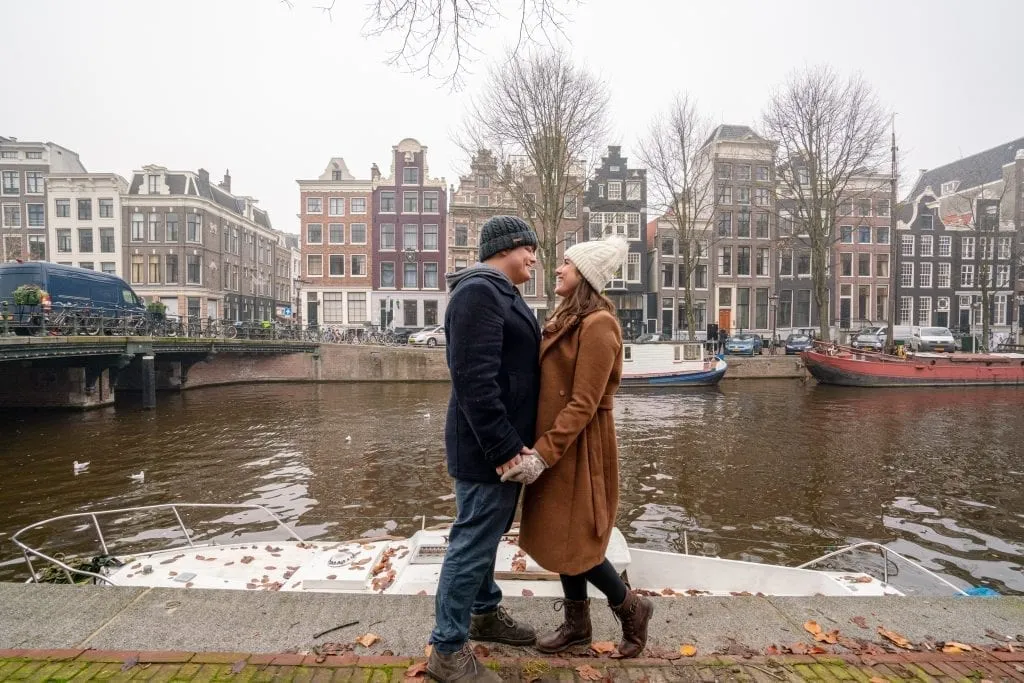
Perhaps it may be slightly unfair to list Belgium entirely while the other destinations are split into cities… but considering Belgium’s two most popular cities, Bruges and Ghent , are located less than an hour apart by train, you can cover quite a bit of the country in a few days !
With stunning architecture, canals, and carbs (bring on the waffles and frites), it’s easy to have a blast in Belgium.
Winter in Belgium brings a lack of crowds and plenty of festivities during the Christmas season!
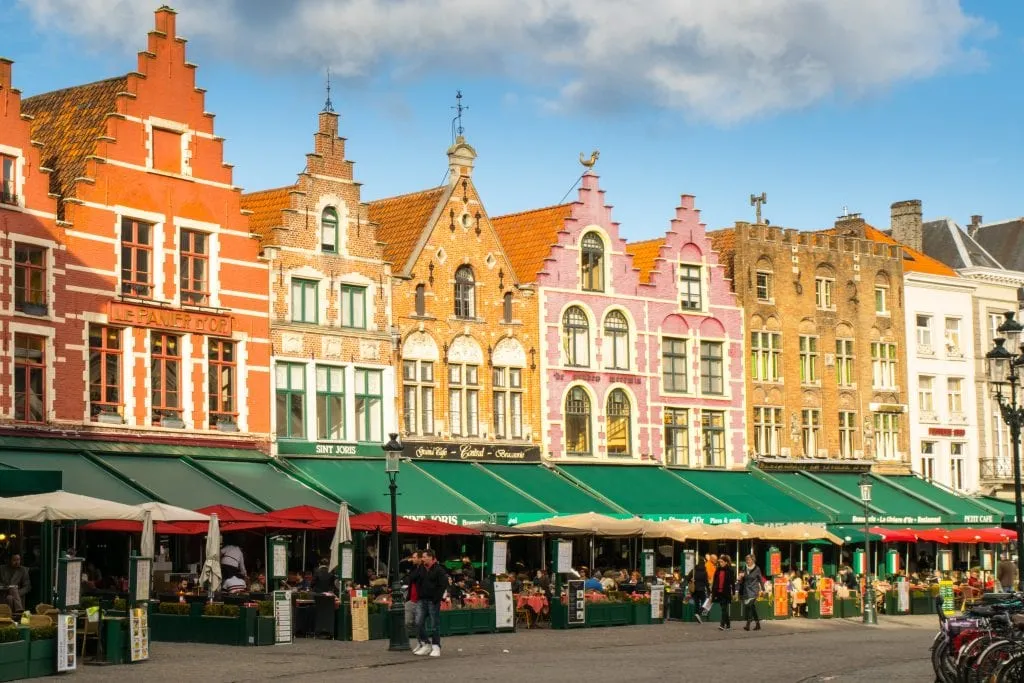
Alpine Escape: Bavaria, Switzerland’s Jungfrau Region, Milan, and Lake Como
If your dream Europe trip involves plenty of Alpine views with a side of cities, this is the itinerary for Europe in 2 weeks for you.
Start your trip in Bavaria, the land of castles, beer, and outdoor delights.
City lovers will enjoy being based in Munich (don’t miss the opulent Munich Residenz or view from St. Peter’s Church and/or the Town Hall Tower while there).
From Munich, you can easily day trip to more mountainous areas, starting with Fussen, home to Germany’s famous Neuschwanstein Castle .
If you get good weather and want to see as many mountains as possible, a day trip to the Zugspite–the highest point in Germany–is also an option.
Really, though, if there’s one thing to prioritize in Munich, it’s to eat and drink all the sausage, pretzels, beer, and beyond you can get your hands on!
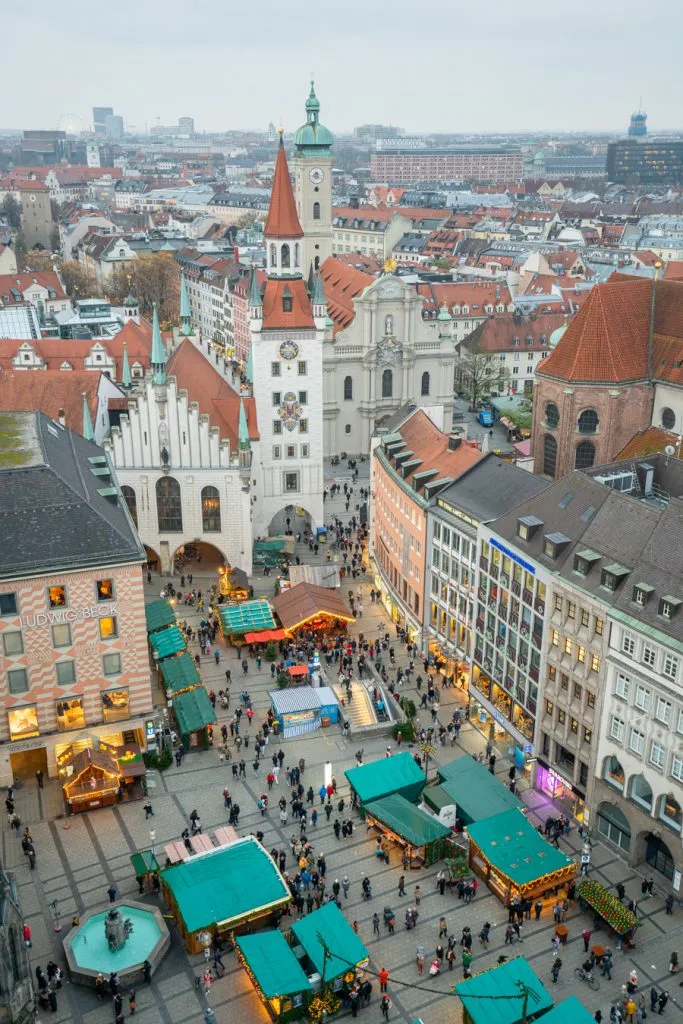
Switzerland’s Jungfrau Region
I am convinced that Switzerland’s Jungfrau region–located around (literally, above) Interlaken–is paradise on earth in the summer.
If you’re dreaming of the Alps, check into a hotel in Wengen, Murren, or Grindelwald (for the best views) or Interlaken (for a bit more selection) or Lauterbrunnen (to be in the literal center of the action) and have the trip of your dreams.
Switzerland’s legendarily efficient trains and gondolas mean that wherever you stay, the region is at your fingertips.
Hiking from Mannlichen to Kleine Scheidigg, riding the highest train in Europe to Jungfraujoch (aka the “Top of Europe”), eating daily fondue, walking from Murren to Gimmelwald , and riding a historic cogwheel train to Schynige Platte are just a few of the unforgettable experiences you’ll find here.

Milan + Lake Como
End your trip to Milan and Lake Como , two of the most popular destinations in northern Italy!
In Milan , be sure to visit its legendary Duomo, stroll through the Galleria Vittorio Emanuele II, visit Sforzesco Castle, and, if you can get tickets (plan ahead!) see Da Vinci’s The Last Supper .
At Lake Como (just an hour north of Milan by train), take a boat tour around the lake and visit delightfully charming towns like Varenna and Bellagio while admiring magnificent Alpine views.

Getting around in each city on your 2 week Europe itinerary is a question better suited to blog posts on that particular city, so this section is designed to address getting in between each destination during your 14 days in Europe.
We recommend checking several solutions for each destination, as you never know what will crop up!
Personally, our first 2 week Europe trip involved an overnight train, a budget plane ride, and a couple of rental cars.

Train travel is our absolute favorite way to travel in Europe!
I t’s much less stressful than traveling by plane, especially once you get the hang of it, far more comfortable, and for those of us hailing from North America, it’s a travel experience in its own right!
We recommend using services like Omio to compare train prices across multiple countries.
It works more or less exactly like a car rental aggregate does, searching multiple companies and generating the best routes and prices for your dates.
Keep in mind that train travel is most useful in western and central Europe–once you head into eastern Europe and especially the Balkans, train travel becomes more limited and bus travel more common (for example, popular Dubrovnik, Croatia doesn’t have a train station).
Shop train routes and tickets prices in Europe today!

For those traveling on a budget or between two smaller destinations where rail travel isn’t an option, buses can be a very affordable choice.
In addition to standard local buses, companies like Flixbus provide an easy-to-use service, and you can check their prices and availability directly or through Omio as well (that way you can compare train tickets at the same time).
Browse bus routes in Europe today!
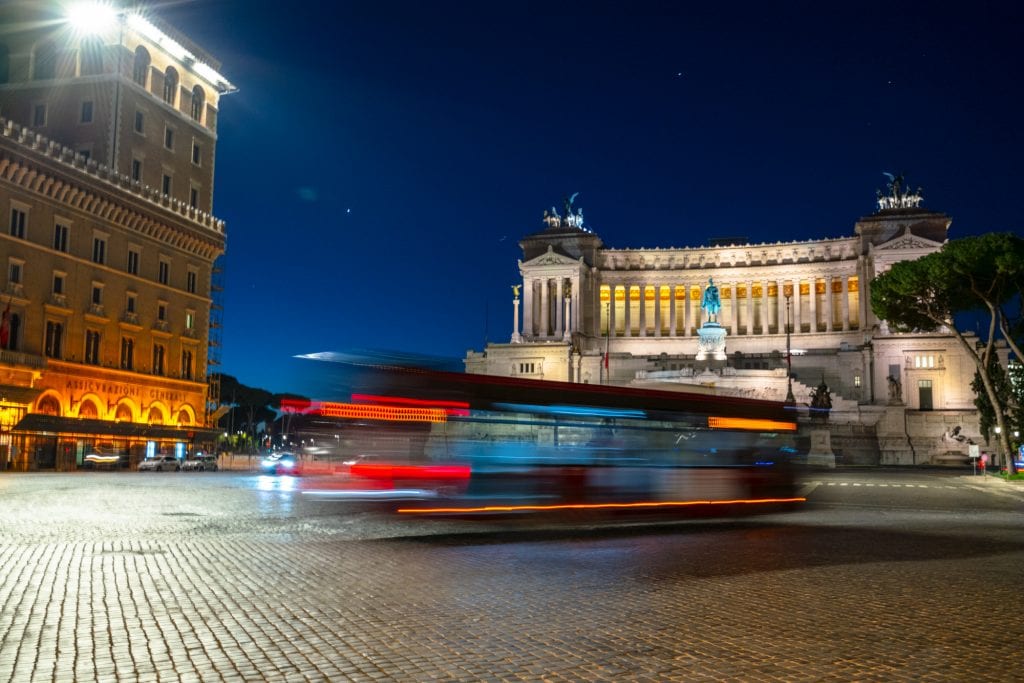
With plenty of budget airlines and plenty of airports to choose from, if you plan wisely, it’s possible to take flights in Europe that are so inexpensive you wonder how the company pays for the fuel.
S eriously: 10 Euro flights are possible, though we’ve never actually managed to pay that since we prefer to check our bags !
When looking for flights within Europe, we recommend using Google Flights in order to search the whole continent at once (you can simply put “Europe” in as the destination, and it’ll pull up a map of prices).
With a little flexibility on destination (for example, maybe flying into nearby Bologna is cheaper than flying into Florence ?) and even on dates if possible, you just might end up with an excellent flight deal or two during your trip to Europe.
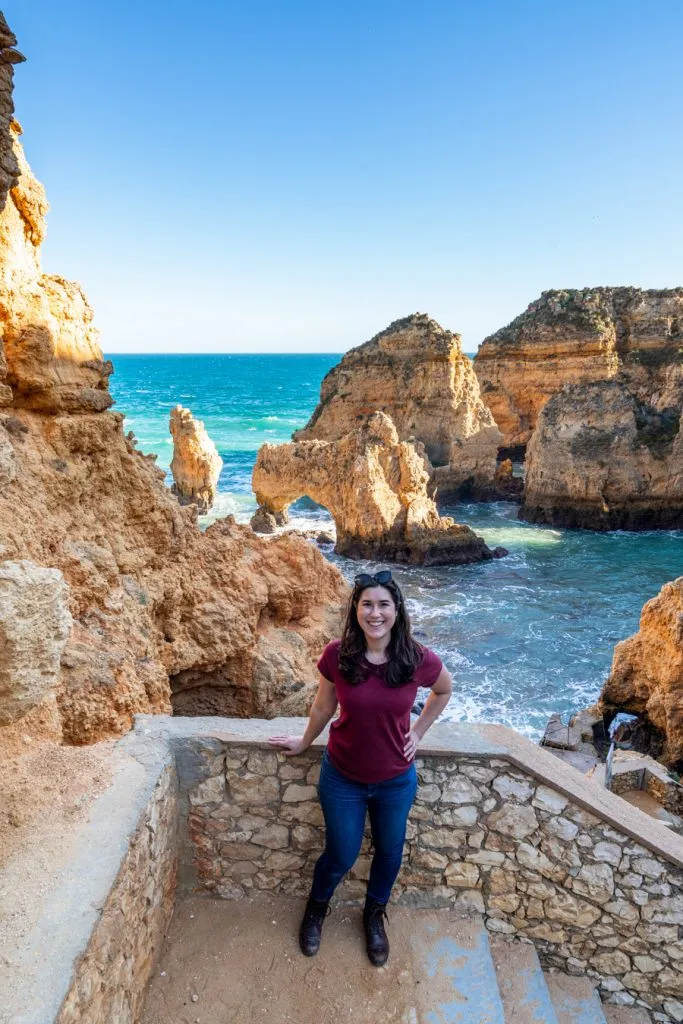
Personally, we recommend avoiding a car rental when possible during your 2 weeks in Europe, especially if you’re following anything resembling a Europe itinerary like the ones I outlined above.
In large cities, rental cars are a hindrance and a liability, not an asset, and they add quite a bit to your bottom line.
That being said, if you’re planning on visiting any rural areas or small towns, road trips in Europe can be a delight!
Y ou could consider renting a car for a couple of days in Tuscany , for example, or to visit the villages of Provence.
If you do choose to rent a car, we recommend searching for the best prices through Discover Cars , which will allow you to search multiple companies at once and come up with a great option.
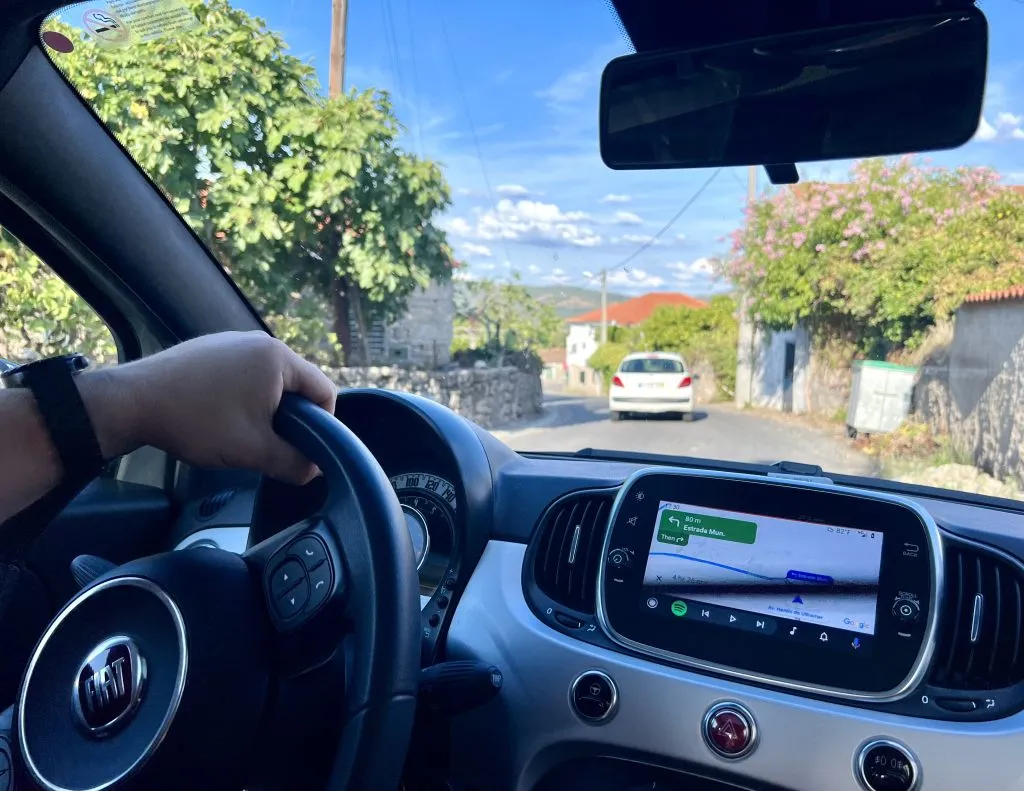
While major international carriers like Hertz and Enterprise are available in Europe, they’re not always the best deal, and searching for a combination of local and international companies is best.
Personally, we have no loyalty to any one rental car company, and book with whoever is most affordable (and we always buy the extra insurance).
As a result, we’ve rented cars through easily more than 15 or 20 agencies over the years (I’d be hard-pressed even to estimate it), and we’ve never had any issues with surprise charges.
Price out rental cars with Discover Cars now!
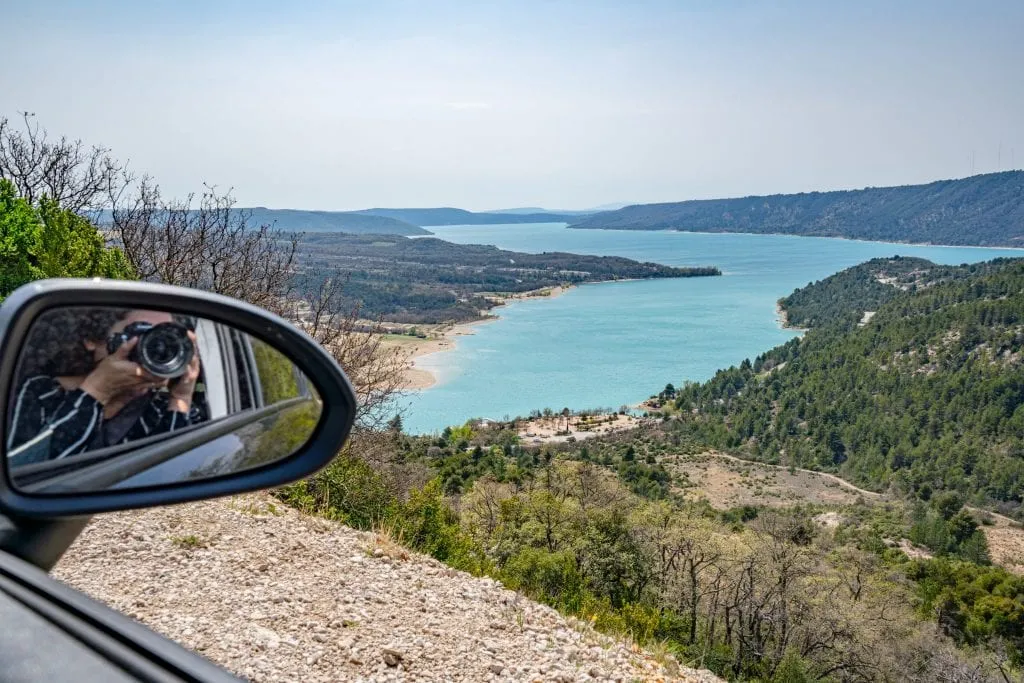
Don’t forget boats when it comes to planning a 2 week Europe itinerary, especially over the summer!
While ferries between or to/from islands are obviously the most popular ( Dubrovnik to Hvar , for example, or Barcelona to Mallorca), there are longer ferry options as well!
Last summer, we took a ferry from Barcelona to Rome and loved the experience of drifting along the Mediterranean Sea for 24 hours!
Many ferry routes are seasonal, but not all.

Don’t plan to visit too many destinations.
With only around 14 days in Europe, I know it can be incredibly tempting to squeeze in as many destinations as possible (and I have many fevered outlines of ridiculously ambitious trips I planned in my college days to prove it), but your trip will go so much more smoothly if you can resist that temptation.
In most cases, we recommend an absolute minimum of two full days per major city.
By full days, I mean with limited exceptions (like a red-eye flight that lands at 8:00 AM), the day you arrive and the day you depart don’t count as a “day” in a given city–just as a travel day.
Three or four days per city is even better and will allow you to potentially squeeze in a day trip from that city to a smaller city or village if you want to mix things up.

Start and end in a major airport hub.
It doesn’t necessarily have to be the same hub–more on that below–but there are definitely airports that are cheaper to fly into and out of for intercontinental flights than others.
Budapest may be affordable once you’re there, for example, but flying from the US directly to Budapest can hurt the wallet!
For those of you coming from the USA, London, Dublin , Madrid , Paris , Lisbon , Frankfurt, Amsterdam , and Milan are a few places to check ticket prices for.
That’s not an exhaustive list by any means, but there are often flight deals to and from these cities.

If you can, use an open-jaw ticket rather than a return ticket.
This will allow you to begin and end your 2 weeks in Europe in entirely different destinations, and let you avoid doubling back!
While one-way tickets can be pricier than round-trip ones, if you’re flexible on your dates and destinations (so deciding which cities to start and end in partially based on price), you can usually find excellent deals
This is exactly how we ended up flying into Krakow and out of Dublin for our first 2 week Europe trip!

You will be exhausted at some point. Plan for it.
Two weeks in Europe may not seem like a ton, but if you’re anything like us or virtually all of the travelers we have talked to, exhaustion will set in during your trip.
Sightseeing in Europe is fabulous, but it’s also tiring.
Add in navigating cultural differences, language barriers, and moving countries every few days, and you’re bound to need a break at some point.
We recommend planning a couple of laid-back days without museum visits, tours, or day trips so that you can catch your breath and avoid burnout.
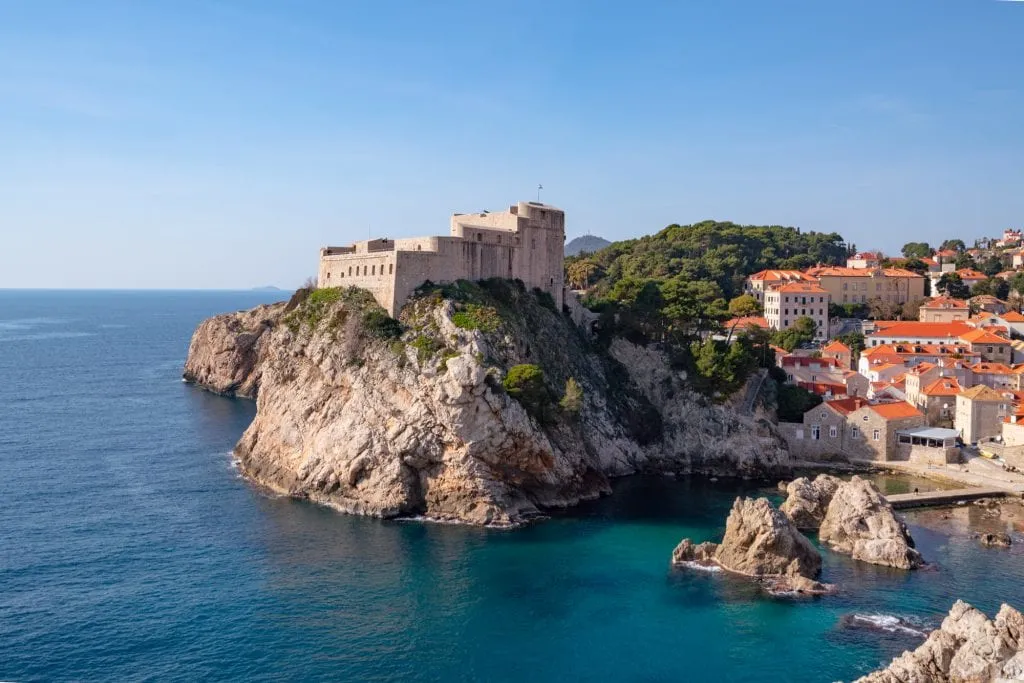
Try to be flexible with where you go.
As you start pricing train, plane, and bus tickets for your trip to Europe, you’ll likely notice dramatic shifts–for example, is it 4x the money to get to London instead of Amsterdam?
Does traveling to Prague require a long flight and 2 layovers but Rome is a quick hop away?
If you can, be flexible when you come upon these challenges: we recommend having 1-2 “must visit” destinations and filling in the rest of your trip based on a combination of logistics and desire.
After all, there’s no way you can see it all on a 2 week Europe trip anyway!
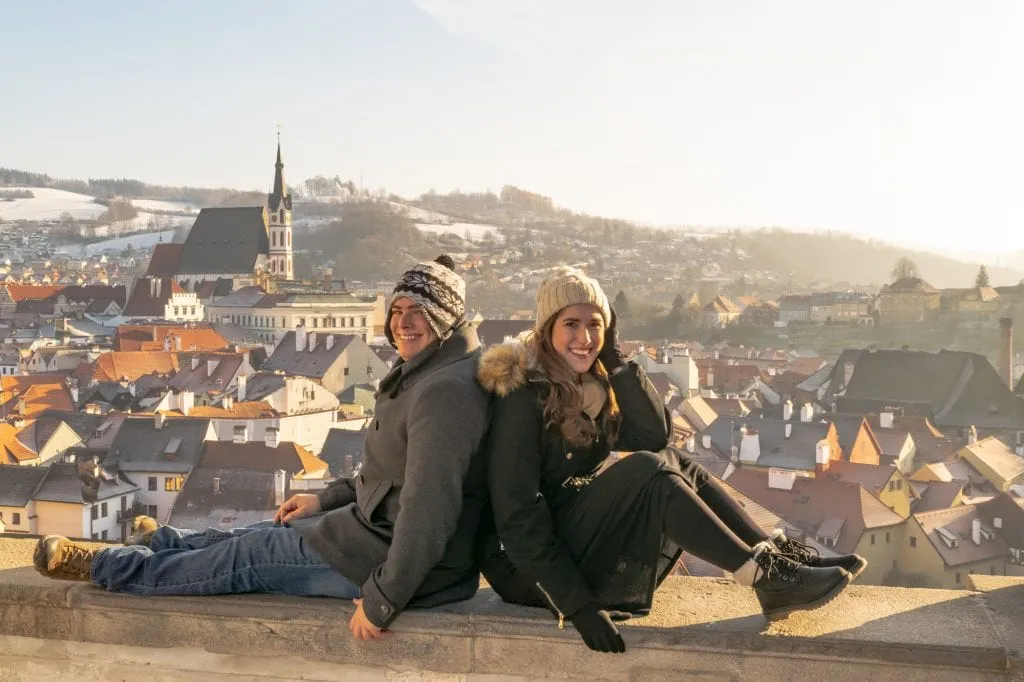
Don’t underestimate the time and energy it takes to change destinations.
“Oh, it’s only a 3-hour train ride away! That’s nothing!”
I think we’ve all said that at some point when planning a multi-country trip, but be cautious.
Three hours on the train doesn’t account for packing and unpacking, getting to and from the train station, checking out of and into a hotel… you get the picture.
If you’re looking at a high-level schedule without picking a specific date or time, you may also come to find that sure, there’s one direct 3-hour train between two cities… but it leaves at 10:00 PM or 6:00 AM, and the rest of the trains require layovers.

Or perhaps the direct train only runs 3 days a week.
Or maybe you’re looking at a plane, in which case, be sure to add at least 4 hours to your transit time: getting to and from the airport and security/check-in beforehand.
Long story short, travel days between countries are virtually always more tiring and time-consuming than they look at first glance, so don’t overcommit on those days when planning your ultimate Europe trip!
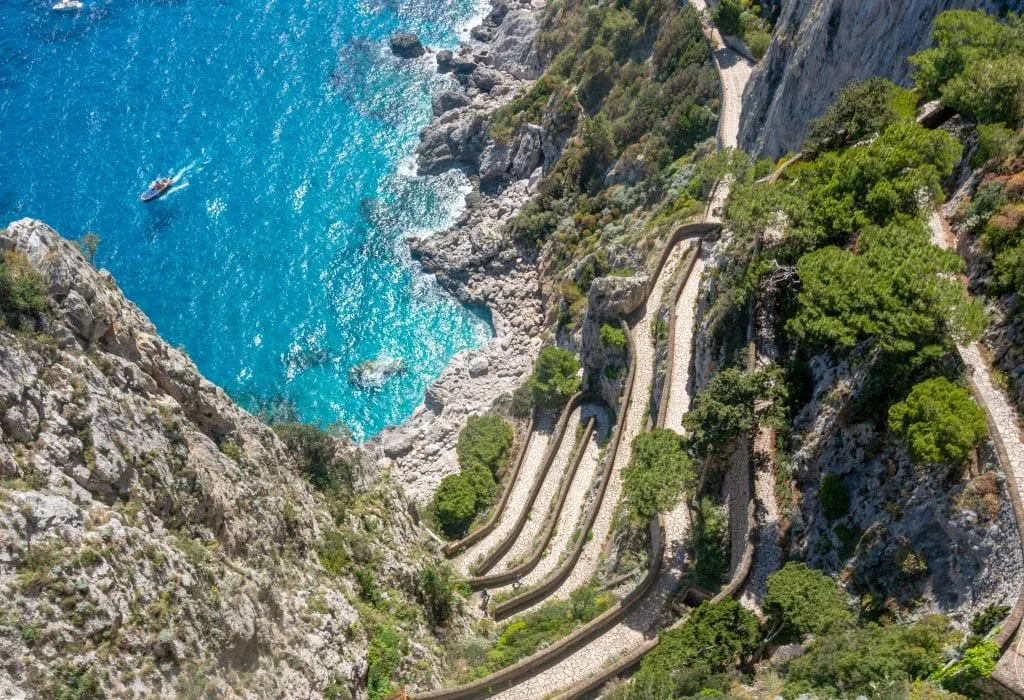
Big cities are more accessible than small towns and nature areas.
For the first trip to Europe especially, big cities are absolutely the easiest to plan your itinerary for Europe around.
They’re generally easier and cheaper to get into and out of, and there’s far more information available about them online to help plan your trips.
That’s no reason not to visit other places too, of course–but keep in mind that the more rural the area, the more logistically challenging your trip will be.
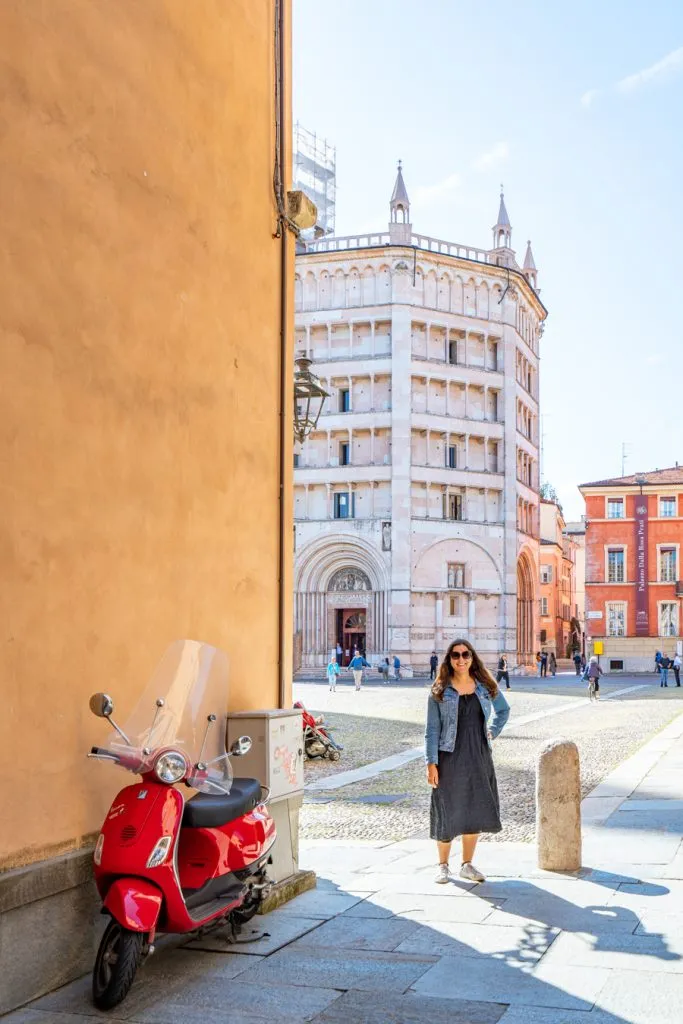
Skip-the-line tickets are incredibly useful.
I’m sure it comes as absolutely no surprise that the world’s most iconic monuments and museums tend to get a bit crowded… and that makes skip-the-line tickets invaluable, especially with only 2 weeks in Europe to squeeze in as much sightseeing as possible.
In some places (like the Arc de Triomphe ) they’re available without any additional fee, and in other places (like the Colosseum) they cost a bit extra.
Either way, though, it’s 1000% worth the price and effort to get tickets online beforehand for popular spots, especially if you’re traveling during the high season.

And, in 2024, it’s worth pointing out that given ever-changing capacity limits, it’s a better idea than ever to book in advance–and for some attractions, it’s even required!
When 2020 shook the travel industry to its core, many of the most popular museums and monuments in Europe found that life was easier with reservations and online bookings, and have continued prioritizing that system over traditional lines and ticket booths even as crowds returned to “normal”.
We use skip-the-line tickets all over the continent and book them through Get Your Guide .

Book your hotels and major transportation in advance.
Before kicking off your 2 week Europe itinerary, we recommend having all of your hotels and major transportation (so travel between destinations) booked and ready to go.
This dramatically cuts down on stress levels, makes it easier to budget and plan out your days, and generally helps your trip run more smoothly.
These days, we book virtually all of our lodging (including apartments, farm stays, houses, and more) through Booking.com .
Smaller things, like metro passes or tickets for getting around cities, can be handled once you arrive.
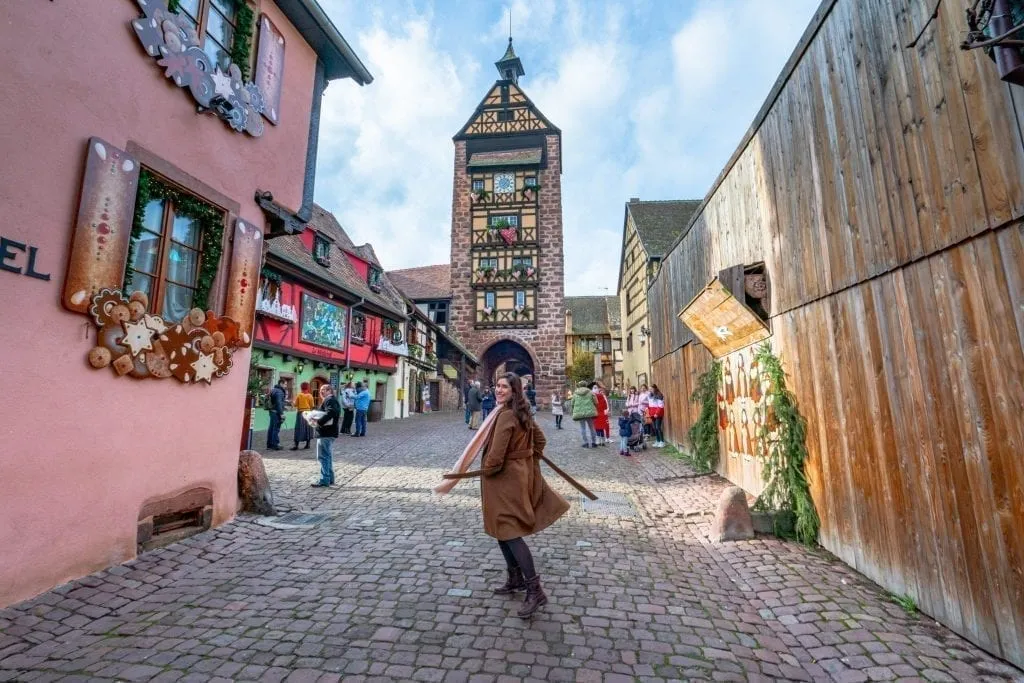
If you can, we recommend taking at least one food tour during your 2 weeks in Europe.
Food tours are one of our favorite ways to get our bearings in a new city while learning about the culture, history, and neighborhood through something we can all appreciate: a tasty meal.
We’ve taken food tours in several countries around the world, including many in Europe, and have never walked away unsatisfied!
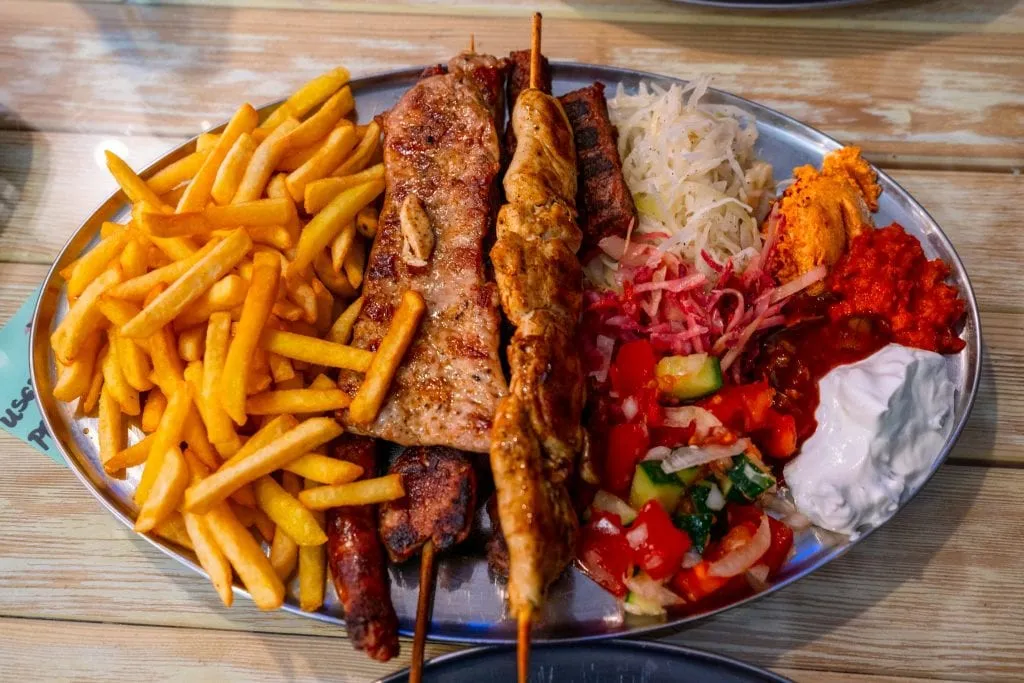
You do need to pay to use the restroom… sometimes.
Throughout Europe, public restrooms are generally available for a fee (typically either half a Euro or a Euro).
If you’d like to avoid those costs, be sure to take advantage of available restrooms in restaurants and museums as you sightsee !
Also, toilet paper is far from guaranteed in public toilets on the street.
We recommend carrying a small pack of tissues with you just in case.
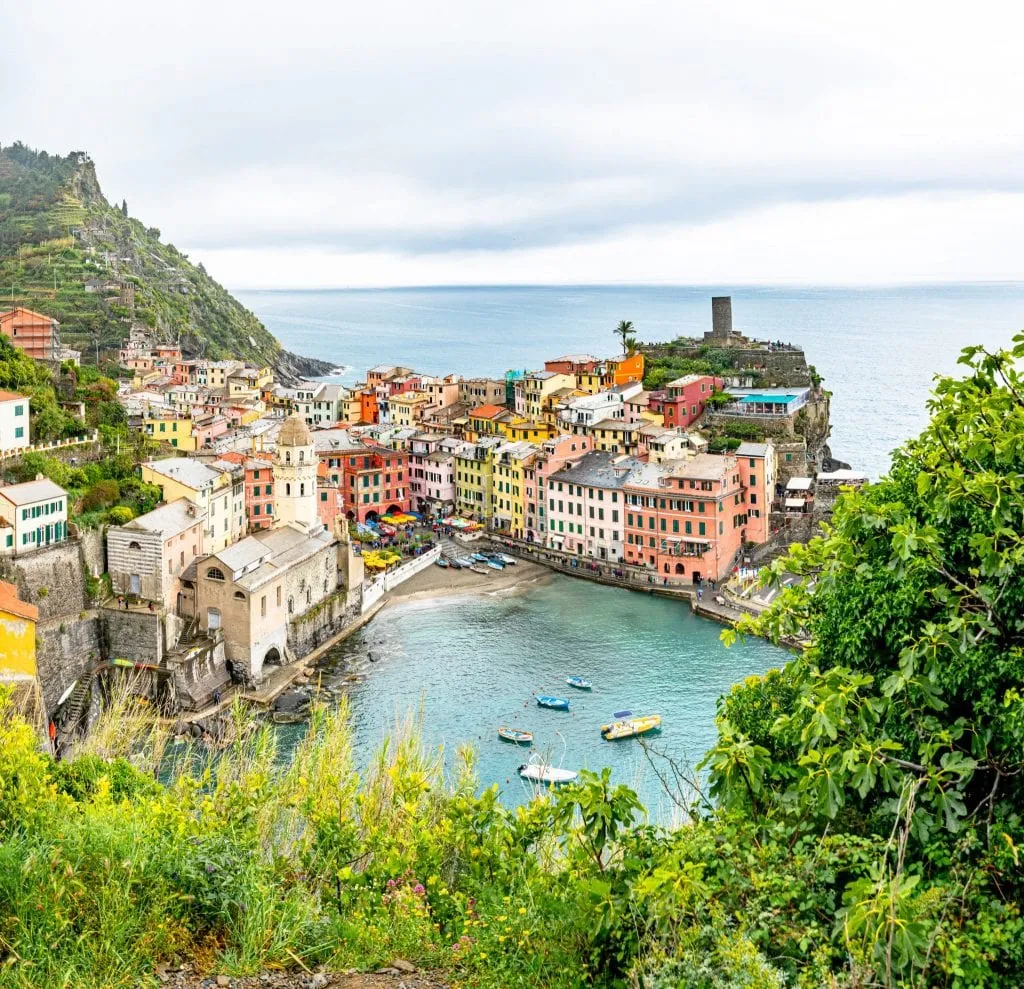
Will I need an adapter?
Most likely, yes!
Luckily, adapters are cheap to buy and easy to carry–we recommend picking these up before you go.
Keep in mind that the UK and a few other countries ( Ireland , Malta ) use a separate plug from the bulk of the continent.
If you’re heading to a place that uses UK plugs, you’ll want these adapters as well.

Is a money belt a good idea?
It depends, honestly.
We used a money belt for our first trip to Europe and for a couple after that.
Back then, we weren’t used to life in bustling big cities, and though we knew that thieves knew about them (because they definitely do), Jeremy found them comfortable enough to wear and it was an easy way to keep our belongings a bit more secure.
If you’re not used to traveling in a big city or watching for pickpockets, I don’t think it’s a terrible idea to use one– this is the one we used and we had no complaints–but I also don’t think it’s necessary, especially if you’re comfortable in large cities.
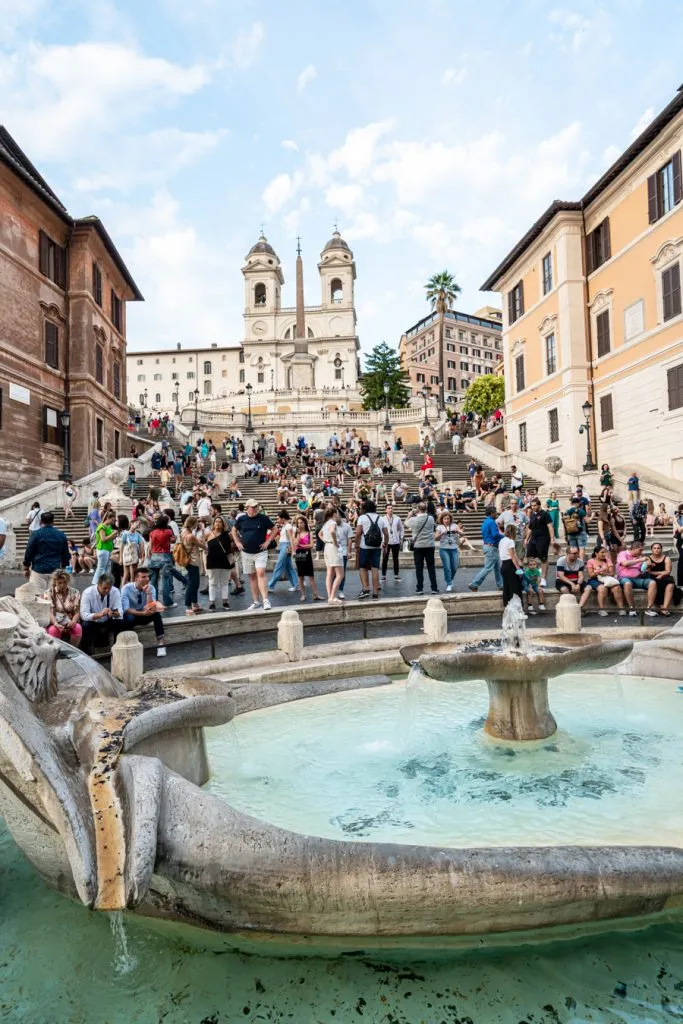
Is the water safe to drink?
Usually, yes.
We drink out of the tap just about anywhere in Europe.
In rare cases where the water is not safe to drink (usually in remote areas of southern and eastern Europe, or in very old buildings with iffy pipes), there will generally be large and obvious signs stating so.
If you’re worried about it, though, you can always ask your hotel concierge or host about it!
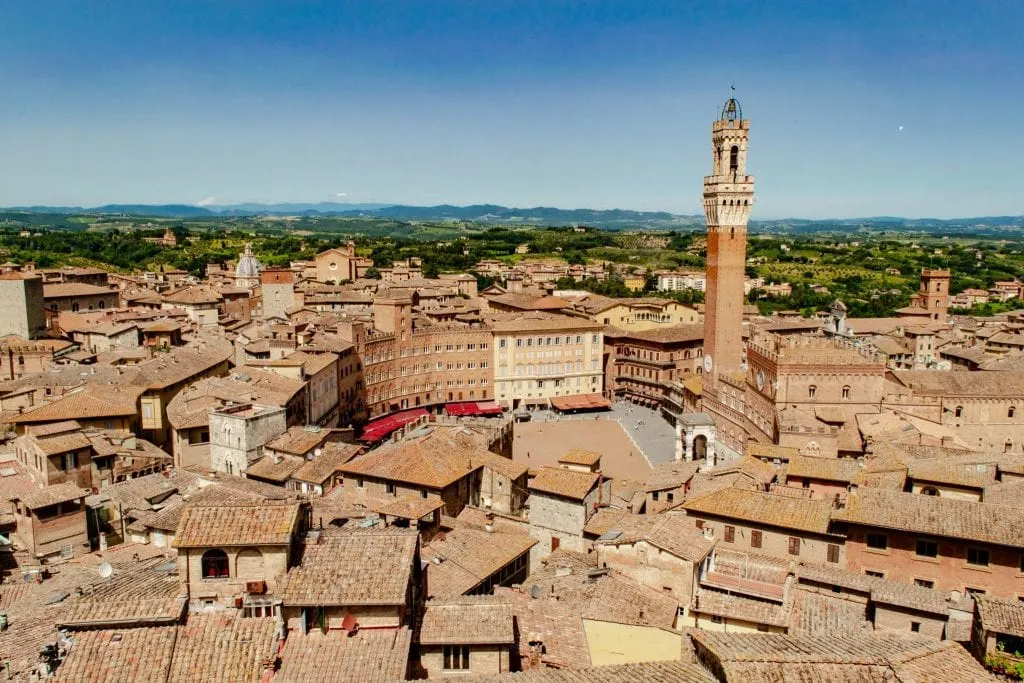
Is it worth going to Europe for 2 weeks?
This is a pretty common question, and honestly, I get it: with long and expensive flights, it’s easy to wonder if flying to Europe for “only” 2 weeks is worth it.
But yes, it absolutely is!
Two weeks in Europe is long enough that you’ll have plenty of time to get past jetlag, visit several destinations, and have a wonderful trip packed with memories.
Now whether or not it’s worth flying to Europe for just one week is a bit more controversial… but we love to travel Europe so much that we still say yes (for some people).

How extreme is the language barrier?
It varies significantly, of course, but generally, it’s not nearly as difficult as first-time visitors to Europe worry before they arrive (ourselves included).
We recommend learning basic phrases in the language of the countries you are visiting during your 2 week Europe itinerary, but this is usually more for good manners than out of necessity.
While you can absolutely find monolingual Europeans in virtually any country, especially in smaller cities and towns, the people employed in customer service roles and in the tourism industry in major cities–in other words, where most or all of your 2 weeks in Europe will likely take place–generally speak some English.

How many European countries should you visit in 2 weeks?
For most travelers, we recommend roughly 3 “base” destinations for a 2 week Europe trip, plus a couple of day trips from there to mix things up.
These can all be in one country (for example, here’s how we recommend spending 2 weeks in Italy ), or they can be in 3 separate countries!
There are plenty of exceptions to this standard layout, of course, but it’s a doable but exciting number of destinations to work with for most 14 day Europe itineraries.

When should I tip?
While this is very country and industry-dependent, generally speaking, tipping is not nearly as prominent in Europe as it is in the USA, and you’ll virtually never need to tip over 10%.
In some countries, you may also tip 5-10% at restaurants, while in others, you might round up the bill or leave nothing at all.
Frequently, a “service charge” will be automatically supplied to the bill which serves the purpose of a tip.
For tour guides, a 10% tip is common.
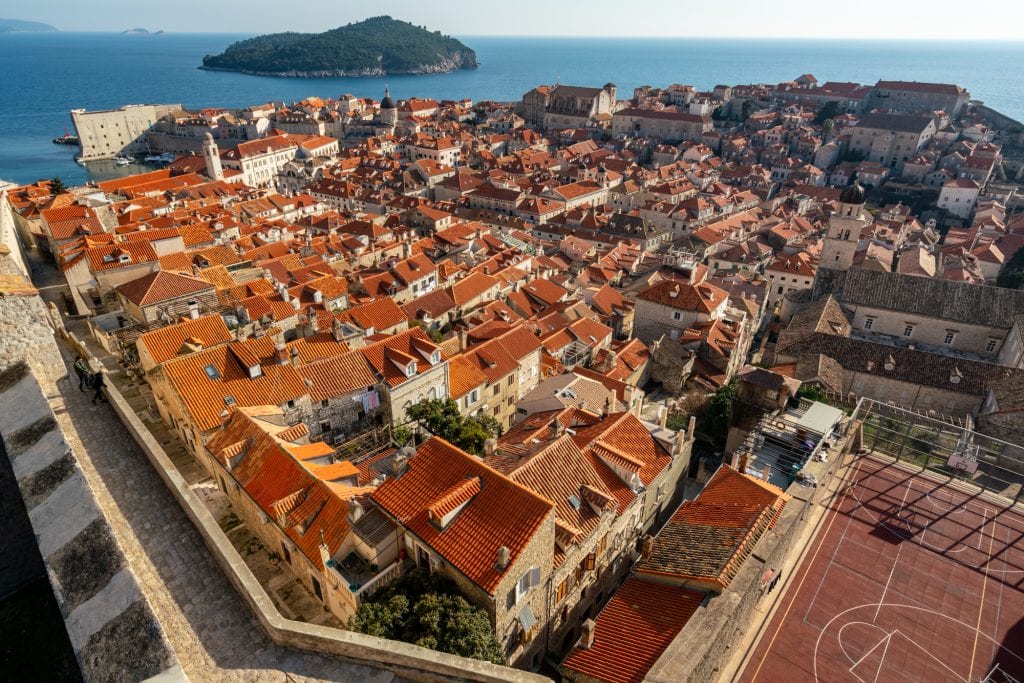
What’s the best month to visit Europe?
All of them, except August.
I kid–somewhat–but honestly, every single month in Europe has its perks!
For a concise answer, the late spring (April-May) and early fall (September-October) are considered ideal by most travelers.
August is specifically difficult because it’s not only very hot in many of Europe’s most popular destinations, but most Europeans take vacations then, so many places (especially in the mountains and on the coast) are at their priciest.
If we absolutely had to visit Europe only during one month for the rest of our lives, we’d pick September, though October is a very close second.

What’s the cheapest month to visit Europe?
It depends–trying to spot the northern lights in Tromso would be one exception to this, for example–but for standard first time Europe itineraries like the ones I outlined in this blog post, January and February are often the cheapest months to visit.
When the Christmas markets are over and the gray weather settles in, you can score great deals on vacations in Europe (and have plenty of room to stretch out at iconic monuments).
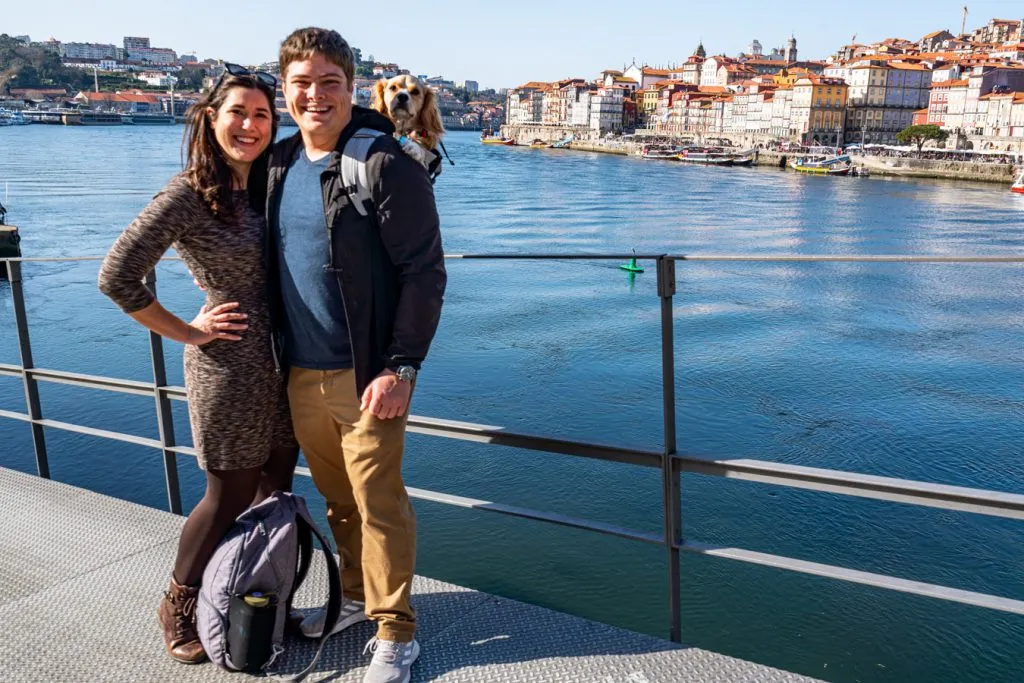
How far in advance should I book my trip?
For plane tickets, as soon as you can commit to dates!
Not only will this allow you to have more time to plan and budget with a bit of structure, but it will also spread out your costs a bit more.
During peak seasons, like coastal locations in the summer or popular destinations during the Christmas season in Europe , you’ll want to book your hotels as far in advance as you can commit to them as well.
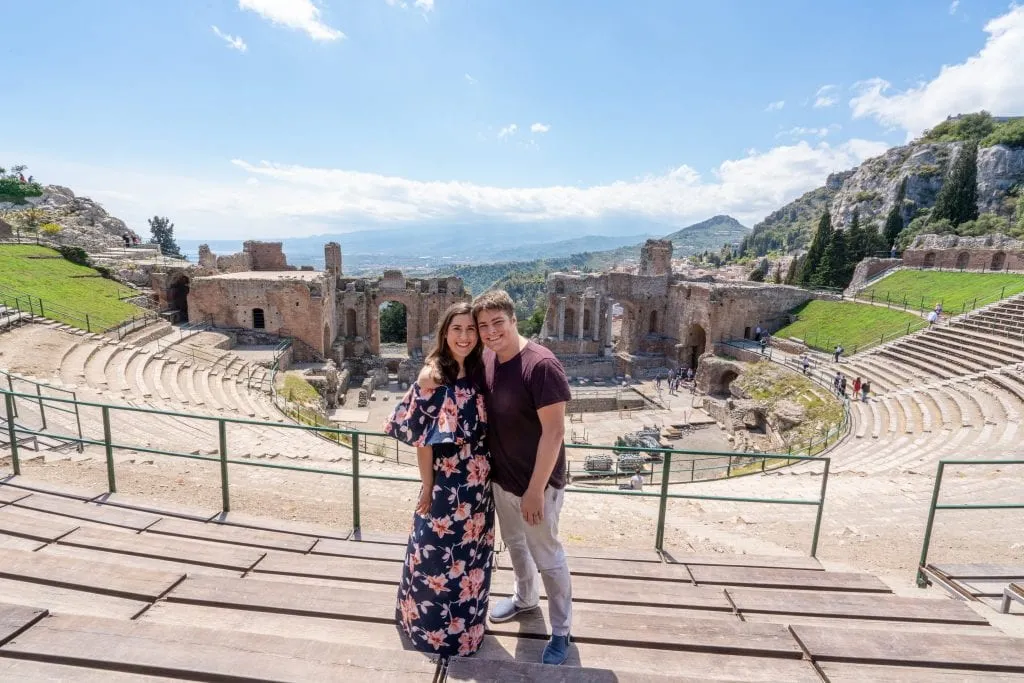
Can you do Europe for $100/day?
This depends a lot on the traveler, group size, etc, but my initial, instinctive answer is:
If you don’t include plane tickets to and from Europe, yes, absolutely, without a doubt–we’ve done it many, many, many times (as a couple).
The key is to shop for deals, visit during the off-season, not shy away from less common destinations (especially in Eastern Europe and the Balkans), and travel slowly.
The fewer destinations you visit, the cheaper a trip generally is!
If you want to stick to Western Europe, southern Spain , southern Portugal, and southern Italy can all be bargains (as compared to places like Paris and London) as well.
Here’s how we manage our travel budget.
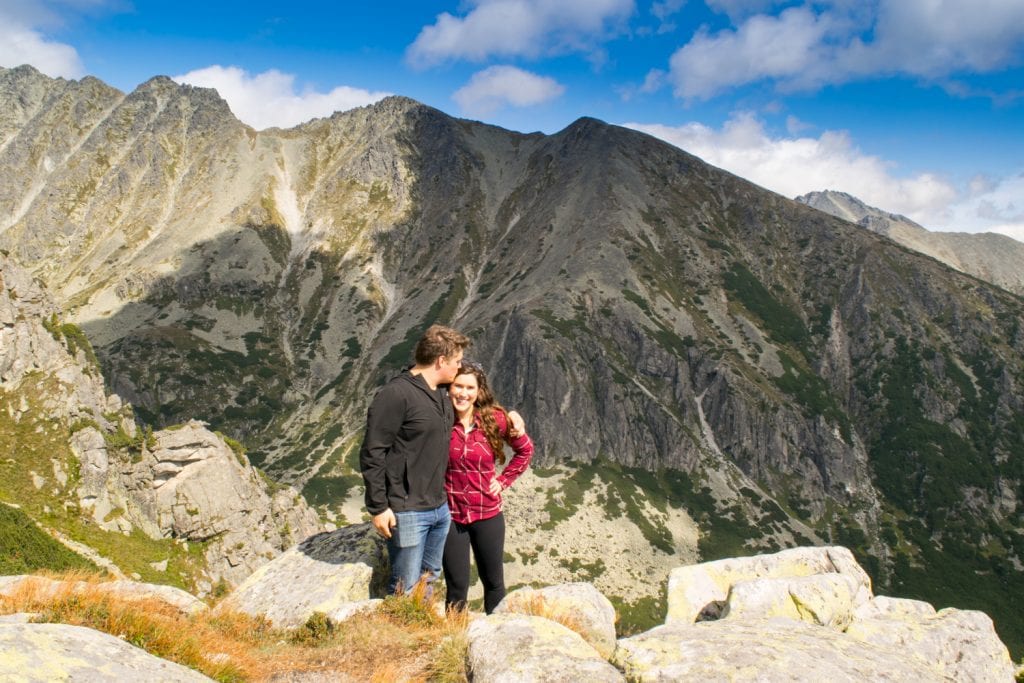
We’ve put together detailed packing lists for various seasons in Europe, so be sure to check out our complete suggestions for spring , summer , fall , and winter before you head off on your 2 weeks in Europe.
We go into far more detail on what to wear in Europe there !
To get you started, though, here are a few essentials that should definitely be at the top of your list .
Travel Insurance — We don’t ever suggest traveling without travel insurance–anything can happen, and it’s better to be safe than sorry during your 2 weeks in Europe.
Check travel insurance policy inclusions and prices for your trip here.
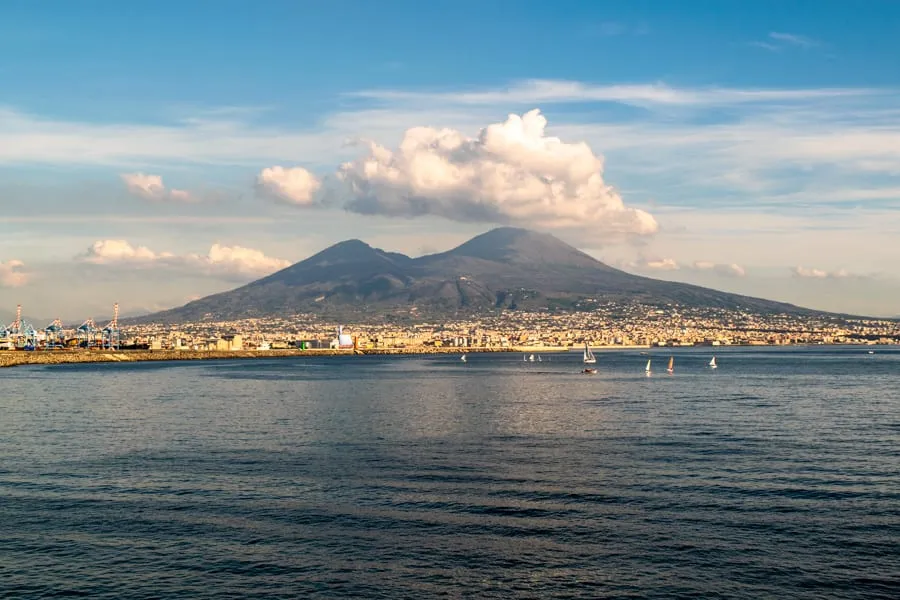
Pacsafe — We can’t recommend our Pacsafe enough!
This travel safe is affordable, sturdy, easy to pack, and will help keep your valuables safe in your hotel room (not that you should need to worry much about theft from your hotel room during your trip to Europe, but it’s better to be safe than sorry!).
Comfortable Day Bag — We currently use Pacsafe’s sleek anti-theft backpack and love it, but if you don’t want to shell out the cash for this trip, that’s totally understandable.
Just aim for something comfortable to wear, not flashy, and medium-sized–we used a Northface Jester backpack for years and loved it as well.

Travel Adapters for Europe — If you’re coming from outside of Europe, you’ll definitely need adapters for your electronics.
Be sure to check the requirements for any particular countries you visit–the United Kingdom, for example, is well-known for using different plugs than most of the continent.
Portable USB Charger — Don’t stress about your phone dying while you’re sightseeing!
Add a portable charger to your 2 weeks in Europe packing list.
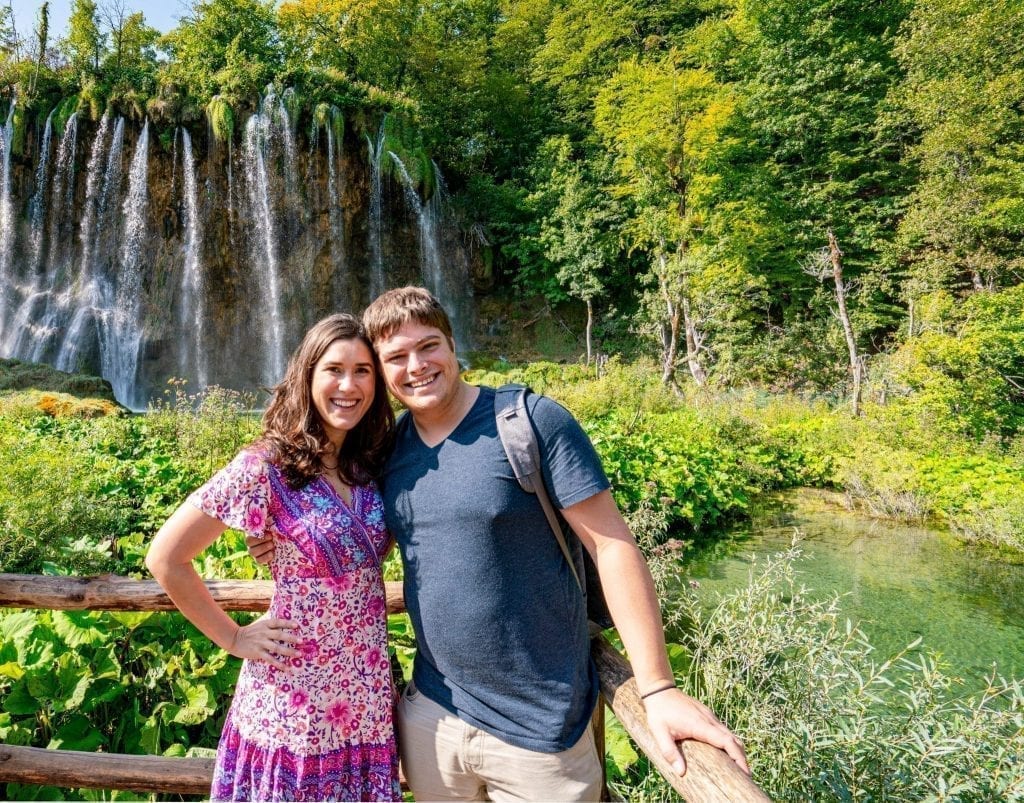
Hand Sanitizer — We carry this everywhere, and never been sorry to have it floating around in our day bag.
Travel Journal — If you want to keep a travel journal during your 2 week Europe trip but can’t commit to a huge amount of writing each night, I can’t recommend the One Line a Day Journal enough.
I’ve been using it for more than 5 years now (I’m on my second volume!) and I absolutely love it.

In the process of booking your Europe trip and eager to keep planning?
We’d love to help!
You can browse all of our general Europe blog posts here , find articles about specific places through our destinations page , or check out these guides:
- Your 13-Step Guide to Traveling to Europe for the First Time
- The Perfect 2 Week Spain and Portugal Itinerary (+ Essential Tips!)
- How to Travel Europe By Train: The Ultimate Guide (+ Tips!)
- 11 Quick Tips for Finding + Using Toilets in Europe
- Prague, Vienna, Budapest, Beyond: Epic Central Europe Itinerary
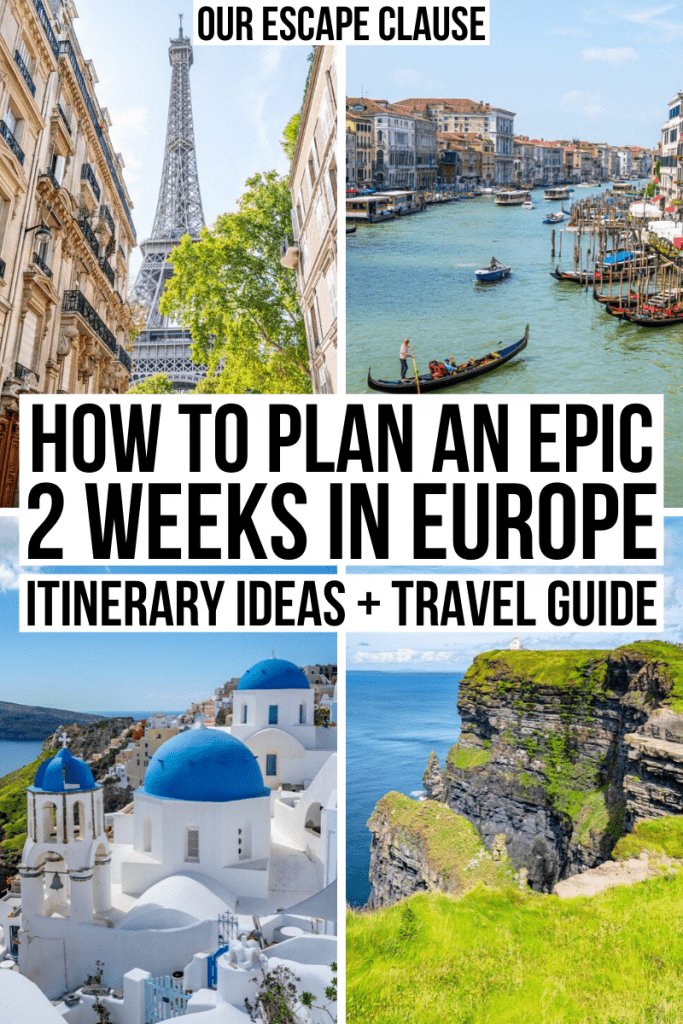
About Kate Storm

In May 2016, I left my suburban life in the USA and became a full-time traveler. Since then, I have visited 50+ countries on 5 continents and lived in Portugal, developing a special love of traveling in Europe (especially Italy) along the way. Today, along with my husband Jeremy and dog Ranger, I’m working toward my eventual goal of splitting my life between Europe and the USA.
58 thoughts on “How to Plan an Epic 2 Week Europe Trip (+ Europe Itinerary Ideas!)”
Great post! I’m actually working on my own 2 week itineraries through Europe post, but I might wait to publish until next year, when I’ve visited a few more spots. I totally agree that the key is to slow down and not switch cities every day or two. Three nights is perfect and sometimes more for the big cities. And yes, multi-city flights are so helpful so you don’t have to backtrack!
Thanks, Riana! We definitely love to slow down whenever we can. 🙂
Hi Kate! This is the BEST post related to Europe Itinerary out of the 1000 other posts that I have checked.
I am from India and I am planning for a trip in February end.
I definitely want to visit FINLAND (so that’s definitely in my list). From there, I am planning for Bupadest,Croatia OR Budapest, Prague OR Budapest/ Vienna.
Do you think this will be good for 2 weeks?
Waiting for your reply. And thanks a ton for such a beautiful detailed post.
Thank you so much, Akshay, that’s wonderful to hear!
That sounds like a wonderful itinerary. Croatia is a bit further out of the way than the other places, but it’s peaceful and beautiful during the winter and fairly simple to get to via a budget flight.
Hope you have an incredible trip to Europe!
Oh my goodness Kate, thank you so much for this post! This is exactly what I needed for my boyfriend and I to plan our trip to Europe in 2020. We want to visit Italy, Spain, France, and England but Greece and Croatia look amazing too! It’s so hard to decide.
Thank you, Jessica! So glad you found our blog helpful.
It is SO hard to decide, and honestly, it never gets any easier in my experience! All of those places are absolutely amazing, so no matter what you decide I’m sure you guys will have an incredible trip.
Italy, France, and Spain are really easy to pair together if you want to keep logistics simple, but really any combination of those would work.
What about panning around the seasons? Isn’t the Amalfi coast and Italy in general super hot during August?
It’s always nice to plan around the seasons when you can, but it depends on your availability!
Italy can be hot in August but it depends very much on where you go. It averages around 85 F / 30 C on the Amalfi Coast in August, which I have to admit isn’t enough to bother us, but it depends on where you’re coming from. It is high season there, though–very, very generally speaking, August is an expensive and crowded time to visit beaches in Europe because it’s when many Europeans tend to take their vacations and head to the coast!
Planning a trip in 2023-24 for my daughter’s graduation present. I was thinking maybe 2-3 weeks. On this trip, how much did you spend in total? I might end up being more because I usually pay for more luxurious than most, but will help with a little expectation of costs plus COLA increases obviously over the years. I figured I should start planning and saving now. lol
Hi Steven! We put this together based on years of traveling in Europe, so unfortunately I don’t have a specific figure to offer. So much varies, and can be impacted by where you go, how fast you travel (ie, how many times you change destinations), of course luxury as you mentioned, etc, etc. Generally speaking, for two people, I would say that $100/person/day is a good lower-midrange figure to calculate (excluding airfare), $200/person/day starts edging toward luxury territory, and of course, the sky is the limit.
That’s INCREDIBLY general, though. You’d be better off narrowing down which countries you plan to visit and calculating based on how long you plan to spend in each of them.
A few things to look at to give you an idea: price of hotels, price of day tours, projected cost of moving between destinations, and average cost of a meal. Those figures should give you a backbone to estimate a budget from.
What brand are the boots you are wearing in the photo “Comfortable Day Bag.” My wife loves them. Gift idea for when we go to Europe 🙂
Those are Ugg Kesey Motorcycle boots, and I love them too! Just got them out again for fall last week. 🙂
Hi kate I am planning to visit europe sometime in 2023(may/june) with my wife and son. Could you please guide me with an itinerary for 15 days Or so?? Swiss, italy, France, spain. After that we will go to a friend in England. If possible, the expenses involved as well. Thanks
Hi Abhijit! I’m not a travel agent, so that’s a bit beyond my scope. 🙂 Generally speaking, though, I’d recommend parring your itinerary down to 2 countries, or 3 at the absolute maximum. 4 countries in 15 days is a lot of travel! Luckily, all of those destinations pair well together, so you can mix and match fairly easily. Also very generally speaking, Italy and Spain will be the most affordable, and Switzerland by far the most expensive–but that depends a lot on where you go and what you do!
Hey Kate, All your pictures are amazing! What kind of cameras do you bring with you? And do you edit your photos? If so what do you use for that, they are all really bright, great pictures.
Hi Stefanie! Thank you so much! We’ve used different cameras over the years, but our main camera these days is a Sony A7 rIII. We love it, and yes, all the photos taken with it are edited in Lightroom. 🙂
Hi Kate, THANK YOU for the great article! I have booked my flights for a 2 week trip next spring, into London and out of Paris. I’ve been to both cities before, but do hope to get a few days in paris again. It’s stolen my heart.
What do you recommend in terms of getting from London to Rome, fairly quickly, and cheaply? I arrive into London mid-day and had hoped to just figure it out at the airport (Gatwick). Do you think that’s possible?
Thank you so much, Sarah! Your trip sounds fantastic.
I’d definitely plan on flying between London and Rome–it’ll be fastest and most likely cheapest, too. Check budget carriers like Ryanair, etc.
If you’re planning on flying out to Rome the same day you arrive in Gatwick, I’d absolutely recommend booking before you arrive. Be sure to double-check and make sure you’re flying out of Gatwick, too, or have time to change airports.
Hope you have an amazing time!
Oh wow I’m doing the same trip with my 3 sons. And unfortunately is the month that she said it’s the worst to go ..in August…oh well🤷🏽♀️ can’t do anything about it how but I am worried about the expense tho..
Love your information. I’m planning a trip to Italy and then we want to go to Salzburg as well in the summer of 2023. Our first time to Europe. We will be 60 in 2023 and we think we can plan this without going through a company. After reading your information, I feel comfortable. Two questions about hotels and transportation. What would you recommend for safe places for hotels in those two countries? We don’t need luxury but just comfort and clean. Would you recommend using rail between cities in Italy and it looks like you can travel from Venice to Salzburg by rail? Thoughts?
That’s great to hear, glad we could help!
Venice to Salzburg by rail is very doable in a day and a scenic journey. You’ll probably have to make a change, but that’s workable. Personally, we’d opt for it over flying in a heartbeat.
For hotels, I have several recommendations in our specific Venice and Salzburg posts (you can use the search bar to pull up everything we have on both cities). The centers of both places are quite safe, I wouldn’t worry much about that in a well-reviewed hotel.
Hope you guys have an unforgettable trip!
AWESOME Post!!!!
Please let me know if you have posted anything similar in 2020 or 2021. My wife and I are bringing our three teenagers and we will likely choose the Food & History trip. We both would like to speak with you if possible as we are planning our trip for December.
Hi guys! We don’t run tours ourselves, just provide information for independent travelers, but we’re always happy to answer a few questions about possible itineraries!
Hi Kate, THANK YOU for the amazing Pic ,for now i’m in South Africa Cape Town I’m planning a trip to Italy , France & Austria next year 2022 for 2weeks , Would you recommend using rail or Via Road way .
Thank you in advance & best Regards En vous remerciant d’avance et cordialement
Sounds like a fabulous trip!
Rail vs car depends entirely on where you’re going. If you’re sticking to cities, I’d recommend going by train. If you want to enjoy the countryside, a car could be helpful.
You can also mix-and-match, and rent a car for only part of your trip if you’re going to be in the countryside only part of the time.
Thank you for this awesome post, Kate! My husband and I are wanting to take our first international trip to Central Europe early spring 2022 and have reviewed your Central Europe post. What type of difficulties have you faced with international travel during COVID-19? Any issues with a country on your itinerary going into lock-down or no longer allowing tourists from the US?
We haven’t personally run into any issues with lockdowns interrupting our plans but of course, it’s always possible and things are changing constantly.
Most, if not all, countries in Europe are accepting vaccinated and/or tested US visitors now and haven’t shut their borders to US citizens again since the initial reopening. All of the countries included on our Central Europe itinerary are currently among them.
In addition to entry, some countries are requiring proof of vaccination in order to do certain things like eat in restaurants or check into hotels. Portugal, where we are now, is among them. It’s a very simple process as long as you have the paperwork in order!
Generally, if you plan to visit Europe from the US in 2022, we recommend arriving with proof of vaccination, a negative COVID test (check regularly for specifications as your flight gets closer), flexibility, and the expectation that you’ll wear a mask indoors and potentially in crowded outdoor areas.
I am not a public health expert, of course, and European countries all set their own restrictions, but in the early stages of planning, that’s what I’d keep in mind!
The reaction that we’ve seen from readers who visited in the second half of 2022 has generally been that it’s easier than they expected, but as we’ve all learned way too much in the last 2 years, none of us can predict the future!
Thanks so much, Kate! It definitely seems like flexibility is key as well as continuously monitoring each country’s individual rules for a multi-country trip. I think right now Hungary isn’t accepting tourists but fingers crossed that will change soon so we can replicate your trip. 🙂 Cheers to more adventures for you in 2022!
Hi Kate, my family is in the beginning phase of planning our first international trip and have decided on Europe! I really liked your recommendation of arriving and departing from different airports and I think departing from London would make sense (we’ll probably want to spend the most time there). All we’ve decided is to vacation for somewhere between 2-3 weeks, and we want to see London and Ireland (oh and I want to stay at least one night in a castle hotel!). Would you have any recommendations on destinations or experiences to share? Thanks!
How exciting–nothing like your first trip abroad. 🙂
We actually still haven’t been to London, which is a huge shame! Fingers crossed that 2022 is the year.
Ireland, on the other hand, is one of our absolute favorites! If you search “Ireland” on the top right corner of the blog (or on the pop out menu on mobile), all of our blog posts will come up, but this is a great one to start with: https://www.ourescapeclause.com/10-day-ireland-itinerary-ireland-road-trip/
We spent a night in this castle (slash manor house) and had a fantastic time: https://www.ourescapeclause.com/belleek-castle-county-mayo-ireland/
Ireland is one of our favorite places for road trips on the planet. You’ll love it!
Great post, thanks!
Need your advice here 🙂 We will be landing in London, staying there 3 days, then train to Paris (staying in Paris for 3 days). We fly back home from Lisbon and have 3 options: night train to Nice (spend some time there and then a few days in Lisbon), fly to Napoli (spend some time there and then fly to Lisbon) or fly to Lisbon and discover a bit more of Portugal… What would you recommend?
Oh and we are travelling with two teens who have never been to Europe… I’m trying to pack as much stuff, but wonder what would be too much :/
That’s a lot of hard choices! Each and every one of those destinations is a delight (and we’re living in Lisbon right now).
I’d opt for Nice if you’re looking for coastal views, picturesque villages, and something logistically simple. Nice is a delightful city and the day trips to nearby villages like Eze as well as Monaco are phenomenal. It is the most formal and pricey of the 3 cities and will have a resort feel near the coast in the summer.
Naples is a much less manicured city, it’s a love-it-or-hate-it place (we love it). I’d argue that it has the best food of the 3 options, but those are fighting words and many would disagree. The day trips are equally stunning but very different. If you or your family has an interest in ancient ruins, Pompeii and Herculaneum are unmatched. Visiting the Amalfi Coast or nearby islands is also doable, but it’s a trek if you’re staying in the city center. Keep in mind that there’s no train service to the Amalfi Coast proper, you will need a bus, car, or ferry to get beyond Sorrento.
Lisbon is delightful but honestly, our favorite parts of Portugal lie outside the city. Porto, in the north, has a much more regal feel while Lisbon is fairly spread out. The Duoro Valley (also in the north) is magnificent for port tastings and views, Sintra’s palaces located just outside of Lisbon are must-sees, and if you want to head to the south, the Algarve is incredibly striking.
Logistically speaking, I’d make sure you have at least 2-3 days in Portugal at the end of your trip before flying out, regardless. With 3 full days, you can spend 2 in Lisbon and take one day trip (probably to Sintra but the coastal town of Cascais is also easy and lovely).
If you have time to do that and add another stop for 3 full days, I would check detailed flight and train schedules and let that guide you–the logistics alone may make the choice for you.
That got a bit long, but I hope it helps! 🙂
Thanks a lot for the precious information!
Hi Kate! I know you said you are not a travel agent but are open to a few itinerary questions! We have recently done a European Cruise which hit almost all of Italy! We are wanting to go back independently. I am highly interested in Ireland, but would also like to see Paris. My husband is interested in Netherlands, Germany, Switzerland. With a 14 day trip wanted, what areas do you think we should do (based on best places to see, with allotted time?)
& Austria! 🙂
That is a lot of very different places, but you’ll definitely be able to pull together a great trip! I’d recommend narrowing it down to around 3 destinations, 4 if you’re comfortable moving quite fast and two of them are close together.
Ireland is definitely the odd one out geographically, but if you use two one-way tickets instead of flying in and out of the same airport, it can work (it’s what we did on our first multi-country Europe trip many years ago).
Since you’ll likely have 1-2 flights in this itinerary regardless, which destinations you pick can come down to a combination of your absolute favorites and what makes logistical sense. Paris is a very popular place to fly in and out of, so it’ll likely be easy to work in.
I’m not sure which parts of Germany your husband is interested in, but parts of western Germany have simple train access to The Netherlands and/or France.
As far as what places I’d personally visit, Ireland and Paris are two of my favorite places on the planet, so I’m biased! Switzerland’s mountain landscapes are truly beyond belief, so if you’re looking for nature (and aren’t concerned about the budget), it’s a winner.
Germany is also gorgeous, both its nature and many of its cities, though it’s quite big and varied–with a big trip like this, you’ll want to choose one small corner of it (Bavaria is a popular first stop, but you can also look at places along the Rhine, which makes more sense if you’re hoping to visit Paris or The Netherlands by train before or after).
The only part of The Netherlands we’ve had a chance to visit so far is Amsterdam, which is visually stunning but will be extremely crowded–probably more so than anywhere else you’ve listed, as there’s less room to spread out there than in, say, Paris.
When it comes to your itinerary, I’d recommend that each of you pick one place that is your absolute first choice, plan on a trip to those, and then fill in the 3rd and possible 4th destination based on what makes logistical sense as far as what planes/trains/buses are available to the spots on your shortlist.
Also, if you do need to book high-speed train tickets, book them ASAP, as prices increase as your trip gets closer.
What a wonderful blog, just when I feel like I’ve read them all I find another really helpful article. Heading to Europe for 1 month in May. Keen on Spain, definitely Italy, and probably 2 days in London and Paris respectively (arrival and departure). Feel like we have space for one more place and can’t figure out which is the better option (Portugal, Croatia or Greece) for potentially 5 days? Any recommendations?
Thank you for sharing all your wonderful insights.
That’s tough, because all 3 are fantastic but very different!
I’d probably recommend (if I had to choose), Greece for beaches/swimming and small towns, Portugal for cities, and Croatia for a combination of all. But we adore each and every one of them, so hard to go wrong!
Portugal fits nicely into your Spain section geographically, so there is that to consider.
Hi, Kate! Super love your blog. I just booked a trip to Europe for August, was thinking of going to France, Spain, and Italy in 2 weeks. Or should I cut it down to 2 countries? Hope to hear from you!
Less relevant than the countries are the destinations within them–I wouldn’t go more than 4 places in 2 weeks, max.
So if you’re hitting up Paris, Barcelona, and Rome, for example, your plan is fine. If you want to go to 2-3 places within each country, it’s time to cut it down. 🙂
HI! Thanks for the fantastic blog! My husband and I are planning our first trip to Europe from Canada and are feeling quite overwhelmed by all the choices! His family is from Holland, so we are spending one week touring with them for the first week of May, and then will stay an additional 2 weeks after that. What would you recommend? We are not keen on France but everything else looks so great, and it was good to read that you don’t recommend trying to fit everything else in, which is what we might otherwise be trying to do. Any suggestions for the 2 weeks after Holland?
Hi Michele,
That’s so exciting! You guys are going to have an amazing time.
Without knowing your tastes or the season you’re traveling, the sky is truly the limit when planning your itinerary! Anywhere that sounds exciting to you is going to be worth it. With 2 weeks, I’d opt for 1-2 countries and no more than 4 base destinations (3 would be even better).
I started trying to make a list of some of our favorite countries in Europe for you, but just backspaced the sentence because I was ending up just listing every country, LOL. But Italy is one of our special favorites that we would recommend to just about anyone!
We will be in Holland for the first week of May so we could do the other two weeks either before or after that (or split one before and one after). The suggestion to cut down to less rather than more is helpful – it’s our first time to Europe and everything looks like something we should see! We are 50 and really like most things – some scenery, some castles, etc. Do you think it would be do-able to do Germany and Italy on top of Holland? Any specifics on what you love in Italy? I am really NOT a crowd person, so we’re really going to try and avoid huge crowds or I’ll lose my mind 😉
A week in Germany followed by a week in Italy is definitely doable!
Personally I’d opt for either southwest Germany (Black Forest, Heidelberg, Burg Eltz) or Bavaria.
We love virtually all of Italy, but if you want something somewhat more offbeat that’s in the top half of the country (for geography reasons), I’d recommend looking into Emilia-Romagna.
It’s the region east of Tuscany, and has similar appeal with far fewer tourists. It’s also gorgeous and a culinary dream–Emilia-Romagna is the origin of many iconic foods like parmigiano-reggiano and traditional balsamic vinegar.
A few destinations in the region to poke into as you research: Bologna, Parma, Ravenna, Ferrara, Modena. The micronationa of San Marino is also accessible from there!
Kate-what a remarkably comprehensive, detailed and resourceful blog! I love the considerations offered from different perspectives. My family of 4 (including 2 kids ages 10 and 6) will be traveling to Paris for the second half of August for 2 weeks to visit family. We have already been to Paris a few times so this time around, I would like us to explore more of Europe for some of the time, ideally via trains. I am thinking of staying in Air B&B’s as we have been enjoying that accommodation when we travel locally within the US but would love your perspective on this (vs hotels) considering the cultural and language differences in certain destinations as well as any recommendations for either you may have. Based on some research, some destinations I came cross purely based on travel distance via train from Paris are Switzerland (3 hrs), Barcelona (6.5 hours! would probably have to be an overnight train for the kids), London (2 hrs, have family we can see), and Greece (2 hours), Belgium (1.5 hrs, also some family we can see). My goal is to show my kids/family different cultures, ways of living and experience foods, interesting architecture, beautiful cafe’s etc. Also curios if any of these can be “day trips”. I do not have specific destinations yet to see at these locations and would love your input. From your article, it sounds like limiting to 2 destinations maybe best (outside of Paris) and your thoughts may help me narrow down where to focus. Thanks so much and look forward to reading your insights on this.
So glad you found it helpful, Tez! Sounds like you guys have an amazing trip planned.
I’m sure you already know this, but August is the height of peak season for European travelers visiting the coast and mountains, so some destinations will be quite crowded and expensive (book your hotels and train tickets ASAP, especially in a group of four).
I’m assuming Greece is a typo, so I’ll pass over that one–pretty sure it’s much further than 2 hours even by plane. 🙂
Luckily Paris is a huge train hub for getting across Europe, so you have plenty of options! Most of them will take longer than it looks on the map once you navigate connections, train times, etc. We highly recommend using Omio to search exact routes and dates, and keep in mind tickets will increase in price as you get closer. With kids, you’ll probably want to search by the fastest available routes.
London, Belgium, and Switzerland all jump out at me from your list–simple to access and incredible. The Jungfrau region in Switzerland is pure paradise, though a bit further away.
You may also want to look into Amsterdam, it’s only 3.5 hours from Paris by train.
With the right schedule, you can get as far as Venice in a day from Paris (we’ve done this), so Italy is an option for you as well, as is Germany.
Essentially, the more you stick to major cities, the easier it will be to navigate solely by train. Smaller towns and cities are often connected, but you’ll virtually always need to pass back through the main city of a region to make your way back to Paris.
You may want to take a look at this post as well, we talk a lot more about train travel here: https://www.ourescapeclause.com/travel-europe-by-train/
Hi Kate Love your blog, lots of useful information. My husband and I are planning a 10 day trip to Europe end of April to early May. At the moment we are looking at flying from the US RT to Paris. We’re thinking of possibly going to Amsterdam and Belgium as well. this will be our second trip to Paris. We are open to other suggestions. Do you have any other recommendations?
Happy to be able to help, Daisy!
Paris + Amsterdam + Belgium is an excellent itinerary and doable in 10 days. It’s actually a route we recommend ourselves. We have posts on all those places, but here are our suggestions on spending 3 days in Belgium to give you an idea of what you can cover in a short time frame: https://www.ourescapeclause.com/3-days-in-belgium-itinerary/
Paris is extremely well-connected by rail (you can be in Venice in 9 hours or Munich in under 6, for example), so as far as ideas for other destinations go, the sky is the limit!
If you choose to extend your original itinerary, a few additional places that you might consider along that route are Strasbourg/Alsace, Heidelberg, and Cologne.
Thank you for your blog.. We are travelling to Europe for 14 days the end of May. Flying Calgary to Dublin, doing a couple days at the Isle of Man races then hopefully, London, Paris, Rome. Your blog shares what to pack for clothing in Summer, Fall and Winter, what would you recommend for spring? We are trying to decide if we take the trains or flights from London, Paris and Rome. We aren’t planning any beach time. Also, what do you recommend for luggage? I’m leaning towards a rolly carryon but have every size hard shell case and multiple back country camping packs.
So happy you find it helpful!
Funny you mention spring packing ideas–I’m actually working on a post for that right now. It will hopefully be up next week. But off the top of my head, you’ll definitely want a travel umbrella and to pack in layers. The end of May is a beautiful time to be in much of Europe but the weather could be unpredictable–you may want sundresses on some days and light jackets on some evenings!
As far as luggage, either is completely fine. There are advantages to both backpacks and suitcases, but as long as you’re comfortable carrying your bag up and down staircases, carrying (or rolling) it down the street for 10+ minutes, and loading it into and out of trains and/or cars, you’re good.
As far as trains vs planes–London to Paris can definitely be a train, but do a time and cost-benefit analysis between that and a plane (depending on the dates, your travel style, etc, you may choose either). Paris to Rome is better done as a flight!
Thank you very much for sharing your wisdom. We are really excited.
Hi Kate, Thank you so very much. You have provided an AMAZING amount of helpful information. Can you pretty please help me with the best location to travel to 1st, 2nd, 3rd & 4th and the best way to get to the locations? (We will NOT be doing any driving).I’m a 55 years old woman. I live in USA. I’m planning the 1st International trip for me and my husband for either the 1st or 2nd week of September 2023. My biggest challenge is knowing where to start and end the trip, based on logistically traveling to the different destinations, as well as, the best way to get to each destination.Here are the the things I have planned. I know you mentioned you’ve never been to London but i’m hoping you can assist based on me providing the area I want to be in. *LONDON-7 NIGHTS I’m a theatre/adrenaline junkie person so Theatreland West End of London near (North of the River Thames. 3-Plays (evening events) 2-Hour Sherlock Holmes museum (near West End) 1-Hour Ghost Bus tour (nearest tube stations are Embankment and Charing Cross) 4-Hours-day walking tasting tour (near London Bridge Station) 1-day Harry Potter Studio Tour (Leavesden London) 2 -Nights Theme park “Alton Towers” located Alton, Staffordshire near Manchester and Birmingham. (stay onsite at the parks resort)*PARIS-3 NIGHTS Moulin Rouge (BD de Clichy area) L’ATELIER DES LUMINERES -DIGITAL ART MUSEUM I would like to visit just one of the haunted castles in Paris (depending on recommendation) Château de Puymartin Château de Brissac Château Lagorce Château de Chambord Château de Versailles* GERMANY 3 NIGHTS-Phantasialand Theme park (located Bruhl Germany) Stay onsite at the parks resortThank you for any advice or suggestions you can provide.
Hi Melvina,
I definitely can’t speak to getting around London in detail, though a combination of the tube and buses will likely be doable! You can add cabs as needed as well.
In Paris, the metro is so dense you should have no issue getting around. Assuming you are planning to do the usual Paris sights (Eiffel Tower, Louvre, etc), our Paris itinerary might be able to help you out (and has hotel recommendations): https://www.ourescapeclause.com/3-days-in-paris-itinerary/
For the chateaus, Versailles is by far the closest to Paris and you can get there by RER train. Château de Chambord in the Loire Valley is doable via an organized day trip like this: https://www.getyourguide.com/paris-l16/loire-valley-castles-wines-day-trip-from-paris-t70389/?partner_id=1OI4D21&utm_medium=online_publisher&placement=content-middle
The others are way too far from Paris for day trips, so I’d focus on Versailles and/or Chambord this time.
Hope you have a wonderful time! 🙂
Thank you so very much.
Hi, thank you for this comprehensive post! We are planning a trip this summer and will be going to Paris, Rome, Florence and Amsterdam. My question is about changing money. We were in Iceland last year and used Apple Pay or credit card everywhere, never needed cash and didn’t get any. Is that possible in either France, Italy or Netherlands? Should I plan on getting cash for taxis, tips, etc?
Happy to help!
I’d definitely recommend having some cash with you as you travel, especially for small purchases like coffee, gelato, etc. Most hotels in Italy will require the city’s tourist tax in cash, too. Some taxis and tips will be best done in cash as well, and occasionally very small, offbeat tourist attractions.
While cash-only restaurants definitely aren’t the norm in any of those cities, they’re not unheard of, either.
Overall, I’d say you’re most likely to avoid cash entirely in Amsterdam and most likely to use some of it in Rome and Florence, but that’s not a hard and fast rule by any means (I used some cash on my trip to the Netherlands last spring, for example).
We find that the easiest way to get cash, by far, is to withdraw Euros from any bank’s ATM once you’re already in Europe (avoid Euronet–use an ATM branded by an actual bank). Luckily, since all the places you’re visiting use the Euro, you won’t need to worry about changing currency beyond that. 🙂
Hi Kate, thank you for this great, and helpful post! We’re are planning a trip to Europe for the first time in September for next year in 2024. My plan is to visit Spain, Italy and I’m still undecided on the third country to visit. What country would you suggest or advised that we can visit that has beautiful scenery, mountains, lakes, etc. We like the city, but we also want something where we can hike out in nature like Iceland maybe, Switzerland. Any tips on that? Also, is it cheaper to stay in hotels, Airbnb’s? Thank you!
Spain and Italy–two of our favorites! You guys are going to have a great time. 🙂
The hardest part about picking a third country with your criteria will be narrowing it down between many excellent choices–you really can’t go wrong.
Switzerland is absolutely spectacular, if the Alps are what you’re looking for, it’s iconic and hard to beat in every category except the price tag.
Germany and Austria also offer beautiful mountains and lakes and are a more budget-friendly than Switzerland.
The French Alps are also wonderful–towns like Chamonix and Annecy offer plenty of mountains, lakes, etc.
And, for a a wild card, you don’t necessarily need a third country at all: the Dolomites in Italy have everything you’re looking for.
Any of those that appeal to you and fit your budget will be a great addition to your trip. They’re well-connected to Italy and each other by train, the travel times aren’t too far, and they’re all phenomenal places to visit.
One small thing to keep in mind if you’re planning to travel by train a bunch is that Spain isn’t very well connected to the rest of the places you’re considering by rail–you may want to consider flying in and out of there.
Iceland is definitely far out of the way, but assuming you’re traveling to and from North America, look into the Icelandair stopover program if you want to add it on! I will say that while it does offer mountains, lakes, and beautiful scenery, it’s a very different vibe than Switzerland or any of the surrounding Alpine countries, so take a close look at the specific destinations and see if it’s what you’re looking for. It’s a stunning place, just very different than the others. Here’s one of our Iceland posts if you want to get a feel for it: https://www.ourescapeclause.com/10-day-iceland-ring-road-itinerary/
Leave a Comment Cancel reply

How Much We Spent Traveling in Europe for Two Months
Ali Real Travel Budgets Amalfi Coast , Belgium , Bologna , France , Italy , Luxembourg , Netherlands , Rome , San Marino , Vatican
When Andy and I set off on our Beyond Vacation kick-off trip , I decided to keep track of every penny we spent. There were two reasons for this. We’ve never really tracked our travel spending, and I wanted to know how much it costs for us to travel for more than a week or two. And I wanted to be able to share with you how much it costs to travel to the places we visited in Europe. I will have posts later that break down our spending by location. So how much does it cost to travel Europe? Here’s an overview of how much we spent traveling in Europe for two months.
How much does a trip to Europe cost
The following amounts are for two people. All numbers are listed first in euros, second in US dollars.
2,959.40€ / $3,924.47 – accommodation 1,335.60€ / $1,771.31 – trains 295.60€ / $391.81 – other transportation 2,056.78€ / $2,726.21 – food and alcohol 205.80€ / $272.80 – activities 130.04€ / $172.40 – miscellaneous 6,983.22€ / $9,259 – total
As you can see, Western Europe is not cheap. We traveled through Luxembourg, the Netherlands, Belgium, France, and Italy, plus side trips to the tiny countries of San Marino and the Vatican. Andy and I are not bare-bones budget travelers, but we aren’t luxury travelers either, so this should give you a decent middle of the road view on costs. You can spend less backpacking in Europe by traveling a little differently and choosing less expensive destinations.
Accommodation costs in Europe – 2,959.40€
We spent 52 nights away from our home. Most of this was in apartment rentals, but there were a few nights in hostels and hotels, plus one night spent on an overnight train. 2,959.40€ divided by 52 nights comes out to an average of 56.91€ per night.
We didn’t pay for 15 nights of lodging. The night on the train was technically free accommodation since the ticket price is entirely included in the train category. We also got complimentary accommodations in the following places: 2 nights in Rotterdam for the post-conference press trip; 2 nights in a hostel in Nice and 3 nights in a hostel in Naples , both sponsored by Hostelworld; 7 nights in Bologna as part of BlogVille, sponsored by Emilia-Romagna Tourism. If we had paid for those ourselves, I estimate we would’ve spent another 1,100€ for 14 nights.
So 2,959.40€ divided by the 37 nights we did pay for averages out to 79.98€ per night, roughly 40€ per person per night. I think this is pretty good considering how expensive hotels can be in Europe. Renting apartments as often as possible definitely helped keep our costs down, not only in this category but also in the food category.
Click here to grab a credit towards your first stay with Airbnb!

Train costs in Europe – 1,335.60€
This was a plane-free trip, so our major form of transportation was by train. The train system in Europe is generally really good, and I’m starting to like train travel more and more.
We looked at getting InterRail passes (like Eurail passes, but InterRail is for European residents) but after some research decided it wasn’t worth it in our situation. Since we had all of our dates set ahead of time, it was cheaper to book the train tickets ahead of time in most places. Train passes would’ve worked if we were booking at the last minute. There were a few trains we bought tickets for at the last minute (in the Netherlands and Belgium, and short distances in Italy) because the prices were almost the same and we wanted to leave ourselves some flexibility.

Other transportation costs in Europe – 295.60€
This is almost entirely public transportation, such as buses, metros, and trams. We used public transportation a lot since we were mostly in big cities and the distances were too far to walk. Almost each city we were in offers some kind of day or multi-day pass for their transportation system, but not all of them were as economical. There is one ride in a taxi and a round trip boat ticket in here as well.
Rotterdam Tourism covered the cost of our local transportation for the 2 day press trip including this crazy tuk tuk and a water taxi. Emilia-Romagna Tourism covered the cost of the van that took our whole group on a weekend excursion, but we paid for our transportation for things like getting to Gelato University and to Modena for the vinegar tasting .
>>See how much my Paris trip cost .

Food and alcohol costs in Europe – 2,056.78€
We did our fair share of eating (and drinking) out, but we purposely rented apartments so we could eat breakfast in and make our own meals occasionally. We almost never bought breakfast out, we went grocery shopping when we stayed in apartments, and didn’t eat at fancy restaurants. We certainly could’ve eaten in even more often, but we also wanted to make sure we were trying the local food.
We had a few lunches covered at the travel blogging conference, all meals on the post-conference trip were covered, and a few meals were covered during BlogVille. Overall we paid for almost everything we ate or drank, and I’m estimating about 3 days worth of meals we didn’t have to pay for.
2,056.78€ divided by 50 days averages out to 41.14€ per day, so just over 20€ per person per day. Not bad considering how often we ate out, drank out, and indulged in gelato. (Check out Andy’s post about the best sandwich ever .)

Europe activities costs – 205.80€
This number includes visits to Vianden Castle and Castle Gravensteen , the Anne Frank Museum , the tulip farm , the Cantillon brewery , Mini Europe , renting beach umbrellas, and a few other things like that. It is a bit low though because we had quite a few activities covered by the tourism boards we were working with. The things we did in Bologna while we were participating in BlogVille were covered, like our San Marino guide, my pasta cooking class and Gelato University . We also had complimentary tours of Pompeii , the Vatican , the Colosseum and Roman Forum, and a food tour from Walks of Italy. These are all activities we would have paid for on our own if we weren’t able to get them sponsored, and I estimate the cost to be around 700€.

Miscellaneous costs on our Europe trip – 130.04€
The majority of this category won’t apply to most people, but there will always be some other expenses along the way when you travel in Europe, especially if you buy souvenirs. I only had one pair of jeans with me, and they were an older pair, so just a week into the trip they had holes in them and had to be replaced for 39.90€ in Amsterdam. I also bought some earrings the same day.
Because we were traveling in Europe for 2 months, I had to buy contact solution about halfway through the trip. We put our luggage in a locker at the train station in Paris during our train layover so we could find dinner. I bought some postcards, as well as 3 souvenir thimbles for my mom. We also had to spend a whopping 20 cents each to use a bathroom, which I only bothered to include here because I thought it was funny.
We each used our cell phones a little bit while we were traveling, and the extra charges we incurred for using our phones outside of Germany came out to a total of 16.04€. We also had to pay to do laundry 3 times when we didn’t have free access to a washer, and that cost came to 20.60€ total.
Planning a trip to Europe? Click here to check out my itineraries!

Europe trip budget per day
Andy and I spent about 131.76€ or $174.70 per day in Europe. Since we had a lot of activities and accommodation comped, these number should be higher. If I factor in the estimated costs of the things we didn’t pay for, the budget per day comes out to about 169.49€ or $224.73 for two people.
So that’s how much we spent traveling in Europe for two months! Everyone’s Europe trip budget will be different, but this will give you a good starting point for how much money you need to travel Europe. If you prefer more luxurious hotels or budget hostel dorms, you’ll need to make adjustments when planning your trip budget and saving for your own trip. In the coming weeks I will break these down by city and country so you can get a better idea of what it would cost to spend a week or two in some of these areas for vacation.
You might also enjoy:
- How Much We Spent Traveling in the Netherlands
- How Much We Spent Traveling in Belgium
- How Much We Spent Traveling in Rome
- Unconventional Guidebook series with insider tips from locals, by Gigi Griffis
- Or check out more real travel budgets

38 Comments
This is very, very helpful, Ali! We haven’t been to Europe in ages, and couldn’t quite get a handle on what a mid-range trip might cost. We’re hoping to get to France for 3 weeks, sometime in the next year or two. Love the apartment rental ideal. Hope you two had an overall splendid time even though sometimes travel sucks. 🙂
Thanks Laila! Renting apartments does help, and it’s nice to have a little more space than a hotel room gives you. Let me know if I can help you with your planning at all!
You’re so kind! I’m just seeing this now, 3.5 years after the fact. I hope you’re well. I enjoyed reading your Kosovo posts. 🙂
No, Europe definitely isn’t cheap. Especially trains. We look at the cost of trains and 9 times out of 10, it is cheaper for us to drive or fly. And driving allows a ton of freedom.
That’s not horrible for nearly 2 months of travel, but still quite a bit.
Since you guys have a car, it definitely makes sense to drive most times. We don’t have a car, or valid driver’s licenses, so that’s not an option for us. And for the typical tourist coming to Europe from the US or somewhere, renting a car and having to pay for the gas and potential tolls, parking, and everything else normally isn’t worth it. By far our most expensive train tickets were going home, Rome to Freiburg, because we booked last minute. And the overnight train in France was expensive because it was an overnight and requires reservations. The rest were well under 100 euros per person, we just had a LOT of trains!
Thanks Ali. This helps a lot for those of us wondering if Europe is in budget. Always good to have up-to-date info.
Thanks Gillian, glad to help! You can definitely do things cheaper if you’re more conscious of what you spend, but Europe is not the cheapest destination out there.
My daughter and I were in Europe for just over 3 weeks in 2012. Our accommodation budget was 75E per night for two. We ended up pretty close to that. We stayed one night in a hostel and one night on a train (part of the train cost is included in the lodging cost). We did not use apartments, but mostly stayed in small hotels or b&bs. We were in Paris, Amsterdam, Cologne, along the Rhine, Munich, Salzburg, Venice, Bruges and Switzerland. Some places are more expensive than others (Venice 130E) but if you average them out, this budget is do-able. in 2009, we traveled with 6 people and our average was between 30 and 33E per person per night. That time we used some triples and quads which keeps the budget down also.
Sounds like a great trip Phyllis! The smaller hotels and B&Bs are great too, usually cheaper than normal hotels, and usually run by friendly local people. The triples and quads make a lot of sense too when you have a group like that. Andy and I have looked into hostel dorms if we just need a night or two, but for just two of us it’s usually the same to just get our own room. There definitely are ways of traveling inexpensively in Europe, you just have to make it a priority and put a little effort into finding the cheaper places and other ways to keep your costs down.
This is a really good article that outlines the real costs of traveling. Even better you put it into US Dollars as well so international people like me can see the effect of the Euro in real terms.
I’m curious to know which site you used to the find the apartment rentals that you were talking about. I’m interested in renting apartment as part of my future trip to New Zealand but I don’t want it to be a homestay situation where I am living with somebody else. I would much rather pay the money and get the apartment on my own and deal with a complex manager instead. Are there any websites that you can go to that do this on a global basis?
Thanks Matthew, glad to help! The apartments we rented weren’t dealing with complex managers. We Airbnb.com for most of them, and also 9Flats.com for one of them. We’ve also used HouseTrip.com in the past and like that site as well. I’ll write more about apartments soon too, so that will have more details. When you rent through those sites, you usually deal with the owner of the apartment because individuals like you and me list their apartments on there. We have rented a few that are actually run by a company, so you would meet some employee, but it’s really not that different. Those sites are worldwide, and there are plenty of others too, some have more listings in one part of the world, some in others. Airbnb.com is probably the biggest, so I’d start there.
Very helpful and a little intimidating! We travel pretty bare bones, but I don’t know if I have the guts to tally it all it up to the last cent. Can’t wait to hear more about your fabulous travels.
It was a little rough to look at that big number at the end, but I have to remind myself that was 53 days of traveling, so it was never going to be low. If you go a little more bare bones you can definitely do this for less, but you have to decide which experiences and comforts are worth paying for.
I think this is super helpful since most popular travel blogs are written for backpackers traveling on a tight budget. I like how this is somewhere in the middle and a bit more realistic for most people!
Those food pictures made me hungry. Time for lunch!
Happy travels 🙂
Thanks Lauren, I’m glad you found it helpful! I don’t think I could ever be a bare bones budget traveler. We like to have little comforts here and there, we like to drink, and we feel strongly that some experiences are just worth paying for.
Sorry for making you hungry!
It is really not cheap travelling in Europe, now I know. At least being comfortable, having good food and enjoying most of the places to visit can be rewarding. Thanks for the information.
Thanks Jane, glad to help! Europe’s not cheap, but with a little effort it can definitely be affordable and enjoyable.
Fascinating to read this. We take our UK car over to Europe for about 5 weeks for a summer holiday every couple of years. We have found the costs of motoring have increased significantly in that time but because we have access to the car anyway it is still cheaper (and more flexible) than paying for 4 train tickets.
We tend to rent a few apartments in various locations that we know we want to visit as is usually cheaper than a hotel. For journeys in-between our booked apartments or if we just take a fancy to going somewhere we just ask at hotels in the area until we find one with a vacancy. If you wait until the evening they will usually be open to bargaining on the price, we usually figure on getting at least a 15% discount but usually a lot more. Better a full room than an empty one.
It can be a bit nervewracking. I remember one summer we realised we were only 4 hours drive from Budapest so we decided to go. We turned up and there was a convention in town, it took us 3 hours but we found a room and still got the discount.
For 4 people, I can totally understand that driving would be cheaper than having to buy 4 train tickets for each leg of your trip. We don’t own a car (or have valid driver’s licenses!) so driving just isn’t an option for us. Most of our train tickets were relatively inexpensive, but we had a night train in there which requires reservations and ends up being a bit expensive, and then we didn’t book our ticket home until 2 days ahead of time, so it was rather expensive too.
That’s great that you’re able to negotiate lower rates for hotel rooms sometimes! We booked almost every night ahead of time on this trip because we had specific things to do in most places and didn’t have as much flexibility, but I definitely want to take a more flexible trip in the future and just figure things out as we go.
This is such a fantastic breakdown! I really appreciate it when long term travellers take the time to share their cost of travel so that others who may be inspired to consider pursuing their own travel dreams can get a feel for what everything costs. In your case, you have made of point of listing more realistic expenses in regard to non-backpacker travel costs – as well as pointing out and detailing options in regard to sponsored travel! Thank you!
Thanks Mary! We’re not budget travelers by any means, though we do try to keep our costs down. But you’re right, I do hope this is a more realistic look for people who travel in the middle somewhere, not all out luxurious and not penny-pinching budget. I also felt it was important to point out the estimated cost of the things we got for free so others planning their trips have a complete view. I’m glad you found this helpful!
It is a bit scary to see it all out like that. But as you say we knew it was going to be high given Europe and that many nights. We could have cooked in more and drank less, but we also could have done a lot more activities. We essentially didn’t move for a week in Minori and we could have done some boat trips which would have been expensive. It will be a bit of a balance in the future between staying close enough to the things we want to do to reduce public transport cost and the extra cost of being in that place.
Wonderful post, my love.
Yeah, that total number does still seem so high, but we have to remember how long we traveled. And we had some really great experiences and hopefully have learned for next time. Thanks Andy!
I agree, it’s interesting to see it all spread out like that. I’ve been looking at my own travel costs- in the past year or so, I’ve spent many thousands of dollars myself on hotels, rail, food, and so forth. The hotels are the biggest expense by far. My expense tracking app says that so far in 2013, I’ve used 30 hotels at a total cost of $7,015.96.
I think I’ll do a “Cost Of Travel” post myself sometime soon; this is a particularly interesting topic to me.
It’s often helpful to people to see what the cost of traveling is, so that’s why I like doing spending posts. I’d rather spend that money on travel than just about anything!
Ali, Great resource, love the transparency you bring to your accounting post – pay toilette and all *laugh*
Thanks Maria! I really want to make sure people have a realistic view of the costs of traveling in Europe. Glad I made you laugh!
Ali! This is so helpful!!! Brian and I are headed to Europe soon (I’m hiking the Camino, I think we’ll do a bit of Europe afterwards) and I’m worried about budget. So this is so good to know. Thank you!
Thanks Kim! Europe is expensive, but there are definitely ways of cutting costs. If you eat out and cook more than we did, you can cut your food spending (especially since you’re vegetarian) and there are probably a few other things you could cut back on to spend less. Even traveling slower and not going to as many places. We definitely went to fast, and that adds more train tickets and things like that. Let me know if you have any questions!
Aieeeee! After a year in Asia, these numbers are freaking me out! We’re planning to head to Europe soonish, but we are going to have such sticker shock. I balk whenever we are asked to pay more than $20US for a room, so I have no idea what we’re going to do once we hit Europe (CouchSurf, I guess!)… I think we’ll really have to embrace slow travel while we are there, since transport costs will really add up and maybe getting some longer-term rentals can help defray costs. Clearly it’s time to start looking into how we can beef up our travel fund, pronto!
You CAN do it cheaper, but yes Europe is definitely more expensive than SE Asia. Apartments help because, even if they’re the same cost as a hotel or private room in a hostel, you have a kitchen and you can cook some or all of your meals to save money that way. The trains can get expensive, but compare them with flights and the occasional bus to see which is actually the cheapest. Most of our train tickets were pretty cheap, but the overnight train was expensive because it’s an overnight train and requires a reservation, and our tickets back home were expensive because we booked last minute. I’ve never tried CouchSurfing, but it might be a good option. There are also options to just rent someone’s extra room through Airbnb and those sites, and that would be cheaper.
Let me know if you end up coming through Freiburg! If we’re around, I’d love to meet you!
Thanks for sharing with us Ali, Western Europe is certainly expensive. I like reading how much other people spend as I like to compare, but also think its useful for travel planning. I’d like to visit Eastern Europe, I hope thats cheaper!
Glad to help, Jennifer! Eastern Europe should be cheaper. The farthest east I’ve been is Czech Republic and Croatia, both of which are popular enough tourist destinations that they’re closer to Western European prices. But there are still lots of inexpensive countries to explore!
The Cost Of Travel, Part II: My Year By The Numbers | Doin' Time On The Donau September 19, 2013 @ 6:02 AM
[…] over at Ali Adventures recently posted about what it cost for her and Andy to travel through Europe for two months, and also what it cost just for their trip to the Netherlands. This sort of number crunching is […]
I guess that explains why we struggled so badly when we were there last year!
🙁 So sorry! I wish it was cheaper here!
which places did you travel exactly can you write them please and in which months did you have the travel which transportation you preferred by air or by land most of the time
That is all detailed in the post, including the countries we traveled to and that we traveled by train. No planes on this trip.

The Complete 2-Week Europe Packing List
Last Updated on November 15, 2023
by Maggie Turansky
Disclaimer: This article contains affiliate links. That means if you click a link and make a purchase, we may make a small commission. As an Amazon Associate we earn from qualifying purchases. For more information, see our privacy policy.

Putting together a 2-week Europe packing list can prove incredibly difficult regardless if it’s your first trip to the continent or if you are a seasoned traveller.
Especially if you’re trying to travel light and minimalistically, prioritising things for your trip to Europe can be a bit tricky. We have travelled extensively all over Europe and have refined this ultimate packing list in order to ensure that you have everything you need, but also not too much!
So if you’re after the perfect packing list for Europe, then look no further. We’re here to make sure that you’re perfectly well-equipped for your trip without bringing one item too many in your limited space!
Table of Contents
Europe Packing Tips
Before I jump right into what you actually need to pack for Europe, we do need to discuss a few things in order to ensure that you are completely prepared to leave on your trip to Europe.
One of the most important things to be aware of is the season where you’re travelling, along with the region. Europe is vast with an array of varied climates and what you need to bring to be prepared largely depends on where and when you are visiting.
What you eventually end up taking with you really inevitably comes down to if you’re visiting Europe in winter or summer, northern or southern Europe.
Another thing to keep in mind when you’re planning out a packing list for visiting Europe is just how much you plan to bring with you.
It can be really hard to know what you’ll need or use on your trip, especially if you haven’t travelled much in Europe before. However, it is always a great idea to try to limit the amount of stuff you cart around with you.
Packing light can be a lot more pleasant in almost every aspect of travelling, from not having to worry about the weight limits on airlines or hauling your bags up stairs, through train stations and luggage racks.
Packing light also has the added benefit of making your things a lot easier to pack up and move when you move destination. It is unlikely that you will plan to stay in just one location on your trip and you don’t want to have to unpack and repack a bunch of different things every few days – not only is this simply a pain, it can also be very stressful.
The packing list below is quite minimalist, however, in times of travelling for similar-length trips to Europe, I’ve found that it is beyond sufficient.
When it comes to selecting items of clothing, especially, try to stray away from anything that you cannot mix and match and, often, opting for darker colours can be a great option.
Thinking more in the mindset of bringing a small capsule wardrobe rather than individual outfits to wear will help you be able to pack light while also mixing and matching to create a new look every day.
The other tip when it comes to packing light is to find accommodation that offers laundry facilities. Planning to do a wash while on the road will allow you not to have to bring so many things considering the fact that you can do a load of laundry mid-way through your trip.
Many hotels and hostels offer laundry services or, alternatively, you could find an Airbnb that has a washing machine you could use yourself. Laundromats are also always an option, though I can’t imagine it’s the preferable option considering the limited amount of time you have when it comes to exploring Europe.
Finally, when it comes to bringing items such as a hairdryer, curling iron or straightener, I would recommend refraining from this.
The vast majority of accommodations will have at least a hairdryer on-site and, especially if you’re travelling to Europe from North America, the voltage in the plugs is completely different and you risk completely ruining your devices should you use them, even if you are using an adaptor.
All in all, there are a number of things that one needs to take into consideration when figuring out what to pack for Europe. Follow the guidelines below and you should be perfectly well-equipped for your trip!
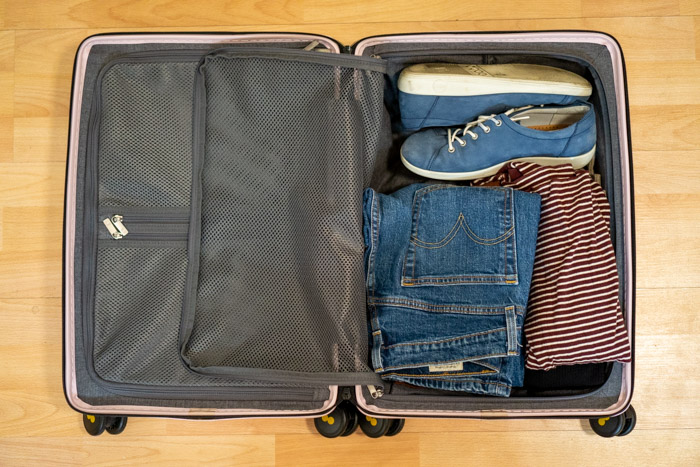
Ultimate Packing List for Europe
This ultimate Europe packing list is perfect for those looking to pack light and be a bit more minimalist in their adventure. While this certainly isn’t a complete bare-bones packing list for those who want to, say, travel carry-on only, it is good for those looking to not bring everything but the kitchen sink.
This is intended that you pack in a larger main piece of luggage (whether that be a travel backpack , wheeled backpack or traditional suitcase) along with a smaller piece of carry-on luggage such one from Level8 .
If you want to keep your items all organised then we also suggest using some packing cubes like the Eagle Creek Pack-It Compression Cubes
This checklist is also appropriate for all sexes and genders, just pick and choose some things as they don’t apply to you.

Figuring out what kind of clothing to bring is arguably the most important and most difficult thing about packing for Europe.
As mentioned earlier, it’s always a great idea to opt for neutral colours and items that you can mix and match to ensure that you can have some variety in your outfits without having to bring too many things and take up necessary valuable space in your luggage.
- Depending on the season or region of Europe you’re visiting, either bring a mixture of long-sleeve and short-sleeve tops, just long-sleeve or just short-sleeve tops to wear in Europe.
- I always recommend bringing one or two nicer tops or button-down shirts along with more casual t-shirts or tops. We like Bluffworks t-shirts as they’re both practical and also look good!
- Bringing one pair of jeans and one pair of another type of trouser is a great idea or one pair of lighter jeans and one pair of darker jeans. Having at least one pair of pants that can be dressed up is always a good idea
- You can browse some of our the best options in our best pants for travel in Europe guide.
- I, personally, love Bluffworks’ dresses , which have concealed pockets, a classic and flattering cut and can be dressed up or dressed down depending on the situation. Oh, it also is wrinkle-resistant and fully machine washable.
- If you’re visiting Southern Europe or simply travelling in the summer months, then having one or two pairs of shorts can be a great idea, especially when you need to keep cool or are heading to the beach.
- If your trip is during winter, having a tank top or light base layer will keep you warm without having to result in a bulky coat or jacket.
- Depending on the season or region, a cosy wool sweater or a light cardigan is a great idea when packing for 2 weeks in Europe. It can also be a good idea if you bring one that can be dressed up or down depending on the occasion (are you seeing a trend here?).
- Of course, you likely don’t need to include a jacket at all if you’re travelling to, say southern Spain or Malta in July, however, depending on the season, a warm, lightweight jacket is always a good idea for your trip.
- We recommend a packable down jacket ( click here for men’s version ), however, we have written a detailed guide for the best jacket for Europe depending on your needs.
- No matter the region or season, a rain jacket is always a good idea, as you can get caught out in a storm regardless of where and when you are travelling.
- We love the North Face Resolve ( click here for men’s version) as it has consistently kept us warm and dry in the rainiest of conditions.
- How much underwear you bring really depends on at what point in your trip you want to do laundry. If you want to avoid washing at all, then go ahead and bring 14 or 15 pairs of underwear. They do take up valuable space, however.
- Like underwear, how many socks (and the kinds of socks) you bring really depends on your shoe preference and just how often you want to do laundry.
- Bringing a swimming suit is a great idea even if you’re not going to a seaside destination. You never know when you may go to a bathhouse, sauna or pool on your Europe trip no matter the season.
- If you happen to be travelling to a beachy destination like Italy or Spain , consider bringing 2 pairs so you have time to dry each suit between wearings.
- I, personally, like to bring one regular bra and one sports bra, but this really depends on your needs and preferences.
- If you’re not a pajamas person, then don’t bother. I am, so I bring them. One pair for 2 weeks is sufficient.

Shoes take up A LOT of space in your luggage so limiting the footwear you bring on your Europe trip can be the ticket for maximising the space in your bags.
We have a complete guide on the best shoes for Europe to help you pick the right footwear for you. This is just what we recommend bringing when you’re compiling a packing list for 2 weeks.
- A good pair of sturdy, stylish walking sneakers is essential. Pick comfortable walking shoes that you can walk in for hours and kilometres and not have sore feet.
- I, personally, love the Ecco Soft 7 trainers and wear them all the time. For a men’s version consider the Ecco Soft 7 Runner.
- Choose your second pair of shoes depending on your style and the season you’re travelling in.
- If you’re an active traveller, are visiting a largely outdoor destination, or simply plan to do a bit of walking and hiking, then a good pair of hiking boots such as the Merrell Siren Edge for women ( available on REI here ) or Merrell Moab 2 for men ( available on REI here ) is essential.
- Small, compact, and helpful for everywhere from the beach to a hostel shower to a public pool, a pair of flip flops should always make it into your luggage!
Accessories
Whether fashion accessories or handy electronic gadgets, some of these are absolutely essential items to bring with you on your trip to Europe!
- The most important accessory of them all!
- Perfect for add a splash of style to any outfit, sipping over your head or shoulders if you’re visiting a church, using as a makeshift blanket, and also for its traditional use, a scarf is absolutely necessary to bring with you no matter the season.
- A warm hat to keep you toasty in the winter in Europe is always welcome, as is a sun hat to protect you from the harsh rays during summer in Europe.
- An essential item on any winter packing list!
- A solid anti-theft handbag like the PacSafe Cityscape or day pack is perfect for keeping your valuables safe and secure while you’re out and about sightseeing and exploring.
- Buying water and using plastic water bottles is a thing of the past. There are an infinite number of great water bottles for travelling to choose from like a Hydro Flask and you’ll never need to buy a single-use plastic bottle again.
- If you’re more serious about your photography than simply relying on your phone, then bringing a good camera is a great idea.
- We love the Sony A6400 for its high-quality images at a decent starting budget and there being several great travel lenses to use with it. Make sure to bring extra memory cards!
- You always need to have something good to read, but don’t want to pack a bunch of heavy books to bring with you – a Paperwhite Kindle solves all of these problems and it is an absolutely essential item if you love to read.
- Buy a prepaid SIM card like the Orange 20GB SIM either as physical SIM or eSIM to ensure you can stay connected in Europe.
- Finding a universal plug adaptor with a number of different USB drives is a fantastic option and is an absolutely essential item when travelling to Europe from elsewhere in the world!
- Finally, a power bank will give you peace of mind should your phone die while you are out and about or if you forget to give something a much-needed charge when you need to use it.
- Making sure you have an adequate number of charging cords for all of your devices will ensure that you can make sure everything can get the best battery life possible.
- A travel pillow is nice to have if you have a long flight or are taking overnight trains or buses.
- World Nomads offers flexible and simple travel insurance policies with coverage for more than 150 activities that you can buy or extend while on the road.
- SafetyWing offers travel medical insurance policies that can are an option for long term budget travellers.
- Save your money and landfill space and forgo the travel-sized toiletries for refillable bottles of your shampoo and conditioner. We love GoToobs .
- You might want to bring earplugs if you’re staying at a hostel or budget accommodation where street noise can be an issue or for your flight.
- To avoid unnecessary spills in your toiletry bag, we recommend using a bar soap rather than a shower gel, but this is really up to you
- Keep your dry skin nice and hydrated!
- Bring as little makeup as you need. Personally, I limit myself to one lipstick, one eyeliner, mascara, a small eye shadow palette, foundation and a few brushes. I also make sure I have facial cleansing wipes for makeup removal and just to wash my face at the end of the day.
- If you’re a lens wearer, you need to pack this!
- Blisters and cuts happen, best to be prepared rather than have to hunt for a pharmacy to find these things while travelling.
- While you can get ibuprofen and the other over-the-counter pretty much everywhere, it’s always nice to have it on hand should a headache threaten to put a damper in your Europe trip. Ditto with other OTC medications you take regularly.
Piecing together the Europe packing list for 2 weeks doesn’t have to be all that difficult if you take into consideration all of the things outlined above. Think minimally and pack light and you’re sure to have a fantastic time on your adventure — wherever it may be that you’re going!
Are you trying to figure out what to pack for two weeks in Europe? Was this packing list helpful for your trip? Let us know in the comments!

Related Posts:

25 Best Travel Accessories for Europe

LEVEL8 Luggage Review: Textured Carry-On 20″ Suitcase

Best Carry On Luggage for Europe: Suitcases & Backpacks

About Maggie Turansky
Maggie is a co-founder and writer for The World Was Here First. Originally from the US, she has lived in five different countries and has travelled to dozens more, both solo and with her partner, Michael. She particularly loves exploring Spain and spending time in the Caucasus and the Baltics. Read more about Maggie
This is a great comprehensive list. It helps to prioritize what is really essential and can serve as a thorough starting point even if you want to tweak it some to meet your needs. I would add socks, belt and 1 or two costume jewelry pieces to the list.
Great list. I reviewed it against my list and they were pretty close. I have been reading your other articles and they have been most helpful. Many thanks!
This is very helpful. Thanks. I always seems to pack too much. Helen
Can most of this fit in a carry on and a personal bag?
This can be really dependent on the kind of bag, how you pack and the airline’s requirements! Sorry I couldn’t be more helpful 🙂
Thanks this was very helpful for a first time traveler 😉
Leave a Comment Cancel reply
Travel Europe on a Budget
The Savvy Backpacker
City Guides .\33 a132798-3f3b-4585-954d-7e70cf863447{fill:#231f20}
Europe packing list | the ultimate packing list for visiting europe.
The ultimate Europe packing list. Advice for choosing clothes, toiletries, shoes, electronics, luggage, and more for Europe.

Packing for your trip to Europe can be stressful so I’ve put together my Europe packing list . This mega packing list will cover everything from clothes and luggage to electronics and toiletries. I’ve even tried to include specific packing tips for summer travel and winter travel.
Interested in packing tips for backpacking Europe? We’ve created a Backpacking Europe Packing List For Women and Backpacking Europe Packing List For Men .
Europe Packing List
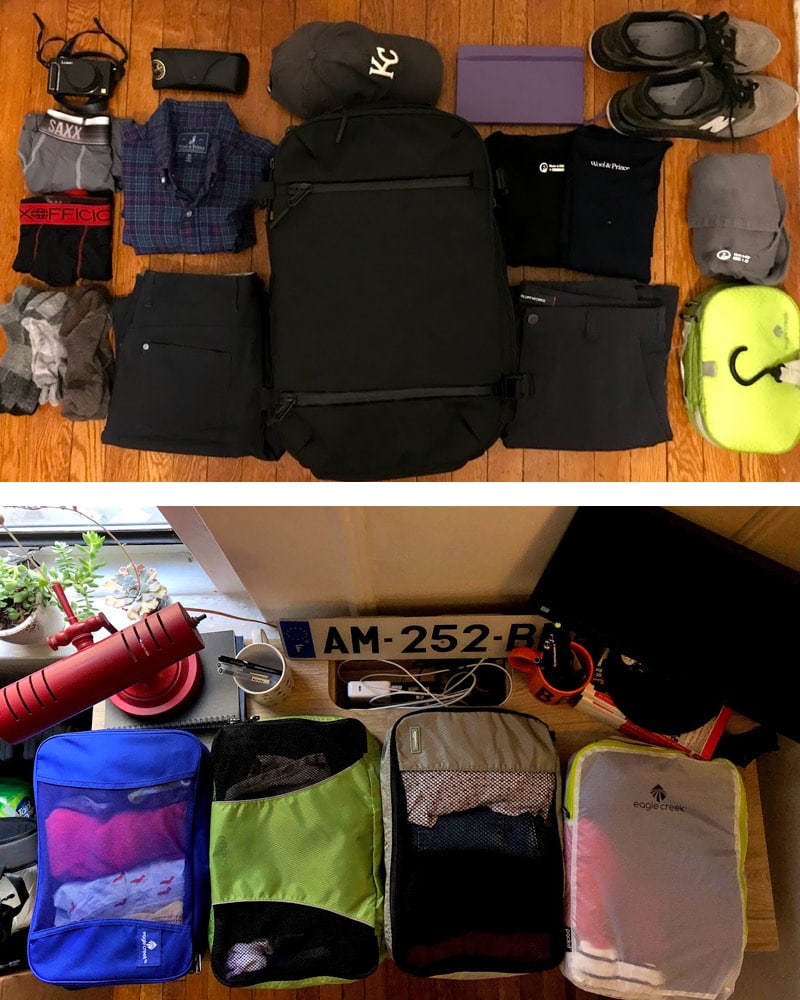
This Europe packing list is very extensive so here is a quick rundown of what you’ll see in this guide. Keep reading to see everything.
Rolling Luggage
- Travel Backpacks
Packing Cubes
Packing folders.
- Toiletry Bags
Travel Underwear
- Travel Socks
- Shoes For Travel
- Shirts & Tops For Travel
- Jeans, Pants, & Bottoms
- Outerwear For Travel
- Winter Clothing
Travel Towel
- Travel Flashlights
- Eyemask & Earplugs
- Water Bottle
- Sleep Sheets
- Travel Laundry
Travel Utensils
- Electric Plug Adapters
Travel Power Strip
- Phone Chargers
Digital Camera
- Travel Hairdryer & Straightener
- Shampoo/Conditioner/Body Wash
- Toothpaste & Toothbrush
- Travel Toilet Paper
- Wet Wipes/Baby Wipes
- Body Powder
- Pepto Tablets
Europe-Friendly Luggage
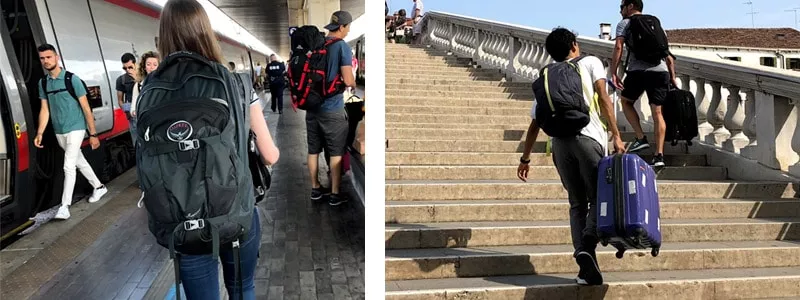
The type of luggage you choose will have a major impact on your travel style.
You essentially have two choices — a wheeled suitcase or a travel backpack . Either option is perfectly fine but both have their positives and negatives (which we’ll cover in this section).
Before I talk about luggage, I want to reiterate the idea of packing light because traveling light makes moving around easier and more enjoyable.
Rolling luggage is the most popular style of luggage for traveling in Europe. It offers a lot of benefits but it’s not always right for everyone.
Rolling Luggage Benefits
- Weight Isn’t a Huge Concern: You don’t have to worry about weight as much since you’re pulling your bag. This can lead to overpacking — which will make carrying your bag up and down staircases and into luggage compartments more difficult.
- No Back Pain: Not everyone can strap on a heavy backpack so rolling luggage is much more ideal in these cases.
- Rugged: A quality suitcase can take a bit more punishment than a backpack because they’re designed to be thrown around a bit.
- Ideal For Door-to-Door Travel: If you plan on taking taxis from your hotel to the airport/train station then traveling with a suitcase makes sense.
Disadvantages of Wheeled Luggage
- Cobblestones: Wheeled luggage is great on flat surfaces but becomes unwieldy on stairs and cobblestone streets.
- Stairs: While hotels might have elevators, most rental apartments and hostels might have quite a few stairs.
- Public Transportation: Not all public transportation in Europe has escalators or elevators. A large suitcase will be unwieldy when you have to lug it up a bunch of stairs. Additionally, public transportation tends to be crowded, so pulling a big suitcase through a mob of people can be difficult.
- Not Hands-Free: You’ll lose the ability to use both hands when you’re wheeling your suitcase around — which will impact the ease of travel.
Features of Quality Rolling Luggage
- Hard-Shell or Soft-Sided: Soft-sided bags tend to hold up better than hard-shell bags and they also fit into overhead bins much easier because they’re more flexible. They can be thrown around without much chance of major damage. Hard-shell bags are normally much lighter than soft bags, but there is a larger chance the bag could crack. However, a hard-shell bag will keep the things inside your bag safer since it has more structure — so a hardshell might be best if you’re traveling with a lot of fragile things.
- Two Sturdy Wheels: Those four-wheeled rolling luggage are great on flat smooth surfaces but get eaten up by Europe’s streets. Look for bags with two sturdy wheels.
- Size: If you’re planning to carry on your luggage then you’ll want to ensure it fits those requirements — especially if you’re traveling on Europe’s size-stingy budget airlines. Not carrying-on? Try limiting yourself to a reasonably sized backpack that you can handle without assistance.
- Color: A non-black bag will help you recognize your bag more quickly at the baggage claim. If you do have a black bag, we suggest using a distinctive luggage tag or luggage strap to help prevent other people from accidentally taking your bag (it happens more often than you think).
Travel Backpacks For Europe
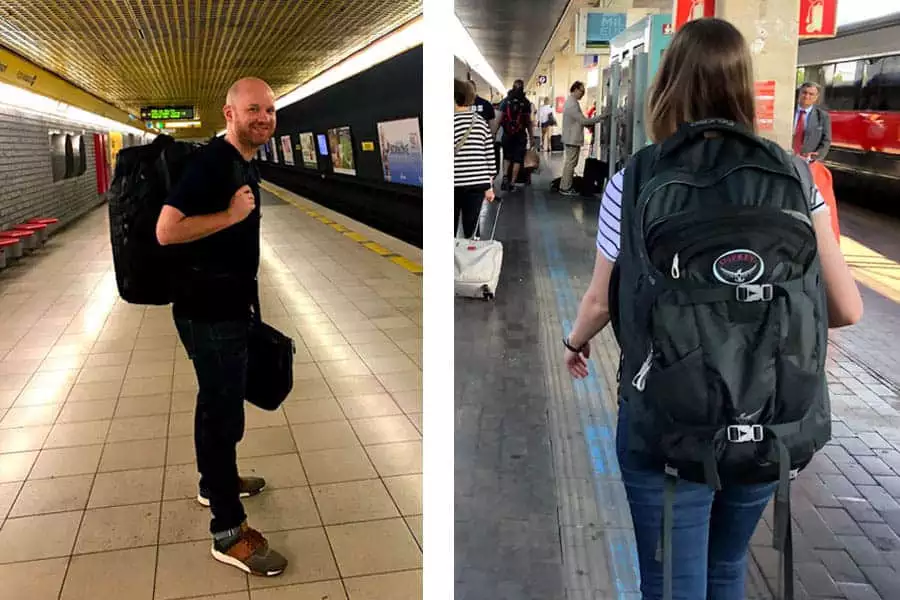
I’m a big fan of travel backpacks and it’s my preferred luggage choice. However, they’re certainly not for everyone so I’ll cover what to consider before buying a travel backpack.
Check out my guide to the Best Travel Backpacks and the Best Carry-On Backpacks .
Benefits of Travel Backpacks
- Mobility: Easily navigate crowded streets and public transportation since all your stuff is on your back.
- Hands-Free Travel: Traveling with two free hands makes your life much easier and more enjoyable.
- Navigate Stairs & Streets: You won’t have to worry about stairs or cobblestone streets with a backpack.
- Less Stress: We find that our stress levels go down when we use a backpack since we don’t have to worry about knowing where our stuff is.
Disadvantages of Travel Backpacks
- Uncomfortable If Overloaded: A travel backpack will be uncomfortable if you overpack.
- Checked Luggage: If you have to check your backpack when flying, you must be cautious because the conveyor belts can sometimes rip off the straps of the backpack You’ll have to take extra precautions when checking your bag (or get a backpack that has stowable straps).
- Must Fit Well: It is important to get a backpack that fits your body well. If not, it can quickly become uncomfortable.
- More Difficult to Pack: Most modern travel backpacks open up like a standard suitcase so they’re easy to pack but some ‘hiking’ style bags only open from the top.
- Back Pain: Even a well-packed can start to cause back pain so it might not be great for people with mobility issues.
Features Of A Great Travel Backpack
I’ve written multiple guides about finding the perfect travel backpack. Here’s my Guide To Choosing The Perfect Travel Backpack and a list of my favorite backpacks traveling Europe .
Recommended Travel Backpacks and Rolling Luggage
Travel Backpacks We Like:
- Osprey Farpoint and the Osprey Fairview
- Osprey Porter
- Tortuga Outbreaker , Setout , and Setout Divide .
Rolling Luggage We Like:
- Osprey Transporter , Osprey Ozone , and Osprey Sojourn
- TLS Mother Lode Wheeled Duffle
- Eagle Creek Expanse Drop Bottom Wheeled Duffel 32
Where To Buy Travel Backpacks and Wheeled Luggage
There are a lot of places to purchase luggage and travel backpacks. Here are a few of our favorites:
- Amazon — Amazon has everything.
- Zappos — Zappos doesn’t always have every brand/model of luggage but they have free shipping and super easy free returns in case your bag doesn’t fit you correctly.
- REI — REI has a decent selection of luggage and their selection of travel backpacks is very solid.
Get Organized For Traveling Europe
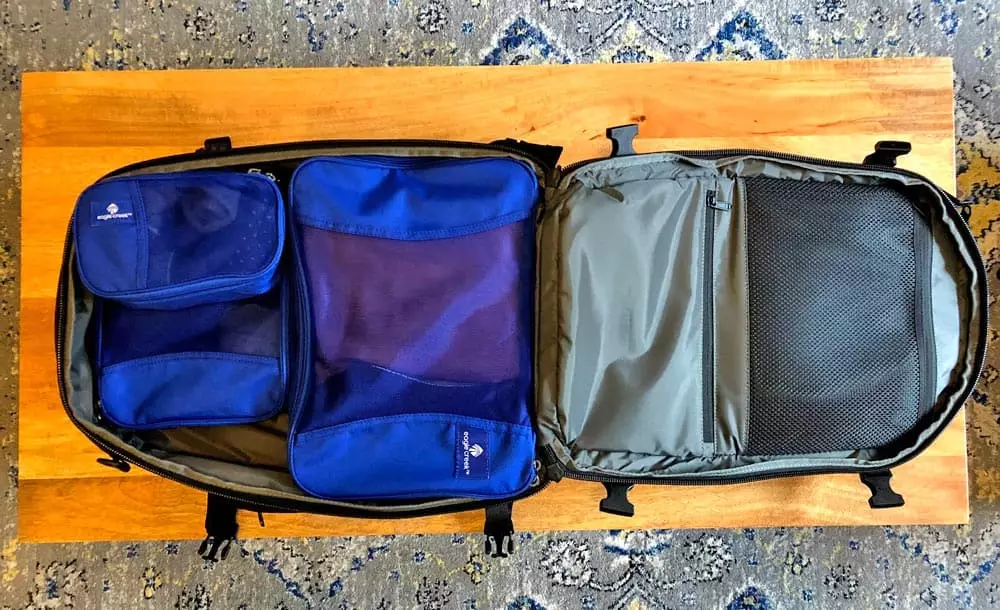
Life gets a little more complicated when you’re living out of a bag but worry not… I’m here to help.
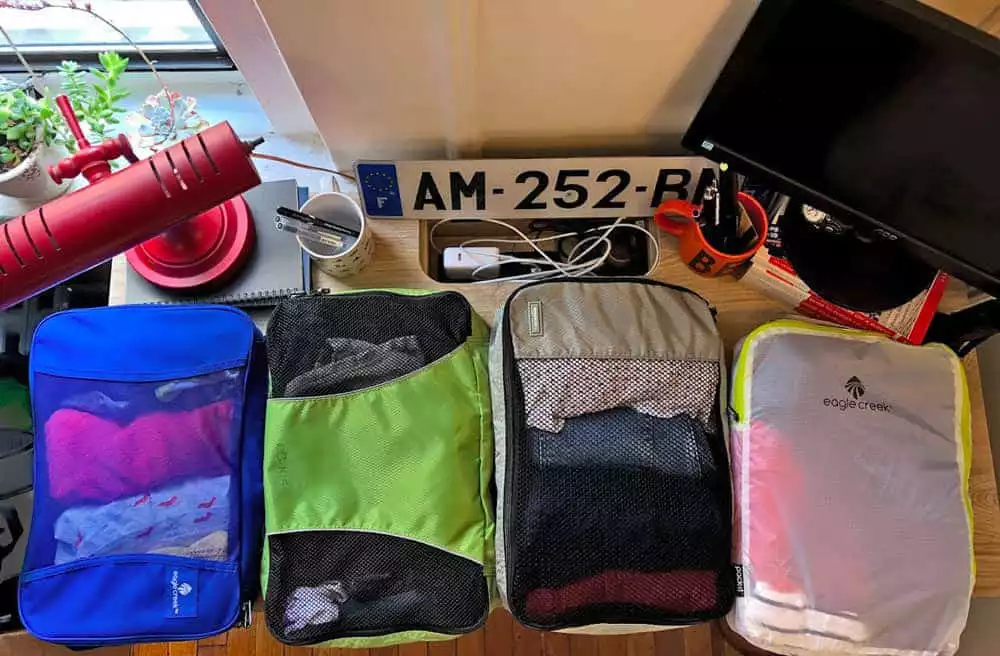
Behold the magical packing cubes.
They may not look like much but these simple travel accessories make packing so much easier.
The idea behind packing cubes is simple — you divide your clothing up between different cubes (socks in one cube, underwear in another cube, etc.). This keeps all your clothes compressed and organized.
This way you can quickly grab what you need. And these make repacking all your stuff easy as well since you know where everything goes.
As an added bonus, packing cubes can also help reduce wrinkles by preventing your clothing from shifting around in your bag. And the compression lets you fit more stuff into your luggage.
There are a ton of companies that make packing cubes but here are a few of our favorites:
- Eagle Creek Pack-It Cubes (best overall)
- eBags Packing Cubes (close second place)
- Eagle Creek Spectre Tech Packing Cubes (ultra-lightweight favorite)
- AmazonBasics Packing Cubes (best budget option)
Learn More: Read a more in-depth review of the best packing cubes .
We don’t personally use packing folders but they’re a popular travel accessory. Basically, packing folders are designed for larger items like dresses, button-up shirts, and pants.
We recommend Eagle Creek Packing Folders — which cost anywhere from $16-$25 depending on size (via Amazon ).
Hanging Toiletry Bag
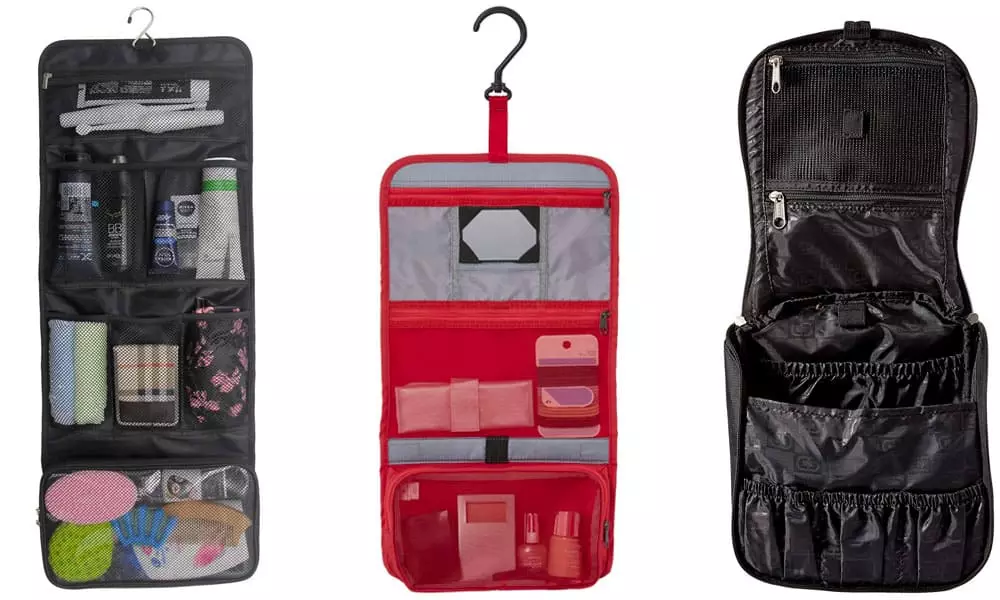
A toiletry bag is essential for keeping all your toiletries contained.
Do yourself a favor and buy a toiletry bag with a hook so it can be hung up since most European bathrooms have little/no counter space. There are a bunch of different bags available on Amazon but here are a few popular travel toiletry bags:
- The Ogio Doppler Kit (via Amazon ).
- The Lewis N Clark Hanging Toiletry Case (via Amazon ).
- Eagle Creek Toiletry Kits (via Amazon ).
- TANTO Toiletry Bag (via Amazon )
Other Helpful Organization Aides
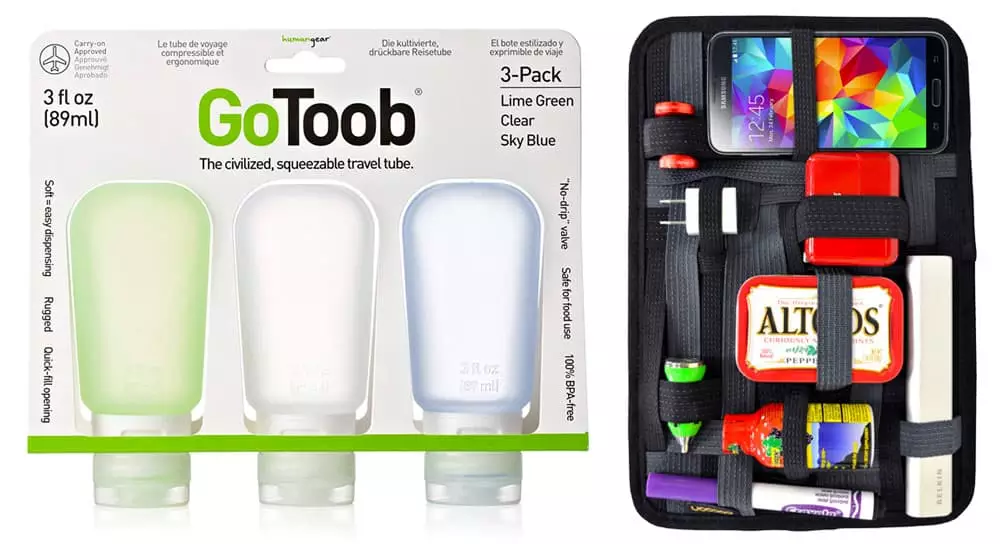
- Humangear GoToob Travel Bottles are probably the best travel bottles for shampoo and other liquids/gels. They are a little expensive ($17-$25 for a set) but they don’t leak. There are multiple sizes so check Amazon to see what works best for your needs.
- The Grid-It Organizer is a handy way to keep all those electronics and wires in order. They cost about $15-$20 and come in different sizes (via Amazon ).
- A compression stuff sack is nice for keeping dirty clothes away from your clean clothes, and it serves as a good bag for doing laundry. Multiple companies make them and they run about $10-$40 depending on the size (via Amazon ).
- Ziploc bags come in handy for storing multiple things and keeping liquids from spilling over all your stuff (I like to keep my passport in a plastic bag for safekeeping). Ziploc makes multiple sizes of bags, so I like to pack multiple bags just in case I ever need one. There is even a three-gallon bag that works well for storing an extra pair of shoes so you don’t get your clothes dirty.
Travel Clothing Packing List

The majority of the weight in your luggage will come from clothing so it’s important to limit your clothes if you want to travel light. Of course, this is easier said than done.
In this section, we’ll help you choose which types of clothes to pack, some general tips for packing light, and packing tips for all seasons (summer, fall, winter, and spring).
Efficient Clothing Packing Tips
- While it might be a bit boring, it is usually easiest to pack mostly dark colors since they’re the easiest to coordinate. Additionally, dark colors do a better job of hiding stains than light colors.
- Avoid Single Wear Clothing: Don’t bring anything that you’ll only wear once because it’s not worth lugging around for your entire trip. Choose pieces that can be worn for a variety of occasions.
- High Maintenance is No Good: You’re going to be wearing your clothes a lot so you want things that can take a bit of punishment and is machine-washable
- Accessorize: You’ll probably get tired of wearing the same thing all the time so throwing in a few accessories (hats, scarves, sunglasses, etc.) is a good way to change up your outfit.
- Buy Clothes as You Travel: We know a lot of travelers who only bring the bare minimum of clothing and then buy new stuff as needed.

I’m a big fan of travel underwear — mainly because you can easily wash them in the sink and they’ll dry in a few hours. They’re also designed to be more comfortable when you’re traveling all day. When you’re searching for travel underwear, look for the following things:
- Furthermore, cotton can take well over 24 hours to air dry — which makes it a pretty poor choice.
- Cotton does the exact opposite — it retains sweat and it leads to that “swampy” feeling we’ve all experienced.
- Odor Control: The best travel underwear helps manage odors. Cheaper synthetic underwear will start to smell pretty quickly but the higher-quality synthetic fabrics will do a better job. We’ve found that fine Merino wool does the best job of stopping odors.
The number of pairs you bring is a personal preference. We don’t like washing underwear every night so we bring five or six pairs — but you could conceivably get away with two pairs (if you don’t mind washing often
Recommended Women’s Travel Underwear

The most popular travel underwear is made by ExOfficio — they get a ton of great reviews on Amazon . They are ideal for travel because they’re breathable, odor-repellant, and dry in just a few hours. They do tend to be more expensive than normal underwear but most experienced travelers swear by them.
ExOfficio has a fairly wide range of underwear styles available and they’re priced anywhere from $8-$20/pair (depending on style and color):
- ExOfficio Thong
- ExOfficio Lacy Low Rise Bikini
Patagonia also makes some really nice underwear that is great for travel. They get good reviews for being soft and comfortable. The Patagonia underwear won’t dry quite as quickly as ExOfficios but they still dry quickly. Patagonia stuff is always high quality but it also comes at a price — these normally cost about $20/pair.
- Active Hipster Briefs
- Barely Hipster Briefs
- Active Boy Shorts
Bring two or three comfortable bras . You may also want to bring a quality sports bra for those long travel days.
Recommended Men’s Travel Underwear

ExOfficio Give-N-Go underwear is the most popular underwear for travelers ( read our personal review here ) and their boxer briefs have over 5000 reviews on Amazon .
I wear mine even when I’m not traveling because they are pretty damn comfortable. ExOfficios breathe well, inhibit odor, and air dry super quickly. ExOfficio offers a few different styles and they cost between $15-$25/pair ( via Amazon ). They’ve also just released their new Give-N-Go Sport boxer briefs that look really nice. They cost $30 ( via Amazon ).
Under Armour also makes HeatGear underwear that performs similarly to the ExOfficios. They cost around $20/pair ( via Amazon ).
If you prefer wearing natural fibers, we suggest Merino wool. The Smartwool underwear is nice and will keep you cool and dry. They usually run about $48 so they are on the expensive side. We also have a pair of boxer briefs from Wool & Prince that we really like.
Socks For Travel
It might not be exciting but a quality pair of socks will make a world of difference when you’re traveling. I’m a huge fan of socks made from fine Merino wool.
Lightweight merino wool socks are great in the summer because they’ll actually keep your feet cool and dry. Heavier-weight socks are good for traveling in the winter because they’ll keep your feet warm and dry.
Quality socks are expensive but they’ll last for a long time if you take care of them. Synthetic/wool blends also work well.
Ideal Travel Socks:
- Wick Moisture: Your feet will sweat but a good pair of socks will draw moisture away from your feet. Keeping your feet dry will help eliminate odor and will also help stop blisters.
- Dry Fast: A lot of good wool and synthetic socks can be washed in the sink and will dry overnight (about 6-8 hours).
- Eliminate Odor: High-quality wool is naturally odor-resistant. Some synthetic socks have special anti-bacterial features that help eliminate odor but they’re not quite as effective as wool. Synthetic-wool blends also work well.
- Aren’t Cotton: Cotton is a terrible choice when it comes to socks. Cotton traps moisture and dries very slowly — this will lead to blisters and smelly feet. Additionally, cotton socks take a long time to air dry (24+ hours) so they’re difficult to wash in the sink.
A good pair of socks can be worn 2-3 times before they start to stink (although you’ll want to rotate the days you wear each pair so they can “air out”). For a more in-depth article about the wonderful world of socks, check out our article about the best travel socks .
Recommended Travel Sock Brands
- Darn Tough Socks: Darn Tough Socks are known for being super durable — in fact, they’re guaranteed for life. Plus they’re made in Vermont.
Shoes For Traveling Europe

Wear. Comfortable. Shoes.
The most important packing tip is to wear sturdy, comfortable shoes when traveling Europe.
Trust me — you’re going to be on your feet way more than usual and your feet are going to take a beating. That’s why you should put comfort over fashion — luckily there are plenty of fashionable and comfortable shoes on the market.
So let’s look at a few tips for ensuring your feet stay happy:
- Here’s a list of what I think are the best travel shoes if you want my top picks.
- Have bad feet? Consider adding a pair of insoles to your shoes. Superfeet insoles get a lot of great reviews but there are a lot of other brands available.
- Consider Your Environment: Match your footwear to your environment. For example, you may want to consider a waterproof shoe if you’re traveling to rainy/snowy locations. Conversely, you probably don’t need heavy-duty mountain-hiking boots if you’re spending all your time in cities.
- Break In Your Shoes Early: Even comfortable shoes can take a little while to get broken in. That’s why I recommend wearing your shoes for a few weeks before your trip so you know they won’t give you blisters or foot pain.
- For Winter Travel : I recommend a lightweight pair of waterproof boots for poor weather (snow, rain, cold, etc.) and sneakers for the nicer days. Luckily, boots can often be dressed up a bit they still look nice enough at restaurants, etc. Check out our guides for the Best Waterproof Boots for Men and Best Waterproof Boots for Women for some fashionable and functional options.
- For Hostel Travelers: Don’t forget a cheap pair of sandals for the showers…
Learn More: Take a look at our guides to the Best Travel Shoes For Women and the Best Travel Shoes For Men —both articles go into much more detail about what you should look for in a pair of travel shoes as well as a selection of footwear perfect for travel.
Shirts and Tops For Travel
Now let’s dive into shirts and tops. To help keep things simple, I’ve split this section up into a women’s section and a men’s section.
Treat these sections as general guidelines on what kind of shirts/tops to pack — don’t forget the general rules of durable fabrics, dark colors to hide stains and wrinkles, and choosing items that can be easily paired with other items.
By the way, if you’re an ultralight traveler, you’ll probably want to pack less than what is listed below.
Tops For Women Packing List

- Shirts (3 or 4): A mixture of short and long sleeve tops is ideal. Remember to dress for the weather, but also realize that it can get cool at night during the summer. Bring a mixture of casual and dressy tops so you can mix and match.
- Light Sweater/Cardigan: Even during the summer, temperatures don’t always get really hot (although they can). In Paris, the average high temperature in June is around 72 degrees and it can drop into the low 60s at night. That’s why it is a good idea to bring a light sweater or a cardigan.
- Dresses (1 or 2): Look for a versatile lightweight dress that can be worn casually or dressed up.
- T-shirts and Tank Tops: Sometimes you just want to wear a simple t-shirt so be sure to bring a few. Just pick whatever you’re comfortable wearing. The ExOfficio Lacy Shelf Bra Cami is a nice undershirt or sleep shirt — it is super lightweight, breathable, and air-dries overnight if you want to wash hand wash it.
Women’s Travel Clothing Brands
- Athleta : Athleta has really stepped up their travel clothing and they have a lot of solid options.
- Lululemon : Lululemon has a number of good travel clothing options.
- Anatomie : Anatomie has a bunch of higher-end clothing that looks really nice
Tops for Men Packing List

- Bluffworks Meridian shirt is a super-tough wrinkle-free travel shirt that can be worn casually or dressed up. It retails for $125. Available via Bluffworks
- Wool & Prince sells a number of nice 100% merino wool shirts. Their long-sleeve button-ups retail for $128 and their short-sleeve sell for $98.
- Bluffworks recently released its performance t-shirt which sells for $45.
- Wool & Prince sells super nice 100% merino wool t-shirts ($68) and polos ($98).
- Uniqlo makes a number of budget t-shirt options that we always dig. Their inventory changes often but they always have something.
- Sweaters (1 or 2): A lightweight sweater is nice if you want to dress up a little or if the temperature drops when the sun goes down. Layering a sweater over a button-up shirt looks nice (so make sure all your button-ups match your sweater). Of course, if you’re traveling in the summer, you probably don’t need to pack a sweater but having one or two in the winter is nice.
Jeans, Pants, and Bottoms Packing Guide
I usually only pack two pairs of pants — mainly because they take up a lot of space in your luggage. Also, pants are one of those things that you don’t really need to wash all that often so there’s no real need to pack multiple pairs.
Pants & Bottoms for Women

- For Cold Weather: Throw on a pair of lightweight micro-wool long underwear (i.e. a base layer) under your jeans — SmartWool and Icebreaker are two great brands.
- Capri Pants: Capri pants are a nice option in warm weather that still looks nice but are also functional.
- Skirts: Skirts are dressier than shorts and they take up essentially no space in your luggage. Feel free to bring a mixture of shorter and longer skirts.
- Shorts: Shorts are starting to become more popular in Europe so, contrary to popular belief, you won’t feel out of place wearing them — especially in the south of Europe. That said, we recommend bringing a fashionable and well-fitting pair as opposed to ‘athletic’ shorts.
- Athleta : Athleta has multiple options for pants that work well for travel.
- Lululemon : Lululemon has a few jogger pants and other options that would work well for travel.
- Anatomie : Anatomie has a bunch of higher-end travel items.
- Uniqlo : Uniqlo always has a few pairs of travel pants that are friendly on your bank account.
Pants & Bottoms for Men

- Jeans: A pair of dark jeans are essential for traveling in Europe. They look great during the day and they can be dressed up for nighttime. Additionally, jeans can go weeks without needing to be washed.
- Bluffworks makes a series of lightweight, durable, and quick-drying travel pants that also look like regular pants. Pairs range from $98-$140. They also make some solid Travel Jeans for $125.
- AT Slim Rivet Pant from Western Rise and stretchy, stain-proof, and incredibly durable. They retail for $129.
- The Brion Pant from Prana is one of the more fashionable “outdoor” pants and they sell for $79.
- Shorts: In the past, you wouldn’t find many adult men wearing shorts in Europe but this is changing very quickly. Stick to well-fitting fashionable shorts but stay away from things like athletic shorts or the classic “touristy” khaki shorts.
- Cold Weather: When the temperature drops, it can be nice to have a lightweight base layer to go under your pants. SmartWool and Icebreaker make some of our favorite high-quality base layers.
Outerwear Guide
It’s a good idea to prepare for the elements so you’ll want to look into a few options — especially in the non-summer months.
- The Marmot Precip is a great lightweight rain jacket that is also pretty affordable.
- Check out REI.com for a wide range of rain jackets.
- Our top choice is the Patagonia Better Sweater Fleece ( Men’s and Women’s ) but there are plenty of great options at REI or Amazon .
- We use Patagonia Nano Puff but for more budget-friendly options check out Uniqlo .
Clothing Accessories
Here are a few handy accessories to round out your outfit.
- Scarf: Scarves are a handy item that adds style and comfort on cooler days. You can always buy a few as you travel because they make great souvenirs.
- Sunglasses: Sunglasses are a must-have because they’re both practical and fashionable. After living in Europe, we noticed that Ray-Ban Wayfarer sunglasses were a top choice of the truly fashionable but you might want a cheap pair if you’re on the move all the time.
Europe Winter Weather Packing Guides
Winter travel in Europe poses a few extra packing challenges to consider so we’ve written a few handy guides to help guide you on your way.
- Europe Winter Travel Packing List
- How To Dress For Winter in Europe
- Best Waterproof Boots for Men
- Best Waterproof Boots for Women
Travel Accessories Packing List
We’ve put together a list of our favorite travel accessories to help make traveling in Europe easier and more enjoyable.
SIM CARD FOR CHEAP MOBILE DATA

The cheapest way to get mobile data for your phone is by using a European SIM card — this is much cheaper than using your home carrier’s International Mobile Data plan.
You can read about my guide to using smartphones and data plans in Europe but I recommend buying your SIM card from SimOptions.com or Holafly .
Travel Daypack

A small backpack is essential for carrying around your day-to-day stuff (camera, souvenirs, rain jacket, guidebooks, etc.) as you’re sightseeing. We recommend a small daypack that can be easily packed away in your luggage and that won’t strain your back as you wear it all day. Here’s a list of the best daypacks . — we’ve also included a few anti-theft backpacks which are handy if you’re visiting areas known for pickpockets .
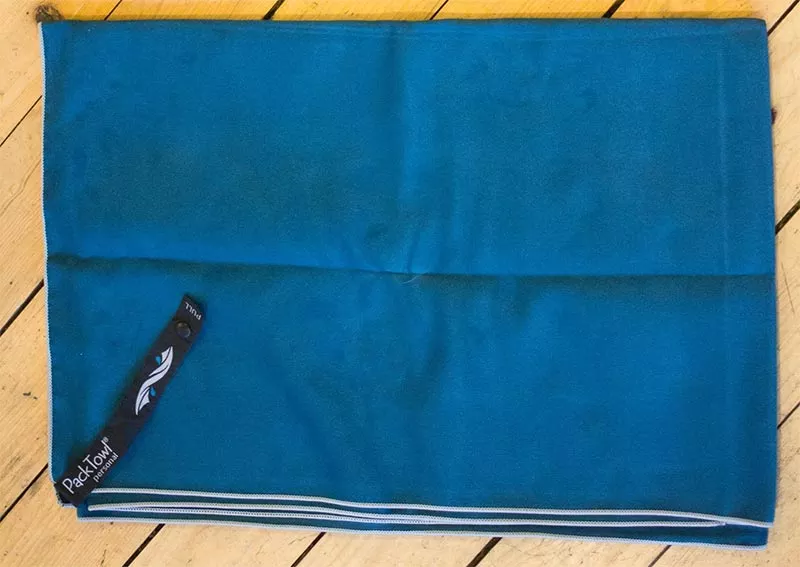
Packing a quick-drying travel towel will come in handy if you’re staying somewhere like a hostel that doesn’t provide towels. That’s because traditional cotton towels, in addition to being very bulky, take hours to dry — which will lead to a musty smell if you pack it before it is dry. Travel towels work well because they are compact but can still absorb plenty of liquid as they dry overnight.
Note: Travel towels are often much smaller than normal towels. We suggest buying the large or XL size—especially if you have long hair (or buy two).
There are a ton of travel towels on the market but these get great reviews:
- PackTowl Personal Microfiber Towel
- Biospired Footprint Lightweight Microsuede Towel
Keychain Flashlight

Most people use their phone as a flashlight light but a small keychain flashlight is still a nice accessory — especially in dark dorms and city streets.
We love the Streamlight 73001 Nano Light Miniature Keychain LED Flashlight because it’s super small (it fits on a keychain) but it provides a ton of light. Streamlight also has a ton of other great-quality pen lights if want other compact light options
Padlock & Retractable Cable Lock

If you’re staying in a hostel, you’ll need a lock so you can secure your stuff in the lockers. We recommend the Master Lock Set-Your-Own-Combination Padlock because it allows you to create your own combo so it’s easier to remember.
Retractable cable locks are nice for securing your bag to your bunk or a luggage rack. They will deter a thief from running by and snatching your bag.
Earplugs & Eye Mask
An eye mask is nice for trains/planes/buses or if you stay in hostels (some jerk will turn the lights on at 3 am). Additionally, you’ll be glad you brought earplugs if you stay in hostels because you’ll eventually share a room with someone who snores. These Mack’s Pillow Soft Silicone Earplugs are really nice for sleeping.

Throw in a small notebook like the Moleskine Notebook , Field Notes , or Rhodia notebooks to make notes of things as you travel. We write down directions, phone numbers, addresses, restaurants, spending, etc. At the end of your trip, your notebook will end up being a nice little souvenir.
Water Bottle or Flexible Water Bottle

Stay hydrated with a water bottle. A basic water bottle is perfectly fine but this flexible water bottle by Platypus Soft Bottle is a great choice because it can be rolled up when empty.
Travel Sleep Sheet
Are your hostel sheets clean… who knows? If you don’t want to take the chance, think about packing a sleep sheet/sleep sack. A cotton Sleep Sheet is cheap but bulky. Silk Sleep Sacks cost but they’re a lot lighter, less bulky, and the silky feeling is nice.

- Sink Stopper: A cheap Travel Sink Stopper is necessary for sink laundry.
- Travel Laundry Soap: Woolite Travel Laundry Soap or Travelon Laundry Soap Sheets are perfect to travel laundry.
- Flexible Travel Clothesline: The best way to dry your clothes is with rubber braided clothesline . Plus, braided clotheslines don’t need clothespins.
- Stain Remover: Toss in a Tide To Go Stain Remover Pens or individually wrapped Shout Wipes for any stains.
Patch up stuff with duct tape. A whole roll because it is too bulky so just wrap some around a pencil. Or buy some travel duct tape .
Digital Luggage Scale
Make sure your bag isn’t too heavy with a digital luggage scale .
Photocopies Of Important Documents
Make copies (physical and electronic) of your passport and other important documents. We email them to ourselves or save them to Google Docs.
Ziploc Bags (Multiple Sizes)
Plastic bags are a great way to store your dirty or wet socks/underwear so they don’t get mixed with your clean clothes. We’ll also put our liquids in a sealable bag in case of a leak. The large 3 gallon bags are nice for storing shoes so you don’t get your clothes dirty.
One of the best ways to avoid becoming a pickpocketing victim is to wear a money belt ( learn more about avoiding pickpockets here ). Personally, we don’t really like money belts because they’re kind of annoying to wear but a lot of people always wear one — it comes down to personal preference.
Collapsible Umbrella
A travel umbrella is optional if you’re traveling in the summer. However, the fall, winter, and spring tend to be rainy, so you might want to bring one along.

We eat a lot of meals from the grocery store so we always bring a set of Plastic Travel Utensils . If you really want to go all out, you should check out this sweet titanium spork .
Toothbrush Cover

Keep your toothbrush germ-free with the Steripod Clip-on Toothbrush Sanitizer cover. It protects the brush and sanitizes it using voodoo science. Yeah, science! Or you can just get a normal toothbrush cover if that’s how you roll.
Lint Roller
A lint roller is an easy way to help keep your clothes looking presentable.
Guide Books and Phrase Books
Despite loving internet resources, we are still huge fans of using printed guidebooks to research wherever visit. Learn more about our favorite travel guidebooks & websites .
A small phrasebook can also come in handy if you’re not familiar with the local language (but most people in big cities will speak a little English).
Electronics Packing List
We travel with more electronics than ever so here’s a list of things you might want to bring along.
IMPORTANT: North America and Europe use different voltages (120v vs 220v) for their electronics. So what does that mean for you? For high-end electronics like phones, cameras, laptops, iPads, etc… it doesn’t matter. All you need is a plug adaptor because these electronics are all designed to work at multiple voltages. However, electronics with heating elements and motors like hairdryers, curlers, straightening irons, hair clippers, etc. aren’t designed for multiple voltages so they’ll fry if you use them in Europe. Read our guide to traveling with electronics for more in-depth advice about using electronic devices while traveling.
Outlet Plug Adapters

You’ll need a couple of outlet plug adapters for all your electronics. Most of Europe uses the same plug but the UK uses a different configuration. There are dozens of adaptors out there but this affordable plug adaptor set from Ceptics will work fine. They also sell UK, Ireland, and Switzerland-specific versions if you’re traveling there.

Many hostels and hotels may only have one or two power outlets per room. That’s why we often pack a travel power strip to power our various gadgets. The Belkin Travel Power Strip with USB ports is a well-rated option but there are plenty of other travel power strips on Amaz on .
Portable Phone Charger
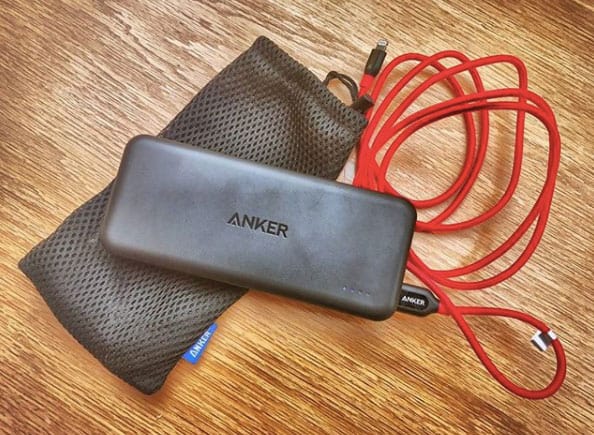
If you’re anything like us then you’re going to use your phone a ton when you’re traveling so you’re going to drain your battery before noon. That’s why a portable phone charger is a must-have travel item. We use the Anker PowerCore 10000 because it’s the size of a deck of cards and is affordable.
Dual Voltage Travel Hairdryer
Standard North American hairdryers and straighteners won’t work in Europe — even if you use a voltage adapter. That’s because Europe uses a higher voltage than North America. That’s why you need a dual-voltage hair dryer. The Revlon 1875W Compact Travel Hair Dryer is a top choice for travelers because it is powerful, lightweight, and foldable.
Don’t forget about dual voltage straightening irons and dual voltage curling irons .
We use our iPhones for a majority of our travel photography but you’ll want a quality digital camera if you want nicer photos. We’ve already written an in-depth article about choosing the best digital camera for trave l. Don’t forget the extras:
- Extra Memory Cards: Pack a few extra memory cards because you don’t want to run out of storage space — it’s better to have too much than not enough. And memory cards are cheap .
- A portable external hard drive is great for backing up all your photos. Another great option is to upload all your photos to cloud storage.
- Google Drive is free cloud storage and it gives you 15GB of space. We pay for their premium version to get even more space — especially since we have it synced with Google Photos. The main problem with cloud storage is not having reliable internet access when you travel.
- Extra Battery: I always carry an extra battery. Generic versions are cheap on Amazon (you’ll have to search for the specific battery that your camera uses).
Tablet or Laptop
We love traveling with our iPads — they’re the perfect travel computer. So, unless you really need the full functionality of a laptop, we suggest sticking with an iPad.
Smart Phone
Everyone has a smartphone these days. Here’s our guide to the best travel apps if you’re curious to know our favorite apps.
Be sure to read our guide to using Data Plans Abroad
It’s nice to listen to tunes as you travel. Additionally, there are a lot of downloadable audio guides for cities and museums — which are great ways to learn more about the places you’re visiting. We absolutely love our Apple Airpods (not having wires is so amazing). But we still throw in a cheap pair of headphones for flights. We’ve written more about our favorite travel headphones .
Travel Toiletries for Europe

We suggest minimizing your toiletries since liquids are heavy and you can purchase anything you need once in Europe. That said, here is a list of things you might want:
- Shampoo/Conditioner/Body Wash: Pour liquids into these small GoToob travel-sized bottles because they won’t leak.
- Toothpaste & Toothbrush: We travel with a normal toothbrush but add a toothbrush cover . We did find that dental floss was much more expensive in Europe so bring some from home.
- Non-Aerosol Dry Shampoo: Dry shampoo is amazing for getting your hair ready when you don’t have time to jump in the shower.
- Shaving Stuff (Razors & Cream): Razors are more expensive in Europe.
- Deodorant: For whatever reason, we find that deodorant in Europe didn’t seem to work as well — maybe it was all in my head.
- Chapstick w/Sunscreen : Protect your lips.
- Contact Lenses/Solution/Glasses: Contact solution can be a pain to purchase since it’s often only sold in pharmacies.
- Lipstick (or something similar): Parisian women seem to never leave the house without sexy lipstick. You can also use lipstick as blush.
- BB Cream: BB Cream is a great ‘all-in-one’ product. It’s a moisturizer that contains sunscreen and provides light coverage as a basic foundation — it also evens skin tone.
- Mascara: Mascara should be changed every three months, so this is a great excuse to buy a new bottle.
- Cream Blush: You really don’t want to have makeup brushes in your bag, so a cream blush is a great option.
- Condoms: You don’t want some souvenirs so we suggest buying some now. Amazon seems to have the best price/selection of condoms .
- Travel Fabric Freshener: Keep away the funk with travel-sized Febreze To Go.
- Travel Toilet Paper: Travel toilet paper is never a bad thing to have in an emergency.
- Wet Wipes/Baby Wipes: Cottonelle Fresh Flushable Wipes can be a lifesaver and so they’re super easy to pack.
- Hand Sanitizer: Who knows what kind of things you’ll be touching.
- Body Powder: A lot of walking can equal chafing — especially in hot weather. Anti Monkey Butt is great for those hot days.
- Foot Cream: Take care of your feet because you’ll be walking a lot. O’Keeffe’s Healthy Feet Cream will keep your feet from becoming rough and cracked.
- Pepto Tablets: Traveling can take a toll on your stomach. Pepto-Bismol tablets are super easy to throw in your bag.
- Band-Aids: They’re nice to have on hand. A lot of people will develop blisters on their feet so we recommend Band-Aids for feet .
- Pain Medicine: Over-the-counter pain medicine is normally only sold in pharmacies so it can somethings be hard to find after-hours.
- Prescription Drugs: Ensure you have enough medicine to cover your trip since getting refills can be difficult.
Travel Insurance
We recommend picking up some travel insurance — which will help cover your stuff, flights, hotel, train tickets, rail passes, medical emergencies, and more. World Nomads is our top choice but you can check out our guide to buying travel insurance .
Where to Buy Travel Gear
- Amazon : Our top choice for buying gear is Amazon because they seem to have the best selection and prices.
- Zappos : Zappos has a solid selection of travel gear. Their prices are sometimes a bit higher than other stores, but their free super-fast shipping and dead-simple returns are often worth the extra cost.
- REI : One is the largest outdoor retailer so they have a nice selection of backpacks and clothing.
- Recent Posts
- Best Prepaid UK eSIM | Data Plan Buyer’s Guide - April 21, 2024
- How to Avoid Pickpockets in Europe — Tips for Outsmarting the Thieves - April 19, 2024
- Best Prepaid eSIM For Italy | Data Plan Buyer’s Guide - April 18, 2024

No Funny Business
The Savvy Backpacker is reader-supported. That means when you buy products/services through links on the site, I may earn an affiliate commission—it doesn’t cost you anything extra and it helps support the site.
Thanks For Reading! — James
Questions? Learn more about our Strict Advertising Policy and How To Support Us .
Related Reads
Backpacking europe packing list — my europe travel packing guide.
A comprehensive packing list and advice for budget backpacking and ultralight travel in Europe — including electronics, clothing, toiletries & accessories.
Helpful Travel Tips & Articles , Packing
Fashion Advice: How to Avoid Looking Like An American Tourist In Europe
Fashion advice to help you look like a local when visiting Europe.
The Best Travel Backpacks | In-Depth Buyer’s Guide & Backpack Reviews
A list of my favorite travel backpacks for every travel style.
Packing , Product Reviews
Best Travel Shoes — Fashionable & Comfortable Shoes for Traveling
The ultimate guide to the best travel shoes that are both stylish and comfortable.
City Guides
Choosing travel insurance, travel packing lists, budget travel newsletter.
The best budget travel tips sent straight to your inbox.
Join My Journey
Europe travel tips, advertising & privacy policies.
TheSavvyBackpacker.com is a participant in the Amazon Services LLC Associates Program, an affiliate advertising program designed to provide a means for sites to earn advertising fees by advertising and linking to amazon.com.
© 2010 - 2024 The Savvy Backpacker
Website Design by FHOKE

11 EPIC 2-Week Europe Itinerary Options [2024 UPDATE]
Trying to plan a 2-week Europe itinerary but don’t know where to start? This complete Europe travel guide will help you figure out which region in Europe is best for you and which itinerary would best suit your travel preferences!
Europe tops the list of leading destinations for travelers across the globe with its pristine, Mediterranean beaches, medieval history, sumptuous cuisine, and picturesque landscapes. But, with so many countries and options to choose from, finding a 2-week itinerary to suit your needs can be daunting!
With over a dozen European countries under my belt and years of personal traveling experience, I have created the best itineraries to suit every traveler. From the beachbums to the hikers, and the history buffs to the nature enthusiasts, there is a European itinerary for everyone!
Here is my list of the best itineraries across the continent, each containing the top activities of the region. I’ve also included tons of useful information on how to plan your trip, how to select the countries you should visit, and more!
Happy Travels!
11 Incredible 2-Week Europe Itinerary Options
Whether you want to visit Central, Western, or Northern Europe, we have a special itinerary for every travel style and budget!
✈️ Now, before you set out your door en route to the airport, be sure to check out these Essential Tips for Traveling to Europe for the First Time ! Even if it’s not your first trip to the continent, you’re likely to find some helpful tips for your next go-around.
✈️1. London & Paris: 2-Week Europe Itinerary

This combination makes for a fantastic Eastern Europe itinerary! With so much to see and do in both, you’ll want at least a few days in each to explore the nooks and crannies of these gorgeous cities.
This trip can be shortened to fit within one week, but keep in mind these are two of the largest cities in Europe.
They have a lot of incredible sites and activities to offer that you won’t want to miss out on, not to mention you’ll need some time to sit back and enjoy a cup of tea (or a glass of wine) and a freshly baked croissant!
Day 1 : Arrive in London Day 2 : Big Ben, the Tower of London, the London Eye Day 3 : Buckingham Palace and the Changing of the Guard Day 4 : Walking Tour of the City Day 5 : Harry Potter tour Day 6 : Train to Paris: Eiffel Tower and the Arc de Triomphe Day 7 : Les Champs-Élysées and the Notre Dame Day 8 : Museums: Orsay and Louvre Day 9 : Explore some neighborhoods: Montmartre and Le Marais Day 10 : Day Trip to the Palace of Versailles Day 11 : Picnic in the Luxembourg Gardens Day 12 : Get lost in the Latin Quarter Day 13 : Paris Catacombs and catch a show at Le Moulin Rouge Day 14 : Return home
With 20 arrondissements in Paris and over 600 square miles in London, it’s safe to say the possibilities are endless when designing a trip to these cities. But, you really can’t go wrong!
Each day can be customized to fit your goals. Looking to relax by the Seine and have a picnic? Do it. Not really into shopping? Skip the Champs-Élysées and spend time listening to the singing bells of the Notre Dame Cathedral.
In London, opt to check out the local art scene and make your way through its numerous museums.
Looking for a day trip from London? Windsor Castle, Bath, and Stonehenge are most popular for visitors looking to escape the chaos of the city for a day, and with their incredible cultural heritage and stunning architecture, there’s no wondering why.
London and Paris offer fantastic opportunities to immerse yourself in Europe while avoiding complex itineraries and long-haul journies between destinations. Pair them together for a classic 2 week Europe trip full of beauty, romance, and charm.
Related Articles on Paris
✔️ Why Visit Paris? 25 Reasons to Visit Paris, France ✔️ Is Paris Safe? A Full Guide on Safety in Paris ✔️ Souvenirs from France: 45 Unique French Souvenirs ✔️ Best Time to Visit Paris: 7 Things to Consider ✔️ 27 Incredible Day Trips from Paris ✔️ 17 Beautiful Beaches Near Paris ✔️ 27+ Magical Things To Do in Paris at Night ✔️ Wine Tours in France: 15 Top-Rated French Wine Tours
✈️2. Amsterdam, Bruges & Luxembourg City: 2-Week Europe Itinerary

Medieval architecture, sweeping canals, and charming squares await in these three cities seemingly based on a storybook. Evidently frozen in time, the magic of these cities can be felt by even the most jaded of travelers, and surely won’t disappoint your inner child!
Stroll the windy, cobblestoned alleyways and take a boat ride through the web of canals in Amsterdam and Bruges, but find yourself watching the changing of the guard and getting lost in the Casemates du Bock of Luxembourg City.
These cities offer everything from traditional design to modern cafés and boutiques and represent the epitome of European travel.
Day 1 : Arrive in Amsterdam Day 2 : Bloemenmarkt & Canal Boat Ride Day 3 : Red Light District (if it’s your style) & Jordaan neighborhoods Day 4 : Van Gogh Museum & Anne Frank House Day 5 : Day Trip to Zaanse Schans Day 6 : Optional Day in Brussels & train to Bruges Day 7 : Train to Bruges Day 8 : Canal Boat Ride & Belfry of Bruges Day 9 : Rozenhoedkaai (Quay of the Rosary) & Market Square Day 10 : Train to Luxembourg City Day 11 : Casemates du Bock & the Grund Day 12 : Walking tour of the Old Town Day 13 : Day Trip to the Mullerthal Trail Day 14 : Return home
Now, you’re probably wondering why I’ve chosen Bruges over Brussels… and the answer is simple. I’m all about getting out of the basic tourist spots (Bruges is still very touristy, but has far more medieval character and beauty to it), and going beyond the first train stop in a new country.
Yes, while traveling from Amsterdam to Bruges, you will most likely be stopping in Brussels. I’m not going to tell you not to get off the train, but I will say that when debating between Bruges vs Brussels , I can honestly say that most people choose Bruges over Brussels.
My best suggestion is to add a day to your trip so you have time to explore both.
Luxembourg City may be small, but it certainly packs a punch. Often overlooked by travelers, it is a true gem that has so much to explore.
Have some extra time? Head up north to the Mullerthal Region of Luxembourg where you’ll find dreamy, moss-covered forests scattered with graceful waterfalls and filled with tall trees (it reminds me of the forests depicted in The Hobbit films!)
These cities have so much to offer and this is one of my personal favorite European itineraries on this list… just remember to bring a camera and good walking shoes.
Related Articles
✔️ One Day in Bruges: The Ultimate Bruges Itinerary ✔️ One Day in Ghent: The Ultimate Ghent Day Trip ✔️ One Day in Brussels: A Brussels Itinerary for First Time Visitors ✔️ The Perfect 3 Days in Belgium Itinerary ✔️ 17 Authentic Souvenirs from Belgium to Bring Home ✔️ Paris or Amsterdam: A Complete Comparison ✔️ Barcelona vs Lisbon: The Ultimate City Comparison ✔️ The Perfect Day Trip to Luxembourg from Brussels ✔️ Amsterdam in Spring: Why Spring is the Best Time to Visit Amsterdam ✔️ 2 Days in Amsterdam: The Ultimate Amsterdam Itinerary ✔️ 25 Authentic Souvenirs from Amsterdam To Bring Home ✔️ One Day in Amsterdam: Full Guide & Best Things To Do and See
✈️3. Chamonix, Courmayeur & The Matterhorn (Zermatt): 2-Week Europe Itinerary

Fellow hikers and adventure seekers, this is the trip for you! Surrounded by the breathtaking Mont Blanc Range and the various snow-capped peaks of the Alps, there is no end in sight to hiking trails of all difficulty levels and spectacular landscapes worthy of a thousand photos.
Even if you aren’t someone who enjoys a good hike, there are plenty of options to take cable cars up these majestic mountain ranges to enjoy the stunning scenery. Trust me, your pictures won’t do your experience justice.
Coming from someone who jumped off the Mont Blanc Range (with a paraglide strapped to me!), the sights are truly unparalleled, and you won’t believe you ever even debated the option of skipping it.
So, here is my best 2-week Europe itinerary for exploring this region to the fullest, just be sure to bring a jacket (yes, even in summer) if you plan on making your way up to the top of these mountains!
Day 1 : Arrive in Chamonix, France Day 2 : The Montenvers Train to Restaurant le Panoramique Day 3 : Aiguille du Midi Cable Car Day 4 : Adventure Activities (Hiking, Paragliding, or Snow Sports) Day 5 : Explore th e c harming Alps town Day 6 : Train to Courmayeur Day 7 : Skyway Monte Bianco Cable Car Day 8 : Explore the quaint villages of the Aosta Valley (Dolonne, La Saxe, Entrèves and Villair) Day 9 : White Water Rafting Day 10 : Train to Zermatt Day 11 : The Gornergrat Railway (Europe’s highest mountain railroad) Day 12 : The Matterhorn (learn about it here ) Day 13 : Ski Day Day 14 : Return home
Chamonix , Courmayeur, and Zermatt not only provide stunning scenery at altitude but also at the ground level in the center of lovely villages and neighborhoods. Nestled between sections of the magnificent Alps, these towns provide a cozy, small-town feel you don’t get in other places in Europe.
Being encircled by the striking mountains is both awe-inspiring and rejuvenating and should be experienced by travelers of all types! Do yourself a favor, and head to the French, Swiss, and Italian Alps on your next European getaway.
✈️ When it comes to bucket list experiences, Chamonix often tops the list for Europe. If it’s already caught your eye, be sure to check out this Ultimate Europe Bucket List: 101 Experiences to Have in Europe as well!
✈️4. Barcelona & The French Riviera: 2-Week Europe Itinerary

As one of my personal favorite destinations in all of Europe, Barcelona is a true gem. Boasting sweeping coastlines and a vibrant art scene, it can easily be combined with the nearby French Riviera for the ultimate beach vacation.
If this magical city is high on your European bucket list, be sure to check out my list of the Best Things To Do in Barcelona at Night !
Combined with the magic of the French Riviera, beachbums will have their fill of endless crystal clear waters, and soft, white-sand beaches to get between their toes!
This is the ultimate vacation for those looking to relax and unwind in the Mediterranean with a little European flair.
Day 1 : Arrive in Barcelona Day 2 : Antoni Gaudi’s Park Güell and Walking Tour Day 3 : Beach day Day 4 : Las Ramblas, the Gothic Quarter, El Born, Gràcia, and El Raval Day 5 : Train to Dramont Day 6 : Beach day in Dramont & stroll the Old Town Day 7 : Day trip to one of the Cote d’Azur islands Day 8 : Beach day in Nice & explore the Promenade des Anglais Day 9 : Day Trip to Cannes and walk the Boulevard de la Croisette Day 10 : Optional beach day or hiking day Day 11 : Day Trip to Antibes Day 12 : Day Trip to Monaco Municipality Day 13 : Optional beach day or hiking day Day 14 : Return home
With some of the best beaches in not only Europe but the world, the French Riviera should not be overlooked by anyone, regardless if you are someone who could spend 10 hours or barely last 10 minutes on a beach.
The panoramic scenery is simply breathtaking and the region boasts exciting activities, too.
Windsurfing, paddleboarding, kayaking, hiking, and snorkeling are just a few activities visitors can enjoy during their stay. Not to mention the coveted secret gems tucked between rock formations all around the region that are filled with clear waters, tropical fish, and few tourists.
While Barcelona and the French Riviera are situated an approximately 9-hour train ride from each other with line switches, your efforts will be well rewarded.
Aim to set aside a minimum of 10 days for this trip, but preferably 2 weeks to ensure you have ample time to rejuvenate on the warm, Mediterranean beaches without feeling rushed.
✈️5. The Best of Italy: 2 Week Europe Itinerary by Train
Italy is one of the most popular destinations on any 2 week Europe trip and for good reason! With everything from its fresh cuisine, Mediterranean beaches, cliffside villages, snowy mountains, and historical cities there’s something for everyone.
While it’s easy to spend a month in Italy and not go down the same street twice, not everyone has that kind of time (but if you do… go for it!)
This itinerary is designed for slightly longer than 2 weeks because less time won’t allow you to see all the major sites as well as relax and enjoy your time on the beaches and really explore the towns.
Of course, you can always cut some sites and activities out, but be sure to choose wisely. This is my best Italian itinerary for those looking to get lost in the birthplace of their family’s heritage, or simply live like a local and eat delicious food. Mangia!
Day 1 : Arrive in Milan Day 2 : Duomo di Milano Cathedral & strolling the streets Day 3 : Train to Venice & boat ride along the Grand Canal Day 4 : St. Mark’s Square & The Bridge of Sighs & Rialto Bridge Day 5 : Train to Cinque Terre Day 6 : Roam the fishing village & Cinque Terre hike Day 7 : Beach day Day 8 : Train to Florence & Climb the Steps to Duomo overlooking the city Day 9 : Giotto’s Campanile & Palazzo Vecchio & Museums Day 10 : Train to Rome & the Colosseum (a UNESCO World Heritage Site) Day 11 : Train to Naples for the best pizza in Italy Day 12 : Rent a boat or take a day tour to Capri Day 13 : Train to Positano (Amalfi Coast) & explore the city Day 14 : Positano Beach Day 15 : Train to Bari & explore the old town Day 16 : Train back to Rome & return home
Italy often receives high recognition for one of the most popular destinations in Europe, and it definitely deserves it. There truly is something for everyone and with their convenient train system, there’s no end to the itinerary possibilities.
✔️ Pro Tip: Keep in mind that the trains can change sporadically so be sure to arrive early to ensure you’re at the right departure gate!
✈️6. Iceland’s Ring Road : 2-Week Europe Itinerary

Iceland’s infamous Ring Road is well known for its awe-inspiring sites and magical landscapes. To really discover the best this loop has to offer, opt to rent a car and drive at your own pace. This way, you’ll be able to allow yourself ample time at each stop and not be on a tour bus’ schedule.
Renting a car and planning a road trip can have its fair share of frustrations, so if you would enjoy some assistance with your bookings, transfers, and ensuring you’re going to see the best the area has to offer, check out Nordic Visitor’s Self Drive Tours !
They have local travel experts handpick your accommodations, offer free transportation from the airport, set up your Enterprise car rental, and create a comprehensive itinerary designed specifically for you.
While you can technically complete Iceland’s Ring Road in about 7-10 days, we suggest spending 2 full weeks. This will not only allow you to take your time in each place, but it will also increase your chances of spotting wildlife and the northern lights!
Day 1 : Arrive in Iceland & Blue Lagoon Day 2 : Snaefellsnes Peninsula and National Park Day 3 : Snaefellsnes Peninsula and National Park Day 4 : Goðafoss Waterfall in Northern Iceland Day 5 : Whale Watching in Húsavík Day 6 : Ásbyrgi Canyon Hike Day 7 : Dettifoss and Selfoss Waterfalls & Lake Myvatn Day 8 : Eastern Iceland Fjords and Fishing Villages Day 9 : Explore the local Fishing Villages Day 10 : Skógafoss, Fjaðrárgljúfur, and the Black Waterfall Day 11 : First Half of the G olden Circle Day 12 : Second Half of the G olden Circle Day 13 : Day Trip to Vik Day 14 : Reykjavík & Return Home
For optimal time in each major site on this itinerary, I highly recommend setting aside at least 12 days to complete this trip. It can be done in 7 days, but you’ll have less time at each location, and may end up feeling rushed or missing out on some exciting opportunities Iceland has to offer!
This trip can also be done in either direction: clockwise or counterclockwise. But, if you’re someone who likes to leave the best parts of a trip until the end, I suggest starting in Reykjavík and heading clockwise around the loop (how it is laid out above).
This saves some of the most beautiful parts of the country for last which can be a great way to end your Icelandic vacation.
Both a popular tourist destination and secluded island, Iceland makes for a magical 2 week Europe itinerary with its countless, giant waterfalls, black sand beaches, striking mountains, and windswept coastlines.
Be sure to pack warm layers no matter what season you plan on traveling and always, always, always pack a bathing suit… there are dozens of gorgeous hot springs all over the island!
✔️ Pro Tip: If you plan on visiting in winter, be sure to rent a vehicle with high-quality snow tires and chains. Service can be limited and food and gas stops can be few and far between. Ensure your vehicle comes with 24/7 roadside assistance and always carry extra blankets, food, and water in the vehicle. To figure out how to budget for a trip to Iceland, check out this guide: Is Iceland Expensive? The Ultimate 2024 Breakdown
✈️7. Oslo, Stockholm & Copenhagen: 2-Week Europe Itinerary

These cities are some of the most vibrant (both culturally and literally) in all of Europe! Walk the colorful streets along Nyhavn harbor in Copenhagen , swim in the Baltic Sea surrounding Stockholm, or take in the picturesque scenery from the Bygdøy Peninsula in Oslo.
Sweden, Norway, and Denmark are a part of the Schengen Area of Europe which signifies a zone of countries involved in the protection of freedom of movement of people and have similar laws regarding external borders and fair judicial systems.
These countries boast a high quality of life and low criminal ratings, making them fantastic destinations for everyone! You can expect to meet friendly, hospitable people, and experience a relaxed, positive vibe while exploring the region.
For families traveling with kids to older couples and everyone in between, Oslo, Stockholm, and Copenhagen make for the perfect 2 weeks Europe itinerary!
Day 1 : Arrive in Oslo Day 2 : Explore the City Day 3 : Bygdøy Peninsula & Museums Day 4 : Akershus Fortress & the Royal Palace & Mathallen Food Hall Day 5 : Oslo Fjords Tours Day 6 : Fly (or take a train) to Stockholm & Gamla Stan Old Town Day 7 : Explore the City Day 8 : Swim in the Baltic Sea & Canal Boat Tour on the Royal Canals Day 9 : Day trip to Ørland Day 10 : Fly (or take a train) to Copenhagen Day 11 : Strøget & The Old City Day 12 : Nyhavn Harbor Day 13 : Rosenborg Castle & Christiansborg Palace Day 14 : Return Home
Oslo sits in a network of fjords, all offering incredible views of the surrounding landscapes and dramatic vistas, so it would be silly not to take advantage of a boat ride through these fjords for a spectacular vantage point.
Bookings can be made through the highly rated company, Fjord Tours , several months in advance here !
As for Stockholm, be prepared to witness extremely fine, white sand beaches and picturesque harbors throughout your stay. Some of my family’s heritage goes back to the municipality of Ørland , an island connected by a striking bridge with beautiful gardens, stunning beaches, and unique history.
Easily reached in under 2 hours by car, this island makes for a great day trip away from the more touristy city of Stockholm.
If you love to travel or often seek out those quintessential European towns, there’s a good chance you have seen at least a picture of the famous Nyhavn Harbor in Copenhagen.
Lined with colorful, cookie-cutter buildings and elegant schooners, this town is one of the most sought after in all of Europe. Be sure to stroll the harbor at night for the ultimate romantic experience!
✈️ Planning this trip for your honeymoon? Be sure to check out these 9 Incredible European Honeymoon Itinerary Options for 1 Week, 2 Weeks, + 1 Month !
✈️8. Munich, Prague, & Vienna: 15 Days Europe Tour Itinerary

These popular tourist destinations are well known across Central Europe for their lovely squares, medieval architecture, and pedestrian-only cobblestoned streets. But, that’s not all!
Full of traditional European charm and romantic ambiance, there’s no wonder why this is one of the most popular European itineraries among tourists.
For the ultimate experience, I highly recommend traveling during the off-season in September, during Germany’s world-renowned Oktoberfest festival. Traditional German activities combine with endless food and brews, authentic lederhosens, and dancing!
You will also get to experience lower accommodation and flight costs ( bonus! ) during this time of year.
Head to Germany, Czech Republic, and Austria to immerse yourself in the classic charm of old-world Europe while diving deep into the contemporary lifestyles of modern Europeans.
Day 1 : Arrive in Munich Day 2 : Marienplatz Square Day 3 : Oktoberfest (if visiting in September, highly recommended!) Day 4 : Day Trip to Nymphenburg Palace Day 5 : Train to Prague Day 6 : Wenceslas Square & Old Town Square & Astronomical Clock Day 7 : Charles Bridge & The Lesser Town & Prague Castle Day 8 : Lennon Wall and St. Vitus Cathedral Day 9 : Train to Vienna Day 10 : The Hofburg & Belvedere Palace Day 11 : Catch a Showing at the Vienna State Opera House Day 12 : Day Trip to Schönbrunn Palace Day 13 : Hundertwasser House, Austrian Gallery Belvedere, and Austrian National Library Day 14 : Travel west to Salzburg Day 15 : Return home
For the most convenient method of travel among these countries, I highly suggest using the Eurail . With frequent trains between dozens of European cities daily, there’s no stressing about how to get from one destination to the next, but just be sure to book your train tickets as soon as they become available. This typically occurs between 60-120 days prior to your travel dates.
Munich , Prague , and Vienna are also extremely walkable, leaving no reason to rent a car.
Have more time for travel? Consider tacking on other popular destinations including České Budějovice in the Czech Republic and Salzburg in Austria (home to famous composer Wolfgang Mozart).
If you’re a fan of sophisticated music and shows, be sure to get tickets to a play at the Vienna State Opera House… one of the most paramount opera houses in the entire world!
✈️9. Athens & The Greek Islands: Europe Itinerary 3 Weeks

There is so much more to Greece than just delicious feta cheese (yes, it is incredible) and beautiful sunsets. Think whitewashed villages painted with deep blue rooftops, rugged coastlines, white and black sand beaches, and marvelous ancient ruins.
Also, the entirety of the islands are covered in vibrant, blooming wildflowers adding supreme brightness to the country. So, if you have time for a 21 days in Europe itinerary, you won’t regret spending it in Greece!
Even if you aren’t a beachbum, this itinerary has something for everyone. Are half-day hiking treks more your style? Check out Mount Ida on the island of Crete or Mount Zeus on Naxos (supposedly Zeus’ birthplace) for sensational views of the rugged coastlines and crystal clear, blue waters of the Meditteranean.
In Greece, you can also expect to find incredible cuisine boasting fresh, local ingredients grown on the islands. Fish, grilled meats, olives, taramasalata, and other dips are highly popular among both locals and visitors.
If you aren’t really interested in most of these foods, don’t fret, they also have some options more geared for tourists.
Ferries frequent between islands all over Greece, so be sure to check out some of the other islands available on your route, and if you have time, spend a day there!
Each island is unique in both design, scenery, and activities, so be sure to do a little bit of research if the islands I have mentioned below don’t seem to excite you. But, to be honest, I truly believe anyone could enjoy themselves on this Greece itinerary!
This Europe itinerary has been created for 3 weeks since we believe that is how long you’ll need to get a really good feel for each island’s unique characteristics. If you only have 2 weeks, simply remove a couple of the islands that are on the itinerary below.
Day 1 : Arrive in Athens Day 2 : The Parthenon & The Acropolis Day 3 : Ferry to Mykonos Day 4 : Delos Ancient Greek Ruins & Little Venice Day 5 : Beach Day (highly recommend Ftelia Beach & Elia Beach) Day 6 : Ferry to Naxos Day 7 : Apollo Temple & The Old Town Day 8 : Beach Day (highly recommend Plaka Beach & Mikri Vigla Beach & Kato Koufonis i) Day 9 : Ferry to Santorini (also known as Thera) Day 10 : Akrotiri Archaeological Site & Watch the Sunset on Oia Day 11 : Akrotiri Lighthouse & Explore Fira (the capital) Day 12 : Visit the Village of Pyrgos Day 13 : Beach Day Day 14 : Day Trip to Anafi Island Day 15 : Beach Day (highly recommend Kamari and the black sand beach of Perissa) Day 16 : Ferry to Crete Day 17 : Elafonisi Isle Day 18 : Rocca a Mare Fortress & Heraklion Day 19 : Beach Day (highly recommend Vai Beach) Day 20 : Beach Day (highly recommend Preveli Beach) Day 21 : Ferry back to Athens & Return Home
Whether you want to spend your Greek Island vacation basking in the sun on one of the hundreds of beaches and secret coves or you want to discover the truth behind the lost city of Atlantis at the Akrotiri Archaeological Site , this culturally extravagant country should have its very own 21 days in Europe itinerary.
Although it is often combined with a trip to Italy, I believe there is so much to do and see on the 6,000 islands of Greece (yes, you read that right) to give it the spotlight it deserves.
This trip can be shortened if you’re willing to pack more into your days, but be sure to factor in some time to relax and unwind, because Greece is one of the best places in the world to just sit back and enjoy the view.
✈️10. An Irish Road Trip: 2-Week Europe Itinerary

Rolling hills, scenic vistas squared off by stone wall boundaries, and sheep… so many sheep! Don’t let me forget to mention the gorgeous, rugged coastlines, vibrant shades of green, and endless pubs bustling with traditional Irish music that will make you dance the night away, I know I did!
Ireland is one of my favorite places in Europe and I highly suggest adding it to your 2 week Europe itinerary or creating an entire trip centered around this one country (like I did!)
Road trips are a great way to go at your own pace and really take the time to appreciate your surroundings and truly relax. Ireland is just the place for that.
Ireland is a destination filled with wonderful, hospitable people, beautiful scenery, and inspiring heritage that will entice you to keep coming back. On my next trip to Ireland, I’ll be road-tripping once again since I truly believe it is the best way to see the beauty of this country.
Day 1 : Arrive in Dublin Day 2 : Guinness Factory & The Temple Bar Day 3 : Drive to Kilkenny & Kilkenny Castle Day 4 : Drive to Cork & stroll Wild Atlantic Way Day 5 : Sightseeing in Cork & Blarney Stone Day 6 : Drive to Killarney – Sightseeing & Ross Castle Day 7 : Killarney National Park Day 8 : Drive to Dingle on the Dingle Peninsula Day 9 : Slea Head Drive up to Adare – short pitstop on route to Limerick Day 10 : King John’s Castle & The Hunt Museum Day 11 : Drive to Cliffs of Moher & stay in Doolin Day 12 : Pub crawling through Doolin Day 13 : Drive to Galway & Trad On The Prom (Traditional Irish music and dance show) Day 14 : Drive to Shannon airport and return home
Ireland always leaves a lasting impression on my heart. There truly is nowhere like it in the world that makes you feel so “at home” while overseas!
From the people to the music and the breathtaking scenery, not to mention the endless charming pubs overflowing with refreshing brews, Ireland is one of my favorite places in the world and should have its very own 2 week Europe itinerary.
Have I convinced you to travel to Ireland? Be sure to check out these other helpful resources!
✔️ Ultimate Ireland Packing List: 22 Important Items You’ll Need ✔️ The Perfect Two Days in Dublin Itinerary ✔️ 7 Best Rated Cliffs of Moher Tours from Dublin ✔️ 19 Perfect Day Trips from Dublin ✔️ The Greatest Ireland Itinerary and Guide: Routes + Tips for 1-3 Weeks in Ireland ✔️ Where to Stay in Cork Ireland – A County Cork Guide ✔️ Dingle Accommodation: Where to Stay in Dingle Ireland ✔️ Is Dublin Safe? An In-Depth Look at Safety in Dublin, Ireland ✔️ 27 Authentic Souvenirs from Ireland to Bring Home
✈️11. The Best of Portugal : 2 Week Europe Itinerary for Families

Ever had a pastel de nata (traditional Portuguese egg custard tart) while strolling the windy streets of Lisbon? If not, it will change your life! In Lisbon , you’ll find a sea of red clay roofs perched on a hilltop above the ocean.
In Porto , vibrant buildings rest side by side on a harbor, surrounded by iconic bridges and large street markets.
Then, there’s the Algarves … an entirely different world set on the far south of the country.
The southern coast of Portugal boasts stunning beaches enclosed by intricate cliffs and vibrant wildflowers. If you’re up for a little swimming (or kayaking!), you can find secluded beaches hidden away by the sea that reveal themselves with the outgoing tide.
The Algarves offer some of the most spectacular coastlines across the Mediterranean and Europe, so if you’re a true beachbum, you had better add them to your 2 weeks Europe itinerary!
The best part about Portugal is that it’s extremely family-friendly. From the beaches to the cities, it’s easy to get around, everything is relatively affordable, and there are tons of family-friendly hotel options everywhere you go.
Day 1 : Arrive in Porto Day 2 : Douro River Sightseeing Cruise & Miradouro da Vitória Day 3 : Extra Day in the Douro Valley Day 4 : Explore the Baixa, Bolhao, & Ribeira Districts Day 5 : Train to Lisbo n and sightseeing Day 6 : Torre de Belém & Ride Tram 28 & Alfama District Day 7 : Train to Sintra & Pena Palace Day 8 : Quinta da Regaleira , Castelo dos Mouros, and Cabo da Roca Day 9 : Train to Lagos Day 10 : Kayak or Boat Rental around the caves Day 11 : Beach Day Day 12 : Walk the streets of Faro and souvenir shopping Day 13 : Beach Day Day 14 : Train to Lisbon and return home
Portugal offers everything from bustling city life to remote beaches, all with vibrant scenery and quirky design! There’s something special about Portuguese culture; it combines traditional European style with fresh, modern urbanity.
Looking for fresh seafood? Just wait until you get the chance to pick your very own fish or crustacean out of a tank and have it cooked right there for you… now, that’s fresh!
Portugal not only offers a wide range of delectable foods but also boasts stunning artistry in the form of hand-painted and hand-crafted pottery. There is no end to the exciting opportunities waiting to be had in this beautiful region.
Portugal is one country that should be included on any 2-week Western Europe itinerary!
Related Articles on Portugal
✔️ 9 Top-Rated Wine Tours from Porto ✔️ 25 Authentic Souvenirs from Portugal: What to Buy in Portugal ✔️ 21 Best Portugal Packing List Items for 2023: What to Wear in Portugal ✔️ The Ultimate Day Trip to Sintra Guide & Itinerary ✔️ The 10 Best Beaches in Cascais – Your Ultimate Beach Guide
✈️ If all of these trips sound amazing but you aren’t sure where to start, read up on How to Plan a Trip to Europe in 9 Easy Steps to ease your travel worries!
2-Week Europe Itinerary Country & City Suggestions

✔️ For First-Time Europe Travelers :
If this is your first time visiting Europe, I suggest selecting an itinerary that allows you ample time to explore each destination (or choose just a single destination!)
My London & Paris and Munich, Prague & Vienna itineraries are perfect for beginners with their simple method of travel and common weather and style similarities, allowing you to pack with ease.
✔️ For the Beach Bums :
Looking to relax on some of the most beautiful white-sand beaches in the Mediterranean and across Europe? My Barcelona & The French Riviera , The Best of Italy , Porto, Lisbon & The Algarves , and The Greek Islands itineraries are your best options for that. Gorgeous coastlines and turquoise blue waters await!
✔️ For the Hikers :
If you’re seeking some sweet hikes offering panoramic vistas and rugged landscapes, check out The Alps: Chamonix & Courmayeur & The Matterhorn , The Greek Islands , and Iceland’s Ring Road itineraries.
✔️ For the Foodies :
Want to eat your way through a country (or several?) I’m the same way! Be sure to take a look at my itineraries for Italy , France , Munich , Prague , and Vienna . In my experience, these have been some of the best places to find incredible food.
Although, when traveling throughout Europe, I have rarely had a bad meal so be open to trying new things.
Squid ink pasta, flambéed octopus, and Ireland’s black pudding all left a lasting impression on me, so don’t be afraid to get out of your comfort zone and experience the cuisine that makes a country unique!
How to Plan a 15 Days Europe Tour Itinerary
So, you know you want to embark on a trip to Europe. Fantastic! That’s the first step. Next, I am going to show you exactly how to decide which countries to include on your 2 week Europe itinerary, how to get around, and how to choose your accommodations.
➡️ Step 1: Which Countries Should Be On My 2-Week Europe Itinerary?

This one can be daunting, to say the least! There are dozens of countries you can choose from, and finding one that’s right for you can be tricky. After all, you don’t want your first experience to be a dud, so let’s put a little research into finding out what you are looking for out of your trip.
You can also check out my travel suggestions above to get a good idea of some itineraries you might enjoy based on your travel style!
Ask yourself: what am I looking for? Beautiful beaches, windy, cobble-stoned streets, medieval history and architecture, luxurious cuisine, famous museums, mountains, traditional folk music?
What is it that makes you say “Yes! That’s what I want to do on my vacation” . Once you find your “wow” factor, you can start to narrow down which country or countries you want to visit.
I suggest making a list to help you keep track of the ones you especially want to visit, then crossing items off your list based on the following factors:
➡️ Step 2: How Much Time Do I Have to Travel in Europe?

Do you plan on traveling to Europe for a few days, a week, 2 weeks, a month, or more?
Knowing your timeline will really help you decide on how much of a region you can cover. Depending on your travel style (i.e. backpacker vs luxury), a few days to a week can usually only give you enough time to really discover a single country or a small region between countries.
If you have more than a week available, consider combining a couple of countries to get the most out of your trip! My itineraries above range from 10-18 days, but can be easily shortened by removing an activity or region.
The bottom line is you can squeeze as much or as little into your time as you want, but think about how you want to feel when you get home. Do you want to have seen a ton of amazing sites , but be tired ?
Or would you rather take your time and possibly see less, but feel rejuvenated on your return from vacation? Your answer to this should guide how much you try to fit into your time.
➡️ Step 3: Getting Around on Your 2-Week Europe Itinerary

Is it possible to do a 2 week Europe itinerary by train? Yes! Train travel is extremely popular across Europe and offers thousands of different route possibilities. So, don’t be so certain that flying will automatically be faster and easier (or cheaper!)
Dealing with airports can cause a lot of unwanted stress during a trip, so do a little research and see how far you are from your destination. If you’re already in Europe, train travel might be the better option. Not to mention it is far more scenic.
➡️ Step 4: Choosing Accommodations for Your 2-Week Europe Itinerary

Are you traveling to a big city like Paris or London, or to a remote island off the coast of Greece?
Depending on your destination, you’ll want to choose an accommodation that fits both your style and your needs. For me, I like to stay in unique places that offer something more special than a chain hotel can. I enjoy local bed & breakfasts, Airbnb’s , and cabins that bring me closer to the local beauty of a particular place.
When in Paris, I enjoyed staying in tall lofts that overlooked the city, but in Ireland, I opted for charming b&bs and cottages with fields of cows.
It’s all about getting immersed in the culture of a specific place and enjoying where you stay because if you don’t like where you’re staying, it can really put a damper on your trip (trust me!)
➡️ Step 5: Departure

So you have decided where you are going, how you are getting there, and your accommodations. Now, all you have to do is get ready for departure! Plan your ride to the airport or train station ahead of time and pack up all your travel documents and necessities.
I always suggest leaving a printed copy of your passport in your home country and one in your luggage in case it were to be lost or stolen. This way, you or a family member can help prove your citizenship and return home.
Also, print copies of your flight tickets, accommodations, and any train or bus tickets in case your phone gets wet or lost.
Departure is the most exciting part of a trip for me… just before you leave when the anticipation of experiencing a whole new world really sets in. Enjoy this time, because when you return, you’ll be itching to get back on another plane.
This is what we in the travel world call “the travel bug” , and once you’re hooked, you’ll never want to stop traveling.
Map for Planning Your 2-Week Europe Itinerary
You can use this map to start planning your route and to get an idea of where the countries that you may want to visit are located.
For example, while combining a trip to France with Spain would be both simple to plan and efficient, adding a trip to Romania with France may be a bit difficult.
Europe Itinerary 2 Weeks Budget

Depending on your travel style (budget vs luxury) , the season of travel, how many people you are traveling with and if any of them are dependents (i.e. children, in-laws, etc.), and your destinations, this will vary greatly.
Below I have provided a list of guidelines for average costs on budget, mid-range, and luxury travel during the peak season and shoulder season. Budgets will vary from country to country, so be sure to do individual research on each country that you plan on visiting.
➡️ Accommodations per night:
Budget : €10-€70 (single occupancy) Mid-Range : €80-€160 (double occupancy) Luxury : €180-€400+ (double occupancy)
➡️ Flights per person:
Shoulder Season (from the U.S.) : between €200-€500 Peak Season (from the U.S.) : between €500-€1,100
➡️ Food per person per day:
Breakfast: €2-8 Lunch: €5-15 Dinner: €10-35
FAQ: 2-Week Europe Itinerary

Is Europe Safe?
Yes and no. Just like every country in the world, each country within Europe is going to have its safe and not-so-safe areas. It’s impossible to generalize Europe as a whole as “safe” when anything can happen there just like anywhere else in the world.
If you are worried about feeling safe on your trip to Europe, do some research (but not too much!)
If you are heading to Berlin, Germany , then research some best practices for traveling around the area. Is it safe to walk around at night? Are there any streets or neighborhoods you should avoid?
All of that information can be easily found with a quick Google search. Do your best to not overdo it though since you’ll likely just end up making yourself more nervous.
Once you have a good idea about the more seedy areas of a destination, you’re all set. Do your best to avoid them on your trip then follow other basic precautions such as walking in groups, not trusting strangers, and only ordering rides through reputable companies (like Uber).
✔️ Pro Tip : If you research where you live, you’ll probably find equally unsettling results… but that doesn’t stop you from living there, does it? No. So, don’t let safety precautions about a new destination scare you!
When is the Best Time to Visit Europe?

Most people you ask this question to are going to say that the summer months between late May and August are the best time to visit Europe.
And while they would be correct in terms of weather and longer summer hours, they are forgetting to mention that this is also when you’re going to be surrounded by swarms of tourists.
What does this mean for you? Well, for starters, you can practically guarantee long wait times at restaurants, landmarks, and attractions each day of your vacation. I’m sure that the idea of standing in line for every part of your day doesn’t really appeal to your idea of “vacation”, right?
Additionally, this is also when prices skyrocket in terms of flights, accommodations, tours, and food. If you’re looking to visit Europe on a budget, then avoiding the summer months is key.
If you prefer fewer tourists in your pictures, shorter wait times, and want to spend less money, then I highly suggest visiting during the off-season months of April through May and September through October .
During these months, you’ll find incredible deals on flights, accommodations, and even tour groups, so you can live the luxury life in Europe without emptying your wallet!
✈️ If you feel like taking the budget route or simply like to take the less traveled path, check out these amazing Backpacking Europe Routes for 2 Weeks !
How Many Days is Enough to Visit Europe?

1-2 weeks is usually enough time to visit Europe depending on what you want to do and see. But, if you’re honestly attempting to see all of the different regions of Europe, well… you’re going to need a lot more time than that!
For us, we found a 10-day European itinerary to be optimal. This amount of time typically allows travelers to explore at least a few different cities in several countries or travel to numerous locations in one specific country.
It allows provides enough time for both sightseeing and rest days, so you can return from your vacation feeling excited and refreshed.
Among the itineraries listed below, you’ll find schedules ranging from 10 days to 3 weeks. But, if you only have 7 days for your European itinerary you can easily transform one of my shorter itineraries into something that has been customized to fit your time needs.
Also, if you can finagle a 1 month Europe trip itinerary, then you can easily add on destinations or time to one of my other itineraries!
Is 2 Weeks Long Enough for Europe?

No, 2 weeks is not long enough to see all of Europe. But, it is long enough to see and do a lot in just a few countries in Europe!
Even though it doesn’t look like it on a map, Europe is huge. It would take somebody years to really see all of the best sites and do all of the best activities in each country in Europe.
In just 2 weeks, you’re going to be seriously limited on time. But, that’s okay! Instead of trying to squeeze too much into your itinerary, opt to choose just a few countries (or even just one country!) and do everything you want in those countries.
If you try to see and do too much, you may end up feeling rushed, overwhelmed, and disheartened when you realize how much stuff you’re going to miss out on.
For example, if you’re thinking of including France on your 2 week Europe itinerary, you wouldn’t go to just Paris and call it a trip. I mean, you could … but you’d be missing out on Normandy, the wine regions, the French Alps, the French Riviera… you get it.
Trust me when I say: “It’s far more valuable to see everything in one country than to see the bare minimum in five countries.”
So, while a 2-week Europe itinerary is not long enough to see and do everything on the continent, it is long enough to get a really good taste of what Europe has to offer!
How Many Countries Should I Visit in Europe in 2 Weeks?

Owing to the continent’s great public transportation system and small size in comparison to other continents, you can get around quite easily and efficiently in Europe.
But, every country has SO much to do and see, so it’s going to depend on where your interests lie.
If you are only interested in seeing the capital city in every country (definitely not recommended), then you could probably see between 8-10 countries during your 2 week Europe itinerary.
But, if you want time to relax, explore, and wander around a few different places, then between one and four countries is the sweet spot in our opinion .
This way, you have plenty of time to see all of the major sites in each place, and you don’t have to spend your entire vacation rushing from place to place.
Coming up with multi-week Europe itinerary ideas can be stressful, but if you stick to this general rule of thumb you can practically guarantee you’ll have a pleasant trip!
What is the Best Way to See Europe in 2 Weeks?

Unfortunately, even though Europe is far more compact than the U.S., Africa, Asia, or South America, it’s still very big and can’t be seen in just two weeks.
But, that doesn’t mean that you can’t get a really good taste for what Europe has to offer in that time! You simply need to be diligent in picking efficient routes and travel methods so you can get the most out of your 2 week Europe trip.
Over the years, we have found that the best way to get around Europe is to take advantage of their amazing public transportation system… the Eurail!
With thousands of routes to thousands of destinations, there really is no limit to where you can go with a Eurail pass. You can choose your pass based on your needs, so if you want one pass for just France for 10 days, you can book it!
If you want a monthly pass that allows you to go from country to country whenever you decide, you can do that too!
Europe’s train system is affordable, dependable, convenient, and very easy to use which is why most travelers take advantage of it.
I don’t recommend renting a car in Europe unless you plan on taking road trips to very specific towns and villages that aren’t accessible by train.
The roads in Europe, generally speaking, tend to be uneven, bumpy, covered in potholes, full of pedestrians, and made of broken cobblestones. Many European roads are also one-way and street signs aren’t always in English.
It’s far easier to take the train from place to place, then take day trips to smaller towns and villages and use a bike or the metro to get around the big cities.
How Should I Get Around Europe?

In our opinion, the best way to get around Europe is via train travel on the Eurail. Car rentals are also a great way to get around in Europe since they allow you to be completely on your own schedule and see the smaller, off-the-beaten-path villages and towns.
However, it really depends on the country (Ireland is a great country to do a road trip with a rental car!), but most of the time I would recommend just taking the train or flying between countries if you aren’t comfortable with a rental in a foreign country.
The European trains can be exceptionally scenic, but they aren’t always the most efficient. If you are traveling between countries with a big distance between them, it’s usually a more efficient option to fly.
If driving a car across Europe doesn’t scare you, then you also have the option of renting an RV or camper van and living in it while you travel! This can saves you tons of money on accommodations and eating out, so it’s a win-win if you have the time to drive everywhere.
✔️ Pro Tip : If you do plan on driving everywhere, keep in mind that you may need an international driver’s license depending on the countries you go to. Also, not all car rental companies allow you to bring rental cars over international borders, so you may need to rent multiple cars from multiple different agencies. If you plan on putting your car on a ferry to Europe so you can avoid this hassle, it’s going to cost you a very pretty penny…
Do I need a Visa to Go to Europe?

Depending on your citizenship, you may or may not need a Schengen Visa to enter the EU (European Union).
U.S. citizens do not need a visa to go to Europe. As a tourist, you are allowed to spend up to 90 days in 26 European countries visa-free. However, if you are a foreign national living in the U.S., you may or may not need a visa depending on your nationality.
Here is the list of countries that Americans can visit without a visa for up to 90 days.
There is a list of over 100 countries that will be required to obtain a Schengen Visa to enter the EU. You can take a look at the list here .
Is Europe Expensive?

In general, Europe is expensive. But, depending on where you decide to visit, it can actually be quite affordable!
Portugal, for example, offers some of the lowest rates on tourist accommodations, tours, attractions, and food across the continent. Switzerland, on the other hand, is continually listed in the top 3 list for most expensive countries in the world. Norway and Iceland aren’t far behind, either.
If you want to stay on a budget during your 2 week Europe itinerary, choose your destinations wisely.
Of course, not eating out at every meal and not doing every attraction you see will help immensely, but in the end, the destination is going to play a big role in how much money you spend overall.
Is $10,000 Enough for 2 Weeks in Europe?

$10,000 is absolutely enough for 2 weeks in Europe (depending on your travel style) . While Europe is known for some pricy destinations, $10,000 can indeed get you a comfortable and memorable two-week trip. It’s all about how you budget and plan.
That budget can cover your flights, accommodation, meals, transportation within Europe, and even some fun activities and souvenirs. You can save by staying in lesser-known hotels or bed & breakfasts instead of luxury resorts.
Eating at local markets and cafes rather than high-end restaurants can also give you a taste of authentic cuisine without breaking the bank. Don’t forget that some of the best experiences in Europe are free: exploring the cities, admiring architecture, and basking in the rich history.
I would even go as far as to say that $10,000 can be disproportionate to what you’ll need for a 2-week trip if you’re traveling solo or with one other person, since I’ve returned to Europe many times, each never exceeding $2,000 for 7+ days with my husband.
Of course, we’re light packers and usually stay in mid-range hotels with a focus on our budget, but we definitely do a lot of exciting activities when we’re in town too! If you aren’t flying first or business class, aren’t staying in luxury 5-star suites, and you book your accommodations in advance with some attention to seasonal rates, you’ll be able to visit Europe for far less than $10,000.
What is the Average Cost of a Two Week Trip to Europe?

The average cost of a two-week trip to Europe can vary greatly based on several factors, such as the time of year, the countries you’re visiting, your accommodation choices, and how much you plan to sightsee or dine out. But as a general range, you might expect to spend anywhere from $2,500 to $3,500 per person, including flights.
This estimate includes modest accommodations (think 3-star hotels, bed & breakfasts, or vacation rentals), meals at a mix of inexpensive local spots and nicer restaurants, public transportation, and admission fees for major attractions.
Remember, this is just a ballpark figure. If you travel off-season, eat more meals from food trucks and the supermarket, or stay in budget accommodations, you could spend much less.
Conversely, if you opt for luxury hotels, dine at high-end restaurants, and take part in exclusive tours, your costs could be significantly higher. The key is to budget accordingly and plan your trip based on your personal preferences and financial comfort zone.
By setting your budget ahead of time, you’ll be able to create a 2-week European itinerary that fits your budget needs without sacrificing too much on the things you want to enjoy!
What Currency is Used in Europe?

Since 1999, the European Union has used the Euro . If you’re coming from the U.S., it will look similar to Monopoly money… but don’t be fooled.
It actually has a higher value than the U.S. dollar and many other currencies, so when you exchange your money you’ll get fewer euros in return.
For example:
✔️ $1 USD = 0.91 euros ✔️ $1 CAD = 0.73 euros ✔️ $1 AUD = 0.68 euros
So, while it doesn’t almost look like play money, don’t forget that it’s actually a very expensive currency to hold so you don’t want to be careless with it.
Do Most People Speak English in Europe?
During your 2-week Europe itinerary, you’ll find that many people do speak English, especially in the capitals and main cities. English is taught in most European schools from a young age, so much of the working class can understand and speak English.
However, you will find smaller towns and villages where the locals don’t know much English at all, if any. This is especially true in the smaller towns of France, Belgium, Spain, and even Italy. This is why it’s important to brush up on your language skills before your trip!
If you’re heading to France , Spain , Luxembourg , Germany , or similar, you can use my French and Spanish articles to help you start learning! They are all linked at the bottom of this post for your convenience .
The Top-Rated Tours in Europe
Even if you prefer to roam on your own, there are some amazing tours offering unique experiences that you won’t get unless you book a tour in Europe.
I, personally, am not a fan of group tours, so I wouldn’t recommend these unless I didn’t truly believe they would improve your travel experience. Take a peek at some of the tours below and decide if one may be right for your trip.
If you’re traveling with a group, check out the private tours … psst! They’re really great for introverts 😉
✔️ Normandy D-Day Small-Group Day Trip with Omaha Beach, Cemetery & Cider Tasting ✔️ Montmartre Hill Sweet & Savory French Gourmet Food & Wine Tasting Tour ✔️ Champagne Day Trip with Moet&Chandon, Reims Cathedral & Family Winery from Paris
✔️ Barcelona Tapas and Wine Experience Small-Group Walking Tour ✔️ Montserrat with Cogwheel train, Tasting in a Boutique Winery with Tapas or Lunch ✔️ Full-Day Tour Ávila and Segovia from Madrid with Tickets to Monuments Included
✔️ Sintra Full-Day Private Tour – A Journey through Wonderland ✔️ Lisbon Traditional Boats – Sunset Cruise
Netherlands
✔️ Day Trip to Zaanse Schans, Edam, Volendam and Marken from Amsterdam ✔️ Amsterdam Canal Cruise in Classic River Boat With Drinks & Dutch Cheese
✔️ Brussels Chocolate Beer Waffle and Belgian Whiskey All-in-One (Small Group) Tour ✔️ Private Tour: Treasures of Flanders Ghent and Bruges from Brussels Full day
✔️ Austrian Apple Strudel Cooking Class including Lunch in Salzburg ✔️ Hallstatt Small-Group Day Trip from Vienna
Czech Republic
✔️ The Best of 2 Countries in 1 Day: Bohemian and Saxon Switzerland ✔️ Cesky Krumlov: Full-day tour from Prague and back ✔️ Prague Foodie Tour
✔️ Semi-Private Standard | Santorini Catamaran Cruise with Meal and Drinks ✔️ Full-Day Private Tour: Essential Athens Highlights plus Cape Sounion and Temple of Poseidon ✔️ Private Biblical Tour of Ancient Corinth & Isthmus Canal from Athens & Corinth ✔️ Athens Highlights: A Mythological Tour
✔️ Small-Group Tour of Colosseum Underground, Arena, and Forum ✔️ Small-Group Wine Tasting Experience in the Tuscan Countryside ✔️ Cinque Terre Day Trip from Florence with Optional Hiking
Switzerland
✔️ Tandem Paragliding Experience from Interlaken ✔️ Lucerne Walking and Boat Tour: The Best Swiss Experience ✔️ Chocolate Flavours Tours Geneva: 3-hour Chocolate Tasting and Old Town Visit
✔️ Grand Day Trip around Copenhagen ✔️ The Art of Baking Danish Pastry
How to Visit Europe on a Budget

Europe is expensive, there is no denying that. But, there are tons of ways to travel Europe on a budget! Don’t believe me? I visited a dozen European countries on a college student’s budget and got to see everything I would still want to see today had I not gone then.
Take my advice and follow these steps:
✔️ Visit Multiple Countries
What? Yes. The more countries you visit on one trip, the cheaper it tends to be. Of course, this depends on which countries you visit, but you can save a ton of money by traveling to multiple countries via train travel and cheap flights.
If you want to visit France and Spain from the U.S., you wouldn’t fly to France then fly back to Spain the following summer, would you? Well, some people would and I can guarantee they wish they didn’t spend the money on 2 roundtrip flights instead of just one multi-city flight.
✔️ Eat with the Locals
If there is a street food cart or cafe overflowing with locals, eat there. I can practically guarantee the food quality is going to be insanely good and the prices will be a lot more reasonable than if you were to sit down at a restaurant.
Anywhere you go or walk by where a waiter immediately runs up to you with a menu, just keep walking (also politely say “ no, thank you ” of course). These are usually tourist restaurants and the prices will be sky-high compared to most other eating establishments.
You can also save money by getting food at grocery stores (the food quality is almost always very good) and eating small meals on the go.
Want my other best tips for visiting Europe on a budget? Get them at the bottom of this post!
✈️ Now that you have everything you need to know for planning a trip to Europe, be sure to take a peak at these 5 Things You Must Include on Your Travel Essentials List !
Scams to Look Out For in Europe

✔️ The Pickpocket
The picture pretty much explains what pickpocketing is. When you’re distracted and someone comes along and snatches something off of you, whether it be your phone, wallet, jewelry, or something valuable, it’s sneaky stealing and you need to watch out for it.
Typically, most places around Europe are very safe and all you need to do is follow basic safety precautions (i.e. stay with people you trust, don’t walk alone at night, etc. etc…).
But, pickpockets are extremely common across Europe and unsuspecting tourists are at the heart of the problem.
Don’t be silly and leave your phone on a cafe table when you go to the bathroom. Don’t leave your purse hanging on the back of your chair and don’t leave anything valuable where people can easily see and take it.
✔️ The Active Petitioner
See people yelling at or coming up to tourists looking for them to sign a petition? Keep walking.
Most of the time, whatever they are petitioning is fake. Why? Because they are either trying to get your personal information (i.e. name, phone number, or email) so they can send you spam, or they are just trying to distract you while you get pickpocketed.
If you see a petitioner, just keep on going.
✔️ Street Games
Whether it be dice, playing cards, cups, or the like, don’t play and don’t stand around to watch. The players get scammed owing to the fixed dice or playing cards and the onlookers get pickpocketed.
Again, only watch street artists from afar to prevent falling victim to scams and petty theft.
✔️ Streetside ATMs
Very popular in Prague, scam artists will actually put an invisible scanner over the card reader so they can steal your information when you go to withdraw money.
Additionally, streetside ATMs are designed to make you withdraw insanely high amounts of money with no option for small bills.
If you need currency, only use ATMs found inside a secured building with cameras. Never use an ATM you see on the street.
Other Helpful Resources for Europe
Packing List for Europe in Winter: A Full Country by Country Guide Minimalist Packing List for Females Traveling to Europe 30+ Best Places to Visit in Europe in December 25 Best Places in Europe for New Years Celebrations 73 Best Places to Visit in Europe in January 2024 30+ BEST Places to Visit in Europe in March 2024 30+ BEST Places to Visit in Europe in April 2024 28 Best Places to Visit in Europe in July (from a Backpacker!) 20 Best Places to Visit in Europe in May 2024 (Weather & Tips!) Is Azerbaijan in Europe? The Facts for 2024 Is Norway in Europe? Norway & the EEA EFTA States
If you’re heading to Europe and want to brush up on your French or Spanish, check out our language resources below!
✔️ Good Morning in French: 17 Helpful French Greetings ✔️ Good Night in French 17+ Ways (& Audio Pronunciation) ✔️ What Time Is It in French 11+ Ways: How to Ask and Tell Time in French ✔️ Saying No in French 31+ Ways (& Audio Pronunciation) ✔️ 33+ Ways to Say Thank You in French (with Audio) ✔️ How to Say Nice to Meet You in French 15+ Ways ✔️ 1-10 in French: Learn to Count from 1-10+ in French (with Pronunciations)
~ Spanish ~
✔️ How to Say Goodnight in Spanish 33+ Ways ✔️ Learn Numbers 1-100 in Spanish (with PDF Guide)
How To Travel Around Europe On A Budget
With just pennies to my name, I figured out how to travel to some of the most expensive countries in Europe…
Hint: you won’t be staying in hostels!
Overall, no matter when you decide to visit, where you decide to go, and who you decide to travel with, a trip to Europe is always a good idea! You can find everything from enchanted castles, ancient ruins, stunning beaches, snow-capped mountain ranges, bustling cities, and everything in between on this enticing continent.
I hope you found some useful ideas in this article and are inspired to start planning your very own 2-week Europe itinerary .
Hey there! I'm Emily Concannon, a seasoned globetrotter who has backpacked her way across over a dozen European countries, immersing myself in the diverse cultures, languages, and cuisines of the region.
My passion for travel transcends personal experiences; I've spent years learning how to transform my globetrotting knowledge into personalized itineraries for fellow travelers worldwide.
With a tally of 26 countries (and counting!) under my belt, my day job involves extensive research on different countries which often leads me to booking a new adventure every chance I get!
- Tour Account ›
- Travel Forum ›
- Travel Forum
- General Europe
- --What to pack fo...
--What to pack for two months trip to Europe??
help please??? what should i pack for a two months trip to europe? i'm planning to visit amesterdum, swiss, austria, italy, france, spain, and portugal between May and July. Thanks for your help... I'm female and young, 30, hehehe...
Our pattern is the same whether it is three days, three weeks, or three months. We wear one and pack two changes that are color matched so that you can obtain seven or eight different looks. No one to carry two months of clothes unless you have servants and private transportation. We don't.
Layers are what you need to plan for. You may get hot or mild or cool, could be dry weather or you could have, windy, or rainy weather, or all in one day (lol). Here's what I usually take: Wear on plane- black cotton-blend pants, solid T-shirt with "big shirt over (button up long sleeve), water proof windbreaker, good walking shoes. Pack in carryon: 2-4 pair black or khaki cotton-blend pants(maybe 1 or 2 pair capris subbed), 3-5 T-shirts/polos , 1 or 2 "big shirts", optional -a sweater/cardigan that go with all of above. 3-5 bras, enough panties for at least 1 week, same with socks. Pjs (maybe). Hand wipes, stain wipes, first aid "kit" in a baggie- band-aids, small packets of Neosporin, dental floss, Advil or Aleve, Benadryl, Dramamine, Nyquil gel capsules, etc.), sewing "kit"(various colors thread wrapped around a small piece of cardboard, 2 needles, buttons, safety pins), medications, medical info sheet, copy of insurance info, 3-1-1 bag with deodorant, perfume, shampoo, lipstick, chap stick, toothpaste, etc., another quart baggie with eye shadow, blush, powder, comb, brush, tweezers, razor, clippers, etc. , "feminine supplies" if needed, wash cloth in a baggie, optional- hat . Totally optional- scarves, phone, charger, adapter plug, camera & charger, extra memory cards for camera, paper & pen, extra shoe liners, umbrella, day pack. Hubby gets by with a bit less - no need to duplicate first aid/sewing kits, etc. My suitcase will weigh about 12-15 lbs. and his will weigh 10 or a little less. We even did anmonth long- around the world trip with the same type stuff! It all fits in Rick's bags that we bought more than 20 years ago and that still look almost new. I carry a day pack and move stuff into it as needed. You might want to add a swimsuit and flipflops- depending on where you are going.
I agree with Frank. Pack like you would even if you were going just for a week or two. Generally speaking, pack a mix and match of clothes that can go together and that you can use for roughy a week or so. From there, you can just wash items when they need it (hopefully they are quick drying to make this process easier) and go from there. Whatever you take, just be sure it fits into one single carry-on piece of luggage. This will make it so much easier for you to get around (plus, you'd be surprised at what you don't need to bring/don't end up using..).
Less is more, pack for no more than 5 - 7 days, one carry on bag and one wheelie that will fit in the overhead bin. You can use laundromats, wash out many items in the hotel sink to dry over night or you can always just buy it there.
Be sure to check out: "Graffiti Wall > Planning & Packing > Tricks for Packing Light" elsewhere on this web site. RS says he goes for 3 months with his one carry-on. I go for whatever time I am there, be it one month or more, with one carry-on. It took me a while to get down to that efficiency but I did.
thank you all for your help!!! :-)
Fa, I agree with the others! Many here follow the principle that one should pack the same for two weeks as for two months. You may get some good ideas by having a look at the suggested packing list in the Guidebook Europe Through The Back Door. Are you planning to take any electrical or electronic appliances on the trip (ie: hair appliances, Cameras, Cell phones, etc.)? There are some special considerations that you should be aware of.
Ken, Thank you,... i think i'll be just fine with SLR camera and stay away from electronics, at least, for sometime :-)
Fa, Be sure to check the Charger on your dSLR Camera to ensure that it's designed for "world operation". Of course you'll still need Plug Adapters specific to the countries you'll be visiting. All of the countries you mentioned use the standard "Euro" style Adapter, which has two round pins. It's a good idea to pack along at least two Plug Adapters, in case one gets "misplaced" or whatever.
My wife hates this advice because she gets tired of wearing the same clothes, but here goes: Five tops, three bottoms, one or two lightweight sweaters/lightweight zip up fleece (if you start South and head North, one warm layer should be plenty), three sets of underwear and socks, an unlined waterproof shell, and two pairs of shoes. Everything should mix and match so you have lots of outfit choices. For shoes, one pair that is sturdy for most of your walking plus another pair that can double as dress up. The right pair of sandals packs lightly and can be worn as part of a dressy outfit, light walking and/or for a very casual trip to the beach. So what does my wife do? She follows this advice then adds extras (including an additional pair of shoes and extra underwear). I don't really mind as long as it all fits in her carry-on.
The only things you need to pack for a 2 month trip that you don't need for a three day trip are: 1) clothes line 2) clothes pins 3) stopper for sink 4) laundry detergent (you can buy this locally instead of packing it) 5) small sewing kit 6) more memory cards for digital camera Everything else is the same: *Instead of bringing more clothes do laundry. *Bring a small tube of tooth paste, when you run out buy more locally. Same with detergent, shampoo, etc.
My answer is in line with most others,, two months is same as one or two weeks,, its not like I have a two month supply of clothes at home anyways, I do laundry at least once a week! What I do occaisonally do is buy ( from where ever I am )a new top or some new inexpensive clothing item to change up my choices,, they are the best souvenirs anyways! I throw out one or two items I brought from home each trip ( usually one of my t shirts that I am sick of) so my amount of luggage doesn't expand. I just leave them at the hotel when I check out, maid can take them or throw them away as she wishes. Note, if you start south and work north your clothing options will be easier, it will be nicer south in May then in Amsterdam,, so one decent windbreaker/rainjacket and a sweater will do for whole trip,,, I sometimes bring two, one lightweight fleece and one cardigan that can look nice for evening as well as day,. All my clothing choices are simple mix and match, and I avoid whites, especially for bottoms since you can sit on alot of dirty things( subway seats park benches etc). I like and wear black alot at home, so its easy for me. I also like patterned skirts, they rarely show dirt and when its hot I prefer wearing them to shorts, maybe its an age thing.
A couple of other suggestions... inflatable hangers really help in getting clothes to dry overnight and they weigh nothing. And I bring few plastic clothes pins that have a hanger hook on the top. I've never used a clothes line when I've brought it, but find these clothes pin/hooks to be really helpful.
Ditto everyone else. Remember, all you really, really need is your passport and credit card. You can always buy toothpaste or another pair of underwear.
This topic has been automatically closed due to a period of inactivity.

17 Fun Things To Do In Venice Italy [2 day Itinerary Included]
W e took the train 4 hours from Rome to Venice on our 3 month backpacking trip around Europe and we got 2 gorgeous days with the sun shining! We couldn’t wait to explore this iconic city and to get out on the water. There are so many great things to do in Venice, Italy.
We loved Venice, the vibe, the canals, it is such a beautiful city.
Overview Of Venice
The city is located on 118 islands that are separated by 150 canals. It really does feel like a city on the water! A lot of the islands are connected by 400 footbridges while some of them like Burano and Murano you have to take a boat to get to them in the Venetian Lagoon.
There are no cars in Venice which was amazing. Knox commented how quiet the city was without cars!
You will only find four bridges that cross the Grand Canal. And won’t miss the 400+ gondolas that are floating through the canals all around the city.
Venice is magical. There really isn’t a better way to describe it. I know people have complained about it being too busy or smelly. But when we were there at the end of March/beginning of April it was perfect.
Not busy, not smelly and with the sun out it was perfect weather to be walking around the city.
That being said if you are going to visit Venice when it is busy we definitely recommend you book your tickets in advance and get as many skip the line tickets as you can. The worst thing to be doing in Venice would be standing in line!
Getting To Venice
We took the train into Venice. It was a very easy process and was a beautiful ride coming into the city. Be sure to check your trains stops and make sure you stay on until you reach the actual island.
Once you reach the island you can walk from the train station right across a bridge and into Venice. We purposely picked a vacation rental that was within walking distance to the train station.
That meant we weren’t close to the main attractions but the island isn’t that big so it was no problem walking anywhere we wanted to go.
Things To Do In Venice
Grand canal “tour”.
I have tours in quotes since this wasn’t a paid tour. This was us riding on the Grand Canal public water bus (vaporetto). It was packed with people using it as a bus to get around Venice.
We paid attention and quickly grabbed the seats at the front and got out my phone to open the Rick Steves Grand Tour app on my phone . His tour lasts 45 minutes – starting from the Piazzale Roma and bringing you just past St Marks Square.
It talks about places like the Basilica di Santa Maria Della Salute which is a beautiful church that was built in the 17th century to commemorate the end of a devastating outbreak of the plague that killed thousands of Venetians.
The tour was well done and helped us understand what we were saying as we were riding down the canal. If you don’t want to stay on for the whole tour you can hop on and off at any of the stops the boat makes.
St Marks Square
Next up we headed to St Marks Square (Piazza San Marco). We got our Rick Steves app again and read through some of the highlights of St Marks Square. While we were doing that we noticed all of the people sitting out have a drink in the square. We definitely wanted to try that!
We stopped at Caffè Florian. It was super expensive! But it was an experience so it was worth it. We got overpriced drinks and snacks and looked out over the square as we listed to the orchestra playing from the restaurant.
You could also choose to tour the Doge’s Palace when you are here and see the Ponte dei Sospiri or Bridge of Sighs. We figured with our kids they wouldn’t be into it. But if you like seeing Gothic palaces that were built in the 14th century you should do it!
**Fun Fact: The Bridge of Sighs is a small enclosed bridge that connects the Doge’s Palace to the adjacent prison. Legend has it that the bridge earned its name from the prisoners who, as they crossed it, would sigh at the sight of Venice for the last time before being locked up.
Another option would be to climb to the top of the Campanile di San Marco (bell tower) when you visit Saint Marks square.
Gondola Ride
We of course had to do a gondola ride! They only allow up to 5 people on 1 boat so luckily Nana and Boppa were with us and could take 2 kids!
It was an over priced but fun experience and we are glad we did it! At the time it was $85 for a 35 minute trip for up to 5 people. We tried to see if we could do 6 with the 4 kids but they said no they would lose their license.
I mean you can’t come to Venice and not do the Gondola Ride so be sure you budget for it. Now that we did it we won’t have to do it again but I am glad we did and that the kids got this experience.
It was also fun to explore the canals and see some areas of Venice you can only see on the Gondolas.
Rialto Market
We started the day with a trip to the fish market at the Rialto Market. It was quite the experience. There are all kinds of different fish just sitting out. I mean fish we have never seen before!
Plus there is blood on the ground from the fish and a definite fishy smell! Once of the crazy things is that when the market is done they clean it all up and you could barely tell it was there.
We didn’t buy anything . . . but I have to say I would love to hire someone to bring us to the market and help us pick things out. Then bring us back to our place to cook a delicious meal from the market.
Osteria al Squero
After that we headed to Osteria al Squero to watch the workers fix and build gondolas across the canal at Squero Di San Trovaso.
Scavenger Hunt
If you are traveling with kids you won’t want to miss this scavenger hunt around the city. It was a great way to teach the kids some history of Venice while making it fun and interactive. Plus we visited a couple of places we may not have found on our own during the hunt!
Our guide had a map and clues and split us into 2 teams so we could see who found the clues first and answered the questions correctly.
It was education and fun! And brought to our attention some different things in the city we may not have noticed on our own.
Libreria Acqua Alta
We found this stop on our scavenger hunt and I am so glad we did! It backs up to one of the canals and there is a book staircase you can climb up to look out over the canal.
The store has a gondola in it filled with books and books everywhere. It can get very busy and you may have to wait in line to get in.
Spiderman Movie Spots
If your kids are Spiderman fans they probably remember when Spiderman came to Venice. If that is the case be sure to stop to see the following two spots:
- Santa Maria Formosa Church
- Ponte de l’Arsenal o del Paradiso
The Rialto Bridge
Grab a picture on the famous Rialto Bridge! This is the iconic bridge in Venice that goes over the Grand Canal. If you spend any time in Venice you will most likely catch your self walking over this bridge a few times.
Take note the bridge is called The Ponte di Rialto in Italian.
Learn To Row As A Venetian
This is another activity our friends from Zula Life did when they visited and they said it was a blast! It is one thing to take a gondola ride but to be able to learn how to row that is awesome!
You can learn more about learning how to row as a Venetian here.
Carnival Mask Making
Zula Life also did this activity and said it was a great experience. There are masks stores all over Venice that you can buy masks at. But being able to make your own would be quite an experience!
You can book your own Carnival Mask Making class here.
Teatro la Fenice
If you are into Opera and/or architecture you are going to want to check out this Opera House. You can either do a tour or you can opt to come and see a show here. The Opera House has a long history of being destroyed or damaged by fire and rebuilt.
Burano Island
We only had a little bit of time to see Murano or Burano. We ended up going with Burano because I wanted to see all of the colorful buildings!
To get to the island we had to get on the water bus (vaporetto) at the Fondamenta Nuove stop and took the 45 minute ride over to Burano Island. We didn’t get there until almost 6pm so things were starting to close down. But we were able to grab a quick dinner at Trexento and make a stop in a couple of the shops.
The island’s buildings are painted in bright colors such as pink, blue, green, and purple. The origin of the brightly colored houses is said to be from the fishermen who used to live on the island. They painted their houses in bright colors so they could easily spot them from the sea.
Burano Island is also famous for its traditional lace-making industry. The art of lace-making has been passed down through generations of Burano families, and today it is still possible to see artisans creating delicate lace items by hand. My Mom bought some when we were there.
We definitely wish we had more time on the island! We also really enjoyed seeing the views of Venice from the water on the way here and back.
We didn’t make it To Murano Island on this trip but we ill next time! I just couldn’t resist the colored buildings of Burano so made the choice to go there since we could just go to 1 island. However, getting to Murano from Venice only takes about 10-15 minutes by water taxi (vaporetto).
Murano Island is known for the art of glass making. The skill dates back to the 13th century when the Venetian Republic ordered all glass factories to move to the island to prevent fires in the city. Since then, Murano has been renowned for its exquisite glassware, and the island’s artisans continue to create unique glass objects by hand using traditional techniques.
When you go to Murano you can watch the glass-making process in action by visiting one of the island’s many glass factories and studios. These studios offer guided tours that showcase the intricate and complex process of creating glass objects. You can also see the stunning finished products on display in the studios and purchase them as souvenirs.
Our friends from Zula Life visited Murano Island and did a glass making class and they said they loved it!!
You can see the video of them in the class here.
Where To Eat In Venice
Gelateria il doge.
This Gelato spot is located in Campo Santa Margherita. The kids were able to get their ice cream and they sat by a fountain to eat it while us and my parents found an open table at Fuori Rotta to get a glass of wine.
When the kids came to find us after they were done with their gelato by Dad gave them 20 Euro and said go see what else you can find. That give us a chance to sit for a bit longer and finish our glass or bottle of wine.
Birraria la Corte
We were excited to head to Birraria la Corte to try their pizza! When we walked in they asked if we had a reservation . . . umm no. I guess that meant we might not get a table. Luckily they had some outside seating and since it was a bit cooler not many people wanted to sit out there.
It was actually really nice and we always prefer to eat outside when we can. The drinks were good and the pizza was delicious!
Cip & Ciop
This was a fun little restaurant/bar right by where we stayed. They had these delicious handheld foods like fried mozzarella pocket things and vegetarian tapa’s and other ones filled with meat. I don’t even know the right way to describe them but they were so good!
You just walked up to the counter and they had everything on display in the case so you just asked for what you wanted. We went and ordered and came back and ordered more since it was so good.
I think they are called Cicchetti. Like the Italian version of Spanish Tapas. In any case if you are in Venice ask around about Cicchetti and try all the things!
Cantina Do Spade
Make sure to stop here for a Mozzarella Sandwich. We just stopped in to grab one to go and it was delicious!! While we waited we also got a glass of wine and that was good too.
Where To Stay In Venice
When picking where to stay we picked a place – Residence degli Artisti – that was close to the train station so we could easily walk from there to our vacation rental with our backpacks and bags.
The place we picked wasn’t close to St Mark’s square but we liked that it was tucked away and not in the middle of all the hustle and bustle of Venice.
The place – Residence degli Artisti – was beautiful and we were glad we stayed here.
Venice Itinerary
Here is what we did on our 2 days in Venice. We definitely could have stayed longer. We really fell in love with Venice!!
Venice – Day 1 (day you arrive)
- Head to the Piazzale Roma water bus (Vaporetto) stop. To start the Rick Steves Grand Canale tour at the right place. Check out the water bus schedule here. You can buy your tickets online before you get there.
- Ride the water bus to the St Marks Square stop. If you want more context check out the Rick Steves Tour of St Marks Square on his app. Stop here for a drink in the square.
- Birraria la Corte for dinner.
- Breakfast and Coffee at Cip & Ciop
- 10am – Rialto Market Area – only open until 1pm
- Osteria al Squero to watch the Gondola workshop across the canal (squero di san trovaso).
- Campo Santa Margherita and get gelato at Gelateria il Doge [Dorsoduro 3058/A, Rio Terà Canal]
- Stop at Cantina Do Spade for mozzerella sandwiches.
- Santa Maria Formosa Church – which was in the Spiderman movie.
- Liberia Acqua Alta
- Ponte de l’Arsenal o del Paradiso – which was in the Spiderman movie.
- 2pm – Gondola Ride – 30-45 minutes.
- 3pm – Scavenger Hunt Tour
- 5pm – Head to Burano Island
- Burano Island for dinner at Trexento
- Head back to Venice
More Great Things To Do In Europe
Backpacking Europe Packing List [With Kids!]
21 Best Things To Do In Prague With Kids
Tips For Riding The Epic Bernina Express
30+ Best Things To Do In Lisbon, Portugal
One Day In Madrid Itinerary – 14 Stops Not To Miss!
One Day In Barcelona Itinerary
A Tourist Guide To Las Fallas Festival in Valencia Spain
Tips On Visiting All 5 Cinque Terre Towns [Itinerary Included]
15+ Things To Do In Tuscany Italy
25 Top Things To Do In Florence, Italy
Pin This Post
The post 17 Fun Things To Do In Venice Italy [2 day Itinerary Included] appeared first on Crazy Family Adventure .

Politics latest: MSP who could decide Humza Yousaf's fate appears to reveal price for her support
Scotland's first minister says he will fight a vote in his leadership and is "very confident" of winning. Listen to this week's episode of the Electoral Dysfunction podcast while you scroll through the latest updates.
Friday 26 April 2024 18:00, UK
Please use Chrome browser for a more accessible video player
- Yousaf tells Sky News he'll 'fight' vote of no-confidence and is optimistic of winning
- MSP who could decide his fate seems to have named price for her support
- Connor Gillies: First minister must reset relations with very people he's burned bridges with
- Explained: How did we get here - and what happens next?
- Coming up on Sunday: PM sits down with Trevor Phillips
- Latest Electoral Dysfunction podcast explores what next week's local elections will bring
- Sam Coates explains why they matter
- Live reporting by Charlotte Chelsom-Pill
Rishi Sunak sits down this Sunday with Trevor Phillips for a wide-ranging interview ahead of the local elections.
With the Rwanda bill becoming law this week and the PM announcing a commitment to increase defence spending, there's been plenty to talk about.
You can watch it in full from 8.30am on Sunday .
Trevor will also be joined by Labour's shadow health secretary Wes Streeting .
Embattled Humza Yousaf has told Sky News he will not resign as Scotland's first minister.
Pressure has been building on the SNP leader after he tore up the power-sharing deal with the Scottish Greens - prompting a no-confidence motion in his leadership and a threatened knife-edge vote.
However, Mr Yousaf, on a visit to Dundee that was arranged at short notice after he pulled out of a speech in Glasgow, insisted he was getting on with the job and accused the opposition of "playing games".
He said he would be writing to the leaders of all Scottish political parties to seek talks on making a minority government work.
He told Sky's Scotland correspondent Connor Gillies : "I intend absolutely to fight that vote of no confidence, I've got every intention of winning that vote of no confidence.
"And let me say to the opposition for minority government to work in the interest of the people of Scotland also requires the opposition to act in good faith."
Humza Yousaf's future as first minister is hanging in the balance ahead of a motion of no confidence next week.
Now, as leader of a minority government, his fate may be hanging on just one vote - that of a former SNP leadership rival.
We take a look at how:
The numbers
In the Scottish parliament, the SNP has 63 seats out of 129 , two short of an outright majority;
The Conservatives have 31;
Labour has 22;
The Greens have seven;
The Liberal Democrats have four;
The Alba Party has one ;
There is also one presiding officer Alison Johnstone, who is both an MSP and Scotland's equivalent of the Commons speaker.
How the numbers are expected to fall
The motion of no confidence was brought by the Scottish Conservatives.
The Greens, Labour and the Lib Dems have all said they are backing the motion.
That would translate into 64 votes against the first minister versus 63 SNP votes.
So the one Alba vote is expected to be key.
How it may all come down to one ... Ash Regan
Once an SNP leadership rival to Mr Yousaf, Ash Regan defected to Alex Salmond's Alba Party last October.
If she backs Mr Yousaf then that would mean both sides have 64 votes.
Ms Johnstone would then be expected to vote in favour of the status quo, so the first minister would survive.
But if Ms Regan votes against Mr Yousaf, then the opposition parties will have 65 votes against the SNP's 63, and the first minister would lose.
He wouldn't be compelled to resign in this situation, but he'd be under huge pressure to step aside.
More to come
And remember, Scottish Labour have lodged a separate motion of no confidence in the Scottish government.
Alba have said it won't back that motion.
Scotland's First Minister Humza Yousaf is battling to save his job as he faces a knife-edge no-confidence vote.
The SNP leader triggered a crisis at Holyrood after he dramatically brought the power-sharing deal with the Scottish Greens to an end.
The backlash has plunged Mr Yousaf's future into doubt, although party colleagues insist he will not resign.
How did we get here?
The Bute House Agreement - signed back in 2021 and named after the first minister's official residence in Edinburgh - brought the Green Party into government for the first time anywhere in the UK.
It gave the SNP a majority at Holyrood when the votes of its MSPs were combined with those of the seven Green members, and also made Green co-leaders Patrick Harvie and Lorna Slater junior ministers.
Without it, the SNP would need to have operated as a minority administration at Holyrood.
What caused the relationship to sour?
There had been mounting tensions between the largest party at Holyrood and their junior partners in government.
The Greens were angered at the SNP-led administration's recent decision to ditch a key climate change target.
That, combined with the decision to pause the prescription of new puberty blockers to under-18s at at Scotland's only gender clinic, resulted in the Greens announcing they would have a vote on the future of the power-sharing deal.
Read more here:
The 2 May local elections will see more than 2,600 seats at stake across 107 English councils.
Labour's Sadiq Khan and Andy Burnham are among the 10 mayors up for re-election.
Those in Blackpool South will also be voting for their next MP after ex-Tory Scott Benton broke Commons lobbying rules, triggering a by-election.
With the Conservatives lagging behind Labour in the polls, the outcome will offer some insight on how voters in England and Wales feel ahead of the general election.
On the Sky News Daily, Niall Paterson is joined by deputy political editor Sam Coates to discuss why the elections are so important for the prime minister's future and where the key political backgrounds are.
By Daniel Dunford , senior data journalist
There might not be a general election just yet, but there are important votes that will define how the areas around us are run for the next four years.
See what's happening where you are here:
With the local elections less than a week away, deputy political editor Sam Coates explains why they matter and what they might tell us about the upcoming general election.
Ash Regan - the MSP who could decide the future of Humza Yousaf - has appeared to name her price for her support in next week's no-confidence vote.
She has said, in a letter to Alba Party members, that investment in the Grangemouth refinery will be a key condition of her backing the first minister.
The refinery is currently due to shut as early as next year and move to being an import and export terminal.
Alba has launched a a campaign to sustain jobs at the refinery.
"A sign of good faith would be a significant government investment, reinforcing the campaign to save the Grangemouth refinery from closure," she says in her letter.
"I am requesting the undertaking to produce such an initiative in the early course.
"I am hopeful that the first minister will commit to such an initiative in the near future as a sign of our shared dedication to Scotland's welfare."
Ms Regan was once part of the SNP and ran in the contest to succeed Nicola Sturgeon as leader last year, the contest Mr Yousaf won.
She defected to Alex Salmond's Alba Party in October.
The battle for a town that no one there wants.
Sky News is reporting from Grimsby in the run-up to the general election as one of its Target Towns - a key constituency prized by both Conservatives and Labour - Great Grimsby and Cleethorpes.
But it turns out that Grimsby doesn't really want them.
It hasn't always been a town doused in apathy.
In 2016, 70% of people here voted to leave the EU - one of the highest results in the country - and in the 2019 election, the constituency turned Tory for the first time since the Second World War.
But five years on, polling by Sky News found that since then, the number of people saying they "almost never" trust the British government to place the needs of the nation above the interests of their own party has nearly doubled - from 26% to 49%.
It's a stark but bleak view. Voters described both leaders as uninspiring and uninteresting.
When asked what they make of the current prime minister, words like "weak" and "performative" were used.
Voters couldn't make their minds up about the Labour leader, saying they were unsure about him or his policies.
The lack of a clear dividing line between the two parties could be a problem in the general election, especially as both parties have been trying to show a bit more leg this week ahead of a fully-fledged election campaign.
Labour has shown a hint of more radical policies, with their announcement on aiming to nationalise railways within five years.
But have they waited a bit too long to impress the people of Grimsby?
The Conservatives ratified their Rwanda policy into law, but voters here weren't hugely enthused by that either, with one member of the audience tonight proclaiming they care much more about housing and the environment.
They asked - why is the centre of political debate about Rwanda and a policy we don't really care about?
Apathy might override this election.
By Jennifer Scott , political reporter
Voters in Grimsby - one of Sky News's election Target Towns - have been offering their views on politics, politicians and "broken promises".
The electoral battle in Grimsby and Cleethorpes, the Target Towns , will be fierce. Labour will need an 11.7 point swing to win this newly-merged constituency back from the Conservatives.
In 2019, residents in Grimsby voted Tory for the first time since the end of the Second World War. The old Cleethorpes constituency was always more of a bellwether, having voted Conservative since 2010.
However, it has shed some of its rural, Conservative-voting residents in the merger.
Speaking on the Politics Hub With Sophy Ridge , small business owner Shannon said she might not vote in the next general election later this year as she "just can't trust anything anybody says".
She said she has felt this way since Brexit - something Grimsby was overwhelmingly in support of - because "we were promised 'x' and 'y' and it hasn't happened, so I'm just totally disengaged from it".
Asked whether local MPs on the panel - Conservative Lia Nici and Labour's Melanie Onn - could change her mind, Shannon said "possibly", but reiterated how let down local people feel.
"We're promised a lot, but it's never delivered," she said. "Talk of things happening... and then it doesn't happen and people are just fed up... have been told this is what we're going to get, but it doesn't actually happen. And that's why people have just lost faith."
Be the first to get Breaking News
Install the Sky News app for free


IMAGES
COMMENTS
A detailed and easy-to-follow guide to plan your two month trip to Europe by train, with train details, costs, seat reservations, things to do and more. Includes iconic cities, scenic routes, world-class culinary gems and alternative routes for your own preferences and budget.
Learn how to plan your 2 month Europe trip with practical matters, destination tips and cost estimates. Find out where to go, when to go, how to get around and more for a memorable experience in Europe.
0.0.1 What to know about this European itinerary. 0.1 Start your Europe trip with three days in Berlin. 0.2 Three days in Prague. 0.3 Two days in Vienna. 0.4 One day in Bratislava. 0.5 Optional: Three days in Budapest. 0.6 Optional stop: Two days in Villach, Austria to enjoy the Austrian Alps.
2 Months in Europe via Flixbus Summary. ... Norway, Denmark, Finland, Sweden, and Estonia - each with its unique charm and allure. A 2 month trip would allow you to spend 10 days in each country. Or make some shorter breaks and others longer. Northern Europe is generally well supplied by trains and despite the difficult terrain, most cities ...
Read also: 18 Budget Tips to Travel Europe For a Month Under S$2,500. Check Flights to London. If you can't see the widget above, check flights from Singapore to London here instead! 1) London, England (7 Days) Kickstart your adventure in London! The city's atmosphere is electrifying — you can easily spend a week exploring London's ...
Starting Point: London, England Image provided by Paulina from UKeveryday The City. Our two months in Europe itinerary starts in London. London is one of the best tourist destinations in the world with vast amounts to do and see in each part of the city. Frustratingly, however, London is quite expensive for backpackers so whilst you could easily spend a week here, it will blow a massive hole ...
Trip Recap/2-Month Europe Itinerary. Let's dive into a little storytime off all the places I went, plus my favorite spots in each city. Dax, France. I arrived in Paris and only stayed one night before heading south to Dax for a wedding nearby in the French countryside. This wedding was super special because I actually introduced the couple ...
It is made up of 44 countries, all connected with a system of trains making it one of the easiest places to travel. Whether you are backpacking through Europe on a budget or no budget at all, you will get to see the same stunning landmarks. We spent two months backpacking through Europe in the Fall of 2021.
1 month (consecutive) - £465 | £620. 2 months (consecutive) - £506 | £676. 3 months (consecutive) - £626 | £833. Please note that the above prices are based on second-class Interrail Global Pass tickets. A youth ticket is for people aged 12-27, and an adult ticket is for people aged 28-60.
I've put together some sample itineraries for planning travel in Europe ranging from a short trip (2-4 weeks) to a long-ish trip (1-3 months). These can help you get a sense of where and when to travel and a few of the fun seasonal happenings that occur! Bellagio, Italy [Lake Como]
Our snapshot of Heather's 2 month itinerary concludes at the Atlantic coast in Ericeira, considered the surfing capital of Europe. It lies outside of Portugal's rail network, but can be reached in an hour by bus from Lisbon. Join our community to keep up-to-date with even more itineraries, tips and Q&As from travelers just like you.
2. Ride the rails. Europe is famous for its international rail system. Rail passes like the Eurail Pass have been around forever and still make it very easy to get from country to country on a relatively small budget (and with lots of flexibility). Europe has some of the fastest trains in the world that travel up to an incredible 217 mph (350 kph).
If you are looking for more inspiration on touring Europe on a budget, check out these budget guides too! 2-Month Europe Itinerary: 10 Countries Under S$5K with the Eurail Pass. 10-Day Switzerland Itinerary: 6 Cities Under S$2.3k with the Swiss Travel Pass. 10-Day France Itinerary: Paris And Beyond Under S$1.5k.
Option 2: Plan your own trip. Planning your own self-guided tour of Europe gives you ultimate freedom to choose what you want to do and when. You can go to the places you want, without a group to tag along with. The drawbacks are that you have to plan it all out yourself, which can be daunting.
Minsk (3 days) Vilnius, Riga, Tallinn (8 days) Helsinki, Rovaniemi (6 days) For transportation between cities, I will mostly use overnight buses or trains to save time. Feel free to give me any advice. The only things fixed are the flight ticket in and out of Europe and Christmas/New Year in the UK.
Alpine Escape: Bavaria, Switzerland's Jungfrau Region, Milan, and Lake Como. If your dream Europe trip involves plenty of Alpine views with a side of cities, this is the itinerary for Europe in 2 weeks for you. Bavaria. Start your trip in Bavaria, the land of castles, beer, and outdoor delights.
Nov 6, 2023. One-Month Europe Trip on a Budget: A Full Itinerary and Cost breakdown. This guide includes my full itinerary and cost breakdown for accommodations and transportation between cities. It also contains things to do and where to stay in London, Paris, Ghent, Bruges, Barcelona, Seville, Granada, Cordoba, and Madrid.
4. Nice, France. A great inclusion for an ultimate Europe itinerary, Nice gives you a chance to experience the famous French Riviera. Since Nice is a coastal city, it only makes sense to start with a good stroll along the Promenade des Anglais, which follows the city's waterfront.
Andy and I spent about 131.76€ or $174.70 per day in Europe. Since we had a lot of activities and accommodation comped, these number should be higher. If I factor in the estimated costs of the things we didn't pay for, the budget per day comes out to about 169.49€ or $224.73 for two people. So that's how much we spent traveling in ...
1-2 Tank Tops/Base Layers. If your trip is during winter, having a tank top or light base layer will keep you warm without having to result in a bulky coat or jacket. 1 Sweater. Depending on the season or region, a cosy wool sweater or a light cardigan is a great idea when packing for 2 weeks in Europe.
Packing for your trip to Europe can be stressful so I've put together my Europe packing list. This mega packing list will cover everything from clothes and luggage to electronics and toiletries. ... Mascara: Mascara should be changed every three months, so this is a great excuse to buy a new bottle. Cream Blush: You really don't want to ...
11 Incredible 2-Week Europe Itinerary Options. ️1. London & Paris: 2-Week Europe Itinerary. ️2. Amsterdam, Bruges & Luxembourg City: 2-Week Europe Itinerary. ️3. Chamonix, Courmayeur & The Matterhorn (Zermatt): 2-Week Europe Itinerary. ️4. Barcelona & The French Riviera: 2-Week Europe Itinerary.
Pack in carryon: 2-4 pair black or khaki cotton-blend pants (maybe 1 or 2 pair capris subbed), 3-5 T-shirts/polos , 1 or 2 "big shirts", optional -a sweater/cardigan that go with all of above. 3-5 bras, enough panties for at least 1 week, same with socks. Pjs (maybe).
W e took the train 4 hours from Rome to Venice on our 3 month backpacking trip around Europe and we got 2 gorgeous days with the sun shining! We couldn't wait to explore this iconic city and to ...
Following the prime minister's trip to Europe this week, Beth Rigby, ... After months of a pro-business love-in from Rachel Reeves and the Labour leadership, it is the single most concrete measure ...